History of U Chemistry
The history of the Department of Chemistry, Part 1: 1946 to 2000, was written by Chemistry Professor Edward M. Eyring and assisted by April K. Heiselt & Kelly Erickson. Part 2: 2000 to 2012 was also written by Chemistry Professor Edward M. Eyring and assisted by Heather Burkart. Part 3: 2012 to 2020 was written by Katie Snow, staff of the Chemistry Department. Julia McNulty, Assistant of Strategic Engagement at the Department of Chemistry wrote the history of the department between 2020 to present.
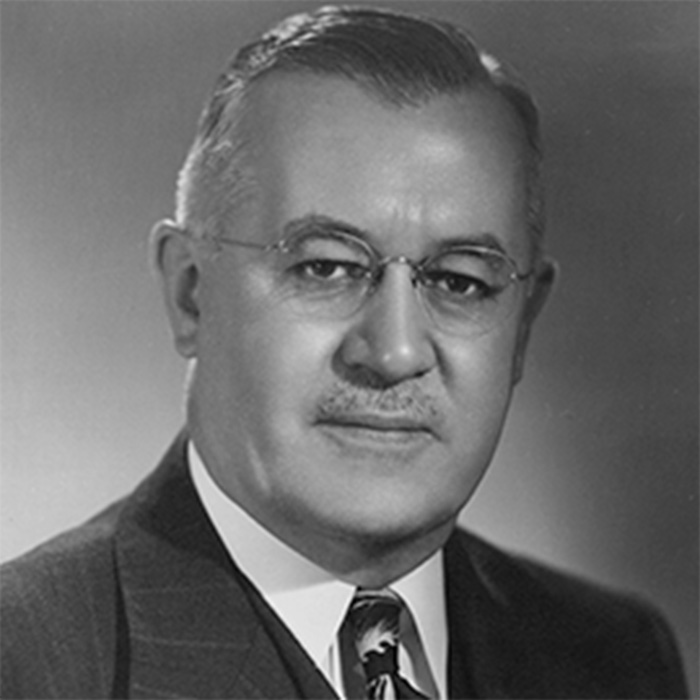 In January 1946, Dr. A. Ray Olpin, a physicist, took command of the University of
Utah. He recruited a number of senior people to his administration who also became
faculty members in various academic departments. Two of these administrators were
chemists: Henry Eyring, a professor at Princeton University, and Carl J. Christensen,
a research scientist at Bell Laboratories.
In January 1946, Dr. A. Ray Olpin, a physicist, took command of the University of
Utah. He recruited a number of senior people to his administration who also became
faculty members in various academic departments. Two of these administrators were
chemists: Henry Eyring, a professor at Princeton University, and Carl J. Christensen,
a research scientist at Bell Laboratories.
In the year 2000, the Chemistry Department attempted to hire a distinguished senior faculty member by inviting him or her to teach a short course for several weeks as a visiting professor. The distinguished visitor gets the opportunity to become acquainted with the department and some of the aspects of Utah (skiing, national parks, geodes, etc.) and the faculty discover whether the visitor is someone they can live with. The hiring of Henry Eyring did not fit this mold because he was sought first and foremost to beef up the graduate program for the entire University rather than just to be a faculty member in the Chemistry Department. Had the Chemistry Department refused to accept Henry Eyring as a full professor, he probably would have been accepted by the Metallurgy Department, where he had a courtesy faculty appointment for many years.
Sometime in early 1946, President Olpin visited Princeton, NJ, and offered Henry a position as the Dean of the Graduate School at the University of Utah. Henry was in his scientific heyday having published two influential textbooks (Samuel Glasstone, Keith J. Laidler and Henry Eyring, The Theory of Rate Processes, McGraw-Hill Book Co., New York, 1941; Henry Eyring, John Walter and George E. Kimball, Quantum Chemistry, John Wiley & Sons, New York, 1944) and having recently been elected to the National Academy of Sciences. Henry respectfully declined the job offer. The next day his wife, Mildred Bennion Eyring, told him that she and her three sons were moving back to her home in Utah with or without him. Henry quickly decided to accept the $8,000 per year job at The University of Utah, and he and his family arrived for work in Salt Lake City late in the summer of 1946.
At the time of Henry's arrival The University of Utah already had a strong undergraduate program in chemistry. Thus, Henry Eyring's principal impact within the department over the next few years was on the graduate research program, which was less mature. James M. Sugihara successfully defended the first Ph.D. degree dissertation in Chemistry at the University of Utah in August 1946. Dr. Sugihara and Dr. Marilyn Alder Marquis, mentioned later in this narrative, were honored in fall of 1997 at a 50th anniversary event for University alumni. Dr. Sugihara's Ph.D. was one of the first two Ph.D.'s granted at the University; the other recipient that year was Ewart Swinyard who later became the Dean of Pharmacy. As of the year 2000, the University of Utah has granted over 675 Ph.D.'s in Chemistry. At the end of this narrative, the reader will find the names of the students who earned these Ph.D.'s, along with the year they earned their degrees. Back in 1947, Sugihara's 84-page dissertation on "The Reactions of Mercaptans with Sucrose and Molasses" included only three approval signatures: Walter D. Bonner, Lloyd E.
Professor Emeritus Hyung Kyu Shin was one of Dr. Sugihara's and Dr. Gidding's student, read here more about Dr. Shin and his career as a chemist!
Malm and Elton L. Quinn. All three were faculty members in the Chemistry Department. Yet, in this dissertation there is not a signature from the Dean of the Graduate School because there was not a Dean by that date.
In his first ten years at The University of Utah (1946-1956) Henry provided a lot of stimulation to the graduate research program in the Chemistry Department. His own lively research program made the department more attractive to like-minded Ph.D. chemists such as Bruno Zwolinski, Ransom Parlin, Rufus Lumry, Bill Cagle and Austin Wahrhaftig, all of whom joined the faculty and engaged in active research programs. In those first ten years Henry also attracted many gifted graduate students to his research group such as Tracy Hall, Cal Giddings, George Blyholder and Art Ruoff who went on to successful post-Ph.D. careers in academe.
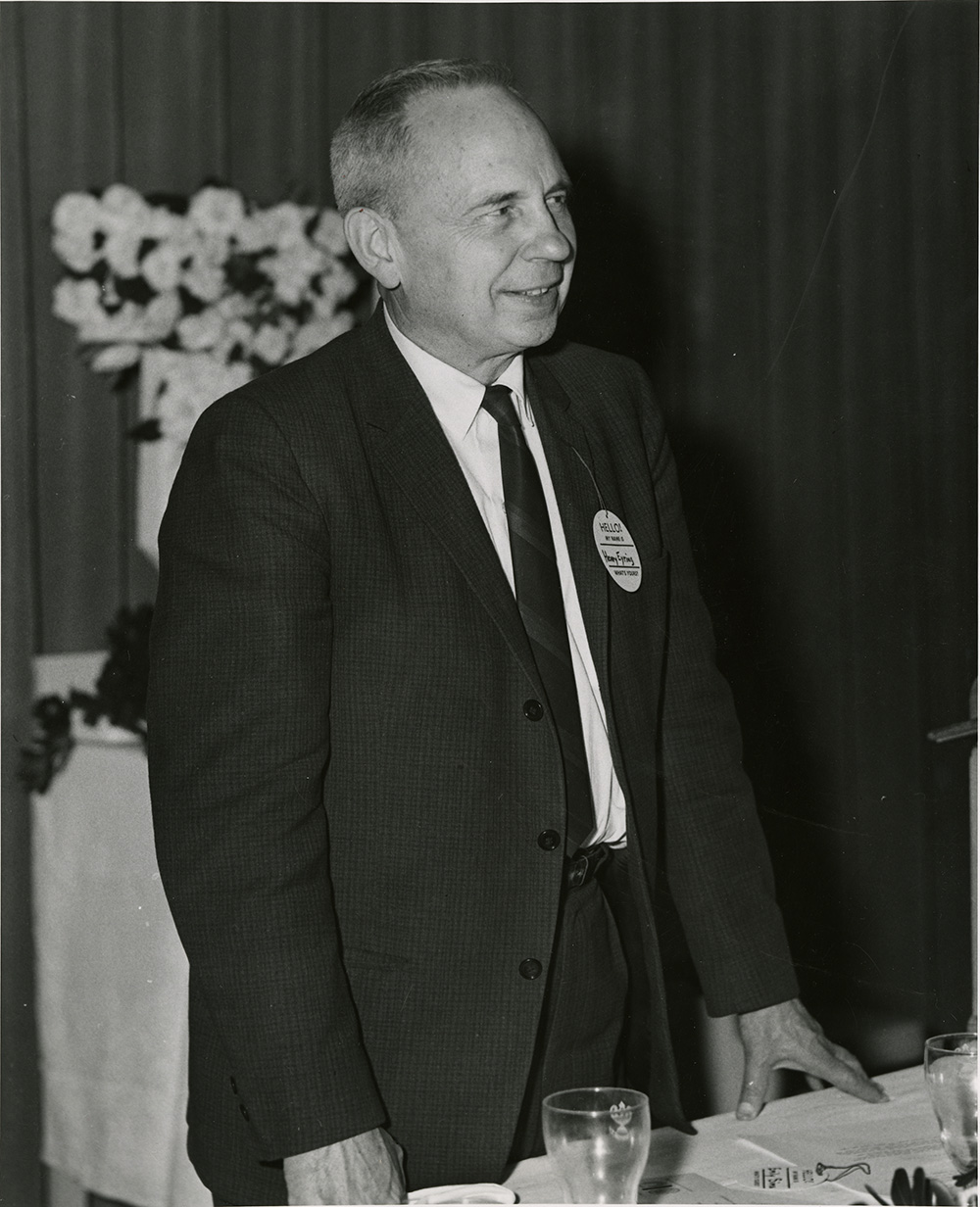 |
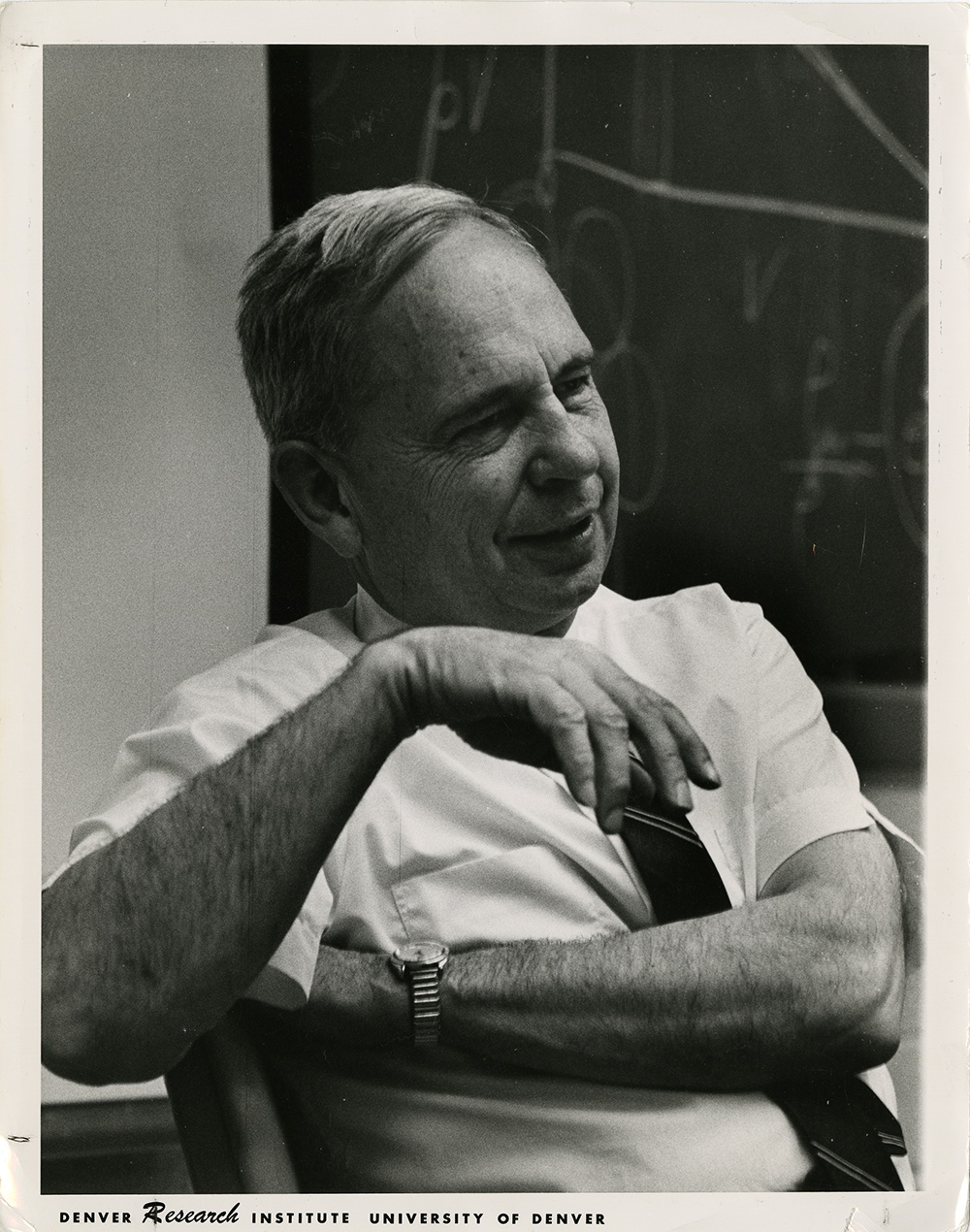 |
Federal funding of university research increased substantially during this ten-year period that immediately followed World War II. Austin Wahrhaftig, for example, built a strong experimental mass spectroscopy research program at The University of Utah with funding from the Atomic Energy Commission, which later became the Department of Energy. One of the high-impact, scientific publications that came out of the Chemistry Department at this time, was co-authored by H. Rosenstock, M. Wallenstein, A. Wahrhaftig and H. Eyring [Proceedings of the National Academy of Science U.S. 38, 667 (1952)]. This paper reported a statistical theory of the break-up of large molecules after ionization and excitation by electron impact. Henry Rosenstock and Merrill Wallenstein, two Wahrhaftig graduate students, went on to influential careers at the National Bureau of Standards.
To accommodate the growing number of people in the department and concomitant expanding research activity in Chemistry, several World War II wooden army buildings were relocated east of the combined Physics/Chemistry Building. Some of the "temporary" buildings of that era still exist in various locations around the campus, most notably the "Annex" located due east of the Huntsman Center. However, a two story wooden barracks building that was relocated north and east of the Park Building disappeared many years ago. It bore the rather pretentious name of "The Institute for the Theory of Rate Processes" and housed many of Henry's research students in torrid summer heat and chilling winter cold until his research program was accommodated in an old brick building ("Applied Research" due north of the Park Building). This building was razed in the 1990's to accommodate construction of the beautiful INSCC Building, which houses students from the Departments of Physics, Chemistry and Engineering who do computationally intensive research.
A particularly vivid memory for many of the graduate students in the department of Chemistry in the 1950's is that of Professor Henry Eyring's quantum mechanics course taught from his textbook (Eyring, Walter and Kimball). The class was held every Monday, Wednesday and Friday at about 9:30 a.m. in the office of the Dean of the Graduate School at the north end of the Park Building (where President Machen is now housed). The book has a green cover, is very mathematical, and is difficult to read, so it was frequently called the "green diamond." At the same hour on Tuesday, Thursday and Saturday mornings, most of the same students came back for a dose of statistical mechanics from an orange colored paperback irreverently called the "yellow peril" that had been put together from Marilyn Alder's in-class notes. In the summer these arcane topics gave place to the theory of rate processes taught by "the Dean" from his textbook co-authored by Glasstone, Laidler and Eyring. One summer in the late 1950's Henry held class on Independence Day, July 4, and on Pioneer Day, July 24 . This insistence on putting school work ahead of public holidays seems a little extreme in hindsight, but he brought an infectious enthusiasm for science to these classes that had a very broad impact on the climate for scientific research on the "U" campus. Many students enrolled in his classes from departments other than Chemistry, which greatly enlarged his impact on the developing research programs across the entire University of Utah campus.
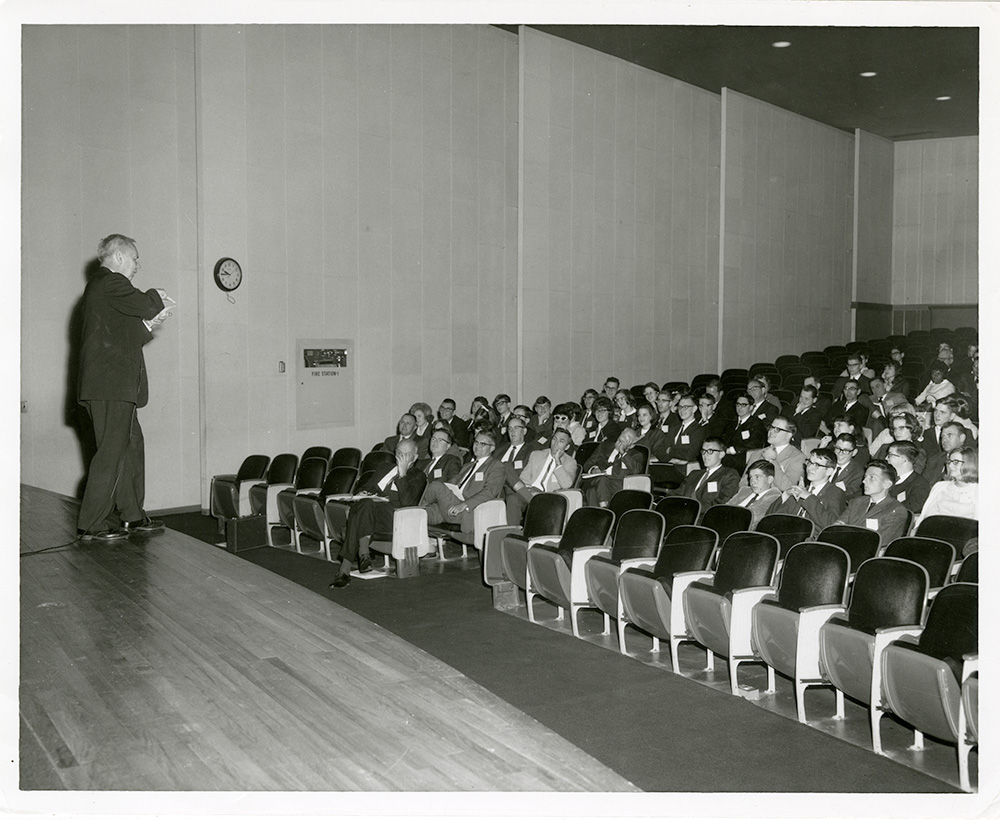
It is worth considering why the personality of Henry Eyring had such a great impact on the Chemistry Department throughout the 35 years (1946-1981) he was on the faculty. Robert Miller, in 1984-86, interviewed a number of Henry Eyring's contemporaries as part of the E.L. Cooley Oral History Project (of the Marriott Library). Here are just four excerpts from that collection.
Kenneth Pitzer, former university president (Stanford and Rice) and distinguished faculty member at UC Berkeley, speaking to Miller in 1984 stated: "[Henry] was friendly, enthusiastic and extremely self-confident...he was a good salesman of science."
Melvin Calvin, long time faculty member at UC Berkeley and Nobel Prize winner said: "[Henry] was a very skillful lecturer. Very informal. He was very, very, good, but very precise. It was always great to listen to him, always."\
Glenn Seaborg, UC Berkeley faculty member, former American Chemical Society president and Nobel Prize winner stated: "He (Henry) was a very clear lecturer. He made things sound understandable, perhaps deceptively so. You had the impression after he explained something that you understood it. [He was] very alert, articulate, almost exuding intelligence, a good conversationalist, I would say pleasant but persistent, he was in good health and Full of energy."
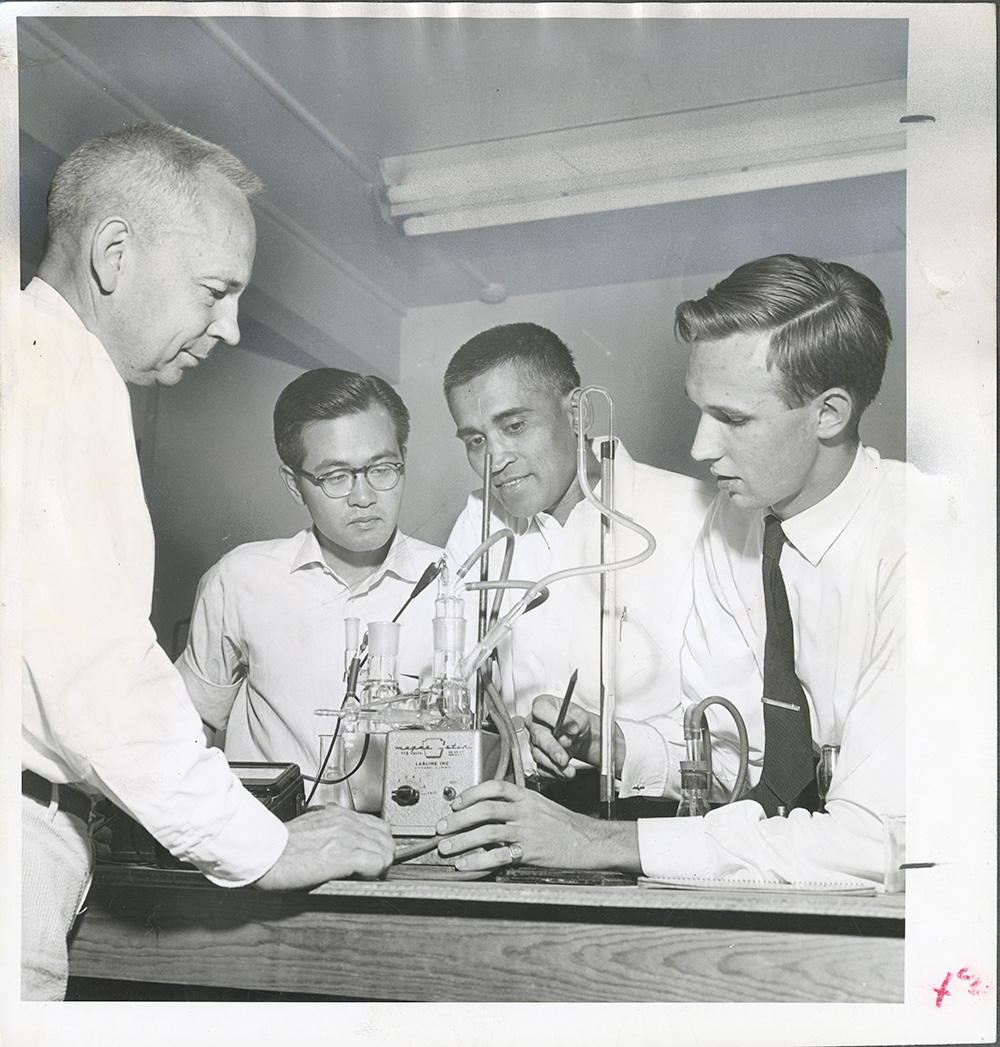 The above three statements illustrate that Henry Eyring was a man who was equally
balanced not only in matters of chemistry but also in life. Henry had a warm heart
and a wonderful personality. He also had a knack for helping others feel at ease when
situations were tense. An example of this comes from one of his students.
The above three statements illustrate that Henry Eyring was a man who was equally
balanced not only in matters of chemistry but also in life. Henry had a warm heart
and a wonderful personality. He also had a knack for helping others feel at ease when
situations were tense. An example of this comes from one of his students.
John Morrey, one of Henry's Ph.D. students and subsequently a member of the technical staff at the Pacific Northwest Laboratory of the Department of Energy, stated: "I remember an experience I had when I came into his lecture room, next to his office in the Park Building, for my Ph.D. oral exam. I came in a little early, and he was the only member of the committee there. He sensed, I'm sure, that I was pretty nervous. And so he said to me, 'John, have you ever seen me jump on the table from a standing position?' There was a big oak table in his room. I said, no. He jumped, but he didn't make it. He sprawled out over the table, catching his shins on the edge. It must have nearly killed him. I'm sure it hurt terribly. He winced, backed off, and he said, 'I didn't make it.' He jumped again. And that time he did. I guess that illustrates more his tenacity and his competitiveness, in a sense with himself, rather than his humor, but he had a great sense of humor. His lectures would be filled with humor. Most of the time the humor was on him, and I think that was one of his magical qualities that made people accept him. There were times when he'd become a little frustrated at someone and turn it on someone else, but not very often."
Tenacity was certainly one of Henry Eyring's most notable personality traits. The following illustration is from an unpublished autobiographical sketch written on August 8, 1976 when Henry was 75 years old: "A story that mother used to tell about me before I could remember is of father coming home from the cattle ranch [in northern Mexico] with his horse covered with sweat, unsaddling him, putting me on the horse's back and she and father walking down to the river just behind the horse to water the horse. When the horse got out into the river, he shook himself as sweaty horses do and the two-year old tumbled off into the river. According to reports, my first remark after being fished out of the river was 'Put me back on the horse,' which was done. I have no memory of learning to ride. As far as I know, I always knew how."
During the 1950's Henry Eyring initiated foot races against his research students. However, the first foot race was against several women working in the Park Building including his secretary, Belva Barlow (later Ashton). Henry won that first race decisively. Soon afterward G. Homer Durham and Sterling McMurrin, two of the leading officers of the University Administration, who were somewhat younger than Henry, challenged him to a foot race. In a well-publicized race on the asphalt outside the old Bookstore the two challengers both fell down and failed to finish the race, to the considerable amusement of the community. This ended Henry's string of victories at just two races. For many years thereafter Henry ran against his research students each summer, awarding at least four cash prizes yearly to the fleetest footed. Henry never won any of his own prize money, but it was impressive to see how hard he ran in what amounted usually to a fifty yard dash. There are many people in the community who would not be able to tell you the first thing about Henry Eyring's chemistry but who could tell you about one of those foot races, particularly one that was shown briefly on national television.
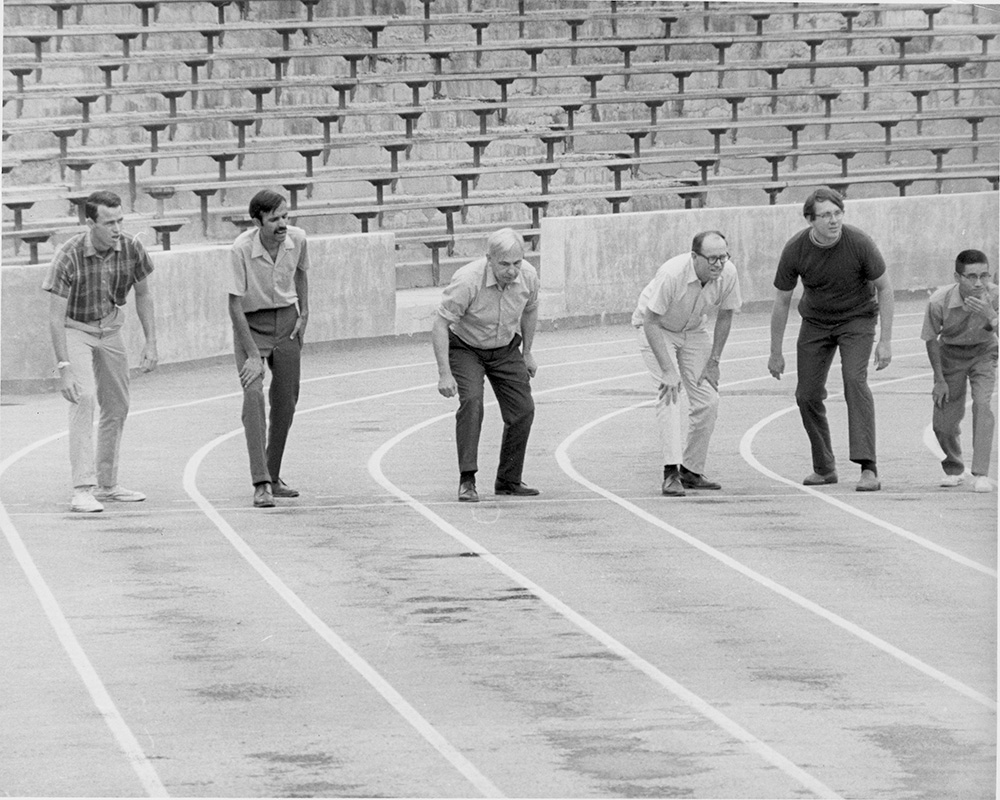 |
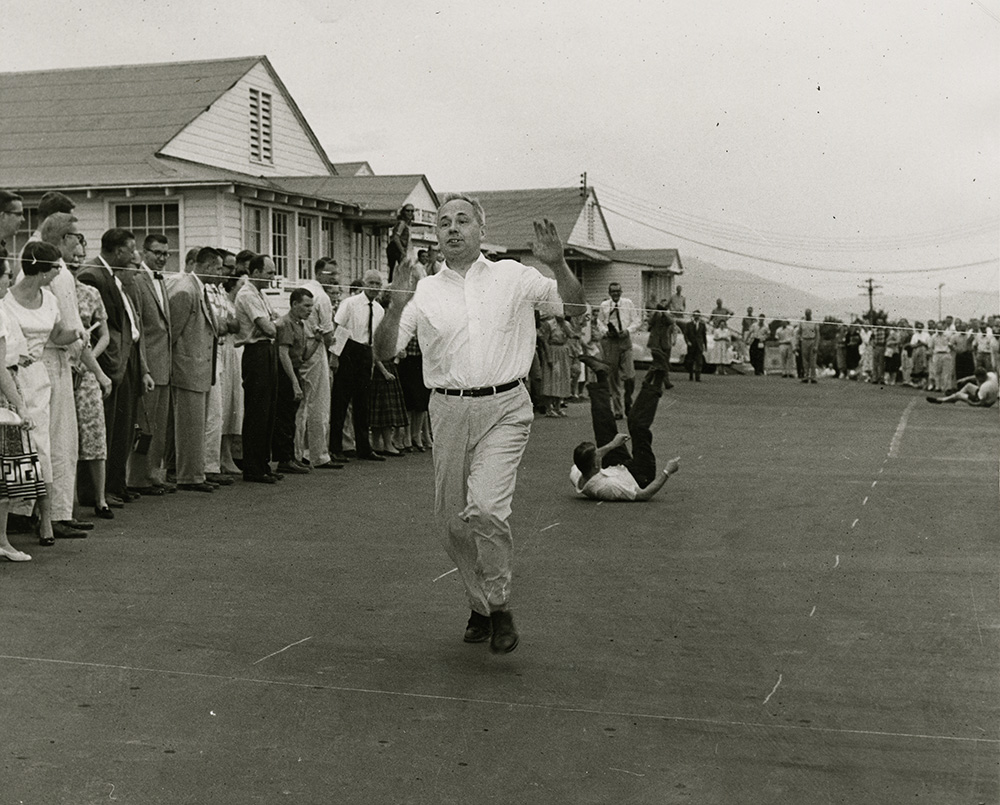 |
Elton L. Quinn was head of the University Chemistry Department from 1947-49. In the 1948-49 University catalog the following department faculty members are listed: Professors Elton Quinn, Lloyd Malm, and Henry Eyring, Associate Professors Vic Beard, Randall Hamm, Bill Burke, Jim Horton, Assistant Professors Stuart Haynes, Jim Sugihara, George Hill, Austin Wahrhaftig, Ransom Parlin and Bruno Zwolinski Lloyd Malm was a superlative teacher of inorganic chemistry. A national effort to improve freshman chemistry came along in the 1950's called the Chem Study program. It was headed by George Pimentel of UC Berkeley and enlisted some of the top professors across the country to develop instructional materials. Lloyd was deputized to write a freshman laboratory manual for the Chem Study program that yielded substantial royalties in support of undergraduate scholarships in the University of Utah Chemistry Department. Vic Beard would later run the Associated Rocky Mountain Universities consortium for the Department of Energy in the early 1960's. Randall Hamm left the University of Utah for Washington State University, where he continued his productive research studies of inorganic complexes in solution. Jim Sugihara became a dean at the University of North Dakota in the early 1960's. George Hill created the Department of Fuels Engineering (recently merged with Chemical Engineering) and was elected to the National Academy of Engineering for his pioneering research in coal chemistry. Ransom Parlin, a gifted physical chemist, left Utah in the 1950's and died prematurely. Bruno Zwolinski also left Utah in the 1950's to become the influential director of an international bank of thermochemical data housed at Texas A&M University. Rufus Lumry (not listed above) also was a faculty member in the 1950's before moving to the University of Minnesota where he taught and researched in biophysical chemistry with distinction.
Many of the above chemists continued to serve on the Chemistry faculty under Elton Quinn's successor. William (Bill) J. Burke, an organic polymer chemist, served as department head from 1949 until 1962. According to the 1956-57 University catalog the faculty in Chemistry consisted of the following people: Professors Bill Burke, Lloyd Malm, Henry Eyring, Carl J. Christensen, Randall Hamm, Jim Horton, and Jim Sugihara, Research Professor Alexus Ree, Associate Professors Austin Wahrhaftig, Ransom Parlin, Bill Cagle, and Richard P. Smith. Assistant Professor Burl E. Bryant, Assistant Research Professor Betsy J. Stover, and Technical Assistant Curator Lynn Austin
Before teaching for several years in Chemistry at the end of his career, Carl Christensen was the dean of the College of Mines and Mineral Industries and later what we would now call the Vice President for Research. Carl was a crystal grower from his days at Bell Labs and founded a local company that grew sonar crystals for French submarines. Alexus Ree was a theoretical chemist who was highly regarded in his home country of South Korea. Alexus funneled many talented Korean graduate students into the Chemistry Department to work with either himself or with Henry Eyring.
Bill Cagle was probably the most unique "character" to ever teach in the Chemistry Department. Bill earned a Ph.D. from the University of Illinois in 1946. He was every bit as smart as a doctoral degree awarded at age twenty-two would suggest. He was subsequently a postdoctoral research student at the Institute for Advanced Study in Princeton, N.J. At the University of Utah, he developed the quintessential "look" of the eccentric professor. Students would sometimes see him walking across the campus talking to himself with his head slightly bowed and rubbing his hands together in evident satisfaction. Those students who became acquainted with him as a lecturer found Bill to be approachable, pleasant and extraordinarily well organized in his lecturing style that he saluted with amusing asides. His faculty colleagues heard many of Bill's anecdotes so often that they could recite them by heart. Bill was the ultimate repository of useful chemistry knowledge, now superseded by the Web-of-Science database. He and his students published some beautiful x-ray crystallographic studies of small molecules. Bill was also an avid collector of rare books, including first editions of early LDS literature. He characterized himself as a "backsliding Methodist'' but could give you better answers about Mormon history than just about any "Saint". Bill never married, and his heirs sold his wonderful collection of books when he died without a will at age 63 in 1986.
Richard P. Smith is a native Utahn. In 1946, while he was in the military in Japan, Richard learned about Henry Eyring coming to the University of Utah and decided that he would like to work in the area of physical chemistry. He got his Ph.D. with Henry Eyring and then spent three years at Cambridge, MA, as a prestigious Harvard Fellow. After fewer than ten years on the University of Utah Chemistry faculty Richard went to work for Exxon in New Jersey, where he now resides in retirement.
Betsy Jones Stover was also a Utah native. After getting her Ph.D. in physical chemistry Betsy became the director of a big Atomic Energy Commission project in the University of Utah Medical School that studied disease and mortality of a very large colony of beagle dogs that had been systematically poisoned with plutonium. She wrote many scientific papers, some of which were co-authored with Henry Eyring. Her appointment in Chemistry as a research professor was a recognition of this long standing collaboration with Henry. She may have been the first woman listed in the University catalog as serving on the Chemistry Department faculty although her primary University appointment was always in the Medical School. She moved many years ago to North Carolina, where she has since passed away.
Lynn Austin retired after teaching chemistry in a California junior college for many years. At the time of his service on the University of Utah faculty he was charged with the management, among other responsibilities, of the undergraduate laboratories. Lynn had bright red hair in those days and a thoroughly engaging personality.
As head of the department, Bill Burke was asked in 1956 to compose a ten-year department history for President A. Ray Olpin. Following is that report (dated August 17, 1956):
Graduate Programs
The first Ph.D. from the University of Utah was awarded in 1947 in the field of chemistry. Since that time the graduate program in the Department of Chemistry has grown rapidly from a very few students to an average of 45 to 50 over the past several years. Of the 208 Ph.D.'s awarded to date by the University of Utah, 54 have been in chemistry. On the basis of a recent visitation by two eminent chemists, Dr. Ralph Shriner of the University of Iowa and Dr. John Willard of the University of Wisconsin, the Committee on Professional Training of the American Chemical Society commended the department on the "excellent program of training in chemistry at the doctoral level."
A wide variety of important problems in representative areas in the field of chemistry are under current investigation. These include studies in: reaction rate theory, mass spectra and molecular structure, polarography, explosion phenomena, catalysis, plastic flow, structure and quantum mechanics of activated complexes, sintering of alumina, kinetics of the oxidation of carbon, transport processes at electrodes, combustion, surface chemistry, chelate complexes, boron alkyls, photosynthesis, Gilsonite, polycarbocyclic ring systems related to colchicine, mechanisms of organic reactions, carbohydrates, chemotherapy, phenol- formaldehyde, and heterocyclic compounds.
The rapid growth of the research program in chemistry has created serious problems with regard to laboratory space and supplies and equipment. However, national recognition of the quality of the staff has resulted in considerable support for our research activities from private industry, non-profit corporations and various branches of the federal government. Supporting agencies include the National Science Foundation, Atomic Energy Commission, Office of Ordinance Research, Office of Naval Research, Air Material Command, California Research Corporation, American Gilsonite Company, Purex Corporation, Research Corporation of America, and the National Foundation for Infantile Paralysis. Our high level of research activity has been possible only through such assistance and the attitude of the University administration toward creative work.
The excellence of the graduate program in chemistry has resulted in the attraction of highly qualified graduate students as teaching assistants in spite of our comparatively low stipend. These assistants have greatly contributed to our capacity for handling large numbers of students with a relatively small senior staff. This program has increasing significance in view of the difficulty colleges and universities are now experiencing in obtaining qualified teaching personnel.
At present most of the research in chemistry is housed in three separate temporary
buildings. It is hoped that adequate permanent facilities can be provided in the near
future for research in this important area.
Undergraduate Program
While the number of students graduating with bachelor degrees in chemistry has not been large, an unusually high percentage of these have gone on and completed their work for Ph.D. degrees. Many have been awarded substantial fellowships in national competition. This of course is related to the solid program of courses offered by the department and to the individual attention and encouragement given to our students. Several members of the staff have been active in the development of a superior general education course in chemistry.
In addition to majors, pre-medical, pre-dental and other students in the University
college, large numbers of students from other colleges, such as Engineering, Pharmacy,
Nursing and Mines and Mineral Industries also take basic work in our department. As
a result of the continued increase in enrollment, it was necessary over the past few
years to provide new facilities for laboratory instruction in physical and organic
chemistry. At present one of our two general chemistry laboratories is being remodeled
so that it will accommodate about 50% more students. While most of the antiquated
laboratories in the department have been remodeled during the past six years, there
is at present a desperate need for an adequate laboratory for quantitative analysis.
Other Activities
The Department of Chemistry sponsors a biweekly seminar in which the speakers are drawn about equally from our staff and from other departments throughout the University. We are hopeful that such a plan will stimulate others to become interested in our seminars. At the same time this enables our staff and graduate students to get a first hand picture of research interests and activities in other areas of the University. In addition, the Department sponsors two other biweekly seminars. One of these is concerned with organic chemistry and the other with physical, analytical and inorganic chemistry. These seminars are in general more highly specialized and are designed to give our graduate students an opportunity to present and discuss various topics of current interest in Chemistry. The Department has also worked closely with the American Chemical Society, Sigma Xi and the Division of Biology in sponsoring prominent speakers.
Members of the staff have actively participated in the American Chemical Society and other national scientific organizations. Over the past ten years there has been a major increase in the number of scientific publications from the department. Dean Henry Eyring has been the recipient of numerous medals and awards for his outstanding contributions to science. Among these were the Nichols medal, the Bingham medal, and the Research Corporation Award. He was also invited to give the Edgar Fahs Smith Lecture at the University of Pennsylvania, the G.N. Lewis Lecture at the University of California and the William Pierson Field lectures at Princeton.
Bill Burke was a forceful department head with an engaging smile and an affinity for bow ties. He ran a very active research program in polymer chemistry in one of the one-story wooden shacks east of the Physics/Chemistry building and had a number of graduate students, including Richard (Dick) Quisenberry, Harold Higginbottom and Gary Goken who went on to very successful careers in industry. The department secretary during the latter part of Bill's long leadership was Irene W. Paul.
Graduate students in the department of Chemistry at the University of Utah during the 1950's took a written preliminary exam ("prelim") over a two-day period to qualify for Ph.D. candidacy. Those intending to write a dissertation in physical chemistry took a grueling "general prelim" the first day that covered graduate course work in analytical, inorganic and organic chemistry. The "special prelim" the next day tested the student's knowledge of physical chemistry in some depth. Corresponding "special prelims'' were administered to students majoring in each of the other three areas of chemistry. The result of this brutal coursework and testing program was that a star organic chemistry graduate student such as Bryant Rossiter went off to his first job at Kodak with more knowledge of quantum mechanics and statistical mechanics than would be true of the University of Utah's year 2000 Ph.D. graduates in organic chemistry. Bryant's extraordinarily successful thirty-year career
as a research leader at Kodak was obviously the result of his bright mind and pleasant personality. However, the University of Utah Chemistry faculty of the 1950's was bound and determined that every graduating Ph.D. would have the broadest knowledge of chemistry possible.
The demand for well-qualified Assistant Professors of chemistry was so great nationwide in the latter 1950's and early 1960's that it made sense to hire some University of Utah graduates. Bill Burke led the faculty in appointing Richard P. Smith (University of Utah Ph.D., Harvard postdoc), J. Calvin Giddings (University of Utah Ph.D., Wisconsin postdoc), David M. Grant (University of Utah Ph.D., Illinois post-doc), and Edward M. Eyring (University of Utah Ph.D., Goettingen postdoc) between 1955 and 1961. The only Assistant Professor appointed during that period that had not earned a doctorate at the University of Utah was William W. Epstein (UC Berkeley Ph.D., Illinois post-doc).
Read here for more about Professor J. Calvin Giddings:
Giddings, M.C., Giddings, S.P., Clark, L.J., Fuhriman, I.T., Packer, R.G., Thomson, W.C., Sindelar, J., Brown, P.R., Grushka, E., Knox, J.H., Novotny, M.V., Lochmueller, C.H., Ettre, L.S., Lee, M.L., Eyring, T., Kirkland, J., Karger, B.L., Yang, F.J., Martin, M., King, J.W., Thompson, G.H., Shin, H.K., Fuller, E.N., Wahlund, K.-G., Gardella, J.A., Jr., Reschiglian, P., Andreev, V.P. and Davis, J. (1997), Tributes to J. Calvin Giddings. J. Micro. Sep., 9: 123-150.
David M. Grant succeeded Bill Burke as department head in 1962. Having someone who is not yet a full professor chair a department is not very common for political reasons. Dave Grant has always demonstrated the attributes of a successful leader, and his appointment to the role of Head was clearly one of the best ever-made in the Chemistry Department.
The 1963-64 University catalog lists the following faculty members in Chemistry:
Associate Professor and Head:
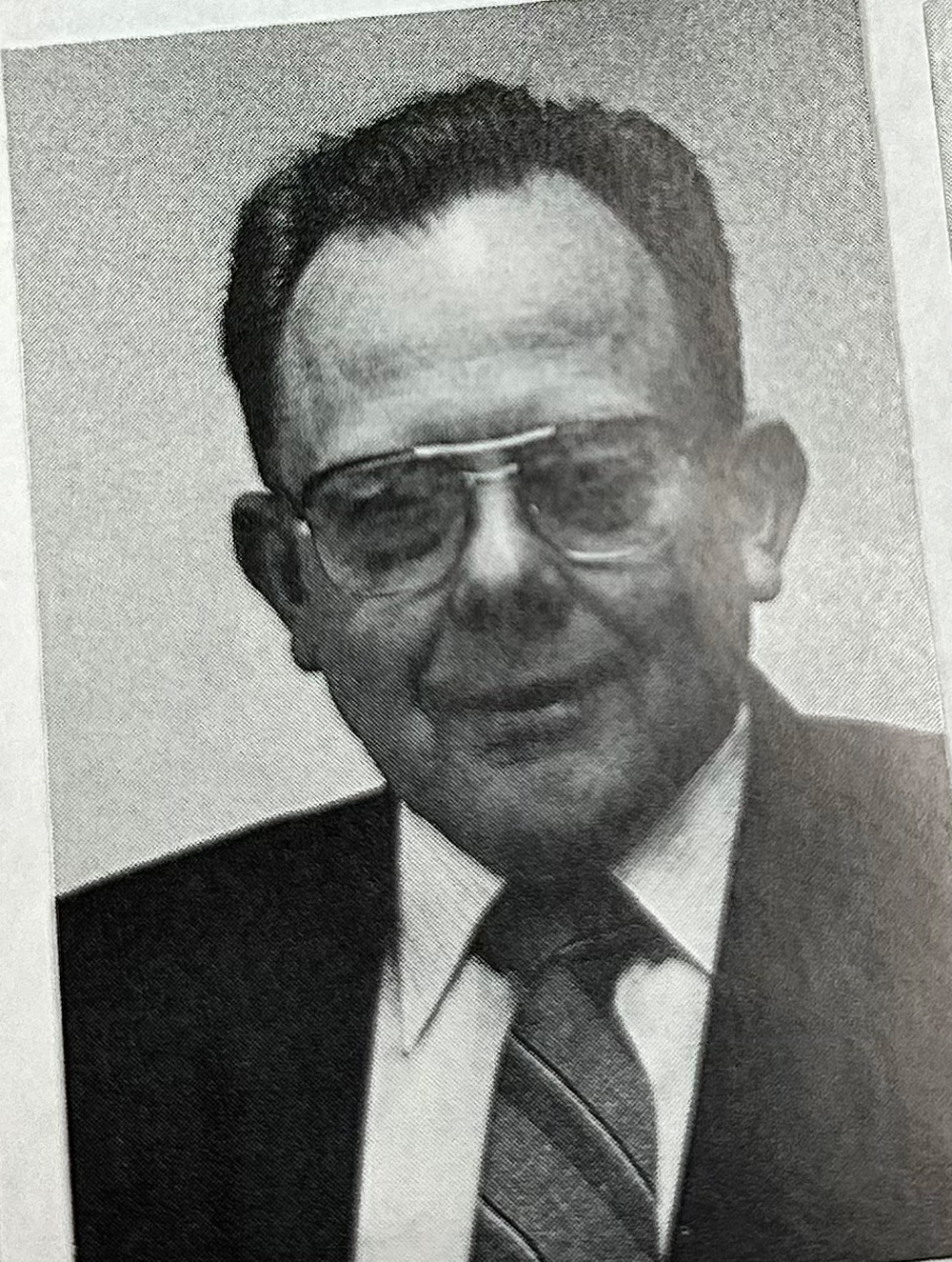 David M. Grant, Professors Bill Cagle, Carl Christensen, Henry Eyring, Jim Horton,
Lloyd Malm, Jim Sugihara, and Austin Wahrhaftig, Research Professors Cal Giddings
and Alexus Ree, Associate Research Professor Betsy Stover, Assistant Professors Bill
Epstein, Ted Eyring, Evan L. Allred, George W. Latimer, Ronald O. Ragsdale, Wesley
G. Bentrude, Dennis J. Caldwell and Roger Kust.
David M. Grant, Professors Bill Cagle, Carl Christensen, Henry Eyring, Jim Horton,
Lloyd Malm, Jim Sugihara, and Austin Wahrhaftig, Research Professors Cal Giddings
and Alexus Ree, Associate Research Professor Betsy Stover, Assistant Professors Bill
Epstein, Ted Eyring, Evan L. Allred, George W. Latimer, Ronald O. Ragsdale, Wesley
G. Bentrude, Dennis J. Caldwell and Roger Kust.
Bill Epstein, retired in 1998, and now residing in San Luis Obispo, CA, is a natural products organic chemist. His "road map" problems in Honors Organic Chemistry challenged talented undergraduates for generations. Bill also knew how to combine the hunt for interesting new plants for his natural products studies with pleasant fly fishing trips to the Pacific Northwest. Ted Eyring continues his research on topics as diverse as the kinetics of oxidation of phenol by aqueous iron(VI), the synthesis of oxygenated fuel additives for automobile engines, and the enzymatic activity of proteins encapsulated in porous glass monoliths. Ted has somehow always managed to be slightly out of step with his colleagues. With the help of Dr. Laya Kesner he continues to promote service-learning pedagogy favored more by social scientists, and he is often the only person in the building wearing a necktie. George Latimer was a Salt Lake native who earned his Ph.D. in analytical chemistry at Princeton. He came to the University of Utah faculty from PPG in Corpus Christi and went back there after a couple of years for personal reasons. Dennis Caldwell was a theoretical chemist who left the University to work in industry (Hercules) and then came back to the University of Utah campus as a faculty member in Chemical Engineering. Dennis and Karin Caldwell (Research professor, later chair of Bioengineering at the University of Utah) now reside in Uppsala, Sweden. Roger Kust was an electrochemist who left the department for industrial employment in New England.
In the year 2000, Professors Ragsdale and Bentrude remained on the faculty. Ron's impact on freshman chemistry is legendary. He has probably taught more high school and first year undergraduate students than anyone else who has ever served on the Chemistry faculty. The lecture demonstrations developed with Dr. Jerry Driscoll for Ron's lectures have been incorporated into "Faraday Christmas Lectures" that have become the one aspect of the Chemistry Department best known to the citizens of Utah. Michael Faraday was one of the most distinguished chemists of the 19th century. As director of the Royal Institution in London he initiated public lectures at Christmas time that included exciting chemical demonstrations, hence the above, rather formal, name for what is familiarly called the "Ron [Ragsdale] and Jerry [Driscoll] Show." Ron's international travel in support of the International Baccalaureate program in chemistry possibly surpassed in mileage and exotic destinations the feats of the most energetic travelers on the Chemistry faculty.
Wes Bentrude has also taught large numbers of students enrolled in the sophomore organic chemistry courses as well as in graduate organic chemistry courses. In his 37 years of service at the University of Utah to date, Wes has had a well-funded research program in phosphorus organic chemistry. Although Wes now spends half of each academic year fishing in Florida, he and his students are continuing to publish research consistent in quality and quantity with the high standards that Wes has always set for himself.
In 1963 the Utah legislature authorized planning for a new chemistry building. Wilford Burton and Royden Derrick were Regents who played a decisive role in getting the building funded. Austin Wahrhaftig was deputized to provide counsel to the architect, Henry Fetzer, over the next five years. Austin's attention to detail and foresight had a very beneficial impact on the final design of what is now called the "North Wing of HEB". Also in 1963, Henry Eyring had the honor of serving as the elected president of the American Chemical Society.
Roland Robins joined the faculty in 1964. He had a country boy style of talking and a high energy level for research in nucleoside chemistry. His big research group gave the faculty a glimpse of what major federal funding could do in building up organic chemistry research in the department. Roland left the department a few years later to work in a pharmaceutical firm in California and has since passed away.
Dave Grant succeeded in recruiting Pete D. Gardner to the faculty in 1965. Pete was a tenured full professor of organic chemistry at the University of Texas at Austin. In addition to his expertise in research, Pete brought unusual leadership skills to the Utah campus and served with distinction as Dean of Science, Academic Vice President to President David P. Gardner (no relation), and Chair of Biology, successively. Pete died prematurely at age 62 on February 4, 1989.
In 1965, the University instituted the Distinguished Teaching Award. This is an award made at Commencement in honor of three to five faculty members throughout the University to recognize exceptional teaching performance. Lloyd E. Malm was one of the first three recipients of this prestigious award in 1965. The names of the six faculty members from the Chemistry Department who have won this award appear in the awards list at the end of this volume.

The President of the University in 1992 established another University-wide teaching award called the Presidential Teaching Scholar Award. This award is made to ten faculty members each year and their salaries are increased by $5,000 per year with continuing adjustments for inflation until they retire. Four recipients from the Chemistry Department are listed at the end of this volume.
Starting in 1999, the three Distinguished Teaching Awards and the ten Presidential Teaching Scholar Awards were rolled into just six Distinguished Teaching Awards made each year.
The University Distinguished Research Award also had its beginning in 1965 with a single award being made that year to Leroy J. Robertson, a composer on the Music faculty. The next year there were two Distinguished Research Awardees: Henry Eyring in Chemistry and Jacob Geerlings in Languages. Since 1970, three Distinguished Research Awards have been made each year at Commencement. Members of the Chemistry Department faculty have been honored with the Research Award more frequently than any other department on campus by a wide margin. The thirteen Chemistry faculty recipients of this award are listed (by year) in the Awards section at the end of this volume.
In 1966, Jean Futrell joined the faculty in the rank of Associate Professor and brought with him a well-funded research program in mass spectrometry that became well known for advances in chemi-ionization. About sixteen years later Jean moved to Delaware, where he chaired the University of Delaware Chemistry Department with distinction. Jean is now the Director of the William R. Wiley Environmental Molecular Sciences Laboratory at the Pacific Northwest National Laboratory in Richland, WA. While Jean was at the University of Utah he was exceptionally successful in teaching his graduate students how to do important research in mass spectrometry. A notable illustration of Jean's success as a teacher and researcher are the recent achievements of two of his former University of Utah Ph.D. students. Dr. Richard D. Smith and Dr. Marvin L. Vestal have both recently made important contributions to the development of new approaches to study proteomes. A proteome is the entire complement of proteins that can be expressed by a particular cell, organism or tissue; proteomics is the study of the protein complement expressed at a given time or under a specific set of environmental conditions. While the availability of complete genome sequences, as now being provided by the Genome Program, opens the door to important biological advances, much of the real understanding of cellular systems and the roles of its constituents will necessarily be based upon proteomics. The capability to precisely measure changes in the relative expression of numerous proteins simultaneously enables identifying and understanding the function of the proteins participating in the multiple pathways, as well as insights into how cellular networks are linked.
Smith and Vestal have been separately developing tools based upon mass spectrometry for making more effective proteome measurements. Dr. Vestal (Applied Biosystems) has developed a new tandem time of flight mass spectrometer that allows orders of magnitude higher throughput for protein identification, presently a major bottleneck in proteomics. Dr. Smith (Pacific Northwest National Laboratory) has developed and applied a new approach that uses a new ultra-sensitive Fourier transform mass spectrometry developed in his laboratory, along with stable-isotope labeling, and the new concept of "accurate mass tags" to make much more comprehensive, sensitive, faster and quantitative proteomics measurements than previously possible. The global perspective that results from proteomics measurements provides a comprehensive view of the detailed changes in cellular pathways and networks, thereby improving the understanding of how biological systems respond to environmental perturbations. The practice of proteomics is expected to have profound impacts in areas that range from drug development to biotechnology.
The department moved into the first phase "north wing" of the present Chemistry Building in January 1968. Some months later Sir George Porter, the Director at that time of the Royal Institution in London and a 1967 recipient of the Nobel Prize, gave the principal invited talk at the dedication of the new building.
The availability of more space for research in this new building was one of two factors that took the department to a new level of national visibility, permitting Dave Grant to attract outstanding new faculty members. The other factor was a three-million-dollar Center of Excellence Award from the National Science Foundation, wisely used to develop a teaching intern program for postdoctoral students and to expand major research instrumentation used by more than one faculty member, rather than simply to enlarge the size of the faculty. Steve Hadley was appointed to the rank of Assistant Professor at about this time (1968).
Robert W. Parry, an internationally known inorganic chemist, came to the University of Utah from Michigan in 1969. He had actually spent the previous year at the University of Utah looking the department over while on leave from Michigan. In the same year (1969), Cheves Walling came to Utah from Columbia. Cheves was already a member of the prestigious National Academy of Sciences and was known worldwide for his research in free radical organic chemistry. While at the University of Utah, Bob would become the President of the American Chemical Society and Cheves would serve for a number of years as the Editor of the Journal of the American Chemical Society, arguably the most influential chemical periodical in the world. Parry and Walling were both appointed to the rank of Distinguished Professor, a title already held at that time by Henry Eyring. Overnight the University of Utah became a more prestigious Chemistry Department where the ablest young chemists could reasonably aspire to build their research careers to international prominence.
Thus, Dave Grant was in a position to recruit a string of outstanding junior faculty members [Peter Stang (1969), Dale Poulter (1969), Chin-Hsien (Jim) Wang (1969), Len Spicer (1969), Josef Michl (1971), Bill Breckenridge (1971), and Jack Simons (1972)] who contributed strongly to the growing research reputation of the department, even as their original research interests changed. Peter Stang, trained as a physical organic chemist, has become a distinguished organometallic chemist. Dale Poulter, also trained as a physical organic chemist, is a widely known biochemist. Jim Wang shifted immediately from NMR spectroscopy to a very productive career in laser spectroscopy of polymer solutions. Len Spicer switched from hot atom chemistry to a career in health-related applications of NMR spectroscopy, which he now pursues at Duke University. Bill Breckenridge was thought by the hiring committee to be a solution phase inorganic chemist but has become well-known instead as a chemical physicist interested in excited states of gas phase species. Jack Simons had been pigeonholed by the hiring committee as a statistical mechanics expert but developed into a world authority on the quantum mechanics of negative ions. Josef Michl was the only member of this group of gifted young chemists who did not surprise the faculty in his choice of research problems, because from the very beginning his interests were spread over a broad range of topics in theoretical and experimental organic and physical chemistry.
Another important addition to the faculty in 1969 was Goji Kodama. He was Bob Parry's principal research coworker for many years in the Research Professor ranks. Later Goji became a full professor and in that capacity taught many students the intricate techniques of vacuum line synthetic inorganic chemistry. Goji retired in 1996.
Dave Grant would later be appointed to the rank of Distinguished Professor and would win the Rosenblatt Prize among many other honors. His research program in solid state C-13 NMR spectroscopy continues to be enormously productive in scientific papers, research funding, and favorable publicity for the Chemistry Department. That being said it is appropriate to remark that Dave is probably the one person who by his distinguished research, wise administrative decisions, and sagacious counsel has done the most to propel the Chemistry Department to its present prominence.
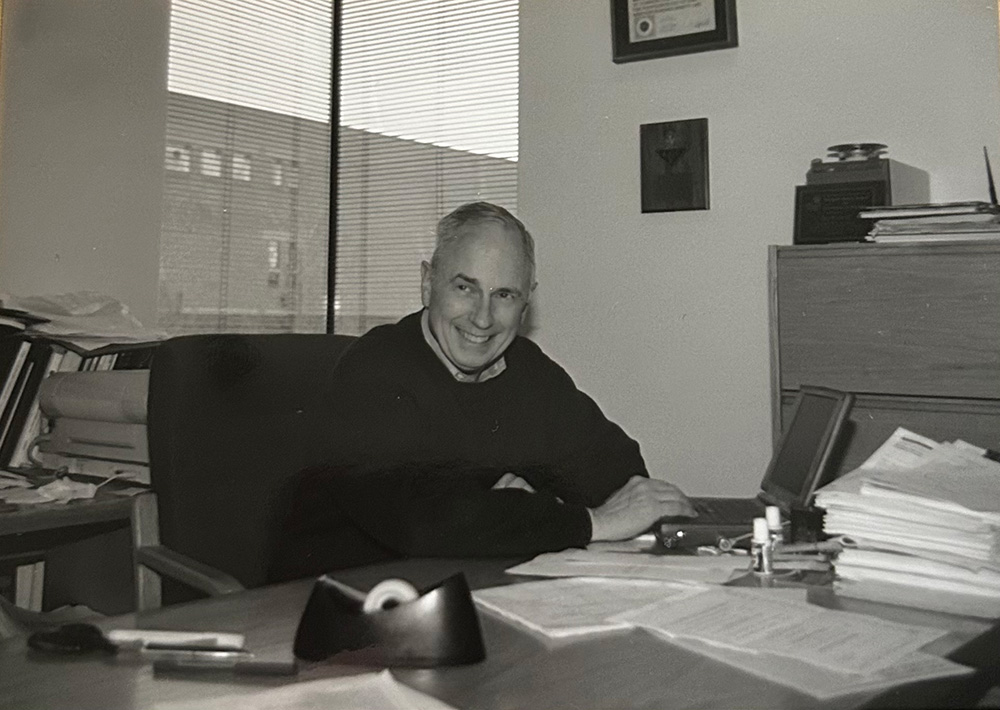 Early in Ted Eyring's tenure as chair (1973-76) the 1973-74 University catalog listed
the following faculty members in Chemistry:
Early in Ted Eyring's tenure as chair (1973-76) the 1973-74 University catalog listed
the following faculty members in Chemistry:
Distinguished Professors:
Henry Eyring, Bob Parry, Cheves Walling, Professors Evan Allred, Wes Bentrude, Bill Cagle, Bill Epstein, Ted Eyring, Jean Futrell, Pete Gardner, Cal Giddings, David Grant, Frank Harris, Ron Ragsdale, and Austin Wahrhaftig, Associate Professor Josef Michl, Assistant Professors Bill Breckenridge, Steve Hadley, Dale Poulter, Jack Simons, Len Spicer, Peter Stang, and Jim Wang.
At this time Millie Trevithick was the department secretary. She had had many years of experience in the Physics Department and ran the business of the Chemistry department both efficiently and pleasantly.
Frank E. Harris is a theoretical chemist with interests in the electronic structures of atoms, molecules and solids. His work has ranged from the development of new calculational methods to detailed studies of specific systems that can be related to experiments. Some of the present day superstars of theoretical chemistry-including H.F. (Fritz) Schaefer (Georgia), Howard Taylor (USC) and Josef Michl (Colorado)-got some of their early research experience in Frank's research group. At the University of Utah, Frank was first appointed to the faculty in Physics and later had a joint appointment in both Physics and Chemistry. Frank was also Dean of the College of Science in the early 1970's. He resigned his faculty appointment in Chemistry in 1998 but still has a part-time faculty appointment in Physics.
During his three-year chairmanship, Ted Eyring had the opportunity to hire only one new faculty member, Professor William (Bill) A. Guillory. Bill had a Ph.D. from UC Berkeley, and was a tenured faculty member at Drexel University in Philadelphia. He had a strong chemical physics research operation involving a variety of laser spectroscopic tools. Bill joined the University of Utah faculty in 1974 and assembled a big group of research co- workers located in the general vicinity of the present high vacuum surface spectroscopy lab in the North Wing. Bill has a truly charismatic personality. With his extraordinary leadership skills it made sense for him to become chairman in July 1976, just two years after joining the faculty.
Bill had the opportunity to hire three members of the present faculty: Richard D. Ernst (1977), Joel M. Harris (1976), and Gary E. Keck (1977). Rick Ernst's research program in synthetic inorganic chemistry continues to be productive and has given rise to ongoing federal funding as well as many Ph.D. students and widely cited scientific papers. Rick has also gained a well-deserved reputation for excellent teaching.
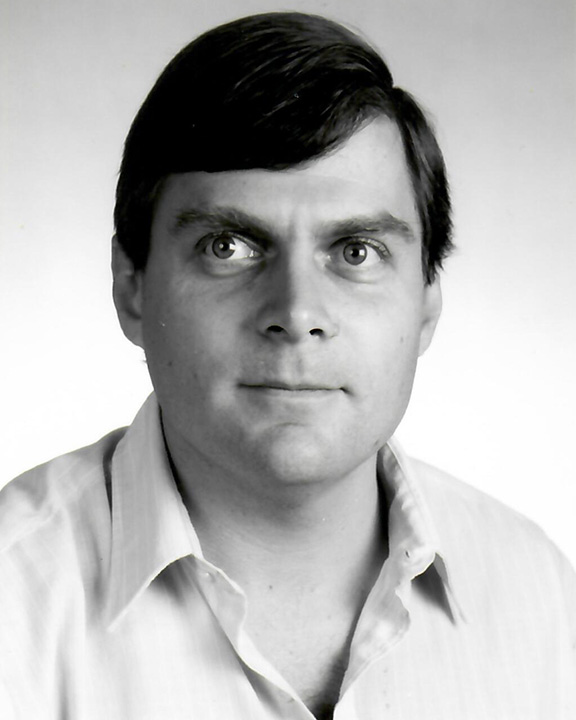 Joel Harris was awarded the rank of Distinguished Professor in the year 2000 in recognition
of his extraordinary achievements as a teacher and researcher in analytical chemistry.
His pioneering research in developing instrumentation to study phenomena such as fluorescence
and the thermal lens effect resulted in his receiving the ACS Division of Analytical
Chemistry Award in Chemical Instrumentation in 1991. For several years now Joel has
been editor-in- chief of Applied Spectroscopy, one of the most frequently cited periodicals
in analytical chemistry.
Joel Harris was awarded the rank of Distinguished Professor in the year 2000 in recognition
of his extraordinary achievements as a teacher and researcher in analytical chemistry.
His pioneering research in developing instrumentation to study phenomena such as fluorescence
and the thermal lens effect resulted in his receiving the ACS Division of Analytical
Chemistry Award in Chemical Instrumentation in 1991. For several years now Joel has
been editor-in- chief of Applied Spectroscopy, one of the most frequently cited periodicals
in analytical chemistry.
Gary Keck is a demanding teacher of organic chemistry and his publications in the areas of synthetic chemistry and natural products chemistry are among the most cited in the world. Several of his former Ph.D. students are making their own mark in synthetic organic chemistry. Gary has become a vocal proponent of better digital computing opportunities for University of Utah undergraduates.
Bill Guillory also participated in the hiring of a more senior faculty member, Charles S. (Chuck) Fadley. Chuck had established a first rate XPS surface science research program at Hawaii before he joined the University of Utah faculty in 1979. After two years at the university, Chuck elected to return to Hawaii for personal reasons. The surface science expertise, which the department needed, came much later (in 1989), with the appointment of Thomas P. (Tom) Beebe, Jr.
Bill Guillory also devoted a great deal of energy and time to promoting the reputation of the department throughout the world. He was first to start the comprehensive matching of faculty with national and international awards, identifying every award available in chemistry and chemical physics that related to University of Utah faculty expertise. That first year the number of awards made to university faculty members went up by more than 300%. This approach has since been institutionalized in the department by a standing Awards Committee, presently chaired by Joel Miller.
Bill also began a formal program of bringing in undergraduate students to do summer research for possible recruitment into our graduate program. That program produced 20% to 33% of our new graduate students of the period. This program was institutionalized under the direction of Associate Chairman Richard (Rick) Steiner, who was hired by Guillory to be the first permanent associate chairman for the department in the summer of 1977.
Toward the end of his chairmanship, Bill successfully negotiated an agreement with President David P. Gardner to fund the South Wing addition to the Chemistry Building. The Chemistry South Wing did not get to the top of the State Building Board construction priority list while Bill was chairman, but President Gardner did follow through later on this commitment to Bill. The Chemistry Department was fortunate that the university was presided over by a person favorably disposed toward the physical sciences at the same time that Chemistry had a chairman who was an especially gifted negotiator. Bill stepped down as Chairman on July 1, 1979. He resigned his professorship in 1986 to begin working full time in his own consulting company, Innovations International, which continues to prosper in Salt Lake City.
Professor Josef Michl succeeded Bill Guillory in 1979 as Chairman. In 1978, Josef published eighteen research papers back-to-back in a single issue of "JACS" [J. Am. Chem. Soc. 100, 6801-6898 (1978)]. This phenomenal research productivity was just one highlight of his years (1971-1987) as a faculty member at the University of Utah, but it suggests the dynamic impact he had on research in the department as Chairman from 1979-1984. The growth in research activity exacerbated the need for more laboratory space. Professors Michl, Frank Harris and Austin Wahrhaftig therefore documented the detailed space needs in a proposal that Professor Michl carried to President David P. Gardner. This document reinforced the President's determination to go ahead with an expansion of the still fairly new Chemistry Building. Professor Austin Wahrhaftig played a critical subsequent role in the design of the new South Wing, which was completed and opened in 1986. There is a wall plaque in the vestibule to the South Wing (second floor) that honors Austin for his thoughtful design work on both wings of the Chemistry building.
Another important legacy of the Michl years is the use of departmental resources to build and maintain technical services (electronics shop, machine shop, glassblowing shop, optical spectroscopy services, x-ray diffraction services, NMR services, mass spectroscopy services, digital computing services, etc.). It is these resources that are the envy of major chemistry departments throughout the United States. At the time that Josef began this change in departmental spending habits, it was more the rule that each faculty member involved in research secured his or her own major pieces of equipment for new research initiatives. The pooling of resources through departmental cost centers fostered by Josef has had an obvious beneficial effect on the growth of research in Chemistry at the University of Utah. One of the reasons that the shared use concept has worked so well is that scientists/engineers have been hired by the department to supervise the use and maintenance of this instrumentation and in some cases actually to run experiments on these instruments for research students. It would be difficult to list all the talented people who have served in this capacity over the past 20+ years. Persons currently (Oct. 2000) charged with these responsibilities include Dr. Elliot Rachlin (mass spectroscopy), Dr. Atta Aarif (x-ray crystallography), and Dr. Charlie Mayne and Dennis Edwards (NMR and EPR spectroscopy).
Another key to the strength of the University of Utah's chemistry research program has always been the high quality of the services offered by the department shops. The talented people presently heading up these services are Dale Heisler (electronics shop), Dennis Romney (machine shop), and Janice Kyle (glassblowing shop). From an historical point of view, one of the greatest stories in the technical services area at the University of Utah is the 30+ year term that Hans Morrow served as the glassblower (for the entire campus) before his retirement in 1998. In addition to being able to make or mend every conceivable form of scientific glassware, Hans was Chemistry's resident chess champion and all-around nice guy.
Not all of Josef's innovations took root. Josef initiated "Utah Chemistry Workshops" held at our mountain resorts. At these five-day meetings attended by most of our faculty and graduate students, the principal speakers were a combination of local faculty and distinguished scientists brought in for the occasion. For instance, in September 1981 Geraldine Kenny-Wallace (University of Toronto) and Stephen R. Leone (University of Colorado) were among the invited speakers addressing various aspects of "Lasers in Chemistry," the topic of this particular workshop. In September 1983, the title of the workshop was "Gas Phase Ion Chemistry Mass Spectrometry." In September 1984, the name of the workshop was simply "Biological Chemistry." Attendees at these workshops were generally enthusiastic. The workshops disappeared from the Chemistry Department annual program because of their cost.
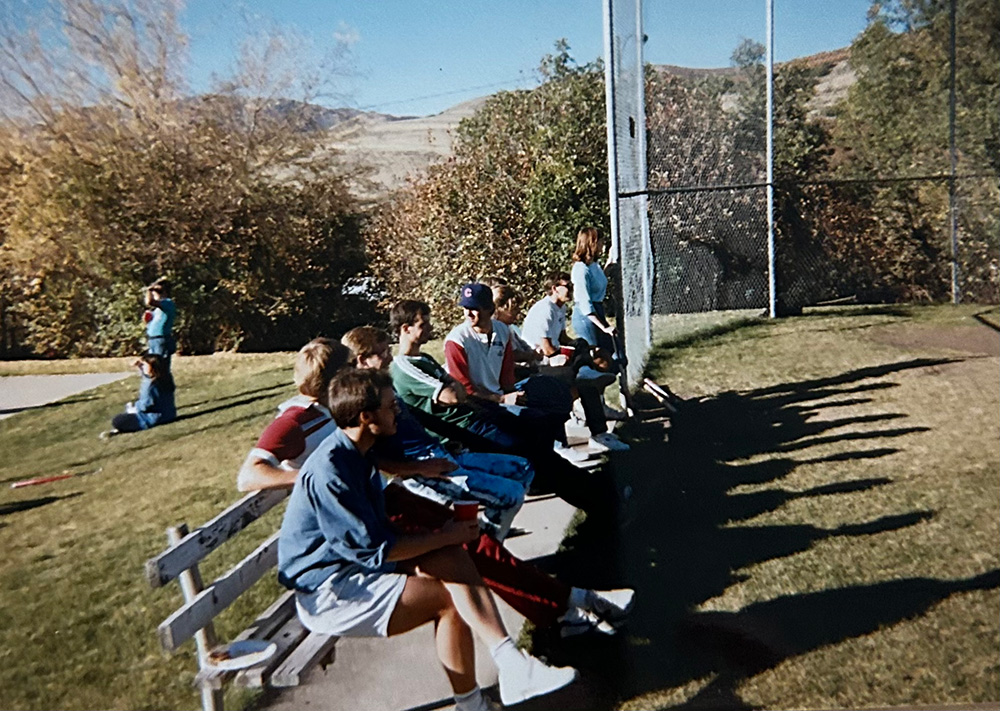
During his five-year tenure as Chairman, Josef made an important administrative change that has had a long lasting positive impact on the Chemistry Department. Rosemary Laufer assumed her present day duties as Administrative Assistant to the Chair.
In December of 1980, the University gave the name of Henry Eyring to the Chemistry Building (North Wing). The occasion was marked by a ceremony in the foyer of the building at which Professor Richard B. Bernstein was the invited speaker.
Professor Henry Eyring also spoke humorously and was clearly appreciative of the great honor of having a building named after him. The tradition on the University of Utah campus was to name buildings either for former presidents of the university or for major financial donors to the university, or persons who have passed away. Henry Eyring did not qualify on any of these counts. At the building dedication Henry told the following apocryphal story: "As I was dozing lightly in my office some weeks ago, in walked President Gardner unannounced with one of the Regents. They strode around me and my desk several times, clucking softly and looking at me very closely. Finally President Gardner said to the Regent, 'Yes, I think he is close enough', and the two of them exited my office without another word. They evidently concluded on that occasion that I was near enough dead that I could cause the University no further embarrassment if they named a building after me." Henry Eyring died in late December 1981 while still serving as a full-time member of the Chemistry faculty and principal investigator of a major research grant that funded the last of his students, Allan Peoples. Allan completed his Ph.D. dissertation several years later with the generous help of Dennis Caldwell.
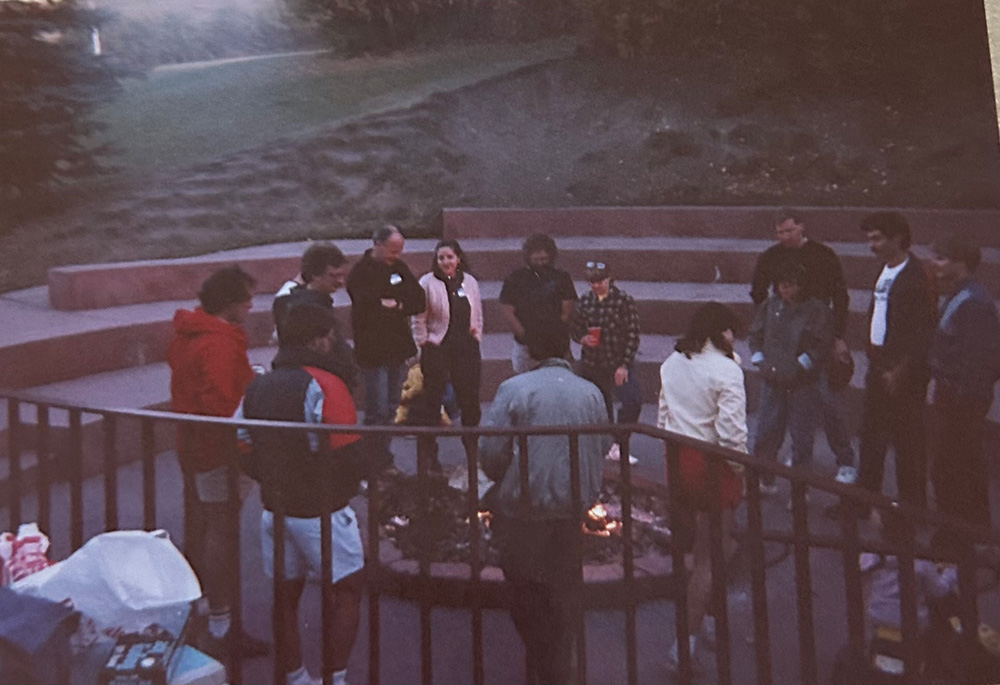 |
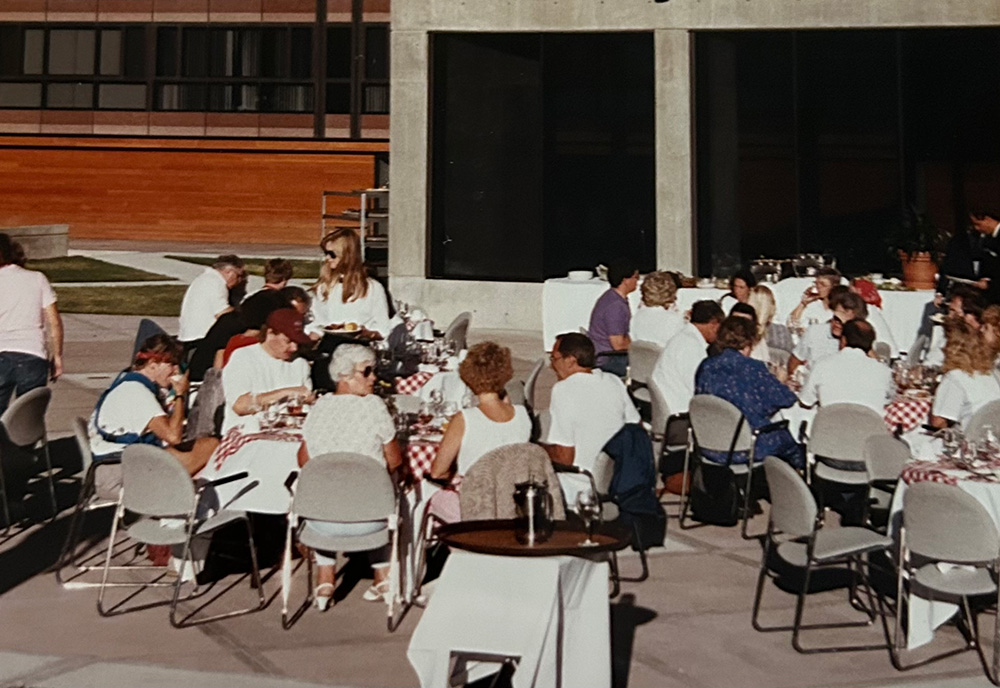 |
In 1982, Bob Parry served as the elected president of the American Chemical Society. His three-year tenure as president-elect, president, and immediate past-president of the Society afforded the Chemistry Department positive visibility in the international chemical community that one can get in no other way.
Josef Michl had the opportunity to make several faculty appointments during his five-year tenure. Randy Shirts, a theoretical chemist, and Jim Takacs, an organic chemist, were appointed to the rank of Assistant Professor in 1982. Randy is now a professor at Brigham Young University, and Jim is a professor at Nebraska.
John Gladysz was also appointed to the faculty in the rank of Associate Professor in 1982. John went on to publish many scientific papers at the University of Utah and won the ACS Award in Organometallic Chemistry in 1994. One of the many ways that Josef Michl drew favorable attention to the University of Utah was by editing Chemical Reviews, an influential monthly periodical of the American Chemical Society. Josef enlisted John Gladysz as co-editor. It was a blow to the department in 1998 when John Gladysz accepted a chaired professorship at the University of Erlangen/Nürnberg in southern Germany.
B. Stanley Pons was hired as an associate professor in 1983. Stan came to the department from the University of Alberta at Edmonton and brought a strong electrochemical research program to the department. He had already made a reputation for innovation with his work on microelectrodes and for his refinement of IR spectroscopy of adsorbed mono- layers on electrodes viewed through an exceedingly thin layer of electrolyte solution. A little less than five years later, he served an eleven- month term as department chair.
Another Michl appointment was Charles A. (Chuck) Wight to the rank of assistant professor in 1984. Chuck is a physical chemist with a pre-Utah background in infrared spectroscopy and gas phase ion chemistry. At the University of Utah Chuck has built a strong research program in explosives and in thermochemistry generally. For instance, his students can tell from thermogravimetric measurements how long aspirin retains its efficacy in dry Utah weather compared to a warm, humid climate. Chuck has become the campus guru concerning courses taught over the Internet. He also served in the influential but time- consuming role of President of the University Senate in 1999-2000.
Ted Eyring served a second term as department chair from July 1, 1984, to June 30, 1985. The following memo to the Chemistry faculty dated November 2, 1984, typifies Ted's notion of what should interest a faculty member.
The following table from the same period casts the University of Utah Chemistry Department in an even more favorable light.
During Ted's one-year second turn as chairman, two new Assistant Professors joined the faculty: Michael Morse and Thomas (Tom) G. Richmond. Michael had been a graduate student at Chicago in theoretical chemistry and then a post-doc in the Smalley group at Rice. At the University of Utah he and his students have become well known for their elegant laser spectroscopy of metal atom clusters in the gas phase. Michael has won the University-wide Distinguished Research Award (1997) as well as the Distinguished Teaching Award (1999). Each of these awards is made to only a very few faculty members each year and Michael is the only Chemistry faculty member who has managed to win both awards.
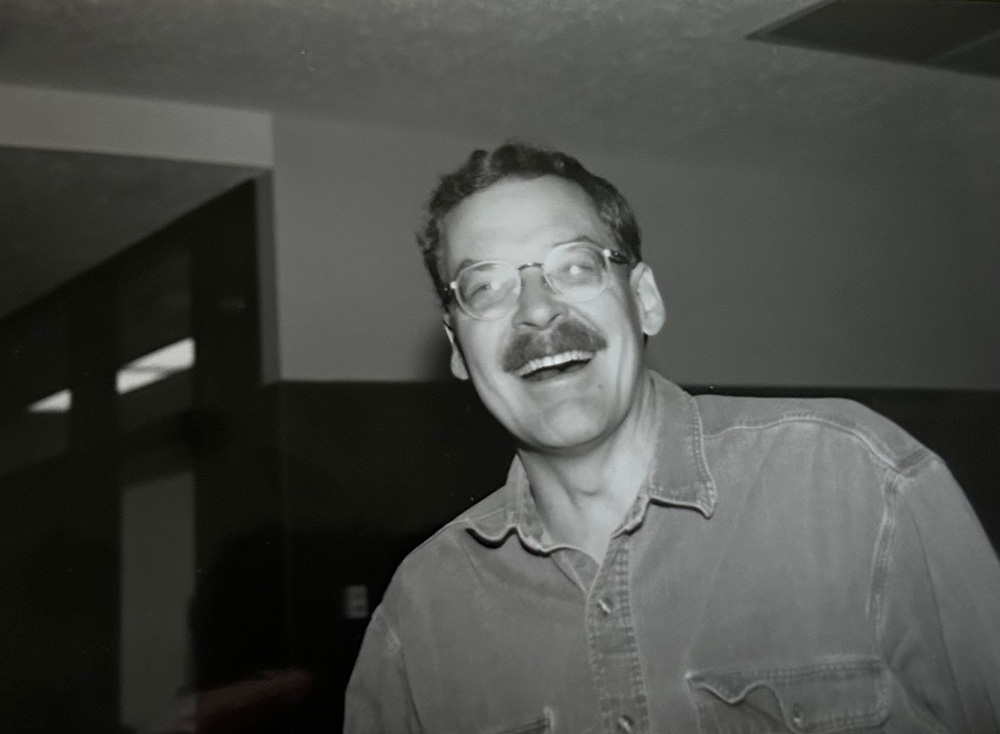 |
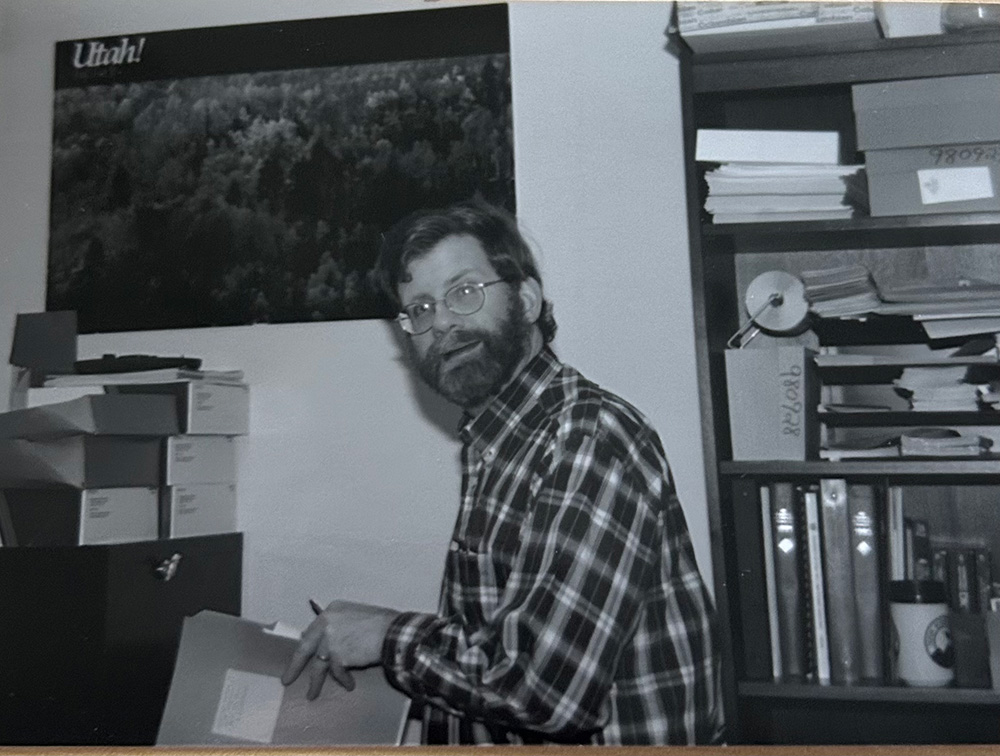 |
||
| Tom Richmand | Michael Morse |
Tom Richmond is a synthetic inorganic chemist who earned his Ph.D. at Northwestern and did postdoctoral work at CalTech. He shared the ACS Nobel Laureate Signature Award for Graduate Education with his Ph.D. student, J. L. (Jackie) Kiplinger, in 1998. His research has focused primarily on the synthetic organometallic chemistry of fluorocarbons.
The appointments of Michael and Tom became effective on July 1, 1985. On this same day one of the mainstays of the department staff retired after more than 30 years of service. Gordon Hale had done a truly first class job of running the stockroom and other business aspects of the department and was honored by an open house that day in the HEB foyer.
Jack Simons began serving as department chairman on January 1, 1986. In the spring of 1986 the Chemistry faculty members were delighted by the election of Professor Josef Michl to membership in the National Academy of Sciences. Joy gave way to dismay shortly thereafter when Josef accepted a very attractive job offer from the University of Texas at Austin.
The following news article from the Sunday, November 9, 1986 issue of the Salt Lake Tribune, page 10B, captures the general tenor of that time nicely.
The article mentions an "endowed chairmanship" when what is meant is an "endowed chair". A university invests an endowment of a million or more dollars in securities, and part of the income each year from the endowment is spent by the chairholder on her/his research. Professor Robert Parry and others have succeeded in raising more than $1.25 million from private donors to fully fund the Henry Eyring Presidential Endowed Chair in Chemistry. This success came in the year 2000, nearly 14 years after Josef Michl expressed pessimism to the writer of the news article above. There is another endowed chair in the Chemistry department called the John A. Widtsoe Chair, created for Prof. Dale Poulter at a time when he was contemplating a very attractive job offer from Indiana University. The Widtsoe Chair was one of four chairs funded by the President of the University from research grant overhead money rather than from private donations.
During Jack Simons' chairmanship the department expanded into the new south wing of the HEB. Jack recognized this as a good opportunity to recruit new faculty members because of the availability of this new resource. Thus he led the recruiting of three new people: A biochemist, Thomas C. (Tom) Alber, and two physical chemists, Peter Armentrout and A. D. J. (Tony) Haymet, were all appointed in 1987. Tom Alber's appointment as an assistant professor was shared between both the Chemistry and the Biochemistry Department. Five years later Tom accepted a position in Structural Biology at Berkeley.
 Peter Armentrout had earned a Ph.D. at CalTech in the lab of Jack Beauchamp, done
postdoctoral work at Bell Laboratories, and been a faculty member at the University
of California Berkeley for several years before coming to the University of Utah in
1987 as Associate Professor. His research using high vacuum instrumentation has elucidated
the thermodynamics of a wide range of gas phase systems. For instance, he and his
co-workers have explored the interactions of simple metal cations with crown ether
ligands in ways that complement the efforts of chemists working with these systems
in the liquid phase. Peter's work is so widely cited by other scientists that he ranked
84th by total citations among 627,871 chemists world-wide in the interval between
1981 and June 1997. Peter was awarded the rank of Distinguished Professor in 1998.
In addition to all of these accomplishments, in November 2000, Peter was named the
Chemistry Department Chair effective January 2001.
Peter Armentrout had earned a Ph.D. at CalTech in the lab of Jack Beauchamp, done
postdoctoral work at Bell Laboratories, and been a faculty member at the University
of California Berkeley for several years before coming to the University of Utah in
1987 as Associate Professor. His research using high vacuum instrumentation has elucidated
the thermodynamics of a wide range of gas phase systems. For instance, he and his
co-workers have explored the interactions of simple metal cations with crown ether
ligands in ways that complement the efforts of chemists working with these systems
in the liquid phase. Peter's work is so widely cited by other scientists that he ranked
84th by total citations among 627,871 chemists world-wide in the interval between
1981 and June 1997. Peter was awarded the rank of Distinguished Professor in 1998.
In addition to all of these accomplishments, in November 2000, Peter was named the
Chemistry Department Chair effective January 2001.
Tony Haymet was also a junior faculty member at UC Berkeley before coming to the University of Utah, also in the rank of Associate Professor. His expertise is in the theory of liquids, specifically liquid water. After a few years at the university, Tony accepted a chaired professorship in his native Australia. He has since become a Distinguished Professor at the University of Houston in Texas.
The space in the new south wing made it possible to install the first departmental computer used for theoretical simulations and the appointment of a full-time staff member to supervise the computing facility. (In the late 1990's the theoretical chemists were given new facilities in the INSCC building, and the facility in the Chemistry Department was adapted to the ever-increasing demands for computation by all groups in the department.) In addition, the new wing provided space for new electronics, machine and glass blowing shops, as well as for research operations of new faculty. Although state budgets were very lean during these years, the department leadership was able to move several staff positions (e.g., in shops and instruments facilities) from soft to hard funding and to have the technical support staff take on additional financial responsibility for the operation of their facilities. Even with all of the turnover in the Chemistry department faculty, external funding continued to grow. These new faculty members also gave the department the opportunity to remodel some of the laboratory space in the North HEB.
Stan Pons succeeded Jack Simons as Chair on May 9, 1988. The appointments of Walther R. Ellis, Jr., Gary F. Holland, and Fred G. West as Assistant Professors all became effective in the spring of 1988. Walther's expertise is in bioinorganic chemistry. He and his students did some beautiful studies of the protein hemerythrin from marine peanut worms before he moved to Utah State University in 1994. Gary Holland elected to take a job with an industrial research company in Redmond, WA (near Seattle) after two years on the University of Utah faculty.
Fred West is an organic chemist with a strong interest in the total synthesis of biologically important natural products using new organic reactions discovered in his laboratory. He and Chuck Grissom [see below] founded a company that explores the use of vitamin B-12 as a "Trojan horse" for introducing anti-cancer drugs into cancer victims. The eventual commercial success of this company would benefit the University through the payment of royalties for use of patented technology invented by West and Grissom. Many Chemistry faculty members (including Christensen, Epstein, Giddings, F. Harris, Poulter, and Wang) have formed off-campus companies following this general model. Fred West's wife, Dr. Christine Brzezowski, is an admired and much-awarded teacher in the undergraduate organic chemistry program of the department.
Another very important appointment made in 1989 during Stan's brief tenure as Chairman was that of Jack Simons as the first Henry Eyring Endowed Chairholder (the Chair was not fully funded at that time). This was the first endowed professorship in the history of the Chemistry Department. The event was marked by a beautiful reception in the backyard of the Rosenblatt House (the home of the University President). Jack remarked that: "This was the most proud and appreciated I have ever felt because this honor was bestowed by my friends and colleagues and because Henry was America's premier theoretical chemist." Jack did honor to the Henry Eyring Chair both by publishing many first rate scientific papers as the chairholder and by fostering a variety of programs for students using some of the financial proceeds from the Chair endowment. When Jack elected to begin phased retirement in 1998 and resigned the Chair, it was allowed to remain vacant while additional endowment funds were solicited. The Jon Huntsman family and the L.D.S. Foundation, through the offices of Dr. Rod Brady, generously completed the funding of the chair in the year 2000. A new chairholder has not yet been appointed.
Stan Pons did his doctoral dissertation research at Southampton University, where he developed a scientific collaboration with Professor Martin Fleischmann. In the 1980's Martin was a frequent visitor to Utah and had been given a courtesy visiting professorship at the University of Utah. On March 23, 1989, a press conference was convened at the University of Utah by President Chase N. Peterson to announce the discovery by Stan and Martin of cold fusion. The euphoria and disillusionment that followed that event have been told in many subsequent newspaper articles and books. The 365 page book [Charles G. Beaudette, Excess Heat: Why Cold Fusion Research Prevailed, Oak Grove Press, South Bristol, Maine, 2000] does a balanced job of recounting the story.
Stan Pons resigned from the chairmanship in mid-year to devote all of his professional time to cold fusion research, and Joel Harris unselfishly undertook the duties of Department Chairman from March 29 to September 14, 1989.
The appointment of Tom Beebe as an Assistant Professor began on January 26, 1989. Tom was a brand new Ph.D. from Pittsburgh who immediately went to the Lawrence Berkeley Labs to carry out postdoctoral research in Gabor Somorjai's laboratory. Tom's subsequent work at the university with various scanning probes investigating "molecular corrals" on solid surfaces has drawn a great deal of favorable international attention. Tom has also invested a lot of effort in the creation of a multi-user surface analysis laboratory with a wide variety of high vacuum instruments (e.g. XPS and SIMS) costing well over a million dollars.
The appointment of Charles (Chuck) B. Grissom as an Assistant Professor began on July 1, 1989. Chuck has research interests that range from biochemistry to analytical chemistry. He has made a name for himself by exploring the initiation of radical reactions by photoexcited coenzyme B-12. In 1994, he reported the first observed magnetic field effect on an enzymatic reaction.
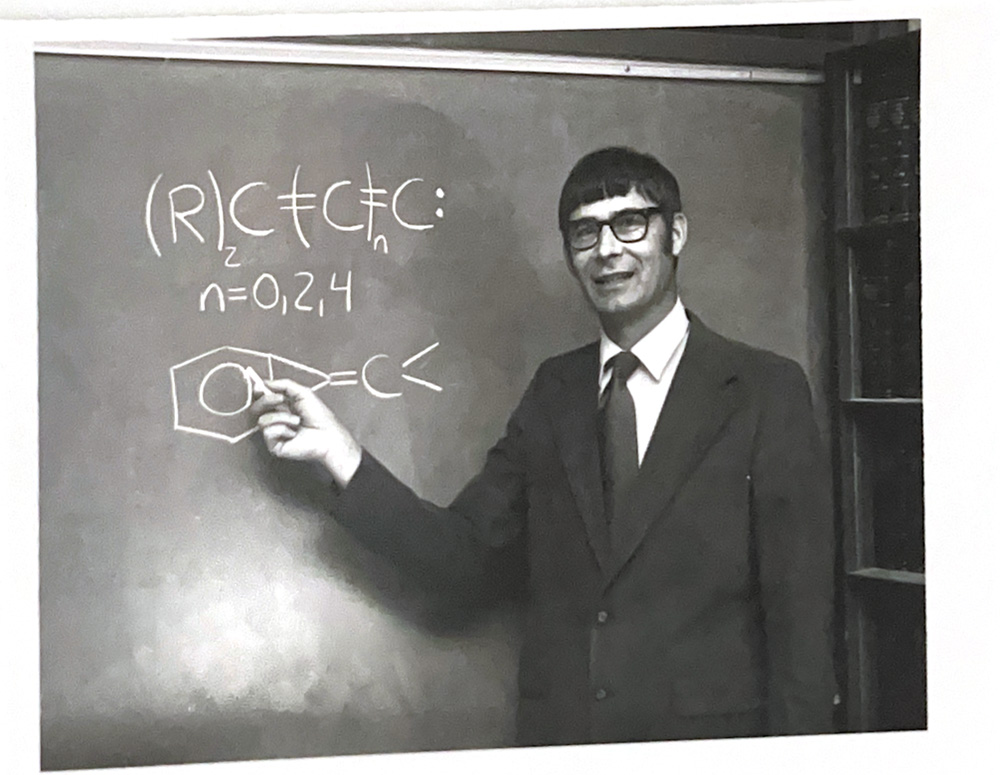 Peter Stang began his six years of service as Chairman on September 15, 1989. Among
Peter's most important accomplishments as Chairman was his resolution of the cold
fusion dilemma. Stan Pons wished to be relieved of his professorial teaching duties
while working full time on cold fusion research. Peter negotiated an arrangement in
which Stan resigned his tenured professorship effective Dec. 31, 1990, and subsequently
vacated a Research Professor position effective June 30, 1992. In November 1992 a
beautiful new laboratory near Nice, France, funded by Japanese business interests
was dedicated to house the continuing cold fusion research of Stan and Martin. Several
years later the University of Utah sold its rights to cold fusion patents to a private
company. As of June 2000, Stan Pons is no longer doing research in Nice. Stan is a
French citizen and resides with his family in southern France. Martin Fleischmann,
on the other hand, in the spring of 2000 was still actively exploring theories of
cold fusion and gave a scientific talk at the international cold fusion conference
held in Italy.
Peter Stang began his six years of service as Chairman on September 15, 1989. Among
Peter's most important accomplishments as Chairman was his resolution of the cold
fusion dilemma. Stan Pons wished to be relieved of his professorial teaching duties
while working full time on cold fusion research. Peter negotiated an arrangement in
which Stan resigned his tenured professorship effective Dec. 31, 1990, and subsequently
vacated a Research Professor position effective June 30, 1992. In November 1992 a
beautiful new laboratory near Nice, France, funded by Japanese business interests
was dedicated to house the continuing cold fusion research of Stan and Martin. Several
years later the University of Utah sold its rights to cold fusion patents to a private
company. As of June 2000, Stan Pons is no longer doing research in Nice. Stan is a
French citizen and resides with his family in southern France. Martin Fleischmann,
on the other hand, in the spring of 2000 was still actively exploring theories of
cold fusion and gave a scientific talk at the international cold fusion conference
held in Italy.
Janet Wisniewski- Grissom was appointed to the rank of Assistant Professor on May 29, 1990. She was the first female, tenure track faculty member in the Chemistry Department. She got off to a strong start with her organic chemistry research before resigning her faculty appointment to become a student at the University of Utah Medical School. She is now an M.D. specializing in psychiatry.
In 1992 Chemistry Department faculty members were delighted to bask in the reflected glory of Professor Bob Parry, selected that year to receive the Priestley Medal of the American Chemical Society. This highest award of the American Chemical Society was conferred on Bob for his extraordinary contributions to chemistry as a researcher, teacher and leader of the international chemical community. He did not stop giving at that point to the quality of the Chemistry Department. He continued to teach large undergraduate classes through 1994 and was highly praised by his undergraduate students to the very end of his long teaching career. Thanks to the generosity of the Rod Brady family, an annual Robert W. Parry Teaching Award was established in 1990 and first given to Bill Breckenridge. The award is made each year to an outstanding teacher in the Chemistry Department.
Professor Joel Miller joined the Utah faculty in 1992. Joel had been at DuPont in Wilmington, DE, where he had discovered organic molecular solids that are ferromagnetic. This research, which he has greatly expanded upon at the University of Utah with a large, well-funded research team, brought him the prestigious American Chemical Society Award in the Chemistry of Materials presented at the San Francisco ACS meeting in March 2000.
Thanh N. Truong was appointed to the rank of Assistant Professor at the University of Utah in 1992. He has developed a range of calculational tools for theoretical studies of combustion, solvation, zeolite catalysis, and interfaces. He was promoted to the rank of Associate Professor and granted tenure effective July 1, 1997. His early years in Vietnam as a cigarette peddler, buffalo-boy and plowman before fleeing to the U.S. by boat are part of a great Horatio Alger story told on his web-site.
Thomas J. Curtiss also joined the faculty as an Assistant Professor in 1992. He designed, built and successfully tested an elaborate high vacuum instrument for isolating a neutral radical from plasma and shooting the free radical at a solid surface using inhomogeneous electric field focusing methods. He now works at the Aerospace Corporation as a research scientist.
In 1993, Professor Henry S. White was appointed to the university faculty and brought a very strong research program in electrochemistry to the University of Utah from the University of Minnesota. He is an Associate Editor of the Journal of Electroanalytical Chemistry, and his students are using scanning probe techniques, microelectrodes, and other methods to study topics as diverse as magnetic field effects in electrochemistry and transdermal drug delivery.
Peter Stang led the recruiting of two senior chemists late in his chairmanship. Cynthia
(Cindy) J. Burrows and her husband, Scott L. Anderson, both joined the University
of Utah faculty in January of 1995. They were previously full professors at the State
University of New York at Stony Brook. Scott is a physical chemist who does experimental
studies of gas phase reactions involving polyatomic molecules, clusters of molecules,
and some surfaces. Scott has also made important leadership contributions
to the recruiting of several new Assistant Professors.
The Chemistry Department sustained several significant personnel losses during the 1990's. Prof. Jim Wang severed his ties to the University of Utah in favor of an endowed chair at Nebraska in September of 1990. Prof. Evan L. Allred died of cancer (at age 62) on July 8, 1991. In the course of almost thirty years on the University of Utah faculty, Evan had taught countless undergraduates in organic chemistry while publishing some excellent scientific papers on the synthesis and properties of strained ring organic molecules. Prof. Cheves Walling retired from the faculty in 1991. Dr. Jerry Mitchell, the longtime head of the department electronics shop, passed away on March 23, 1994. Professor Walter J. (Jim) Horton died on December 17, 1994. Jim was a faculty member at the University of Utah from 1946 until 1986 with two interruptions to serve as chair of the Chemistry Department at Haile Selassie University in Ethiopia (1963-65) and to serve on the faculty of the University of Ife in Nigeria (1968-71). One of his more unusual abilities as a teacher of undergraduate organic chemistry was his facility for rapidly writing formulas and equations on the blackboard while erasing simultaneously with the other hand. For the stenographically challenged students, this posed an interesting problem. Jim had a number of outstanding Ph.D. students, including Pete D. Gardner, mentioned earlier. For many years late in his career Jim collaborated closely in research with the David Grant NMR group.
Throughout this tumultuous six-year period (1989-1995) in the history of the Chemistry Department Peter Stang kept his own research program moving ahead rapidly with the aid of a number of talented students. Their work on the synthesis and properties of so-called molecular squares particularly generated widespread interest. From 1982 through 1999 Peter also carried the heavy load of Associate Editor of the Journal of the American Chemical Society. In the spring of 2000 he traded this responsibility for the even more demanding task of being Editor-in-Chief of the Journal of Organic Chemistry. Peter has accumulated honors that include being only the fifth U.S. scientist ever awarded an honorary degree by Moscow State University, the preeminent university in Russia. In 1995, he won the University of Utah Rosenblatt Prize for Excellence (other winners of this prize from Chemistry are David Grant and Dale Poulter). Peter was named the James Flack Norris Awardee in Physical Organic Chemistry of the national American Chemical Society in 1998. In the year 2000, Peter was elected to the U.S. National Academy of Sciences. This last honor is especially impressive since only three chemists were elected in the year 2000 and the demographics of the Academy weigh heavily against anyone being elected who does not reside either on the East or West Coast.
Utah ranked 22nd among all U.S. and Canadian Chemistry Departments in the number of publications per faculty member in the 1991 ACS Directory of Graduate Research. In 1993, the Gourman Report ranked the University of Utah Chemistry Department 22nd in graduate education nationwide. The University of Utah ranked 7th (behind Harvard, Stanford, Northwestern, Columbia, UT Austin, and Houston) in the average number of publications per faculty member in the 1993 ACS Directory of Graduate Research.
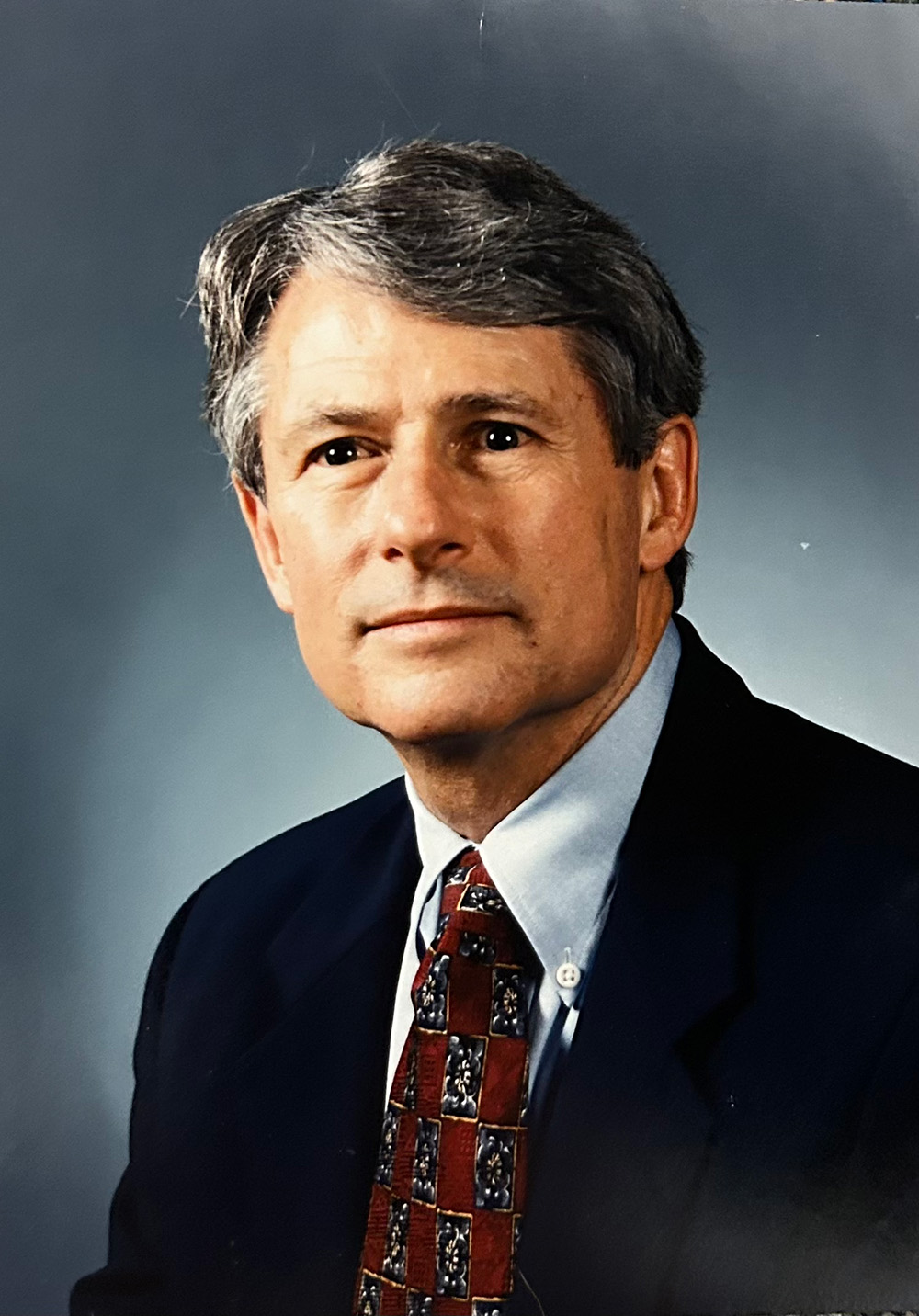 In July 1995 Professor C. Dale Poulter became the Chairman of the Chemistry Department.
Dale has a large, productive research group and an international reputation for creative
research. The group studies the 40-step reaction sequence that the human body uses
to manufacture cholesterol. His important discoveries continue to make very positive
news for the Chemistry Department. In addition, he received the Ernest Guenther Award
from the American Chemical Society for his work in isoprene metabolism. Among his
other duties, Dale is a Senior Editor for the Journal of Organic Chemistry and Associate
Editor for the new Journal of Organic Letters, where he handles manuscripts in the
developing area of bioorganic chemistry.
In July 1995 Professor C. Dale Poulter became the Chairman of the Chemistry Department.
Dale has a large, productive research group and an international reputation for creative
research. The group studies the 40-step reaction sequence that the human body uses
to manufacture cholesterol. His important discoveries continue to make very positive
news for the Chemistry Department. In addition, he received the Ernest Guenther Award
from the American Chemical Society for his work in isoprene metabolism. Among his
other duties, Dale is a Senior Editor for the Journal of Organic Chemistry and Associate
Editor for the new Journal of Organic Letters, where he handles manuscripts in the
developing area of bioorganic chemistry.
There have been a number of important milestones in the course of Dale's tenure as Department Chair. Finishing off the fund raising for the Henry Eyring Endowed Chair in 1999 was a major accomplishment, and the establishment of the Giddings Lectureship was another important achievement. Dale's initiation of "annual" overnight faculty retreats to brainstorm new directions for the department promises to have valuable long-term effects. For instance, we are now getting better control of seminar scheduling that at one recent point threatened to inundate the department with multiple seminars almost every working day. The department also survived the transition from academic "Quarter" to "Semester" scheduling in Autumn, 1998 with very few hiccups. Bill Breckenridge and Dave Grant are numbered among heroes of this sometimes-divisive event in the history of the University.
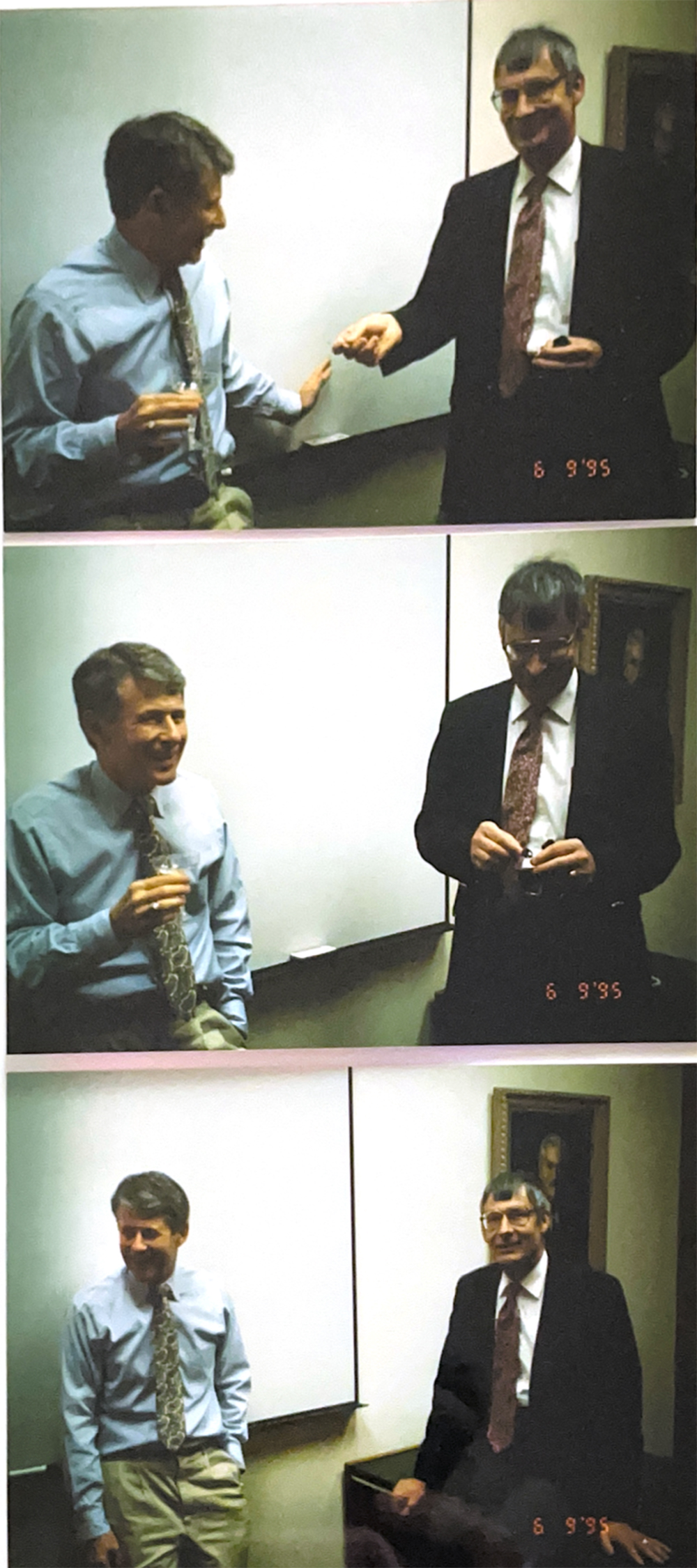 The department sustained a major blow when Professor J. Calvin Giddings died at age
66 on October 24, 1996. Cal was internationally known for his many contributions to
chromatography and the broader field of separation science. He was the author or co-author
of over 400 scientific publications and the editor of thirty-two books. Cal pioneered
classes focused on environmental issues before these concerns became widely fashionable.
He was also an indefatigable mentor of many graduate research students who learned
from him the intricacies of various forms of chromatography, including field flow
fractionation (FFF), a concept that Cal invented which became his primary identifier
late in his career. Over the years he raised a great deal of federal research money.
In another dimension, as a young scientist Cal was renowned for his skiing and daring
rock climbing. In later years he persisted in his enthusiasm for outdoor adventure
with kayaking trips in the U.S. and on the Apurimac River in South America, and still
later he got into mountain bike riding.
The department sustained a major blow when Professor J. Calvin Giddings died at age
66 on October 24, 1996. Cal was internationally known for his many contributions to
chromatography and the broader field of separation science. He was the author or co-author
of over 400 scientific publications and the editor of thirty-two books. Cal pioneered
classes focused on environmental issues before these concerns became widely fashionable.
He was also an indefatigable mentor of many graduate research students who learned
from him the intricacies of various forms of chromatography, including field flow
fractionation (FFF), a concept that Cal invented which became his primary identifier
late in his career. Over the years he raised a great deal of federal research money.
In another dimension, as a young scientist Cal was renowned for his skiing and daring
rock climbing. In later years he persisted in his enthusiasm for outdoor adventure
with kayaking trips in the U.S. and on the Apurimac River in South America, and still
later he got into mountain bike riding.
Professor Austin L. Wahrhaftig, about whom much has already been written above in this history, passed away on November 11, 1997.
Professors Bill Epstein and Frank Harris retired from the Chemistry Department faculty in 1998 and Wes Bentrude began phased retirement in 1998. The daunting challenge faced by the Department Chairman and the faculty is to hire new faculty members to get the teaching job done while also improving the quality of the research program in the department. This problem is aggravated by the growing difficulty of competing with other excellent departments who in some cases can throw as much as a million dollars in so-called start-up funds at a brand new Assistant Professor. These start-up funds were once very modest. Ted Eyring was given $7,000 to establish his research program when he was hired as an Assistant Professor in 1961. In the intervening years there has been a steady inflation of the dollar not commensurate with the jump from $7,000 to the presently prevailing start- up package cost at the University of Utah of $300,000 to $600,000 dollars. In Utah, the start- up money comes almost entirely from "returned overhead" on federal research grants. In other words, if a faculty member secures a research grant from the Department of Energy in the amount of $100,000, the University as “overhead” holds about $33,000 of that money back. It is this money that funds start-up packages for new faculty. The reason for injecting this budgetary pessimism into a "history" is that it helps the reader to make sense of the heavy emphasis of this history on who has been hired and who has retired, or otherwise left.
Before leaving the topic of research funding, we should draw attention to the October 30, 2000 issue of Chemical Engineering News. On page 58 of that issue the University of Utah is ranked 26th (in the year 1998) among universities and colleges in the United States with the most federal support for chemical research and development. That is up from a ranking of 34th in the previous year, 1997.
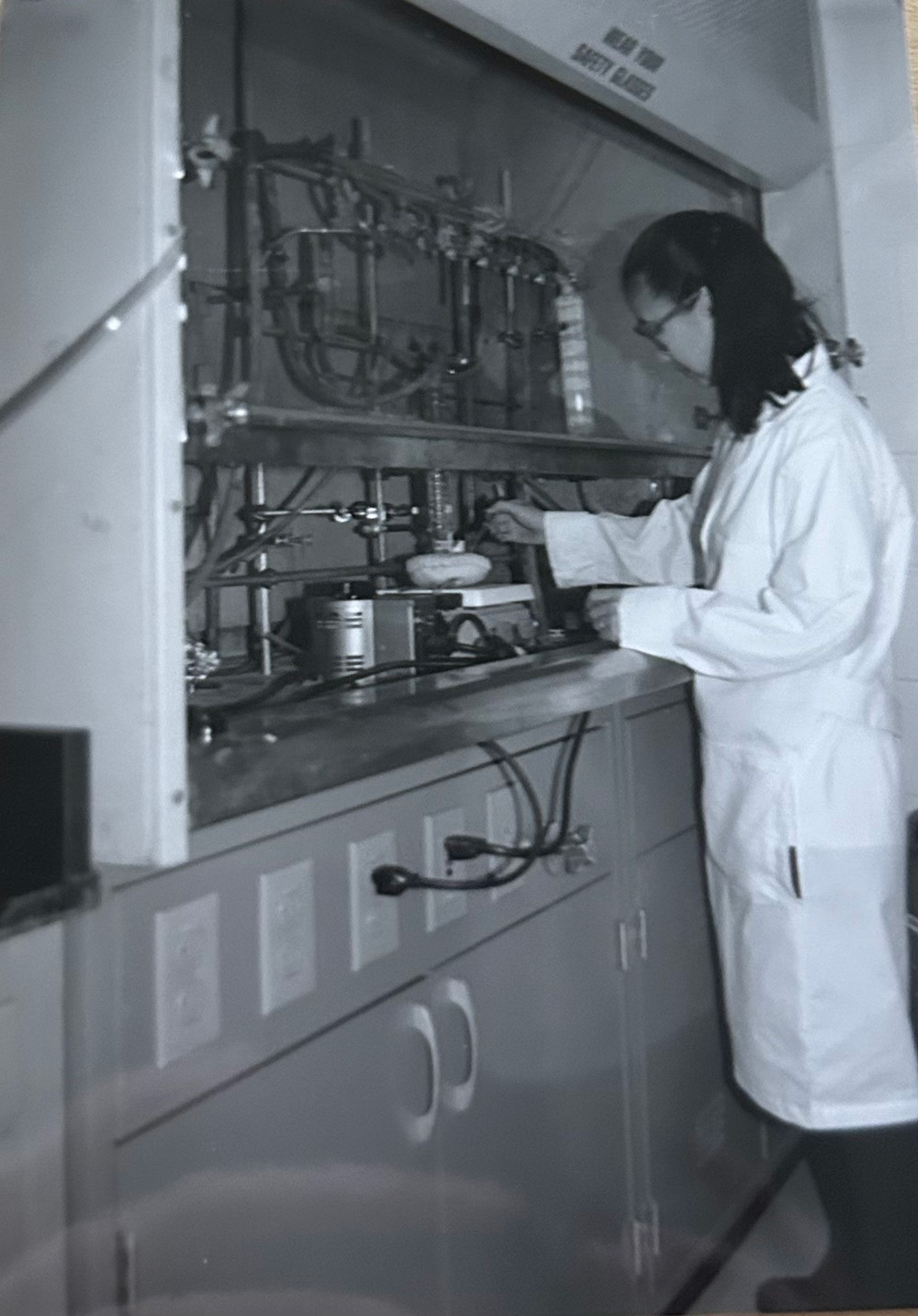 |
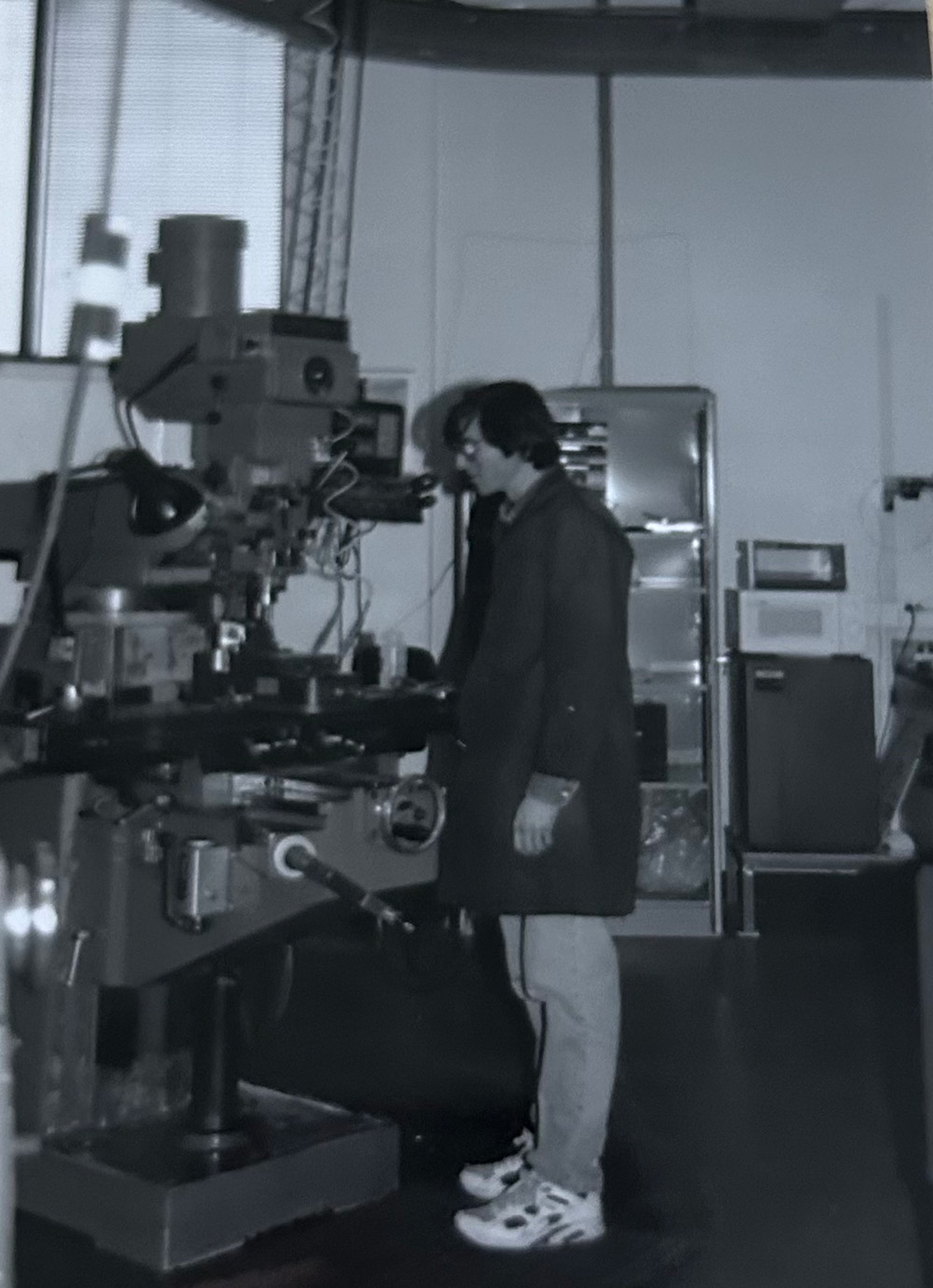 |
As chair, Dale Poulter has been the leader in the recruiting of several new faculty members. Assistant Professors Peter Beal and Sheila David joined the faculty in July 1996. Sheila is a bioinorganic chemist who brought an active research program from U.C. Santa Cruz, where she had taught for several years. Peter Beal came to the University of Utah from a postdoctoral research stint at Harvard. He is a bioorganic chemist interested in how small molecules interact with nucleic acids and proteins. They have become a husband and wife team since joining the University of Utah faculty.
Professor Gregory A. Voth came to the University of Utah in 1997. He was previously a professor at the University of Pennsylvania. At the "U" he has assembled a very large group of co-workers who are housed in the new INSCC building. Greg is the Director of the now-formalized Henry Eyring Center for Theoretical Chemistry and spends his very large federal research budget on fundamental theoretical studies of the dynamics of complex condensed phase systems.
More recent arrivals at the University of Utah include the following Assistant Professors: Matthew S. Sigman (1999), an organic chemist who came from a postdoctoral research experience at Harvard; Eric L. Hegg (1999), an inorganic chemist who came from a postdoctoral appointment at the University of Minnesota; John C. Conboy (2000) who was most recently a postdoctoral researcher in analytical chemistry at the University of Arizona.
An obvious deficiency of the above record is the focus on faculty rather than on former students. There is no easy remedy to this problem. Many of our former undergraduate, graduate, and postdoctoral students have gone on to spectacular careers in a broad range of professions. One of the few reliable mechanisms for getting reports of successes of former students is through their generous donations to the Henry Eyring Endowed Chair and other department Development Funds. W. Hoyt Andersen (Ph.D. 1952), Carlos M. Bowman (Ph.D. 1957), Melvin C. Cannon (M.S. 1938), David T. Chuljian (Ph.D. 1984), Bradley W. Cromar (B.A. 1982), Edward M. Eyring (Ph.D. 1960), David M. Grant (Ph.D. 1957), Taejon Han (Ph.D. 1995), Chen C. Hsu (Ph.D. 1972), Kak-Choong Kim (Ph.D. 1964), Sung Wan Kim (Ph.D. 1969), Steven M. Kuznicki (Ph.D. 1980), David J. Lentz (Ph.D. 1973), Marilyn Alder Marquis (Ph.D. 1951), Kenneth W. Nelson (M.S. 1957), Bryant W. Rossiter (B.A. 1957), Arthur L. Ruoff (Ph.D. 1955), Hyung K. Shin (Ph.D. 1961), Richard P. Smith (Ph.D. 1951), Doyle C. Udy (B.A. 1943), and Dan W. Urry (Ph.D. 1964) are numbered among the alumni who have been especially generous to the Chemistry Department.
Two true stories will illustrate the adventures of many of our former students. Leonard Wojcik, a graduate student from the 1970's was and is a particularly daring pilot of private, fixed-wing aircraft. In one notable exploit in Alaska he was dropping supplies from his aircraft to other people from the Chemistry Department on the ground who were participating in a climbing expedition. Leonard was the only person on board the plane and was pushing supplies out the door of the plane when the aircraft crashed, breaking both of Leonard's legs.
The 1990's saw one of our graduate students, Doug Gordon, killed while participating in a National Geographic Society sponsored kayaking expedition on the Tsangpo River in southeastern Tibet. A book about the ill-fated adventure is soon to be published nationwide. Gordon was a graduate student working toward a Ph.D. in Joel Miller's research group. These two true stories will make the casual reader appreciate that University of Utah chemists constitute a broader, more adventurous cross-section of the general population than many people would imagine.
The University of Utah Chemistry Department has grown significantly in the last half century and continues to do so. Professor David Grant is now leading an effort to secure funding for new construction that would double the size of the South Wing of the HEB. This facility will be needed to accommodate the growing number of students and faculty in the Chemistry Department. Here's to another half century of groundbreaking research, illustrious faculty members and scientifically gifted students!
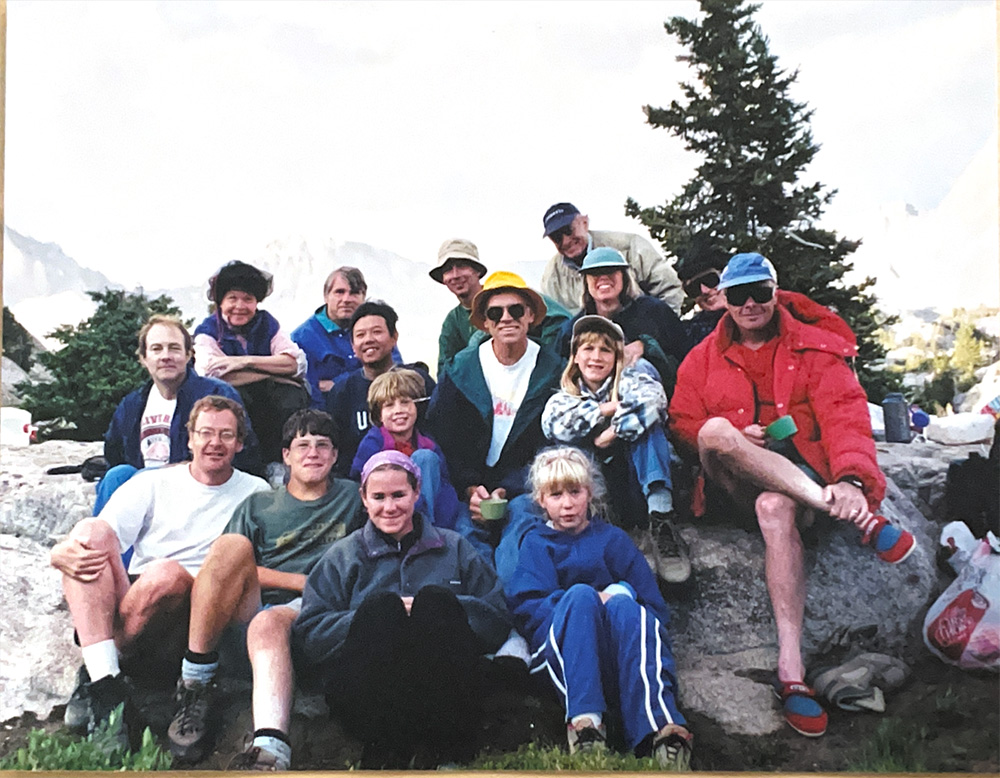
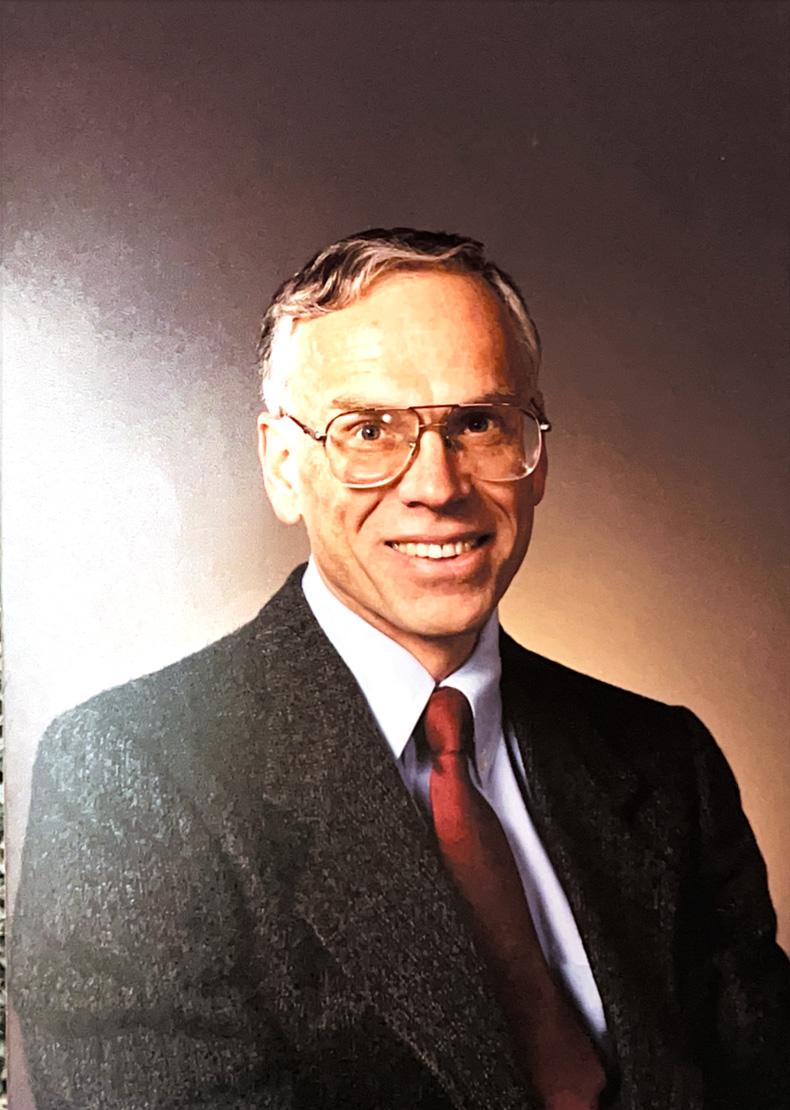 In the latter half of the year 2000, Professor Peter B. Armentrout was appointed University
of Utah Department Chair of Chemistry. He earned a B.S. degree in 1975 at Case Western
Reserve and his PhD. Degree in 1980 at CalTech. Peter has also done postdoctoral research
at Bell Labs and had been an assistant professor of physical chemistry at the University
of California, Berkeley for a few years before his appointment to the Utah faculty
in 1987. While at Berkeley, Peter began his ion-beam mass spectrometry studies of
metal molecule ions that continue to produce many national awards for Peter and his
students. A recent representative example of Peter’s knack for identifying and fostering
extraordinary student talent is the Distinguished Alumni award made by Utah in April
2014 to Professor David Clemmer, who is located at Indiana University. David earned
his PhD degree (1992) working with Peter at Utah. While working since then at Indiana,
David has successfully extrapolated Peter’s gas phase studies into the elucidation
of protein folding issues. The challenging questions raised by Peter in student oral
examinations and in visiting faculty seminars are hallmarks of what has made the science
of chemistry at Utah first-class in recent years.
In the latter half of the year 2000, Professor Peter B. Armentrout was appointed University
of Utah Department Chair of Chemistry. He earned a B.S. degree in 1975 at Case Western
Reserve and his PhD. Degree in 1980 at CalTech. Peter has also done postdoctoral research
at Bell Labs and had been an assistant professor of physical chemistry at the University
of California, Berkeley for a few years before his appointment to the Utah faculty
in 1987. While at Berkeley, Peter began his ion-beam mass spectrometry studies of
metal molecule ions that continue to produce many national awards for Peter and his
students. A recent representative example of Peter’s knack for identifying and fostering
extraordinary student talent is the Distinguished Alumni award made by Utah in April
2014 to Professor David Clemmer, who is located at Indiana University. David earned
his PhD degree (1992) working with Peter at Utah. While working since then at Indiana,
David has successfully extrapolated Peter’s gas phase studies into the elucidation
of protein folding issues. The challenging questions raised by Peter in student oral
examinations and in visiting faculty seminars are hallmarks of what has made the science
of chemistry at Utah first-class in recent years.
The election of Professor Peter J. Stang in 2001 to the U.S. National Academy of Sciences was very big news for the Department of Chemistry at Utah. Up to them there had been only one previous chemist, Josef Michl, who had begun his professional career in Utah and remained long enough at Utah to be elected an Academy member before leaving Utah. We will report the names below of more Utah Chemistry faculty members who have followed Peter Stang into the ranks of the NAS. (The late Henry Eyring and Cheves Walling were elected to NAS membership before joining the Utah Chemistry faculty, and their most notable chemical discoveries during long lifetimes were made before they moved to Utah.)
One of Peter Stang’s major chemical discoveries prior to 2001 was how to synthesize molecular structures containing metal-complex units that self-assemble into tiny machines with potential practical applications. Prof. Stang is also very highly valued for his extraordinary ability to teach young people at every level how to do creative new chemical science by his example in his laboratories and his classrooms. His skillful editing of the scientific work of other chemists preparing their discoveries for publication in the most prestigious “journal” (magazine) of the chemical profession which he edits, the Journal of the American Chemical Society (JACS), continues to have a huge positive impact on the chemical profession.
Joel S. Miller, another year after year well-funded full professor, was honored at the San Francisco national ACS meeting for his pioneering development of molecule-based magnets that will eventually replace iron and other metals in practical applications of magnetic fields. His ACS recognition is called the Chemistry of Materials Award. In addition to being one of the star scientists on the faculty, Joel has an impressive collection of science toys and covers of magazines featuring his firsts in science that make a visit to his office in the chemistry building, a rewarding pit stop. (Call ahead to make sure Joel is around before stopping by. His extensive world-wide scientific collaborations may very well have him in Japan, Israel, or elsewhere temporarily if you impulsively come calling by his office.)
The transition in the chairmanship of the Chemistry Department from Dale Poulter to Peter Armentrout was seamless. Challenges of keeping the Utah faculty young and competitive for national research dollars include recruiting new faculty who teach well, write winning research proposals, and at least tolerate living conditions in drought-stricken Salt Lake City. Dale and his colleagues had added 3 green assistant professors (John Conboy [analytical], Eric Hegg [inorganic], Matthew S. Sigman [organic]) and an experienced teacher/researcher (Greg Voth [physical]) to the faculty by the time Peter Armentrout took charge of Chemistry.
In mid-summer of 2001, Millie Trevithick passed away from Alzheimer’s. She was the ultra-dependable Chemistry Department secretary for many years when Dave Grant and later Ted Eyring were chairing the Chemistry Department.
To put the events noted above in context we recall that on the morning of September 11, 2001, terrorists used three commercial airliners to kill almost three thousand innocent people in New York, Washington D.C., and Pennsylvania. A dark undertone in the subsequent pages of this Chemistry history is the diminution of federal funding available for chemical education and chemical research since 9/11, arising from fiercely competing social and military national priorities. This task of chairing the Chemistry Department has become very challenging indeed, from the financial point of view subsequent to September 11, 2001.
In 2002, the Salt Lake Winter Olympics played a dominating role in the first three months of the calendar year in the life of the Utah Chemistry Department. While skiing competitions took place in the mountains around Park City and skating events took place beyond West Valley, the colorful parades of the opening and closing ceremonies took place in the renovated Rice-Eccles “Olympic” Stadium a few feet south of the Henry Eyring Chemistry Building.
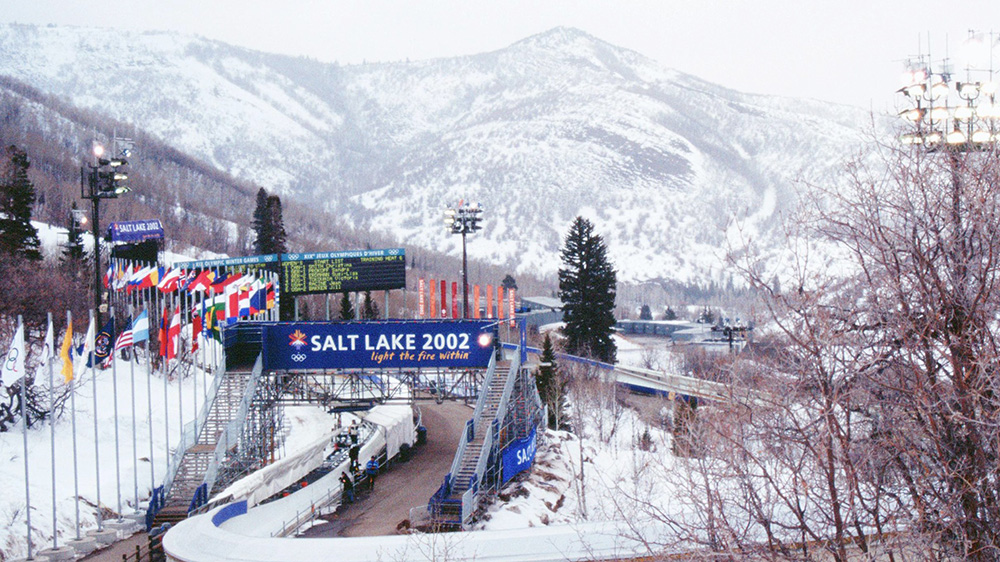
Many University of Utah students, faculty, and staff volunteered for temporary ushering assignments which helped make the Olympic Experience a resounding success for Utah. We seemed to see windbreakers, hats, and other paraphernalia bearing Olympic symbols. Security concerns were sometimes intrusive, but Chair Peter Armentrout correctly declared “having the Olympics in our backyard was the experience of a lifetime.”
On the science scene, Joel Miller’s “Light-Tunable Plastic Magnet,” Matt Sigman’s “New Catalytic Reaction,” and Henry White’s “Reinvention of the Battery” all made positive technical news.
Additions to the faculty included Peter Flynn (nuclear magnetic resonance) coming from the University of Pennsylvania, Janis Louie (inorganic and organic chemistry) from CalTech., and Jon D. Rainier (organic synthesis) from the University of Arizona.
The Department regretted the loss arising from Wes Bentrude changing to Emeritus status, Tom Beebe moving permanently to the University of Delaware, and Fred West moving to the University of Alberta. On February 1, 2002, Distinguished Professor David M. Grant began phased retirement.
Visibility of the Department in the international chemical community was greatly enhanced by Peter Stang becoming Editor of the Journal of the American Chemical Society with Henry White as one of his Associate Editors.
Also in 2002, Dale Poulter became the Editor of the Journal of Organic Chemistry with Cindy Burrows as an Associate Editor, and Joel Harris was reappointed as the Editor-in-Chief of Applied Spectroscopy. There is no doubt that some of our best chemistry classroom teachers are made less available to our undergraduate chemistry students by this exemplary service by some of our faculty to the chemical profession. However, the quality of new research being done in the department by undergraduates, graduate students, and postdocs is greatly enhanced by having many notable chemists visiting the University of Utah editorial offices in person or electronically and keeping some of our star Utah chemistry faculty/editors apprised of the hottest new developments in chemistry. One of the key ingredients required to make Utah a hub for editing great scientific periodicals continues to be gifted reader-writers- word-processors who cheerfully convert sloppy English into scientific literature. Charlotte Sauer, Julie Westwood, ... are a few of the stars at Utah who have successfully practiced this demanding witchcraft. They were or are paid by the journal in question with salaries passed through the University by the journal business offices.
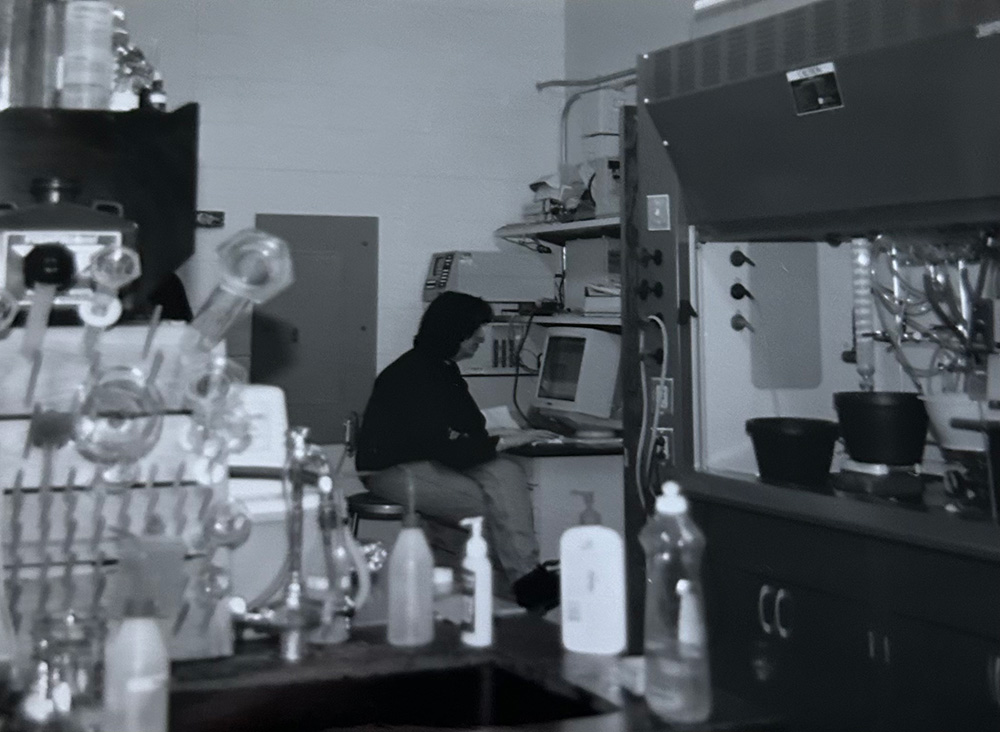 |
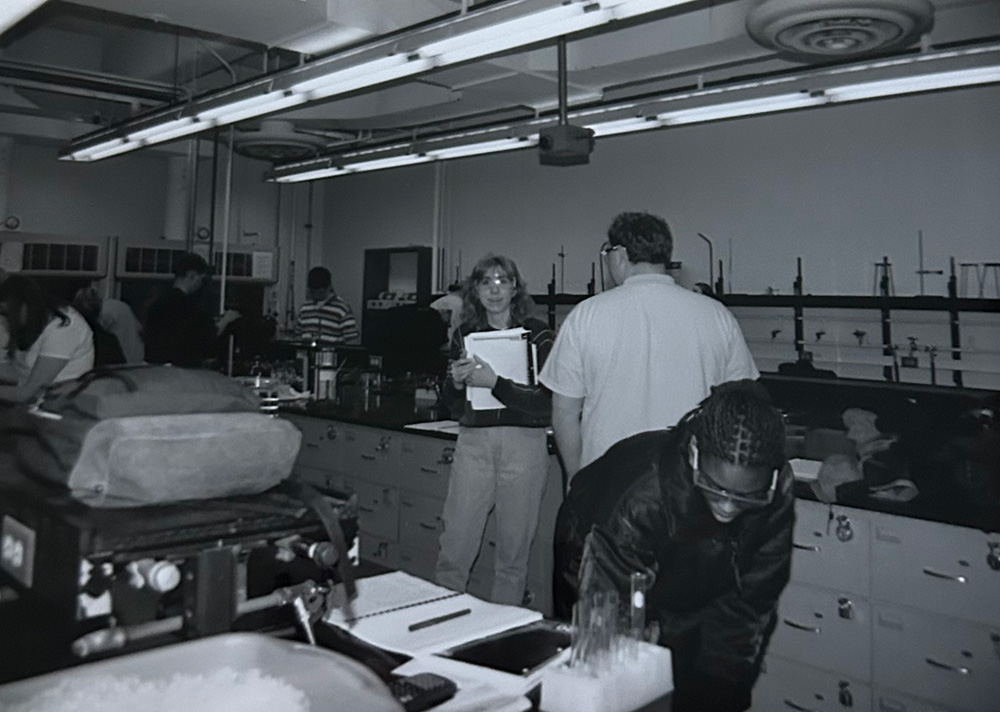 |
On October 5, 2002, Professor Stang was inducted into membership in the American Academy of Arts and Sciences at a meeting of the Academy in Cambridge, Massachusetts. This is an honor shared by other notables such as George Washington, Benjamin Franklin, Thomas Jefferson, Alexander Graham Bell, and Albert Einstein.
Peter Armentrout continued as Chair in 2003. Thus Peter A. was running the show when Ilya Zharov, a Ukrainian doing postdoctoral research in Josef Michl’s lab, accepted an Assistant Professorship in Chemistry at Utah.
In January 2003, Gretchen J. Domek was identified as a prestigious Rhodes Scholar bound for Oxford University. During her time as an undergraduate at Utah, Gretchen had done research in the Biology Lab of Professor David Goldenberg, had particularly enjoyed course work with Professors Rick Ernst and Joel Harris, and had been a member of the Utah intercollegiate cross country ski team for two years.
One of the important administrative innovations of Peter Armentrout’s tour as Department Chair was the creation of monthly “brown bag lunches” attended by the full department faculty. Customarily, two faculty members are deputized by the Chair to talk for about 25 minutes each about their current research. No slides, overheads, handouts or movies are allowed. The speaker may write on the blackboard (or white board) in the course of the talk, but questions from the audience and answers from the speaker get the main emphasis of each performance. Faculty members bring their own sack lunch and drink soda water and eat cookies provided by the Chair.
This sort of preview of “amazing scientific discoveries” can be the means of encouraging publication in peer reviewed journals that head off “cold fusion” type papers before they reach the popular press.
Providing adequate space for laboratory research was a special concern in 2003. What was probably unforeseeable was how much the space needs would change as the composition of the faculty would change and the physical size of NMR high-field research instrumentation would also decrease. In spring 2003, Dave Grant and a small army of NMR research coworkers were using (then) state-of-the-art spectrometers with wide magnetic fields. The design of the new David M. Grant NMR facility with huge open bays for 2 new NMR spectrometers that would avoid overlap of magnetic fields moved forward.
Since the mid-1980s, Professor Arthur J. Epstein at Ohio State University and Joel Miller at Utah had been developing plastic magnets that conduct electricity. In 2003, a new kind of electronics called spintronics based on a plastic called vanadium tetracyanoethanide, or TCNE, seemed very promising. Spintronics can let computers store and transfer twice as much data per electron as in a traditional semiconductor such as silicon or gallium arsenide. A bonus is that once a magnetic field pushes an electron into a direction of spin, it keeps spinning the same way until another magnetic field causes the spin to change. This property facilitates quick access of magnetically stored information during computer operation even if electrical power to the computer is switched off between uses. Thus data can be stored permanently and is available instantly at any time. Perhaps most remarkably, plastic TCNE works all this magic at temperatures as high as 100°C.
As we embark now on a consideration of what transpired in the Utah Chemistry Department in the year 2004 it may be helpful to pause first to consider briefly the dramatic change in the flavor of what was happening in the classrooms and laboratories over the half century between 1954 and 2004. In 1954, Bill Burke and his faculty of a dozen profs were teaching in what is now the Widtsoe Building on Presidents Circle and in several World War II era refurbished wooden barracks buildings. There was no refrigerated air conditioning and freshmen laboratory students sweltered in a big top floor lab with no fume hoods. All the lectures were delivered to students in poorly illuminated lecture halls with the instructors writing on blackboards. The saving grace was that the lecturers (Lloyd Malm, Jim Sugihara, Jim Horton, Henry Eyring, and Austin Warhaftig, to name a representative few) were bright minds with great enthusiasm for their subject matter. Chemical research was being carried out largely by talented graduate students. The eight Ph.D.s who graduated in 1954 included Cal Giddings who went on to become the international star of his generation of chromatographers. Cal’s conception and execution of several “field flow fractionation techniques'' continue to find practical applications among practical chromatographers worldwide. Returning our focus to chemistry at Utah in 1954, calculations were done by physical chemistry graduate students and postdocs on mechanical calculations and slide rules. Biochemical research was being carried out mostly in the Medical School. Only one woman, Marilyn Grace Alder, had graduated in Chemistry with a Ph.D. degree (in 1951).
In 2004, Peter Armentrout was beginning his second three-year term as Department Chair. He had a faculty of about thirty professors housed in a complex of modern, well-ventilated classrooms and laboratories called the Henry Eyring Building. Striking changes at the fifty-year mark included many more women students at every level in 2004, and four truly gifted women on the tenured or tenure track faculty. Back in 1954, the modest reputation of the Department rested largely on the research achievements of Henry Eyring and the bright young physical chemistry Ph.D.s (Ransom Parlin, Bruno Zwolinski, Rufus Lumry, Bill Cagle) who had gathered around him. In striking contrast, in 2004, the research reputation of the Department rested on the achievements of a balanced team of organic, inorganic, analytical, and physical chemists. In 2014, the balance was further improved by the research achievements of faculty members who are now focused on biological chemistry problems.
The Spring 2004 issue of the U. of Utah Department of Chemistry “Alumni Newsletter” reported important advances being made by Professor Sheila David and independently by Professor Cynthia Burrows in the understanding of DNA damage arising from oxidative chemical reactions. In the same issue of the newsletter, the use of a laser “tweezer” to hold in place particles as small as 1/100th the diameter of a human hair in water done by Professor Joel Harris was reported. Further along in the same newsletter the assembly of a “metacluster” supercomputer (by Julio Facelli, David Grant, and Greg Voth) for advanced simulations of biological processes is also described.
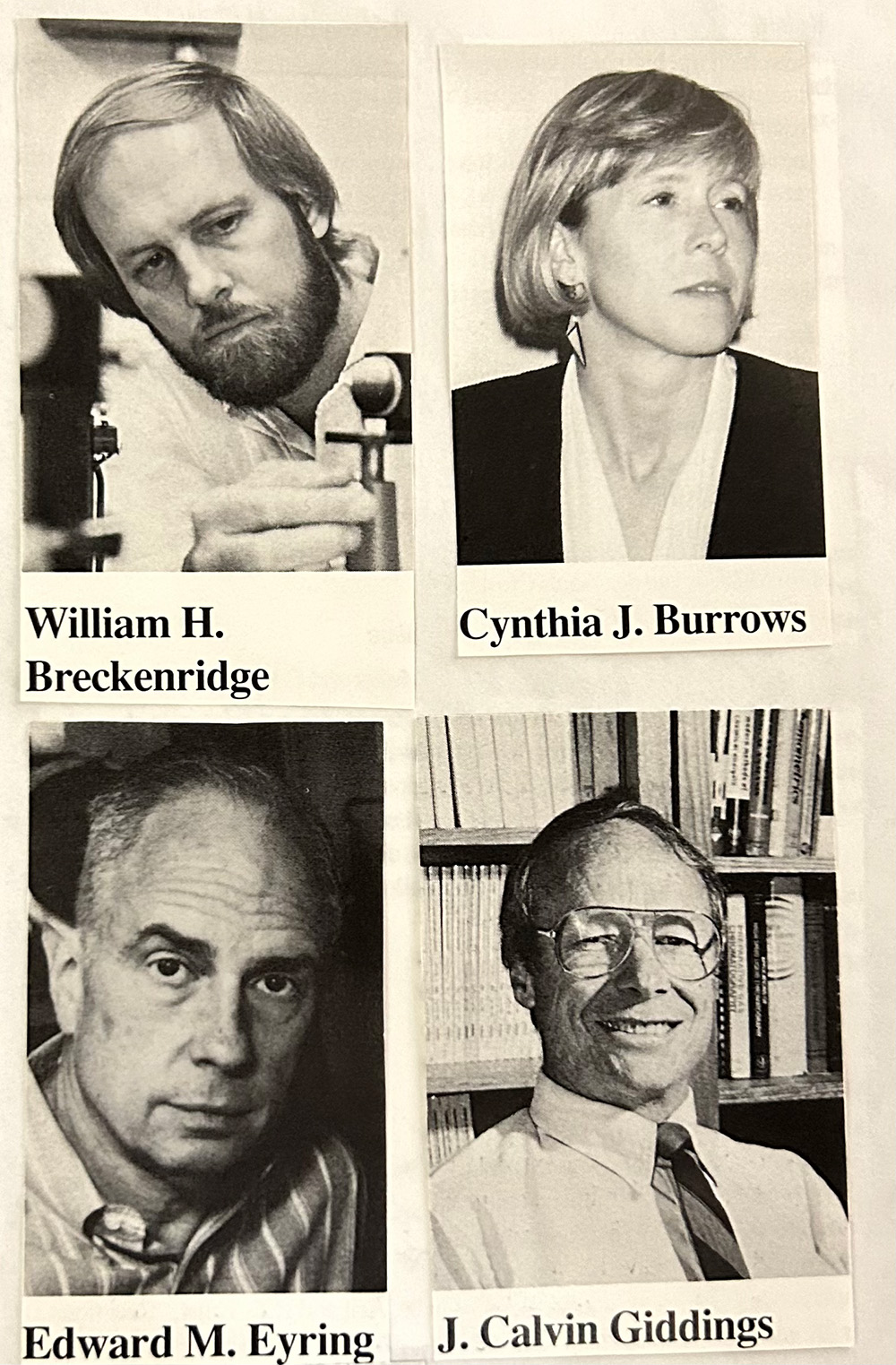 Among the many news items in the Spring 2004 issue of the newsletter are the following:
Professor Bill Breckenridge won the University’s Distinguished Scholarly and Creative
Research Award; Dale Poulter, Peter Stang, and Cynthia Burrows authored articles on
chemical elements in the September 8, 2003 story “It’s Elemental: The Periodic Table”
in C&E News; Janis Louie won an NSF Career Award to discover the untapped chemistry
of CO2; Dale Poulter won the ACS James Flack Norris Award in Physical Organic Chemistry;
Jack Simons authored a 461 page book “An Introduction to Theoretical Chemistry” published
by Cambridge University Press in 2003; Rosemary Laufer took early retirement from
her long held post as Administrative Assistant to the Department Chair and was succeeded
in the post by Debbie Olson [Considering Rosemary’s excellent memory of where all
the bodies are buried, some may await with anxiety the possible publication of her
memoirs]; Ron Ragsdale ran out of breath at 18,000 feet of elevation on Mt. Kilimanjaro,
but his daughter Krista made it to the 19,340 foot summit; Dr. Ilya Zharov, born in
Russia, joined the faculty at Utah after postdoctoral work with Josef Michl in Boulder,
CO; Dr. Kevin E. Ashley (Ph.D. 1987) has weathered the embarrassment of a role in
the “Cold Fusion'' episode and has a responsible job with NIOSH in his home town of
Cincinnati, OH.
Among the many news items in the Spring 2004 issue of the newsletter are the following:
Professor Bill Breckenridge won the University’s Distinguished Scholarly and Creative
Research Award; Dale Poulter, Peter Stang, and Cynthia Burrows authored articles on
chemical elements in the September 8, 2003 story “It’s Elemental: The Periodic Table”
in C&E News; Janis Louie won an NSF Career Award to discover the untapped chemistry
of CO2; Dale Poulter won the ACS James Flack Norris Award in Physical Organic Chemistry;
Jack Simons authored a 461 page book “An Introduction to Theoretical Chemistry” published
by Cambridge University Press in 2003; Rosemary Laufer took early retirement from
her long held post as Administrative Assistant to the Department Chair and was succeeded
in the post by Debbie Olson [Considering Rosemary’s excellent memory of where all
the bodies are buried, some may await with anxiety the possible publication of her
memoirs]; Ron Ragsdale ran out of breath at 18,000 feet of elevation on Mt. Kilimanjaro,
but his daughter Krista made it to the 19,340 foot summit; Dr. Ilya Zharov, born in
Russia, joined the faculty at Utah after postdoctoral work with Josef Michl in Boulder,
CO; Dr. Kevin E. Ashley (Ph.D. 1987) has weathered the embarrassment of a role in
the “Cold Fusion'' episode and has a responsible job with NIOSH in his home town of
Cincinnati, OH.
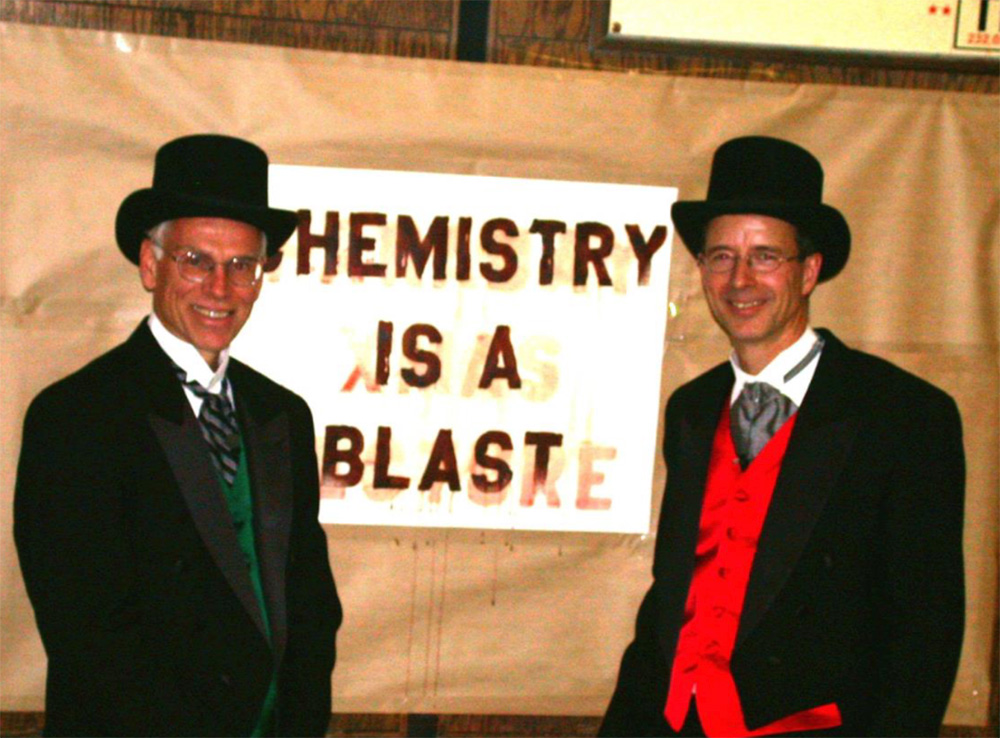
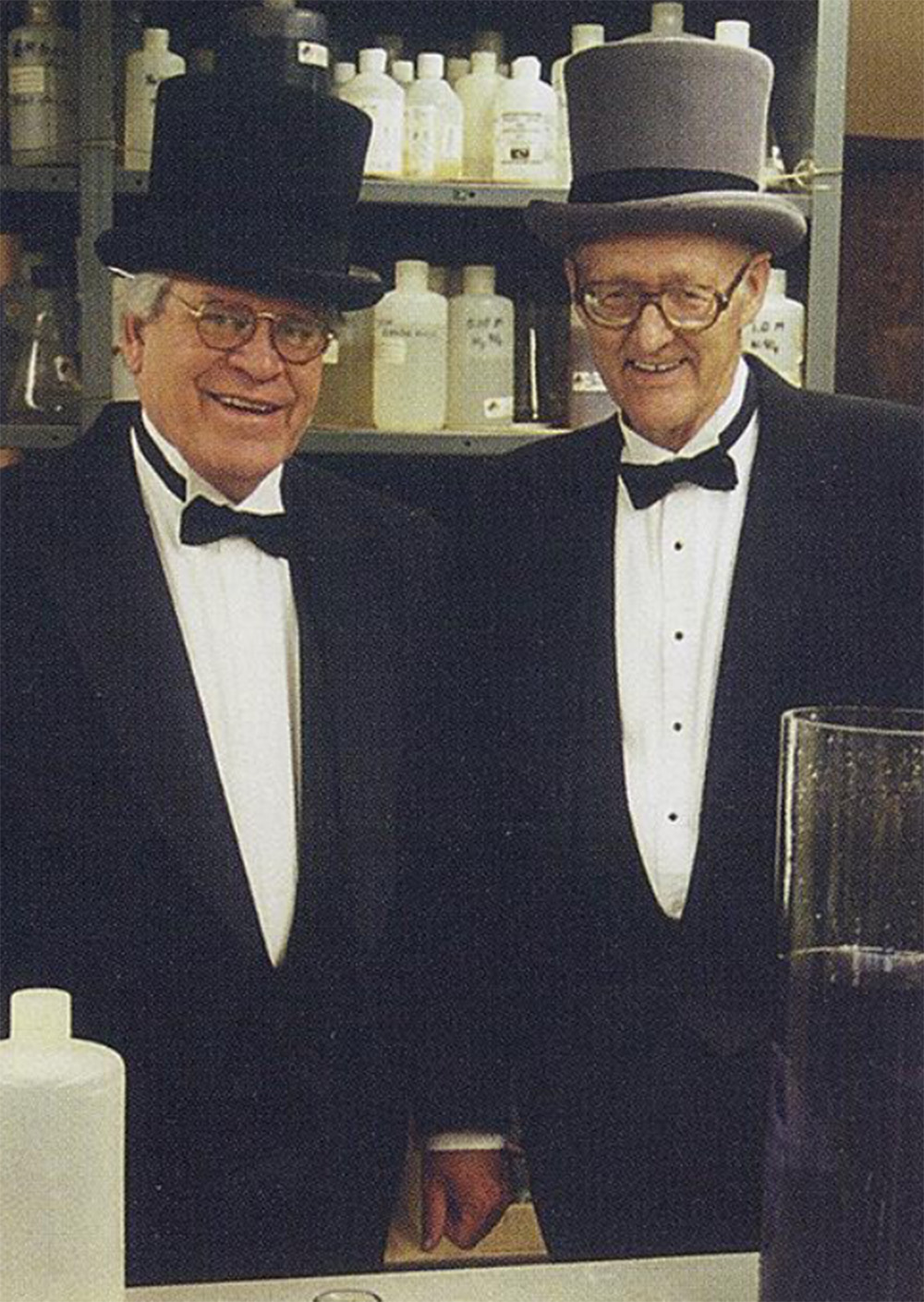 Way back in December of 1981, Professors Ron Ragsdale and Jerry Driscoll started their
popular version of the annual Faraday Christmas Lectures. Michael Faraday, born in
London in 1791, was one of the most celebrated scientists of the 1800s for his discoveries
of the laws of magnetism and his discovery of several chemical elements. As the Director
of the Royal Institution, Faraday popularized science for Londoners by dazzling one
hour practical demonstrations of chemical principles such as the loud ignition of
large soap bubbles containing hydrogen gas. These original Faraday lecture demonstrations
in the 1800s were performed by Faraday and by other scientists visiting the Royal
Institution who shared Faraday’s enthusiasm for science and showmanship. The Ragsdale/Driscoll
version of the Faraday Christmas lectures was held for two or three consecutive evenings
in the largest lecture hall of the Henry Eyring Building. Ragsdale and Driscoll wore
dressy black suits, starched white shirts, and black bow ties with a tall, dressy
top hat on each man’s head. As the years between early December sped by, the ritual
back and forth patter between Ragsdale and Driscoll portraying Faraday and his assistant
steadily improved in humor and scientific insight. Ron Ragsdale and Jerry Driscoll
are talented comedians. The performances were well advertised and consistently drew
turn away crowds of 300+ students and friends of Chemistry. The two stars of the Ron
and Jerry [Faraday] show retired gracefully after the December 2004 show, and Peter
Armentrout and Chuck Wight were deputized to take their places in the December 2005
Faraday Christmas Lectures. Jerry has since retired from the University faculty and
is farming with his wife on the beautiful island of Kauai. driscoll@chem.utah.edu is still an e- mail address for Jerry.
Way back in December of 1981, Professors Ron Ragsdale and Jerry Driscoll started their
popular version of the annual Faraday Christmas Lectures. Michael Faraday, born in
London in 1791, was one of the most celebrated scientists of the 1800s for his discoveries
of the laws of magnetism and his discovery of several chemical elements. As the Director
of the Royal Institution, Faraday popularized science for Londoners by dazzling one
hour practical demonstrations of chemical principles such as the loud ignition of
large soap bubbles containing hydrogen gas. These original Faraday lecture demonstrations
in the 1800s were performed by Faraday and by other scientists visiting the Royal
Institution who shared Faraday’s enthusiasm for science and showmanship. The Ragsdale/Driscoll
version of the Faraday Christmas lectures was held for two or three consecutive evenings
in the largest lecture hall of the Henry Eyring Building. Ragsdale and Driscoll wore
dressy black suits, starched white shirts, and black bow ties with a tall, dressy
top hat on each man’s head. As the years between early December sped by, the ritual
back and forth patter between Ragsdale and Driscoll portraying Faraday and his assistant
steadily improved in humor and scientific insight. Ron Ragsdale and Jerry Driscoll
are talented comedians. The performances were well advertised and consistently drew
turn away crowds of 300+ students and friends of Chemistry. The two stars of the Ron
and Jerry [Faraday] show retired gracefully after the December 2004 show, and Peter
Armentrout and Chuck Wight were deputized to take their places in the December 2005
Faraday Christmas Lectures. Jerry has since retired from the University faculty and
is farming with his wife on the beautiful island of Kauai. driscoll@chem.utah.edu is still an e- mail address for Jerry.
Our friends with a taste for quantitative information sometimes ask: “How ‘good’ is the University of Utah Chemistry Department compared to other departments in the U.S. which are granting Ph.D. degrees in Chemistry?” One reasonably objective answer lies in a comparison of the following quotient Q for as many departments as you have the patience to make the calculation:
Q = sum of federal research dollars awarded in a year to the department
the number of tenure track faculty members in the department in the same year
The supposition here is that the author of the most innovative research proposal receives the most federal research funding. Chemical & Engineering News, July 21, 2003, page 29, reported federal research dollar awards to the University of Utah for Chemistry for the year 2001. The number of tenure track faculty members for Utah in 2002 is found on pages xiii to xix of the 2003 ACS Directory of Graduate Research. Combining these two data sets, one obtains:
Rank:
- Johns Hopkins University
- Harvard University
- Stanford University
- M.I.T.
- Cal. Tech.
- Northwestern University
- U.C.L.A.
- Columbia University
- Univ. of Colorado, Boulder
- University of Illinois, Urbana
- Univ. of Pennsylvania, Philadelphia
- Univ. of Utah, Salt Lake City
- Univ. of California, Berkeley
- Univ. of North Carolina, Chapel Hill
The year 2001/2002 in terms of federal research funding was about average for the Utah Chemistry Department for the interval between 2000 and 2010.
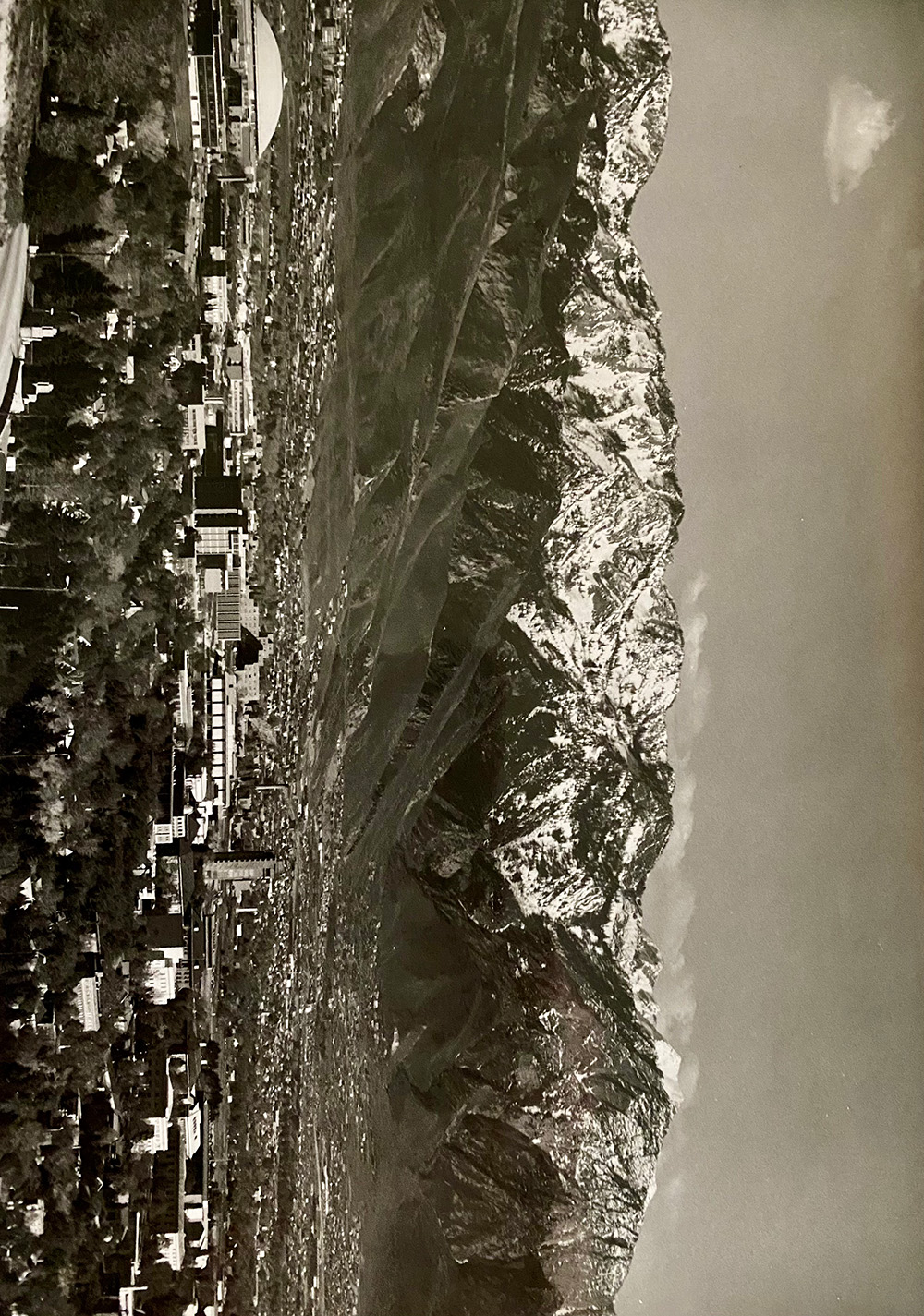
The big good news of the Spring 2006 Newsletter was that Peter Armentrout was still chairing the Department and progress was being made on construction of the David M. Grant NMR Center casually called the “Gauss Hause.” With the 20/20 hindsight of 8 added years of experience it is now evident in 2014 that the huge bays in the Gauss Hause designed to accommodate an 800 MHz and a 900 MHz NMR spectrometer were unnecessary. New equipment designs mitigated the detrimental effects arising from overlap of intense magnetic fields from neighboring MHz NMR spectrometers.
Prof. William H. (Bill) Breckenridge retired early from the Utah faculty on July 1, 2005 after 34 years of exemplary service as a notably successful classroom teacher of Honors freshmen chemistry classes and an internationally acclaimed researcher on “van der Waals” bonding between metal atoms (and ions) and rare-gas atoms. His Utah awards include the Hatch Teaching Prize, the University Distinguished Teaching Award, and the University Distinguished Research Award. Only two other Utah faculty members have collected all three of these top prizes. Bill won a J.S. Guggenheim Postdoctoral Fellowship to do research in France in 1985. Over the years Bill won many other awards. Bill has a long standing enthusiasm for French culture, language, and wine as well as science. In retirement Bill spends much of his time collaborating with English and French scientists in the laboratories abroad. In managing the human resources of a first rate Chemistry Department one must accept the reality that some of our most gifted scientists will move out of Utah in the middle of a brilliant career as Josef Michl, Greg Voth, and Bill Breckenridge have done. On the other hand, more of our notable faculty members have come to Utah well into their brilliant careers as, for example, Henry Eyring, Bob Parry, Cheves Walling, John Gladyz, Peter Armentrout, Cindy Burrows, Scott Anderson, Henry White, and Joel Miller. Perhaps the single greatest strength of the Chemistry faculty has been a core of home run hitters who have performed well year after year without ever changing uniforms. The heaviest hitting all stars in this category are Peter Stang, Dale Poulter, Jack Simons, Gary Keck and Joel Harris.
In Spring 2006, the comparative newcomer to the Utah Chemistry faculty was Professor Michael H. Bartl. He had come to Utah from a 3-year postdoctoral stint in the lab of Prof. Galen Stucky at the University of California, Santa Barbara. His degree education had been entirely in his native Austria, and he spoke excellent English. He was a materials scientist. Among many strengths, he knew how to synthesize semiconductor nanocrystals and how to characterize them with advanced optical/laser spectroscopy. He uses photons rather than electrons as the main information source in studies broadly called Nanophotonics-Nanotechnology that involves sub-micron spatial resolution and picasecond time resolution.
Newsmakers mentioned in the Spring 2005 and 2006 Newsletters include:
Marilyn Burton and Jerry Driscoll received Chemistry Outstanding Staff Awards in 2005
Professor John Conboy made excellent publicity for Utah Chemistry by an imaging technique showing the distribution of chiral molecules on a solid surface [Chem. Eng. News, Feb. 14, 2005, 83(7), pp. 47-55.]
Prof. Richard D. Ernst and coworkers discovered that SF6 is not “extremely inert”
The late Henry Eyring was honored in “The Days of ’47 Parade” (but not for his foot
racing
Prof. Jon D. Rainier chaired the 39th National Organic Chemistry Symposium at Utah,
June 12-14, 2005
Dr. Regina F. Frey (Ph.D. 1986, with Jack Simons) is a Senior Lecturer in Washington Univ., St. Louis, MO
Mrs. Carolyn Brady with her husband Rod Brady are responsible for the annual Robert W. Parry Teaching Award
Dr. Steve Brown successfully defended his Ph.D. dissertation at Cal. Tech
Dr. Dale Brugh (Ph.D. 1997, Morse) given tenure in Chem. Dept. at Ohio Wesleyan Universit
Gretchen Domek won the mark of “distinction” for her MPhil thesis concluding her 2 yr. Rhodes Scholarship
Prof. Steven M. Kuznicki (Ph.D. 1980) appointed endowed chair professor of Chem. Eng.
At Univ. of Alberta Steve Hamilton (B.S. 2005, Matt Sigman) studying medicine at Mayo
Clinic on a full scholarshi
Keith Jacobs (B.S. 1992) Faculty Fellow at Univ. of Montana-Missoula in business financ
Andrew J. Leavitt (Ph.D. 1994, Tom Beebe) is professor of chemistry at Univ. of West
Georgia, Carrollton, G
Dr. Mandy Hosford (Ph.D. 2005, Burrows) and Prof. Chuck Wight completed the Wahsatch
Steeplechas
Ryan Julian (B.S. 1999) is faculty member at Univ. of California, Riversid
Dr. Christopher R. Lloyd (Ph.D. 1996) detects microbial contamination in food, water, and medical diagnostics
Dr. Tim Newbound (Ph.D. 1988) troubleshooter for Saudi Arabian American Oil compan
Dr. Jeffrey D. Owen (Ph.D. 1971) owns a five-acre business park near Seattle, WA
Kirk Ririe (B.S. 2005) is a co-founder and CEO of Idaho Technology Inc.
Mark Thomson (B.S. 1987) earned a Ph.D. at Colorado State in 1995 and has taught since in Louisiana and Arkansas
Matthew Thorum (B.S. 2005) has begun Ph.D. work at Univ. of Illinois at Urbana Champaign
Teresa Jasmine Tuan (B.S. 2006) her precocity is described in a Daily Utah Chronicle article published Tuesday, June 8, 2006, Vol. 116, No. 7, entitled “Sixteen Going on 30”
Prof. George F. Uhlig (Ph.D. 1973, with Henry Eyring) mentor of talented undergraduates at College of Eastern Utah
Prof. Dan W. Urry (Ph.D. 1964, with Henry Eyring) entrepreneur/inventor of contractile protein-based machines IN MEMORIAM
Melvin George Jacobsen (1924-2005) loyal shipping and receiving clerk, Chemistry Stockroom
Maria Ana Curelaru (1967-2005) (B.S. 1989) (Ph.D. 1994, Univ. Texas, Austin) began working at Kemin Nutrisurance in Des Moines, Iowa in February 2005
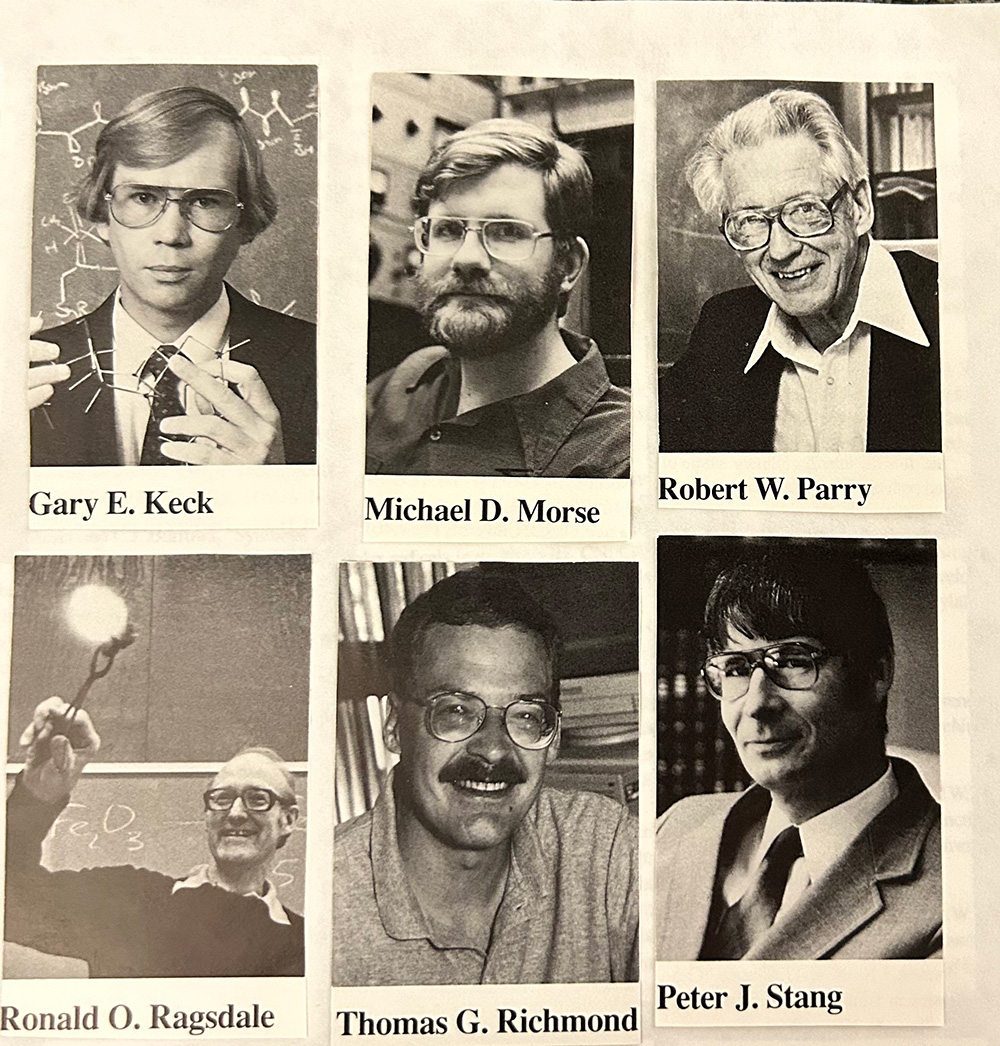 Robert Walter Parry 10/1/1917 ~ 12/1/2006 Robert W. Parry, 89, passed away December
1, 2006 in Salt Lake City, Utah. He was born October 1, 1917 in Ogden, Utah to Jeanette
(Petterson) and Walter Parry. He graduated from Utah State Agricultural College in
1940 receiving a bachelor's degree in chemistry. He received a masters degree from
Cornell University in 1942, and a PhD in chemistry from the University of Illinois in 1946. He married Marjorie Joyce Nelson July 6, 1945. They had two children, Robert
Bryce Parry and Mark Nelson Parry. Robert Parry was a Professor of Chemistry at the
University of Michigan from 1946-1969. In 1969, he came to the University of Utah as a Distinguished Professor
of Chemistry, where he served in this capacity until 1997.
Robert Walter Parry 10/1/1917 ~ 12/1/2006 Robert W. Parry, 89, passed away December
1, 2006 in Salt Lake City, Utah. He was born October 1, 1917 in Ogden, Utah to Jeanette
(Petterson) and Walter Parry. He graduated from Utah State Agricultural College in
1940 receiving a bachelor's degree in chemistry. He received a masters degree from
Cornell University in 1942, and a PhD in chemistry from the University of Illinois in 1946. He married Marjorie Joyce Nelson July 6, 1945. They had two children, Robert
Bryce Parry and Mark Nelson Parry. Robert Parry was a Professor of Chemistry at the
University of Michigan from 1946-1969. In 1969, he came to the University of Utah as a Distinguished Professor
of Chemistry, where he served in this capacity until 1997.
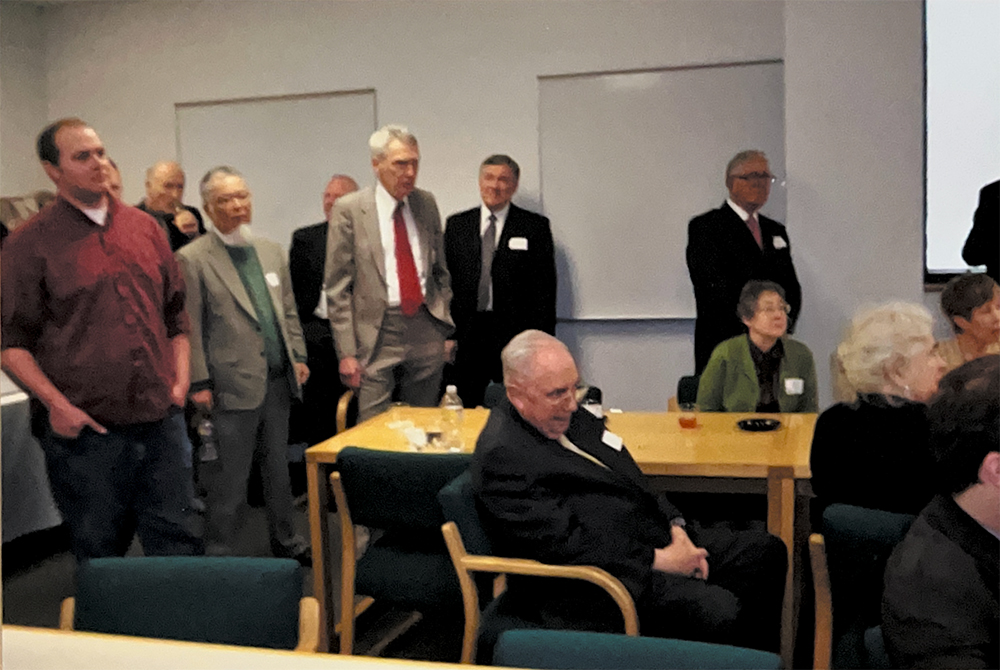 From 1997 until his death, he was Professor Emeritus at the University of Utah. He was an extraordinary teacher, teaching chemistry
to thousands of undergraduate students. In 1970 he co-authored a high school chemistry
text, Chemistry Experimental Foundations, which was widely used throughout the United
States. In 1972 he received the Manufacturing Chemists Award for College Teaching.
He was also an excellent research scientist, directing research groups at both Michigan
and Utah. His graduate students serve on chemistry faculties at universities throughout
the country. In 1980, he received a Senior United States Scientist Alexander Von Humbolt-Stiftung
Award, taking him to West Germany for a year. In 1980, he received the first Governor's
Medal of Science from the State of Utah. His unique gift, however, was his ability
to interact with people. He was a husband, father, teacher, consultant, and colleague.
Robert Parry was extremely active in the American Chemical Society. He served as its
president-elect in 1981 and president in 1982. He was a member of the Counsel of the
American Chemical Society for more than 45 years. He served on the Board of Directors
of the American Chemical Society from 1973-1983. From 1969-1980, he was a member of
the Board of Editors of the Journal of the American Chemical Society. He was the founding
editor of Inorganic Chemistry from 1960-1963. He was chairman of the Board of Trustees
of the Gordon Research Conferences from 1967-1968. In 1993, Robert Parry received
the Priestly Medal, the highest honor given by the American Chemical Society, for
lifetime achievement in chemistry. He received the Distinguished Service to Inorganic
Chemistry Award in 1965, the Distinguished Service to Chemical Education Award in
1977, and the Utah Award for Service to Chemical Education in 1978. He received Honorary
Doctor of Science Degrees from Utah State University (1985) and the University of
Utah (1997). He is survived by his wife of 61 years, Marj; two sons, Bryce and Mark;
and his grandchildren, Russell, Marelle, Lauren, Kristie, and Robert. He is predeceased
by his parents; two brothers, Dean and Edward; and sister, Jeanette. A memorial service
will be held 3 p.m. at the Evans & Early Mortuary, 574 East, 100 South, Salt Lake
City, Utah, Saturday, December 9, 2006. In lieu of flowers, contributions to the University
of Utah Women's Club Scholarship Fund would be appreciated.
From 1997 until his death, he was Professor Emeritus at the University of Utah. He was an extraordinary teacher, teaching chemistry
to thousands of undergraduate students. In 1970 he co-authored a high school chemistry
text, Chemistry Experimental Foundations, which was widely used throughout the United
States. In 1972 he received the Manufacturing Chemists Award for College Teaching.
He was also an excellent research scientist, directing research groups at both Michigan
and Utah. His graduate students serve on chemistry faculties at universities throughout
the country. In 1980, he received a Senior United States Scientist Alexander Von Humbolt-Stiftung
Award, taking him to West Germany for a year. In 1980, he received the first Governor's
Medal of Science from the State of Utah. His unique gift, however, was his ability
to interact with people. He was a husband, father, teacher, consultant, and colleague.
Robert Parry was extremely active in the American Chemical Society. He served as its
president-elect in 1981 and president in 1982. He was a member of the Counsel of the
American Chemical Society for more than 45 years. He served on the Board of Directors
of the American Chemical Society from 1973-1983. From 1969-1980, he was a member of
the Board of Editors of the Journal of the American Chemical Society. He was the founding
editor of Inorganic Chemistry from 1960-1963. He was chairman of the Board of Trustees
of the Gordon Research Conferences from 1967-1968. In 1993, Robert Parry received
the Priestly Medal, the highest honor given by the American Chemical Society, for
lifetime achievement in chemistry. He received the Distinguished Service to Inorganic
Chemistry Award in 1965, the Distinguished Service to Chemical Education Award in
1977, and the Utah Award for Service to Chemical Education in 1978. He received Honorary
Doctor of Science Degrees from Utah State University (1985) and the University of
Utah (1997). He is survived by his wife of 61 years, Marj; two sons, Bryce and Mark;
and his grandchildren, Russell, Marelle, Lauren, Kristie, and Robert. He is predeceased
by his parents; two brothers, Dean and Edward; and sister, Jeanette. A memorial service
will be held 3 p.m. at the Evans & Early Mortuary, 574 East, 100 South, Salt Lake
City, Utah, Saturday, December 9, 2006. In lieu of flowers, contributions to the University
of Utah Women's Club Scholarship Fund would be appreciated.
Published in Salt Lake Tribune from Dec. 3 to Dec. 8, 2006
Excerpt of Robert W. Parry obituary in S.L. Tribune 12/3/2006
(See also “IN MEMORIAM” at back of Spring 2007 Newsletter, pp. 18,19)
The Science History Institute recently (2024) published a biography on Robert W. Parry, written by Judith Kaplan and Dennis Sauer.
Peter Armentrout announced that he would be succeeded as Department Chair by Henry White. He also reported that the David M. Grant NMR Center had been dedicated. With justifiable pride Peter announced the addition of Dr. Ryan Looper to the faculty. Ryan had recently been a postdoctoral research associate with Prof. Stuart Schreiber at Harvard University. Peter also noted that he had been instrumental in bringing Janis Louie, Jon Rainier, Peter Flynn, Ilya Zharov, Jennifer Shumaker-Parry, Mike Bartl, Vale Molinero, as well as Ryan Looper to the Utah Chemistry faculty. Peter also noted that Shari Zinik and Debbie Olson had been “super” staff members for him to work with.
One of the best ways of measuring the impact of the U. of Utah Chemistry Dept. faculty is to read letters from former students and colleagues. Below you will find abbreviated summaries of correspondence reported in the Spring 2007 newsletter:
Charles Finell (B.A. 1934) at age 97 [in 2007] still lives in Carmel Valley, CA. Has set up a charitable remainder trust with the Chem. Dept. as beneficiary because he was “a poor farm boy who received help with his education.”
Art Ruoff (Ph.D. 1955, Henry Eyring Group) Cornell Univ. Prof. Emeritus with a spectacular list of awards for his studies of materials such as diamond and tungsten under high static pressures as high as 560 GPa.
Terry Anderson (B.S. 1958; Ph.D. 1962, Henry Eyring Group) Retired from Kerr-McGee in Oklahoma City, OK in 2001 where he was Principal Chemist for electrochemical industries; resides now in Riverton, UT.
Prof. Zoltan Schelly (postdoc 1969-70, Ted Eyring lab) long standing faculty member at U. Texas, Arlington researches transient electrophysics of unilamellar bilayer vesicles.
Prof. Milton Lee (B.S. 1971) long standing faculty member at BYU-Provo investigates microfluidics, hand-portable GC- MS, liquid chromatography, and ion mobility spectrometry.
Dr. Alan D. Eastman (Ph.D. 1975, Parry Group) retired from ConocoPhillips in 2003, now lives in Salt Lake and consults mostly for ChevronPhillips Chemical Co. about on-line Raman and NIR spectrometry.
Dr. John W. Kennedy, III (Ph.D. 1979, Jack Simons) researches high pressure spectroscopy in diamond anvil cells, now Prof. of Chemistry and Chemical Physics at Concordia Univ., Irvine, CA.
Prof. Alec M. Wodtke (B.S. 1981) Berkeley Ph.D. in 1986 with Yuan T. Lee; Dept. Chair at U.C. Santa Barbara, 2003. Now Prof. at Geog-August Univ., Goettingen, Germany; potential energy surface for atomic H scattering on Au(s).
Prof. Joseph A. Gardella, Jr. (postdoc 1982, Ted Eyring Lab) U. of Buffalo Distinguished Professor; recipient of Presidential Award for Excellence in Science, Mathematics and Engineering Mentoring from the NSF.
Dr. Jozsef Beres (postdoc 1982-84, Bentrude Lab) lives in Budapest, Hungary where the Beres Pharmaceutical Co. was founded in 1989. Jozsef has been the director since 1993. There are 220 employees.
Dr. Bill McKenna (Ph.D. 1985, Ted Eyring Lab) was Program Manager of Light Management Films for the Display Science and Technology Center in the Eastman Kodak Research Laboratories in Rochester, NY.
Dr. Darryl Spencer (B.S. 1991) earned his PhD. In [the] lab of Nobel laureate Mario J. Molina at M.I.T. Got into software development for mass spectrometer products and in 2007 was working in Concord, Ontario.
Professor Eileen Spain (Ph.D. 1992, Morse Group) at Occidental College, Los Angeles, CA and has NSF funding for her research in the area of interfacial chemistry and recreates with 2 kids and husband in Utah.
Jane Marie Behm Arrington and Caleb Anthony Arrington (Ph.D. 1994 and Ph.D. 1995) are married and think back fondly on some of the best years of their lives in Utah.
Prof. George Richter-Addo (Postdoc 1992-93, Gladysz lab) was recently appointed Chair of the Department of Chemistry and Biochemistry at the University of Oklahoma.
Dr. Scott Waite (Ph.D. 1993, Joel Harris Lab) Director of Labs for Dept. of Chemistry at University of Nevada, Reno. Also manages safety and chemical hygiene programs and departmental instrumentation.
Dr. Andreas Fechtenkoetter (M.S., Peter Stang’s lab, Ph.D. 1995, Mainz, Germany in 2001) Wife Chrys is U of U alumna in Chemical Engineering; Dept. Head for BASF Centre in Singapore in ~2006.
Dr. Christopher Lloyd (Ph.D. 1996, Ted Eyring lab) Director of R&D at MicroBioSystems in Logan, UT. Developed portable equipment to detect microbial contamination at low levels in milliseconds.
Dr. Yanlong Shi (Ph.D. 1996, Ted Eyring lab) and Ms. Lian Shao (M.S. 1998, Morse lab) They reside with their two children in the Boston area. Yanlong is a fuel cell expert. Lian is a manager of a network operation center.
Dr. Edward Orr (Ph.D. 1997, Ted Eyring lab) Manufacturer's representative for photoresists used in patterning Si wafers in semiconductor manufacturing. Resides with wife and daughter in Vancouver, WA.
Dr. Chuck Story (postdoc 1997, Ted Eyring lab) Senior research chemistry for the Lubrizol Corporation, Wickliffe, OH, largest manufacturer of lubrient additives. Chromotographer. Amateur astronomer.
Ms. Kelly Erickson (executive secretary, 1998) Worked for Joel Miller, Ted Eyring and another faculty member. Kelly and her husband Rinar live in Henderson, NV where she acts in plays and runs marathons.
Dr. Jamie Manson (Ph.D. 1999, Joel Miller lab) Did postdoctoral work at Argonne National Lab and at Oak Ridge National Lab before joining the Chemistry Department at Eastern Washington University.
Dr. David Van Horn (Ph.D. 1999, Cindy Burrows) Did inorganic chemistry postdoctoral work at U.C. Berkeley, now an Assistant Professor at the University of Missouri at Kansas City studying heavy-metal transport in biological systems.
Dr. Rico E. Del Sesto (Ph.D. 2002) First a postdoc and now a regular staff member at Los Alamos National Laboratory studying ionic liquids, water detection, nanomaterials, and radiation detection.
Dr. Jamie K. Pero (B.S. 2002) will begin working as a Ph.D. research assistant at the Clorox Technical Center.
Dr. Coby B. Carlson (Ph.D. 2002, Peter Beal lab) Did postdoc. With Laura Kiessling, Wisconsin-Madison. Employed by Invitrogen in Madison. He and wife have two small children.
Robin Barrios Seely (B.S. 2004) Did theoretical chemistry research with Jack Simons. Now in Pharmacy School at Northeastern Univ., Boston. Glad she chose professional school.
Dr. Roger A. Leach (Ph.D. 1984, Joel Harris Lab) currently a Research Manager with Corporate Analytical Science Group at DuPont.
Dr. Robert Bennett (Ph.D. 1989) Managing Propellants, Explosions and Pyrotechnics Research Department at ATK Launch Systems (formerly Thiokol).
Dr. Brian Rasmussen (B.S. 1993) has come back to Salt Lake City and now works as a physician in town. “It’s good to be back.”
Dr. Michael Weibel (Ph.D. 1999) married in December 2004 and moved to Maryland in 2004 where he works in OSD’s Program for Chem. & Biological Defense.
Dr. William B. Rothwell (B.S. 2000) Graduate in 2004 of Tulane Univ. Med. School. Became a third year resident at Baystate Med. Center, Springfield, MA in Medicine/Pediatrics.
Ryan D. Roberts (B.A. 2001) Pursuing an MD/Ph.D. degree, studying tumor immunology, received a 3-year training grant.
Dr. Christopher Kuehl (Ph.D. 2001) Accepted a research chemist position in the Medical Products Division of W.L. Gore and Associates in Flagstaff, AZ.
Peter W. Anderson (B.S. 2003) currently a third year medical student at Saint Louis University.
Ryan W. Hart (B.S. 20036) completed an M.S. degree at U.C. Riverside and is working at IM Flash Technologies.
Bryant Roth (B.S. 2003) now a chemist at Johnson Matthey in Salt Lake City.
Dustin Mortensen (B.S. 2004) Working for Battelle at Tooele Chemical Disposal Facility.
John Brailsford (B.S. 2004) working on a Ph.D. degree at University of California, Irvine.
Erin Umbriaco (B.S. 2004) medical student at Baylor University in Houston, TX.
Dr. Matthew Kriech (Ph.D. 2004, Conboy lab) employed by ATK Launch Systems Group working on chemical aging of solid rocket propellants.
Teresa Jasmine Tuan (B.S. 2006) selected as one of twenty-six graduating seniors inducted into the Beehive Honor Society.
Maurine Liddiard (1984) now in Durango, CO working at Fort Lewis College. She loved her time in the Chem. Dept. (running the show) more than any other job she ever had.
Gordon Hale (1985) former manager of the Chemistry stockroom and purchasing activities. At age 86 (in June 2006) he still bubbled with enthusiasm for family and traveling.
Prof. Tsutomu Masujima (former postdoc in Ted Eyring lab) still has his home in Hiroshima, Japan. Sells a nanospray top for MS analysis. Developing a new type of microscope & mass spectrometer.
Prof. Bill Guillory (1985) former Chem. Dept. Chair who was instrumental in securing funding for the 2nd wing of the Eyring Bldg. Started the Hurricane Katrina Support Group and is an author.
Louise Traper was a mainstay of the David Grant NMR research operation who has subsequently created a successful intimate apparel business for women and has a Fox Trotter horse in competition.
Prof. Jean Futrell (1986) is an international research star in ion chemistry and mass spectrometry, some of whose former graduate students at Utah have achieved great fame in their own right.
Sam Cole (former manager of Chem Computer Center, 1986-1990) now is Principal Software Engineer with CyberOptics Semiconductor in Beaverton, Oregon.
Lynell Gardner worked for Professors Armentrout, Beebe, and Eyring before graduating with a B.S. in Psychology in 1994. She now runs Alumni Relations at Weber State University.
Dr. Hua (“Bonnie”) Huang (1998) (Postdoc. Ted Eyring’s lab) Now a Senior Scientist at Allergan, Inc. in Irvine, CA where she characterizes protein structure using MALDI-TOF mass spectrometry.
Chemistry Faculty News in the Spring 2007 Alumni Newsletter
Distinguished Prof. David M. Grant was honored Sept. 8, 2006 by having the Gauss Haus named after him.
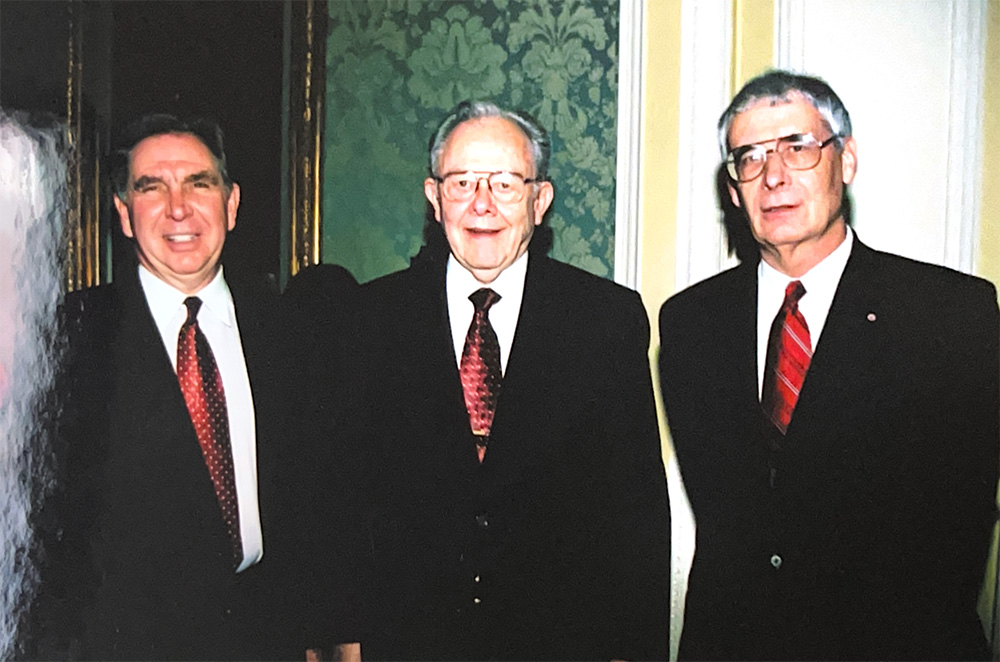 Earlier in 2006 a special issue of Magnetic Resonance in Chemistry (Vol. 44, #3) was
published honoring Dr. Grant on his 75th birthday and celebrating his many contributions
to the methodology and applications of Carbon-13 Nuclear Magnetic Resonance spectroscopy.
Building a great Chemistry Department is very much a community enterprise, but a strong
case can be made for identifying David M. Grant as the one person who did the most
to bring the Department from obscurity to true prominence.
Earlier in 2006 a special issue of Magnetic Resonance in Chemistry (Vol. 44, #3) was
published honoring Dr. Grant on his 75th birthday and celebrating his many contributions
to the methodology and applications of Carbon-13 Nuclear Magnetic Resonance spectroscopy.
Building a great Chemistry Department is very much a community enterprise, but a strong
case can be made for identifying David M. Grant as the one person who did the most
to bring the Department from obscurity to true prominence.
Dr. Valeria Molinero (Ph.D. 1999, University of Buenos Aires) joined the Chemistry faculty on August 16, 2006 as an Assistant Professor. She uses powerful computational methods to model the transformation between amorphous phases and crystalline matter, teaches physical chemistry, and is making an excellent reputation for herself with path-breaking publications.
Dr. Jon Rainier was promoted to the rank of Full Professor.
Dr. John Conboy was promoted to Associate Professor with Tenure.
Dr. Janis Louie was promoted to Associate Professor with Tenure.
Henry White was elected to the rank of Distinguished Professor by other Distinguished Professors. With the approval of the central administration, College of Science Dean Pierre Sokolsky selected Distinguished Professor Henry White to be Chair of the Chemistry Department beginning July 1, 2007, following Peter B. Armentrout.
The casual reader of this history may be interested to know that the Chair of a department at the University is not required to be a Full or Distinguished Professor. David M. Grant began Chairing the Chemistry Department when he was a young Associate Professor. What a Chair must have is exemplary leadership qualities. There is no room in a first rate university for a Chair who “leads from behind.”
The jump in academic rank from Assistant to Associate Professor with “Tenure” at the University of Utah is very important because the “winner” after no more than seven years of “involuntary servitude” does not need to search immediately for some other paid employment. Over the past fifty years fewer than fifteen percent of the young people joining the Utah Chemistry faculty have been denied promotion with tenure. However, it should be noted that “Tenure” does not guarantee employment until age 65 or later. If a “tenured” faculty member frequently fails to teach her/his assigned classes acceptably or does not perform faithfully other assigned duties such as committee work, counseling of students, participating in oral examinations of degree candidates, etc., she or he may be fired for cause after review by the central university administration.
Back now to the happy success stories of the Chemistry faculty reported in the Spring 2007 Alumni Newsletter:
Prof. Joel Miller was selected to appear on Thomsen Scientific’s ISIHighlyCited.com because of his “exceptional citation count in the field of Material Science.”
High School student Lindsay Hubley drew favorable attention to the research lab of Prof. Sheila David by winning Third Place at the 2006 International Science and Engineering Fair in Indianapolis.
TITLE IX ISSUES
On September 19, 2006, Prof. Richard Zare of Stanford University delivered the Cal Giddings Lecture on “Making It Count: Quantitation of Low-Copy-Number Proteins in Single Cells.” That Spring he had written an article [Chemical & Engineering News, May 15, 2006, pp. 46-49] about ways to grow the participation of women in U.S. academic chemistry. Zare recommended collecting several “Title IX measurables” annually. In the Spring 2007 Chemistry Alumni Newsletter his “measurables” are listed with the performance for academic year 2005-2006 by the Utah Chemistry Department shown in parentheses:
Percentage of undergrads. majoring in chem who are women (102/277 or 37%)
Percentage of grad. students in chem. who are women (71/164 or 43%)
Percentage of postdocs. in chem. who are women (7/46 or 15%)
Percentage of lecturers/instructors in chem. who are women (1/3 or 33%)
Percentage of assistant professors in chem. who are women (2/5 or 40%)
Percentage of associate professors in chem. who are women (1/4 or 25%)
Percentage of full professors in chem. who are women (2/22 or 9%)
Thus among our younger faculty (assistant and associate professors), 30% were women.
On June 19, 2007, Distinguished Professor Cheves T. Walling (1916-2007) passed away peacefully in Peterborough, New Hampshire. He had a tremendous favorable impact on the reputation of Chemistry at Utah before becoming an Emeritus Professor in 1991.
On July 25, 2008, Dr. H. Tracy Hall, the “father” of manmade industrial diamonds, passed away in Provo, Utah. He was Henry Eyring’s first Ph.D. student, graduating from the University of Utah in 1948. Tracy became Director of Research at BYU-Provo in 1955 and fathered many diamond producing companies world-wide as well as in Utah.
The Spring National Meeting of the American Chemical Society was held in Salt Lake City for the very first time during the interval March 22-26, 2009. The Utah Chemistry Department was well represented at this meeting by students and faculty of the department delivering technical talks to the meeting attendees. Dr. Jan Hayes, the Chair of the ACS Division of History of Chemistry at the time, had secured funding for a half day symposium honoring the legacy of the late Henry Eyring. Invited speakers included Prof. Douglas Henderson (BYU-Provo), Prof. Josef Michl (Univ. of Colorado, Boulder), Prof. Dan Urry (Univ. of Minnesota and University of Alabama, Birmingham) and Prof. (Steven Kuznicki (University of Alberta, Edmonton). One of the highlights of the symposium was a graphic prepared by Dr. Amy Dambromovitz (University of Alberta) showing that Henry Eyring’s 700+ scientific papers continue to generate citations in the scientific literature at a high level even thirty plus years after his death.
In the spring of 2009, the University was notified that $8M from the NIH had been awarded for construction of a major addition to the so-called “south tower” of the Henry Eyring Chemistry Building. At the time of the new NIH award it was clear that at least $10M additional [funds] would be required beyond the $8M in NIH funds to complete the project. Associate Professor Greg Owens was promptly deputized as “Director of Development” to lead this ambitious fundraising campaign.
On April 15, 2009, the College of Science hosted an “Eyring Legacy Event” in collaboration with the University Office of Development. The main event was a dinner in the Tower of Rice Eccles Stadium. Attendees included fourteen of the late Professor Henry Eyring’s former research students, members of Henry Eyring’s family, the three members of the LDS Church First Presidency, notable local political figures, members of the Chemistry faculty, and many other invitees.
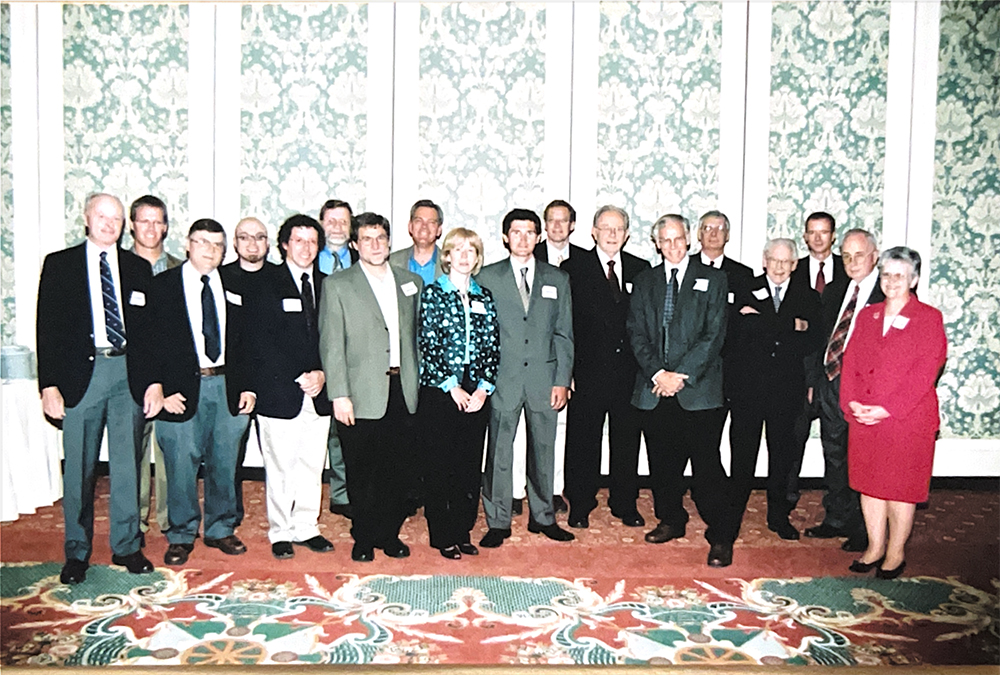
In Fall 2009, The Catalyst Alumni Newsletter of the Chemistry Department, no volume number, had morphed into THE CATALYST CHEMISTRY NEWSLETTER, Volume 1, Number 1, Fall 2009 with a dazzling array of color photographs not found in the issue of the defunct Newsletter. Prof. Henry White was continuing as Department Chair and noted that Chemistry was still accomplishing much despite draconian State of Utah budget cuts.
The “Faculty Profile” story was about Assistant Professor Kenneth Woysechowsky who had come to Utah from upstate New York via a B.S. at Penn State, a Ph.D. at U. Wisconsin – Madison, and a postdoc. at the ETH in Zurich, Switzerland. One of Ken’s research foci continues to be issues related to icosahedral capsids (“soccer balls”) commonly found in viruses.
One of the challenges of having strong Utah Chemistry faculty is the inevitable competition with other strong departments for our chemists at every level of development. Examples of this problem in the history of the U. of Utah Chemistry Department abound. Josef Michl leaving Utah for Austin, Texas immediately after his election to the National Academy of Sciences is a particularly painful example. Another troubling example was the departure of Jean Futrell, bound for the University of Delaware. Just as unexpected was the decision of John Gladysz to leave in 1998 for a Chair in Germany after 16 very fruitful years elevating the prestige of inorganic chemistry at Utah. More recent disappointing losses include Greg Voth departing for the University of Chicago, the husband-wife team of Peter Beal and Sheila David decamping for the University of California, Davis, and Eric Hagg joining his wife at Michigan State University. What these and many other lateral transfers within academic chemistry have in common is more resources immediately available to the transferee at the far end of the move. If the Chair of the Utah Chemistry Department had had the endowment funds enjoyed by the Departments with which we were competing some of these unhappy losses could have been avoided. That reality makes stories about large donations to endowments particularly encouraging news.
The Thatcher Company in Salt Lake City made a multi-year pledge to create a four-year full tuition undergraduate scholarship in Chemistry or Chemical Engineering. The first recipient was Natascha Knowlton of Magna, UT. She was also the 2009 Cyprus High School Sterling Scholar in foreign language.
Dr. Rebecca Uhlig, a practicing optometrist working in Portland, Oregon was mentored in the Utah Chemistry Department by Professor Laya Kesner. Rebecca created in 2009 the Laya Kesner Award to be given to an undergraduate chemistry major who has demonstrated teamwork and support of her/his fellow students’ learning experience while in the classroom or lab.
Life sketches of three prematurely deceased Chemistry Department students are also given in the Catalyst, Fall 2009, Vol. 1, No. 1 issue. Their names are Jennifer Alexander, Christopher Nielsen, and Masaaki Tamayama.
Recognitions of Faculty Members mentioned in this Catalyst issue include the following:
Prof. John Conboy promoted to rank of Full Professor
Prof. Gary Keck received the University of Utah Distinguished Teaching Award Prof.
Joel Miller was elected Fellow of AAAS
Prof. Valeria Molinero received the Beckman Young Investigator Award
Prof. Peter Armentrout was given the Field and Franklin Award for Outstanding Achievement in Mass Spectrometry
Prof. Jennifer Shumaker-Parry received an NSF Career Award
Prof. Matthew S. Sigman received the Robert W. Parry Teaching Award endowed by the Brady Foundation
Prof. Ilya Zharov was promoted to Associate Professor and received the IUPAC Young Observer Award and was named University Distinguished Honors Professor
Debbie Olson, Department Secretary, received the W. W. Epstein Outstanding Educator Award
Prof. Holly Sebahar also received the W. W. Epstein Outstanding Educator Award
There is a gap in copies of the Catalyst (University of Utah) Chemistry Newsletter between Volume 1, Number 1, Fall 2009 and the Biannual Catalyst Newsletter, Fall 2012, that has no volume number and no issue number.
The Curie Club was invented and first convened sometime during this three-year interval. A few events from this interval in the Chemistry Department History are the following:
May 28, 2009, Dr. Bill Jack (Duke Univ. Ph.D., 1983; Native Salt Laker) visited and talked about “Polymerases and Other DNA Enzymes.”
September 21, 2009, Lucy Ziurys, University of Arizona, boss of Kitt Peak and Mount Graham, Astronomical Observatories, spoke on “Molecular Spectroscopy Beyond the Solar System: A Physical Chemist’s Approach to Astrochemistry.”
January 21, 2010. Dr. Bethany Buck-Koehntop, Scripps Research Institute, spoke on “DNA recognition by the Methyl-CpG Binding Zinc Finger Protein Kaiso.” Bethany subsequently joined the Utah Chemistry faculty.
58th ASMS Conference on Mass Spectroscopy in Salt Palace, May 23-27, 2010. Peter Armentrout spoke to an audience of about 4,000 attendees on May 23. Dr. Marvin Vestal (Futtrell Ph.D.) was an awardee on May 24 for a Distinguished Contribution to Mass Spectrometry. Prof. Tsutomu Masujima (former Postdoc in Ted Eyring lab) brought 20 of his coworkers from Hiroshima, Japan and spoke to a reasonable crowd on Thursday morning, May 27th about “Robotized Video-Mass Scope for Direct and Live Single-cell Molecular Exploration.”
April 6, 2010, Inorganic Colloquium, Dr. Fred Hawthorne, Univ. of Missouri, Columbia, “Polyhedra Boranes in the Biomedical Area,” hosted by Joel Miller.
A retirement reception for Dr. Jerry Driscoll was held on June 15, 2010. His matchless gift for the classroom demonstrating chemical principles enriched all our lives. He now resides in Hawaii.
May 9, 2011, John Maier, University of Basel, Switzerland, “Electronic Spectroscopy of Carbon Chains, Rings and Ions of Relevance to Astrophysics,” Host: Prof. Michael Morse.
June 25, 2011, Chair Henry White and a few others from Chemistry attended a polo match at the South Jordan Equestrian Park to see how the College of Pharmacy raises money for a new pharmacy research building. The event was financed by Claudia Skaggs Lutrell, whose daughter was one of the polo pony riders.
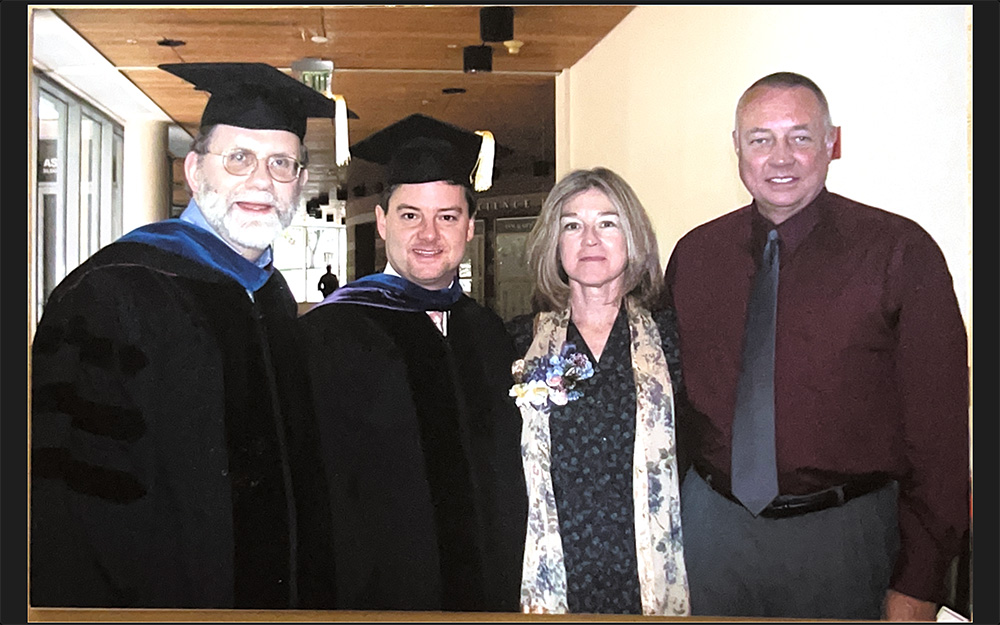
In 2011, Peter Stang was awarded the National Medal of Science “for his creative contributions to the development of organic supramolecular chemistry and for his...record of public service.” He was then awarded the 2013 Priestley Medal from the American Chemical Society for his “cutting-edge research that has had far-reaching implications for many areas of science, including drug development and more efficient ways to produce gasoline and home heating oil."
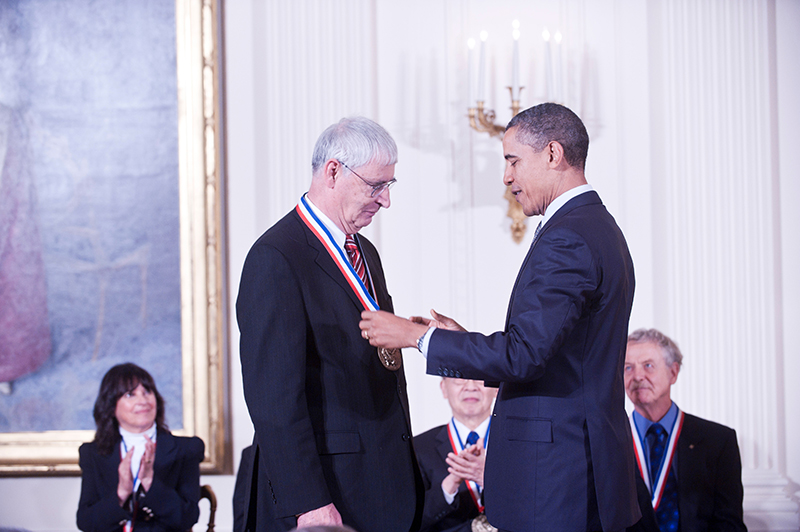
At that time, Utah Chemistry was ranked among the top 25 chemistry programs in the nation and among the top 1% annually in awarding undergraduate degrees certified by the American Chemical Society. In addition, it was the top annual producer of Ph.D. degrees at the U.
Construction of the Thatcher Building was in its final phase, boasting a 94-seat lecture hall, reception space, nine research labs for Bio-Analytical, Bio-Physical, and Bio-Organic Chemistry, Theoretical Chemistry research space, offices for faculty, graduate students, and research teams, three teaching labs, study spaces, a lounge space, and an active learning center. It was registered under the LEED Green Building Rating System. The building was dedicated on March 13, 2013.
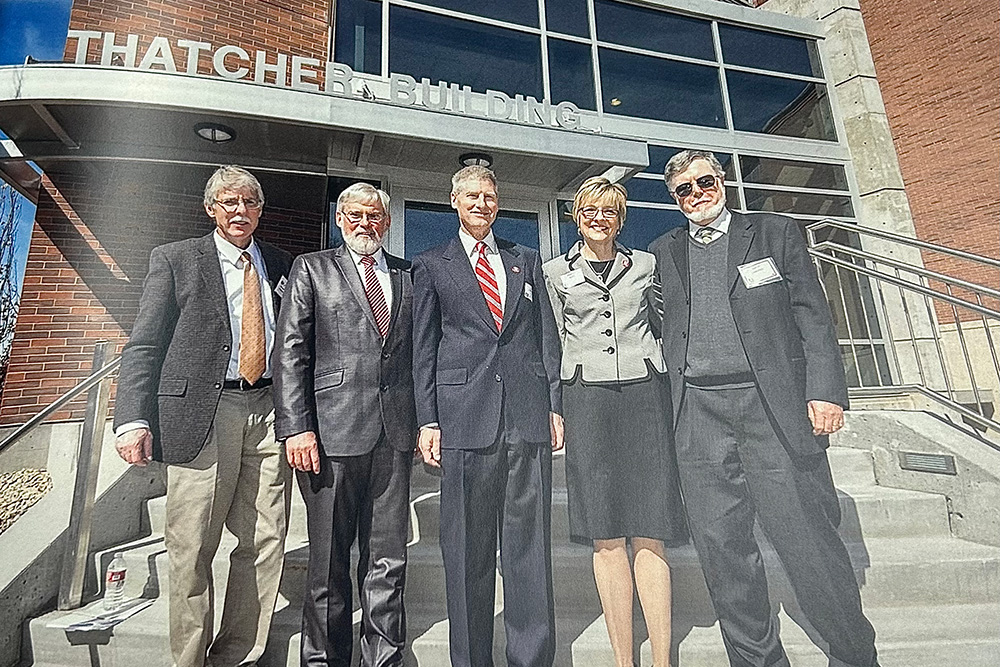
Ronald Ragsdale officially retired in May 2012. Over the years, he taught and mentored 50,000+ undergraduates, 4,000+ high school students, 2,000+ summer enrichment students, and 100+ high school chemistry teachers. He also left a legacy with the annual Christmas Faraday Lectures that continue to this day and provide a public venue for science outreach to children of all ages. The appointment of Charles Atwood as the Ronald and Eileen Ragsdale Endowed Chair for Chemical Education (currently held by Gina Frey) allowed Ragsdale’s legacy of excellence in teaching general chemistry and outreach to high school students to live on. The Ronald and Eileen Ragsdale Endowment was also established to provide scholarship support to outstanding chemistry majors.
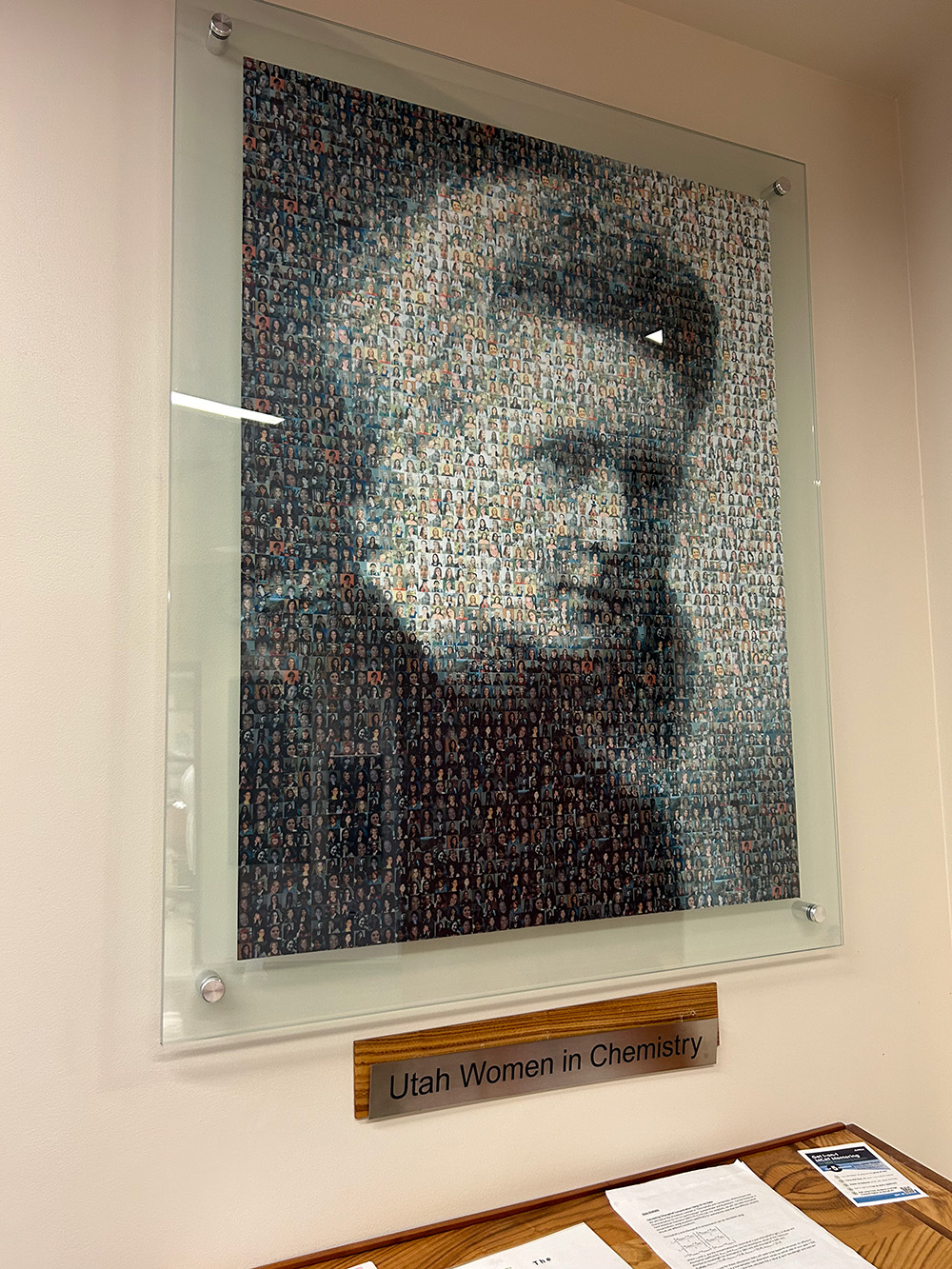 Valeria Molinero was promoted to Associate Professor with tenure in 2012. In addition,
she was the first recipient of the College of Science Myriad Faculty Award for Research
Excellence from Myriad Genetics. She was selected as a 2012 Camille Dreyfus Teacher-Scholar
by the Camille & Henry Dreyfus Foundation.
Valeria Molinero was promoted to Associate Professor with tenure in 2012. In addition,
she was the first recipient of the College of Science Myriad Faculty Award for Research
Excellence from Myriad Genetics. She was selected as a 2012 Camille Dreyfus Teacher-Scholar
by the Camille & Henry Dreyfus Foundation.
The Curie Club was founded in 2011 on the 100th anniversary of Marie Curie’s 1911 Nobel Prize in Chemistry by passionate, successful, civic-minded intellectually engaged women to help overcome the barriers that women and other historically underrepresented individuals face as young scientists, researchers, professors, and leaders in their fields, to support women scientists, and to encourage more young women to pursue a life of the mind. The following individuals founded the Curie Club: Claudia Skaggs Luttrell, Cynthia Conner, Kathy Thatcher, Cynthia J. Burrows, Linda Lee and Craig Lee, DDS, Kalpana Patel and Dinesh Patel, Ph.D., Susan R. Poulter, JD, Ph.D. and C. Dale Poulter Ph.D., Rebecca Reese and Don Reese, MD.
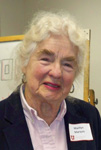 Marilyn Alder Marquis received her undergraduate degree in Chemistry from the University
of Utah, went to Berkeley for a month for graduate school, and then returned to Utah
to study with Henry Eyring. Marilyn worked on dynamic mechanical testing of polyamides
and the relationship between their rheological response and their chemical structure.
While a graduate student, she produced a set of lecture notes from Henry Eyring’s
classes which became the start of a textbook, “Statistical Mechanics and Dynamics”,
co-authored by Henry Eyring, Doug Henderson, Betsy Stover, and Ted Eyring. Marilyn’s
notes were mimeographed and bound with a yellow cover and were referred to by students
as the yellow peril. Dr. Marquis was the first woman to earn a Ph.D. in Chemistry
at the University of Utah. Dr. Marquis also earned an M.B.A. in Finance and Management
from Golden Gate University in San Francisco. Dr. Marquis worked for several large
corporations and government labs, including Utah’s Dugway Proving Ground. Her research
contributions are broad, including arc plasma processing of chemicals, synthesis of
tetrafluoroethylene, synthesis of polymer intermediates from low btu methane, kinetics
and mechanism of ozone reactions, and solvent effects in molecular decomposition reactions.
She also worked on project management in the private sector and for the US Department
of Energy in Magnetically-Confined Fusion, Radioactive Waste Management, and Geothermal-Based
Electric Power Generation.
Marilyn Alder Marquis received her undergraduate degree in Chemistry from the University
of Utah, went to Berkeley for a month for graduate school, and then returned to Utah
to study with Henry Eyring. Marilyn worked on dynamic mechanical testing of polyamides
and the relationship between their rheological response and their chemical structure.
While a graduate student, she produced a set of lecture notes from Henry Eyring’s
classes which became the start of a textbook, “Statistical Mechanics and Dynamics”,
co-authored by Henry Eyring, Doug Henderson, Betsy Stover, and Ted Eyring. Marilyn’s
notes were mimeographed and bound with a yellow cover and were referred to by students
as the yellow peril. Dr. Marquis was the first woman to earn a Ph.D. in Chemistry
at the University of Utah. Dr. Marquis also earned an M.B.A. in Finance and Management
from Golden Gate University in San Francisco. Dr. Marquis worked for several large
corporations and government labs, including Utah’s Dugway Proving Ground. Her research
contributions are broad, including arc plasma processing of chemicals, synthesis of
tetrafluoroethylene, synthesis of polymer intermediates from low btu methane, kinetics
and mechanism of ozone reactions, and solvent effects in molecular decomposition reactions.
She also worked on project management in the private sector and for the US Department
of Energy in Magnetically-Confined Fusion, Radioactive Waste Management, and Geothermal-Based
Electric Power Generation.
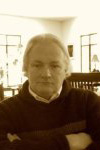 Bill McKenna earned a Ph.D. in Chemistry at the University of Utah. Bill joined the
technical staff at Eastman Kodak as a Senior Scientist working in vibrational spectroscopy
and high-resolution electron energy loss spectroscopy. At Kodak, he was promoted to
Senior Research Associate. He received several other promotions, his last being the
Program Manager for the Flexible Display Program. When Dow Chemical acquired Kodak’s
Flexible Display Program, Bill became Director of Research for Optical Display Films
Display Technologies at Dow. In 2010, Bill retired from Dow and co-founded The Avout
Group, which provides consulting in technology scouting and development in materials
and materials applications.
Bill McKenna earned a Ph.D. in Chemistry at the University of Utah. Bill joined the
technical staff at Eastman Kodak as a Senior Scientist working in vibrational spectroscopy
and high-resolution electron energy loss spectroscopy. At Kodak, he was promoted to
Senior Research Associate. He received several other promotions, his last being the
Program Manager for the Flexible Display Program. When Dow Chemical acquired Kodak’s
Flexible Display Program, Bill became Director of Research for Optical Display Films
Display Technologies at Dow. In 2010, Bill retired from Dow and co-founded The Avout
Group, which provides consulting in technology scouting and development in materials
and materials applications.
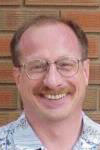 Norm Dovichi was the first doctoral graduate of Joel Harris’s lab. At the University
of Wyoming, Dr. Dovichi and their faculty launched a research prog high-sensitivity,
small-volume detection methods for liquid chromatography. In 1986, Norm moved to the
University of Alberta, where he developed multi-capillary detection for sequencing
DNA. In 2001, Norm was appointed to an endowed chair at the University of Washington.
A decade later, he moved to Notre Dame as the Grace Rupley Professor of Chemistry
and Biochemistry.
Norm Dovichi was the first doctoral graduate of Joel Harris’s lab. At the University
of Wyoming, Dr. Dovichi and their faculty launched a research prog high-sensitivity,
small-volume detection methods for liquid chromatography. In 1986, Norm moved to the
University of Alberta, where he developed multi-capillary detection for sequencing
DNA. In 2001, Norm was appointed to an endowed chair at the University of Washington.
A decade later, he moved to Notre Dame as the Grace Rupley Professor of Chemistry
and Biochemistry.
Ted Eyring retired in 2013 after more than 50 years of service as a chemistry faculty member. To honor his dedication and contributions to the department, the Edward M. Eyring Undergraduate Scholarship was established as part of the Ragsdale Scholarship Endowment. A unique component of these scholarships is that recipients design, carry out, and report on a scholarly research project under the guidance of a chemistry faculty member.
Ryan Looper was one of four recipients of Amgen’s Young Investigator Awards. These awards are given annually and recognize young scientists who demonstrate research excellence and make significant contributions to the field of organic chemistry and biotechnology that impact the practice of drug discovery. Looper also received one of only two Young Investigator Awards from Eli Lilly & Co.
Emeritus Professor David Grant passed away on April 13, 2013. He was the former Chair of the Department of Chemistry and former Dean of the College of Science. He was a pioneer in the development of NMR spectroscopy. The David M. Grant NMR Center (Gauss Haus) was named in his honor in 2006. During his career, he received the Department of Chemistry’s Distinguished Teaching Award, the Utah Governor’s Medal for Science and Technology, the University’s Distinguished Alumnus accolade, and the Rosenblatt Prize for Excellence.
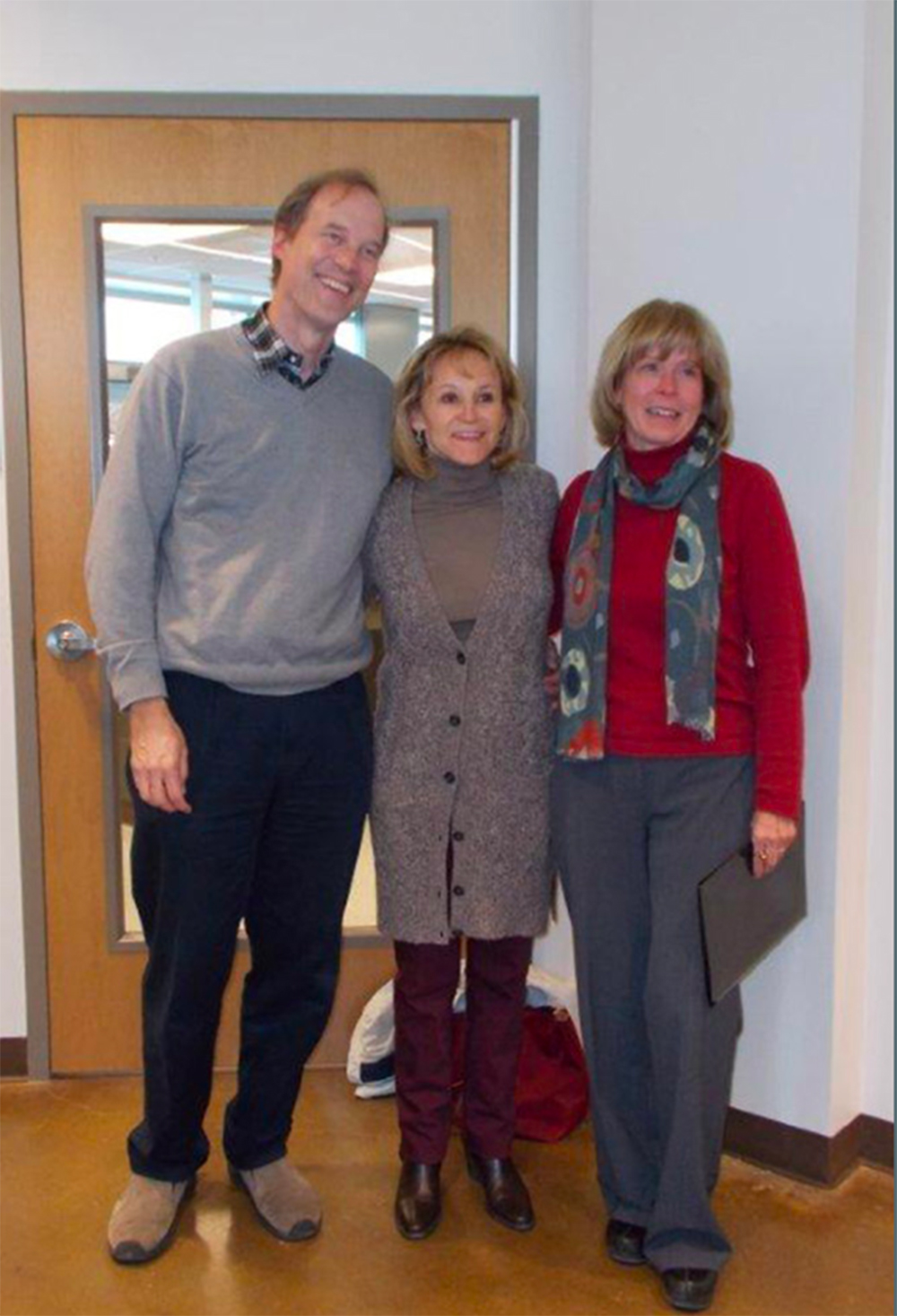 The Thatcher Presidential Endowed Chair of Biological Chemistry was established in
the spring of 2013 by the generosity of the Lawrence E. Thatcher family to support
cutting-edge biological chemistry research in the Thatcher Building. Cindy Burrows
was named the inaugural Thatcher Presidential Endowed Chair of Biological Chemistry
and held the position to this day.
The Thatcher Presidential Endowed Chair of Biological Chemistry was established in
the spring of 2013 by the generosity of the Lawrence E. Thatcher family to support
cutting-edge biological chemistry research in the Thatcher Building. Cindy Burrows
was named the inaugural Thatcher Presidential Endowed Chair of Biological Chemistry
and held the position to this day.
In July 2013, Cindy Burrows succeeded Henry White as Chair of the Department, and Henry became Dean of the College of Science. During his tenure as Chair, Henry hired 11 new professors, including four women, established three endowed chairs, and oversaw the completion of the $24M Thatcher Building. At the time, the department ranked 11th nationally in graduating B.S. chemistry majors with ACS-certified degrees.
On September 20, 2013, the Department of Chemistry, in partnership with Waters Corporation, held a symposium on Innovations in Biological Mass Spectrometry. The event also included a Dedication Ceremony for the Waters Advanced Mass Spectrometry Laboratory, featuring the Waters Xevo G2-S QTof instrument, which the Waters Corporation generously donated for the lab in the Thatcher Building. The device, worth over $500,000, ionizes chemical compounds to generate charged molecules or molecule fragments and measures their mass-to-charge ratios. It is designed to be adaptable with true innovations in the field, ensuring the instrument remains current.
Former faculty members, John Gladysz and Janet Bluemel announced a planned gift endowing the John A. Gladysz and Janet F. Bluemel Chair of Chemistry, which an outstanding researcher in any area of organic or inorganic chemistry will fill. Funds from the endowment will support the holder's teaching, research, service, and professional development.
Dr. Marilyn Marquis, the first woman to earn a Ph.D. from the College of Science, passed away on August 26, 2013. She received her undergraduate degree in Chemistry from the U, then returned to study with Henry Eyring. Dr. Marquis worked on dynamic mechanical testing of polyamides and the relationship between their rheological response and their chemical structure and completed her Ph.D. in Chemistry in 1951. Dr. Marquis worked for several large corporations and government labs, including Utah’s Dugway Proving Ground. Her research contributions are broad, including arc plasma processing of chemicals, synthesis of tetrafluoroethylene, synthesis of polymer intermediates from low btu methane, kinetics and mechanism of ozone reactions, and solvent effects in molecular decomposition reactions. She also earned an MBA in Finance and Management from Golden Gate University in San Francisco. She founded Alderwood Associates, a consulting firm specializing in technology management and financial planning. In 2012, Dr. Marquis was inducted into the second class of Distinguished Chemistry Alumni.
After nearly two decades of teaching, Professor-Lecturer Laya Kesner retired at the end of 2013. Kesner taught thousands of students in a wide variety of classes, including General Chemistry II, Environmental Chemistry, Pre-nursing Chemistry, and Quantitative Analysis. One of her students, Dr. Rebecca Uhlig, created the Laya Kesner Awards to show her appreciation for Dr. Kesner. “As my professor so long ago, Dr. Kesner was a genuinely caring person. She wanted to see me succeed not just in my understanding of chemistry and passing her class but also in my career goal of becoming an eye doctor,” Dr. Uhlig said. “She gave generously of her time... I wanted to ensure that, for once, a mentor would be thanked for their time spent!” The awards are given to deserving undergraduate chemistry majors who enhance the learning climate in the Department of Chemistry.
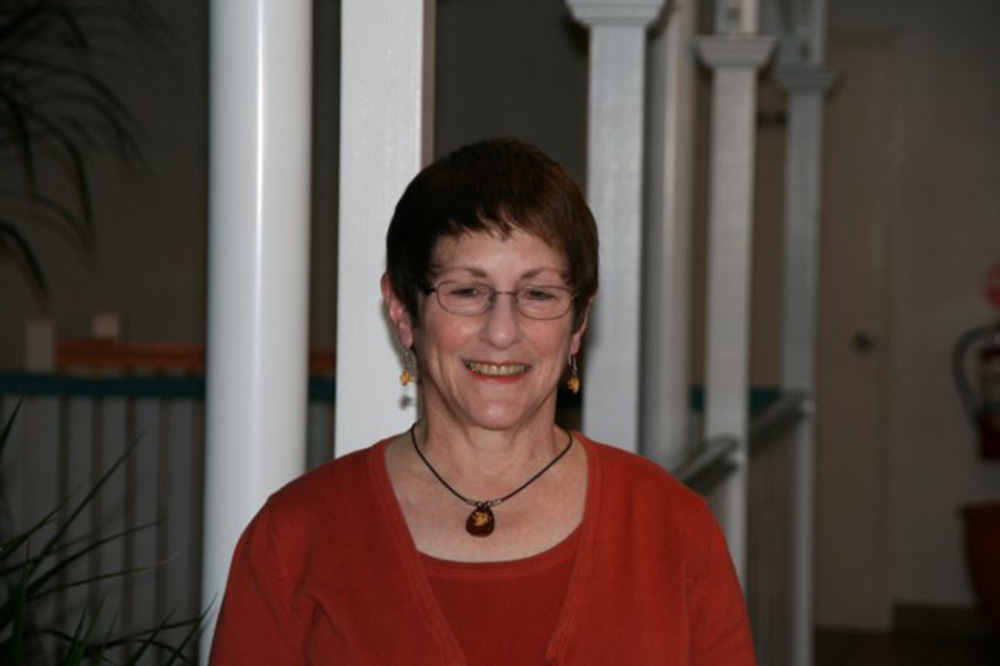
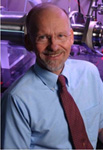 Richard D. Smith completed his doctorate degree under Jean Futrell in 1975. He is
the Battelle Fellow and Chief Scientist within the Biological Sciences Division of
the Pacific Northwest National Laboratory. His research interests span the development
of advanced analytical methods and instrumentation, with particular emphasis on high-resolution
separations and mass spectrometry and their applications in biological and biomedical
research. Dick is also the Director of Proteome Research at PNNL, Director of the
NIH Research Resource for Integrative Proteomics, an adjunct faculty member in the
chemistry departments at Washington State and Utah State universities, and an affiliate
faculty member at the University of Idaho and the Department of Molecular Microbiology
& Immunology at Oregon Health & Science University. He is the author/co-author of
more than 1,100 peer-reviewed journal articles and the recipient of 70 patents and
12 R&D 100 Awards.
Richard D. Smith completed his doctorate degree under Jean Futrell in 1975. He is
the Battelle Fellow and Chief Scientist within the Biological Sciences Division of
the Pacific Northwest National Laboratory. His research interests span the development
of advanced analytical methods and instrumentation, with particular emphasis on high-resolution
separations and mass spectrometry and their applications in biological and biomedical
research. Dick is also the Director of Proteome Research at PNNL, Director of the
NIH Research Resource for Integrative Proteomics, an adjunct faculty member in the
chemistry departments at Washington State and Utah State universities, and an affiliate
faculty member at the University of Idaho and the Department of Molecular Microbiology
& Immunology at Oregon Health & Science University. He is the author/co-author of
more than 1,100 peer-reviewed journal articles and the recipient of 70 patents and
12 R&D 100 Awards.
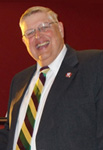 George F. Uhlig earned his doctorate degree in 1972 under Henry Eyring while a career
U.S. Air Force officer. George worked on his doctoral research and simultaneously
handled projects of greater interest to the Air Force. After retiring from the Air
Force in 1983 with the rank of Lieutenant Colonel, George was the head of Research
and Development for Hercules Aerospace at the Bacchus Works in Magna, Utah. He then
taught college chemistry courses, first at Salt Lake Community College and then at
the College of Eastern Utah in Price. At CEU, he founded the only science research
program at the college and inspired many students to pursue advanced education in
the sciences and engineering. George retired from CEU in 2008.
George F. Uhlig earned his doctorate degree in 1972 under Henry Eyring while a career
U.S. Air Force officer. George worked on his doctoral research and simultaneously
handled projects of greater interest to the Air Force. After retiring from the Air
Force in 1983 with the rank of Lieutenant Colonel, George was the head of Research
and Development for Hercules Aerospace at the Bacchus Works in Magna, Utah. He then
taught college chemistry courses, first at Salt Lake Community College and then at
the College of Eastern Utah in Price. At CEU, he founded the only science research
program at the college and inspired many students to pursue advanced education in
the sciences and engineering. George retired from CEU in 2008.
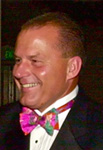 Robert R. Webb was the second doctoral graduate of Gary Keck’s lab. He defended his
thesis in 1982. Following an NIH-sponsored postdoctoral fellowship in the laboratory
of Sam Danishefsky at Yale University, Rob took a position in the pharmaceutical industry
with Bristol-Myers Squibb, working on drugs for the treatment of HIV infection and
cancer. Rob then moved to Arena Pharmaceuticals in San Diego, where he helped guide
key programs into development, most notably the obesity treatment APD356 (Lorcaserin).
He is currently Vice President at Amplyx Pharmaceuticals.
Robert R. Webb was the second doctoral graduate of Gary Keck’s lab. He defended his
thesis in 1982. Following an NIH-sponsored postdoctoral fellowship in the laboratory
of Sam Danishefsky at Yale University, Rob took a position in the pharmaceutical industry
with Bristol-Myers Squibb, working on drugs for the treatment of HIV infection and
cancer. Rob then moved to Arena Pharmaceuticals in San Diego, where he helped guide
key programs into development, most notably the obesity treatment APD356 (Lorcaserin).
He is currently Vice President at Amplyx Pharmaceuticals.
Caroline Saouma joined the department in January 2014 as an Assistant Professor and a member of the USTAR Alternative Energy Cluster. She received her B.S. in Chemistry from MIT in 2005 and her Ph.D.in Chemistry from Caltech in 2011. She was then an NIH NRSA postdoctoral fellow at the University of Washington, working in Professor James Mayer’s lab.
Gary Keck was recognized as a Distinguished Professor by the University of Utah and was also recognized as an ACS Cope Scholar. To recognize Keck’s impact at Utah and the broader world of chemistry, the department launched an initiative to establish the Gary E. Keck Endowed Graduate Fellowship. The Keck Fellowship will support one graduate student pursuing a Ph.D. in Chemistry each year.
Cindy Burrows was elected to the National Academy of Sciences on April 29, 2014.
Luisa Whittaker-Brooks and Michael Grünwald joined the faculty in 2014.
Whittaker-Brooks earned her Ph.D. in Materials Chemistry at the University of Buffalo, State University of New York, where she was a Fulbright Fellow. She then became a Postdoctoral Research Scholar in the Department of Chemical and Biological Engineering at Princeton.
Grünwald received his Ph.D. in Computational Physics from the University of Vienna. With the support of an Erwin Schrödinger Fellowship of the Austrian Science Fund, he joined the lab of Phillip Geissler at UC Berkeley as a postdoctoral researcher. Before starting his position at the University of Utah, he was a senior postdoctoral scientist at the University of Vienna.
The Department endowed the Robert W. Parry Lectureship in Chemistry in 2014. Parry was a giant in the profession. He was the founding editor of Inorganic Chemistry in 1960. He served as the President of the American Chemical Society in 1982, won the first Utah Governor’s Medal in Science and Technology in 1987, and received the American Chemical Society’s Priestley Medal in 1993. In his 60-year career, he taught thousands of undergrads and mentored over 60 Ph.D. students and postdocs. Together with Henry Eyring and Cheves Walling, he played a key role in the growth and development of chemistry at Utah. The Parry Lectureship invites eminent inorganic chemists to present their cutting-edge research to students and faculty at an annual event that honors Parry’s memory.
Lecture Hall 2008 (HEB) was renovated in 2014, including updated teaching technology, new seating, fresh paint, and a periodic table glass panel at the back of the room.
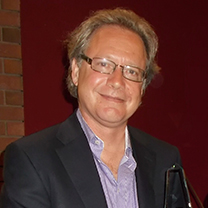 Professor David Clemmer received his Ph.D. at the University of Utah in 1992. He spent
a year in Japan as a Japan Society for the Promotion of Science Fellow at the Himeji
Institute of Technology and two years as a post-doctoral researcher at Northwestern
University. He joined the Chemistry faculty at Indiana University in 1995. His research
involves the development of methods for studying the structures of complex low-symmetry
systems in the gas phase.
Professor David Clemmer received his Ph.D. at the University of Utah in 1992. He spent
a year in Japan as a Japan Society for the Promotion of Science Fellow at the Himeji
Institute of Technology and two years as a post-doctoral researcher at Northwestern
University. He joined the Chemistry faculty at Indiana University in 1995. His research
involves the development of methods for studying the structures of complex low-symmetry
systems in the gas phase.
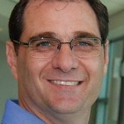 Jerry A. Murry obtained his Ph.D. in synthetic organic chemistry at the University
of Utah with Professor Gary E. Keck in 1994 and completed an NIH postdoctoral fellowship
with Professor David A. Evans at Harvard University. He started his industrial career
at Pfizer, then worked as the Director of Process Development at Merck Research Laboratories.
He joined Amgen in 2006, where he is now Vice President of Small Molecule Process
and Product Development.
Jerry A. Murry obtained his Ph.D. in synthetic organic chemistry at the University
of Utah with Professor Gary E. Keck in 1994 and completed an NIH postdoctoral fellowship
with Professor David A. Evans at Harvard University. He started his industrial career
at Pfizer, then worked as the Director of Process Development at Merck Research Laboratories.
He joined Amgen in 2006, where he is now Vice President of Small Molecule Process
and Product Development.
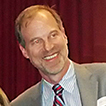 Thomas F. Thatcher received his BA in Chemistry from the University of Utah in 1985,
along with an emphasis in Japanese. He was a missionary for the LDS Church in Fukuoka,
Japan, from 1980 to 1982. In 1987, he obtained his MBA from Brigham Young University.
He worked for 27 years at the Thatcher Company and was General Manager of Thatcher
Pharmaceutical from 1999 - 2012. Tom is the founder and CEO of Intuitive Funding;
a company focused on helping startups succeed.
Thomas F. Thatcher received his BA in Chemistry from the University of Utah in 1985,
along with an emphasis in Japanese. He was a missionary for the LDS Church in Fukuoka,
Japan, from 1980 to 1982. In 1987, he obtained his MBA from Brigham Young University.
He worked for 27 years at the Thatcher Company and was General Manager of Thatcher
Pharmaceutical from 1999 - 2012. Tom is the founder and CEO of Intuitive Funding;
a company focused on helping startups succeed.
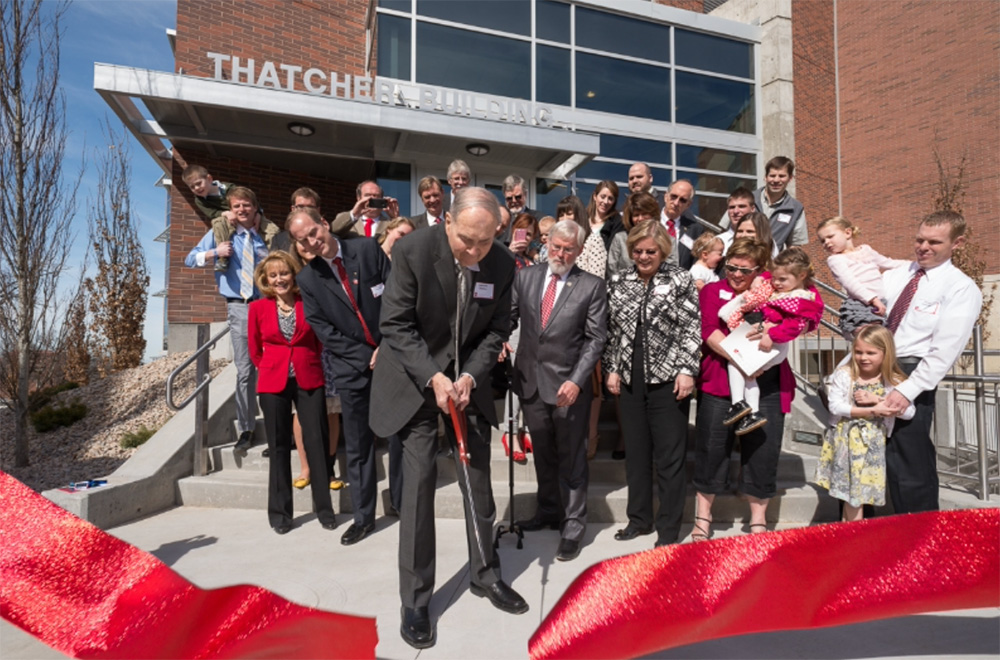
Henry White was awarded the first Allen J. Bard Award in Electrochemistry for his pioneering innovations furthering scientific knowledge and understanding of nanometer-scale electrochemistry, micron-scale magnetohydrodynamic flow, ion transport across membranes, and electroanalytical applications of glass nanopore membranes. The award was presented at the 227th Electrochemical Society Meeting in May 2015.
Vahe Bandarian joined the faculty in July 2015. He received his Ph.D. in Biochemistry from the University of Wisconsin-Madison in 1998, working under the direction of George Reed. He was an NIH postdoctoral fellow in the lab of Rowena Matthews at the University of Michigan prior to joining the faculty at the University of Arizona in 2003.
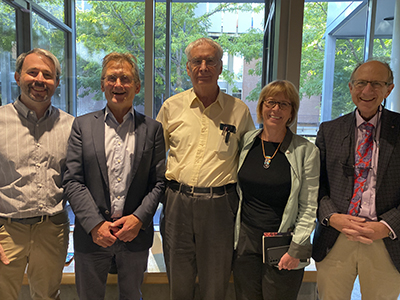 The Stang-Burrows-Sessler Lectureship was established by Jonathan Sessler (of UT Austin)
to recognize his long-term friends and colleagues, Peter Stang and Cindy Burrows.
The lecture provides a significant new educational and research opportunity for the
Department’s students, engaging them with pioneering science from around the United
States and the world. The Stang-Burrows-Sessler Lecture hosts leading voices in non-traditional
areas of organic chemistry.
The Stang-Burrows-Sessler Lectureship was established by Jonathan Sessler (of UT Austin)
to recognize his long-term friends and colleagues, Peter Stang and Cindy Burrows.
The lecture provides a significant new educational and research opportunity for the
Department’s students, engaging them with pioneering science from around the United
States and the world. The Stang-Burrows-Sessler Lecture hosts leading voices in non-traditional
areas of organic chemistry.
Jennifer Heemstra (now at Washington University) won a Cottrell Scholar Award.
Shelley Minteer won the Luigi Galvani Prize of the Bioelectrochemistry Society, an honor given once every two years for research in the field of bioelectrochemistry. She was the first professor from the U to receive the award.
Alumni News:
Jaqueline Kiplinger (Ph.D. ‘96) and David Moore (BS ‘74) were appointed to the rank of Fellow at Los Alamos National Laboratory. Fellows are chosen based on sustained, high-level achievements in programs of importance to the Laboratory. This fundamental discovery has led to widespread use and status as an authority in the field.
Dr. Kiplinger obtained her Ph.D. in Tom Richmond’s group in 1996. She is a recognized pioneer in uranium and thorium chemistry, and her research has significantly expanded the broad understanding of actinide and lanthanide chemical bonding and reactivity. Her synthetic innovations, often accomplished through chemistry previously thought impossible, have been adopted by researchers worldwide. Dr. Kiplinger has been named a Fellow of the Society of Chemistry (FRSC) and the American Association for the Advancement of Science (AAAS) for her internationally recognized work. She has received the Los Alamos Fellows Prize for Research. Dr. Kiplinger’s scientific achievements have been paralleled by her 15 years of dedicated service to the Laboratory. Her innovative “green” methods for preparing actinide materials have earned two R&D 100 Awards and two NNSA Best-in-Class Pollution Prevention.
Awards. Dr. Kiplinger’s sustained excellence in mentoring numerous students and postdocs has been recognized by Los Alamos’ Student Distinguished Mentor Award, STAR Award, and Postdoc Distinguished Mentor Award.
Dr. Moore received his bachelor’s degree in chemistry at the U in 1974 before pursuing his Ph.D. at Wisconsin. His laser shock experiments have opened the field of materials at extremes in pressure and temperature to a wide range of researchers. He has made it possible to study shocked materials in research labs with tabletop lasers, as well as to use de minimis quantities of materials to map out their equations of state under extreme conditions. Dr. Moore has contributed also to the lab through a continuous record of community service through mentoring and committee work, exemplified by Fellowship in the American Physical Society and International Union of Pure and Applied Chemistry, as well as a Los Alamos Fellows Prize for Leadership. He has contributed to national security through his work on explosives detection and by his work with a team initiating the lab’s homemade explosives course. Dr. Moore has performed high-impact work on national security in both the weapons program and the threat reduction directorate.
Jaqueline Kiplinger was also the 2015 recipient of the F. Albert Cotton Award in Synthetic Inorganic Chemistry from the American Chemical Society.
Peter Siddoway (BS ‘00) was named a new partner at Myers Bigel, the largest independent patent law firm in North Carolina. Mr. Siddoway is a member of the firm’s busy litigation practice. His bachelor’s degree and prior industry experience as a chemist enable him to address intellectual property disputes, and particularly patent litigation. He is admitted to practice in both Ohio and North Carolina, as well as before the United States Court of Appeals for the Federal Circuit and the U.S. Patent and Trademark Office. Mr. Siddoway’s experience in patent litigation involves a wide range of technologies, including digital cameras, automotive components, chemical compounds, and LEDs. He has litigated trademarks, restrictive employment agreement covenants, and trade secrets. He also has significant experience in the field of Inter Partes Review and other contested proceedings in the Patent Office.
Clifton Sanders, Ph.D., has accepted the Provost of Academic Affairs position at Salt Lake Community College (SLCC). Professor Sanders received his Ph.D. in organic chemistry in Professor Evan Allred’s lab in 1990. He worked for 3M and in private industry, coinventing innovations that led to several patents for medical devices. For the past 20 years, Prof. Sanders
has been a faculty member, division chair, dean, and interim vice president at SLCC. “His leadership in engaged learning, securing grants, workforce integration, cross-departmental collaboration, and social justice practices are and will continue to be an asset to the College,” said SLCC President Deneece G. Huftalin. Prof. Sanders’ vision for the post is a continued increase in certificate and degree completion rates while focusing on “deep learning, proficient workforce skills, transformative citizenship and a hunger for lifelong learning.” He said SLCC has several highly regarded programs and initiatives that have contributed to the institution awarding more than 30,000 certificates and degrees over the past decade. SLCC is the largest source of transfer students to Utah’s four-year institutions, a Top 10 college nationally for total associate degrees awarded, and the sole provider of applied technology courses in the Salt Lake region.
Research in Ryan Looper’s lab led to an antibiofilm antibiotic called CZ-99.
Peter Stang won the 2015 China’s Friendship Award, which the Chinese Academy of Sciences says is “the People’s Republic of China’s highest award for foreign experts who have made outstanding contributions to the country’s economic and social progress.”
Ryan Looper and Amy Barrios (BS ‘95, U of U Professor of Medicinal Chemistry) were both Teva Pharmaceutical Scholars in 2015, meaning that two out of the three Teva awards went to the U! The award is administered by ACS and funded by Teva Pharmaceuticals. It supports academic scientists at Ph.D.-granting institutions in the U.S. Awardees receive $100,000/year for three years to support research with potential or direct connections to medicinal chemistry.
Ryan Looper was also the U of U Presidential Scholar in 2015. The Presidential Scholar award supports the work of exceptionally promising mid-career faculty across campus, providing funding for three years for research, teaching, and outreach.
Luisa Whittaker-Brooks was one of four outstanding women chemists recognized with the inaugural Marion Milligan Mason Awards from the American Association for the Advancement of Science. The award provides early-career faculty with $50,000 for research.
Jay Kitt, then a Ph.D. student in the Harris group (now a Research Assistant Professor), won the Society for Applied Spectroscopy Barbara Stull Graduate Student Award, which recognizes a graduate student for outstanding research in spectroscopy and is presented in honor of longtime SAS colleague Barbara L. Stull. Kitt’s Ph.D. in Analytical Chemistry focused on using
confocal Raman microscopy to probe interfacial environments within nanoporous materials and optical-trapping confocal Raman microscopy to investigate phospholipid vesicle phase transitions. In 2012, he was awarded an NSF-IGERT research fellowship, and, as a teaching assistant in analytical chemistry, he was honored with the 2012 W.W. Epstein Outstanding Educator Award. The Coblentz Society recognized Kitt’s research in Raman spectroscopy with a Coblentz Student Award.
Alumni News:
Alan Eastman (BS ‘71, Ph.D. ‘75) is the co-founder and chief scientist of a startup geothermal energy company, GreenFire Energy, that uses supercritical CO2 instead of water to bring geothermal heat to the surface where it can be turned into electrical energy. This endeavor is still in the early stages but has working partnerships with national laboratories, as well as the interest of the Geothermal Technologies Program of the DOE. This fall, Eastman is also teaching a class on alternative energies through the U Department of Continuing Education’s Osher program.
The ACS named Ellen Fisher (Ph.D. ‘91) to its 2015 Class of Fellows. Fisher is a professor of chemistry at Colorado State University. She received her doctoral degree in ‘91, working with Prof. Peter Armentrout. Her research focuses on understanding the fundamental chemical processes that take place during plasma processing and chemical vapor deposition. She works to improve solar cell efficiency, develops composite nanomaterials, and explores environmental applications for plasma chemistry.
Barron Reyes (BS ‘05) graduated with a degree in Biochemistry and attended the University of Vermont School of Medicine. He graduated as chief resident of the emergency medicine residency program at the Maricopa Medical Center in Phoenix, AZ. Reyes now works as an attending emergency medicine physician in Wyoming.
Dr. David Wilson (BA ‘79, Ph.D. ‘84) received the prestigious “Hero of Chemistry” Award from the American Chemical Society. Wilson and his colleagues led the development of INSITE™ catalyst, a revolutionary technology for highly-tailored materials bridging the properties of plastic and rubber. These polymers are used in consumer markets, including automotive, building and construction, and consumer packaging. Wilson graduated magna cum laude with his bachelor’s in ‘79 and earned his Ph.D. with Prof. Richard Ernst in ‘84.
Dr. Andrew J. Leavitt (Ph.D. ‘94) was named the 11th chancellor of the University of Wisconsin Oshkosh. He received his Ph.D. in ‘94, working with Prof. Thomas Beebe, Jr. While a chemistry professor at the University of West Georgia, Leavitt was twice named Outstanding Faculty Member of the Year (‘99, ‘05) by the Student Government. Most recently he served as VP for University Advancement at the University of North Georgia and CEO of the University of North Georgia Foundation, Inc.
Bo Zhang (Ph.D. ‘06), who received his Ph.D. with Prof. Henry White, was recently promoted to the rank of Associate Professor with tenure in the chemistry department at the University of Washington, Seattle. He has a research group of 10 working in the areas of nanoscale electrochemistry, fluorescence-enabled electrochemical microscopy (FEEM) for imaging, and neuronal communication.
Dixon Woodbury (BA ‘80) graduated with a BA in Chemistry from the U in ‘80, then a Ph.D. in Physiology & Biophysics from UC-Irvine in ‘86. After a postdoc in the Boston area, Woodbury became an assistant professor at the Medical School at Wayne State University. In ‘01, he joined the Department of Physiology and Developmental Biology at BYU and was appointed chair in ‘13.
Amy Barrios (BS ‘95) is an Associate Professor of Medicinal Chemistry at the College of Pharmacy. She was recently named co-Director of the Women in Medicine and Sciences group at the U’s Health Sciences Center, which promotes faculty development, mentoring, and advocacy of women faculty in all stages of their careers. Barrios, along with Prof. Ryan Looper, is a 2015 Teva Pharmaceuticals Scholar.
Trent Ohman (BS ‘07) graduated in ‘07 with a BS in Biochemistry and began working in the mass spec lab at ARUP laboratories. For 8 years, he worked in various roles in mass spec and earned an ASCP medical technologist certification along the way. This August, Ohman started as the senior scientist at the Highland Springs Clinical Toxicology lab in Salt Lake City, where his team uses mass spec to confirm the presence or absence of drugs in urine.
Zlatko Bačić (Ph.D. ‘81), together with colleagues at NYU and NYU Shanghai, organized the inaugural 2015 Shanghai Symposium on Frontiers in Computational Chemistry, held in August in Shanghai, China. The symposium provided a platform for promoting international collaboration and exchange and presenting novel research directions and methodologies.
Speakers included leading theoretical chemists Todd Martinez, Weitao Yang, Martin Head-Gordon, Keiji Morokuma, David Tannor, Michael Collins, and Donghui Zhang. The next symposium is scheduled for the summer of 2017.
Robyn Seely (BS ‘04) graduated in ‘04 with a B.S. in Chemical Physics, then received a Doctorate of Pharmacy from Northeastern in ‘09. She is currently the Director of Pharmacy Drug Utilization for the UT Department of Health, where she writes policies for the Pharmacy benefit portion of Utah Medicaid and contributes to and interprets state and federal rules, statutes, and legislation.
Jared Frandsen (BS ‘08) received his BS in chemistry in 2008 after nearly ten years doing nuclear engineering on submarines for the US Navy. He received his Doctorate of Pharmacy from the U in 2015 and currently works as a Nuclear Pharmacist for the Department of Radiology at the U of U Hospital.
Jonathan Penfield (BS ‘09) graduated in ‘09 and went on to a master’s degree in Biochemistry at UBC Vancouver. He worked on the structure and kinetics of bacterial steroid metabolism. Penfield returned to the states this summer to work at Codexis in California as a Research Associate in enzyme engineering for its use in green chemistry.
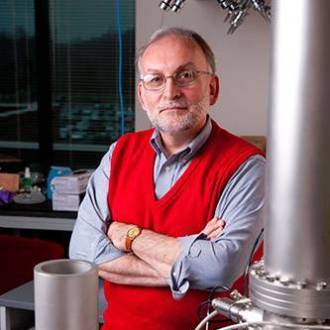 Professor Joseph A. Gardella, Jr. received his Ph.D. in Analytical Chemistry at the
University of Pittsburgh and completed postdoctoral research in Physical Chemistry
at the University of Utah, working with Ted Eyring in 1982. He then joined the faculty
at University at Buffalo, State University of New York, where he is now a Distinguished
Professor and the John & Frances Larkin Professor of Chemistry. Joe’s research interests
are in quantitative analysis and surface chemistry, broadly applied to the study of
environmental effects on polymer surfaces and tissue engineering with synthetic biomaterials.
He is also director of the Interdisciplinary Science and Engineering Partnership (ISEP),
which brings together the University of Buffalo, 21 public schools, the Buffalo Museum
of Science, and Buffalo State College to increase hands-on learning in science classes.
Professor Joseph A. Gardella, Jr. received his Ph.D. in Analytical Chemistry at the
University of Pittsburgh and completed postdoctoral research in Physical Chemistry
at the University of Utah, working with Ted Eyring in 1982. He then joined the faculty
at University at Buffalo, State University of New York, where he is now a Distinguished
Professor and the John & Frances Larkin Professor of Chemistry. Joe’s research interests
are in quantitative analysis and surface chemistry, broadly applied to the study of
environmental effects on polymer surfaces and tissue engineering with synthetic biomaterials.
He is also director of the Interdisciplinary Science and Engineering Partnership (ISEP),
which brings together the University of Buffalo, 21 public schools, the Buffalo Museum
of Science, and Buffalo State College to increase hands-on learning in science classes.
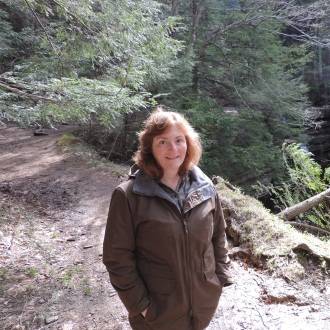 Diane B. Parry obtained her Ph.D. in Physical and Analytical Chemistry at the University
of Utah with Professor Joel Harris in 1989, followed by postdoctoral research with
Mike Philpott at IBM's Almaden Research Center in San Jose, CA. She has worked at
Procter & Gamble for 26 years, leading many disciplines within Research & Development,
including supply chain innovation, process design, consumer understanding, and formula
design. Diane is currently a Research & Development Associate Director; her department
includes chemists, physicists, and engineers and stretches across six countries. Diane
is also the President of the Society for Applied Spectroscopy. She has been involved
in FACSS and SciX for more than ten years, including as the Governing Board Chair
in 2006, and started organizing sessions on “Analytical Chemists Easing World Poverty”
in 2010.
Diane B. Parry obtained her Ph.D. in Physical and Analytical Chemistry at the University
of Utah with Professor Joel Harris in 1989, followed by postdoctoral research with
Mike Philpott at IBM's Almaden Research Center in San Jose, CA. She has worked at
Procter & Gamble for 26 years, leading many disciplines within Research & Development,
including supply chain innovation, process design, consumer understanding, and formula
design. Diane is currently a Research & Development Associate Director; her department
includes chemists, physicists, and engineers and stretches across six countries. Diane
is also the President of the Society for Applied Spectroscopy. She has been involved
in FACSS and SciX for more than ten years, including as the Governing Board Chair
in 2006, and started organizing sessions on “Analytical Chemists Easing World Poverty”
in 2010.
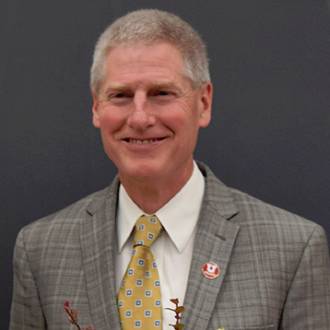 Don L. Reese, MD received his B.S. in Chemistry from the University of Utah in 1973.
He then attended medical school at the University of Utah, earning his Doctor of Medicine
degree in 1977. He completed a dermatology residency at the University of Minnesota
in 1981. In 1983, Don started his own private practice in dermatology, working in the field until his
recent retirement. Don and his wife Rebecca have been champions of undergraduate teaching
and research at the U. They have generously endowed a scholarship in science teaching
with the College of Science and a chemistry scholarship through the Ragsdale Fund.
Their contribution to the Thatcher Building established the Department’s advanced
undergraduate laboratories. Don and Rebecca are also founding members of the Curie
Club.
Don L. Reese, MD received his B.S. in Chemistry from the University of Utah in 1973.
He then attended medical school at the University of Utah, earning his Doctor of Medicine
degree in 1977. He completed a dermatology residency at the University of Minnesota
in 1981. In 1983, Don started his own private practice in dermatology, working in the field until his
recent retirement. Don and his wife Rebecca have been champions of undergraduate teaching
and research at the U. They have generously endowed a scholarship in science teaching
with the College of Science and a chemistry scholarship through the Ragsdale Fund.
Their contribution to the Thatcher Building established the Department’s advanced
undergraduate laboratories. Don and Rebecca are also founding members of the Curie
Club.
Kirk M. Ririe is a visionary scientist and inventor with several patents to his name. He currently serves as CEO of BioFire Defense, which delivers a fully integrated suite of biological agent identification products and life science systems to the biodefense and first responder community. Among his inventions, he built a prototype to shorten the processing time of a cutting-edge DNA analysis technique called PCR from hours to minutes. This prototype, and assistance from his alma mater, the University of Utah, spurred his founding of BioFire Diagnostics, Inc. and the invention of the LightCycler. His latest invention, FilmArray System and Respiratory Panel was approved by the FDA in 2011 to quickly test dozens of organisms simultaneously. Ririe is the recipient of numerous awards, including Entrepreneur of the Year from Ernst & Young in 2004, the Franklin Jefferson Award in Science and Technology Innovation in 1999, and the Utah Technology Council’s Hall of Fame in 2014.
Rodrigo Noriega joined the faculty in 2016. He earned his Ph.D. in Applied Physics from Stanford University, working with Alberto Salleo in the Materials Science and Engineering department on the connection between structural disorder and charge transport in organic semiconductors, culminating in a Nature Materials article that was highlighted in Nature Materials and Science. Rodrigo’s postdoctoral work with Naomi Ginsberg at UC-Berkeley focused on the effects of the local environment on the photophysical properties of biomimetic light harvesters and new organic light-emitting diode materials using ultrafast spectroscopy and single molecule measurements.
In 2016, the department was home to four prominent chemistry publications: The Journal of the American Chemical Society, led by Peter Stang, The Journal of Organic Chemistry, led by Dale Poulter, Accounts of Chemical Research, led by Cindy Burrows, and the Journal of the Electrochemical Society, with Shelley Minteer as Technical Editor. Cindy Burrows remains the Editor-In-Chief of Accounts of Chemical Research to this day, and Shelley Minteer is the Editor-in-Chief of the ACS Au suite of journals.
On March 23rd, the Curie Club hosted a lunch for all the women faculty members in the College of Science to meet Carol Gross, a Professor at UCSF and member of the National Academy who studies functional and regulatory networks in bacteria. Her other passion is increasing diversity in STEM both by mentoring students/faculty and developing programs to increase student diversity. Professor Gross gave a Hugo Rossi Lecture entitled “Participation of Women
in Science: Problems and Solutions” during her visit to the U. There is abundant evidence that women are underrepresented in STEM disciplines. In this talk, Professor Gross discussed some of the root causes, documented disparities, and presented strategies to enhance the success of women graduate students and faculty.
On April 12th, the Department of Chemistry held the inaugural Robert W. Parry Lectureship in Inorganic Chemistry. This annual lecture honors Distinguished Professor Bob Parry, one of our most notable former faculty members. The lecture was delivered by Professor Harry Gray, a world-class inorganic chemist from Caltech, a friend of Bob Parry’s, and a donor to the fund. As Bob’s friend, he had some wonderful stories to share with those in attendance. Bob’s wife, Marjorie Parry, and one of their granddaughters also attended, making the first Parry Lecture a truly special event.
Kirk M. Ririe (BS ’05) received an honorary Doctor of Science degree at the University’s commencement ceremony on May 5th, 2016. This is the highest honor given by the U. Ririe is a visionary scientist and inventor with numerous patents to his name. He currently serves as CEO of BioFire Defense, which delivers a fully integrated suite of biological agent identification products and life science systems to the biodefense and first responder community. Among his inventions, he built the prototype to shorten the processing time of the Nobel prize-winning DNA
analysis technique called PCR from hours to minutes. This prototype, and assistance from his alma mater, the University of Utah, spurred his founding of BioFire Diagnostics, Inc. and the invention of the LightCycler. His latest invention, FilmArray System and Respiratory Panel was approved by the FDA in 2011 to quickly test dozens of organisms simultaneously. Ririe is the recipient of numerous awards, including recognition as a Chemistry Distinguished Alumnus in 2015, Entrepreneur of the Year from Ernst & Young in 2004, and the Franklin Jefferson Award in Science and Technology Innovation in 1999.
Professor Emeritus Ted Eyring is a prominent figure in the memories of chemistry alumni. Ted has been a pillar of the department for over 50 years. To celebrate Ted’s recent retirement and the consideration he always gave to his students and colleagues, the Department is raising funds to endow the Edward M. Eyring Lectureship in Chemistry. The Eyring Lectureship will invite eminent physical chemists to present their latest research to our students and faculty at an annual lecture.
John Heemstra was selected for a 2016 U of U Early Career Teaching Award. Dr. Heemstra (now at Washington University) taught general, organic, and biochemistry with huge success. His past students enjoyed his teaching so much that they reported wanting to take all of the chemistry courses he was scheduled to teach. Heemstra earned his Ph.D. in chemistry at the University of Illinois at Urbana-Champaign in 2007 and was a postdoctoral fellow at Harvard Medical School. He joined the teaching faculty at the University of Utah in 2012. In his short time with the Department, he won numerous teaching awards, nominated by both faculty and students.
Three students from the Department of Chemistry won 2016 pre-doctoral fellowships from the National Science Foundation Graduate Research Fellowship Program:
- Sophie Bertram, who graduated in May 2014, was awarded an NSF Graduate Research Fellowship to pursue her Ph.D. at MIT.
- Sophia Robinson (Ph.D. 2020), then a member of Matt Sigman’s group, working on a collaborative project with Shelley Minteer.
- Julieann Selden, then a member of Ilya Zharov’s group, working on a Materials Research Science & Engineering-related project.
The Cheves T. Walling Graduate Research Award goes to the writer of the year’s top Ph.D. dissertation. This year, the award was given to two researchers who shared the top spot:
- Jay Kitt, “Raman Microscopy Studies of Liquid/Solid Interfaces Within Individual Porous Silica Particles”
- David Baumann, ““Synthesis of Diacyl Glycerol Lactone-Based Bryostatin Analogs: Progress Towards a Simplified Binding Domain that Retains the Biological Properties of the Natural Product”
George and Camilla Smith, generous long-time supporters of the University of Utah, funded the Henry Eyring Lectureship in Chemistry and the Bryant A. Miner Lectureship in Chemistry in 2016.
These endowments memorialize two important chemists in the Department’s history: Bryant A. Miner, Camilla Smith’s brother, who earned his Ph.D. in chemistry at the U in 1965 and taught countless chemists in his 43 years at Weber State University, and Henry Eyring, Camilla and Bryant’s uncle, who established the U’s Graduate School and was one of our nation’s most renowned chemists.
These lectures are unique because of Henry Eyring and Bryant Miner’s mentor-mentee relationship. Eyring was the thesis advisor for his nephew’s doctoral degree. The inaugural lectures were held in the spring of 2017, featuring two outstanding chemists with the same mentor-mentee relationship (Nobel Laureate Prof. Robert Grubbs and his former graduate student Prof. Melanie Sanford), along with the dedication of the Henry Eyring and Bryant A. Miner Chemistry Lecture Theater.
The Curie Club launched a new event series reaching out to undergraduate and graduate students across STEM fields. Each month, two successful women in science or engineering careers in academia or industry give advice, offer mentorship, and talk about their career paths to a large group of female students.
In the fall of 2016, the Department of Chemistry started a new undergraduate mentoring program to match incoming chemistry students with advanced chemistry students to serve as mentors. Research has shown that graduation and retention rates increase by creating a sense of belonging when students first arrive at their university. In the Department of Chemistry, peer mentoring groups are established in the chemistry undergraduate seminar course to ensure that students develop a community within the department early in their academic career at the U. At the end of the semester, students go on a campus-wide scavenger hunt to find all the campus resources available to them during their time at the U.
The Master of Science for Secondary School Teachers (MSSST) degree program in the College of Science provides a unique opportunity for practicing secondary school teachers to earn an MS degree in science teaching with a focus on developing science content knowledge rather than pedagogy. Chemistry professor Tom Richmond directs the program.
In the past two years, more than forty degrees have been awarded in this cohort-based program, culminating in an authentic hands-on research experience. Even experienced teachers find they benefit from a return to the college classroom. However, their research lab placements alongside graduate students and postdoctoral researchers allow teachers to expose the process of research and contribute to the discovery of new knowledge. Teachers ultimately take the excitement of research back to their classrooms, enhancing public education in Utah.
In 2016, the Department of Chemistry was recognized as one of the top departments for female faculty in C&EN. Of the top 50 schools in terms of chemical R&D spending, Utah came in 5th for the number of women and 6th for the percentage of women, at 26% - well above the average of 19%.
Alumni News:
Joe Stewart (MS ‘91)
After graduation, Joe Stewart worked for three years at an environmental testing laboratory using GC/MS to analyze soil and water extracts and industrial hygiene-related sorbent tubes and air samples. Then he decided to start his own company, OnSite Analytical Services. He built a small laboratory in West Valley City and did analytical work for the stack testing, plume mapping, and petroleum refining industries. This was fun and varied work. One memorable job was an investigation of unwanted explosions in a specific process, located about 500 yards downrange of another explosion test site constantly bombarding him with shockwaves on the job. In 1999, Joe closed his business and began work for Kennecott Utah Copper, moving from process chemist to Senior Project Engineer. He worked on troubleshooting water treatment systems, performing risk analysis for proposed capital projects, managing the site-wide contaminant transport model, and modeling water mixing strategies. In 2009, he became a research engineer at the Utah Water Research Laboratory, working various LC/MS and GC/MS systems and developing compound-specific analytical methods to meet research needs. He will also complete a graduate degree in Technical Writing this December.
Courtney Gwinn (BS ‘12)
Courtney Gwinn is currently an MD Candidate at the University of Washington School of Medicine in the class of 2016. She is about to begin her residency in Internal Medicine at the University of Washington.
Richard Nkansah (MS ‘12)
Richard Nkansah lives in Bend, Oregon, with his wife, Zola, where he works as a chemist for a pharmaceutical company. His work is filled with several inteexcitingblem statements and opportunities to make better medicines through science and engineering. Zola works as an admissions specialist and recruiter for the Oregon State University, Cascades campus in Bend.
Sabah Ul-Hasan (BS ‘12)
Sabah Ul-Hasan is currently a Ph.D. Eugene Cota-Robles Fellow in Quantitative and Systems Biology at the University of California, Merced. She is also part of BIOTA, a science documentary series that merges art and science to spotlight symbiotic relationships and strives to reach audiences traditionally underrepresented in science. The first episode of the documentary web series premiered at The Leonardo in Salt Lake City on April 28, 2016. Find the show online athttp://biotatvorg.tumblr.com/.
Miles Roberts (BS ‘14)
Miles Roberts graduated with his BS in Chemistry in 2014. He moved to the Big Island of Hawaii the summer after graduation and began attending the Daniel K. Inouye College of Pharmacy in Hilo. Miles hopes to return to Utah for a portion of his fourth-year rotations. He will receive his Doctorate in Pharmacy in May 2018. He is proud to have graduated from the U and often thinks about the friendships made and counsel received as an undergrad. Miles is incredibly grateful for Professors Jon Rainier and Holly Sebahar, excellent examples of outstanding teachers.
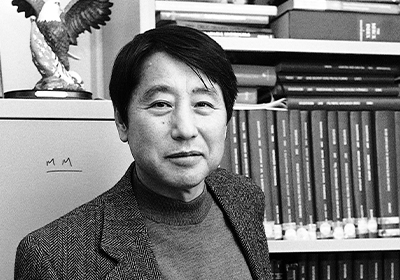 Sung Wan Kim received his Ph.D. in Physical Chemistry with Professor Henry Eyring
in 1969. He is currently a Distinguished Professor of Pharmaceutics and Pharmaceutical
Chemistry and a Distinguished Professor of Bioengineering at the U. He was Director
of the Center for Controlled Chemical Delivery from 1985-2006. Dr. Kim is a pioneer
in drug delivery research focused on hydrogels, biodegradable drug conjugates, self-regulating
drug delivery, and stimuli-sensitive polymers.
Sung Wan Kim received his Ph.D. in Physical Chemistry with Professor Henry Eyring
in 1969. He is currently a Distinguished Professor of Pharmaceutics and Pharmaceutical
Chemistry and a Distinguished Professor of Bioengineering at the U. He was Director
of the Center for Controlled Chemical Delivery from 1985-2006. Dr. Kim is a pioneer
in drug delivery research focused on hydrogels, biodegradable drug conjugates, self-regulating
drug delivery, and stimuli-sensitive polymers.
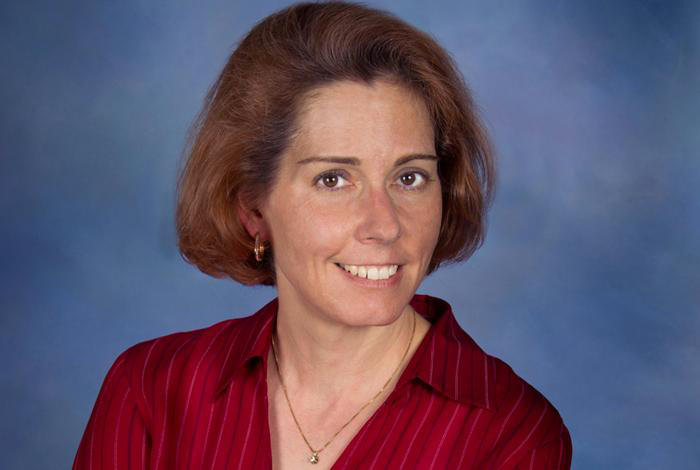 Jaqueline L. Kiplinger obtained her Ph.D. in Organometallic Fluorocarbon Chemistry
at the University of Utah with Professor Tom Richmond in 1996. She is now a Fellow
at Los Alamos National Laboratory, where she has worked since starting as a postdoctoral
fellow in 1999. She is recognized as a uranium and thorium chemistry pioneer and has
received numerous awards for her research, service, and mentorship.
Jaqueline L. Kiplinger obtained her Ph.D. in Organometallic Fluorocarbon Chemistry
at the University of Utah with Professor Tom Richmond in 1996. She is now a Fellow
at Los Alamos National Laboratory, where she has worked since starting as a postdoctoral
fellow in 1999. She is recognized as a uranium and thorium chemistry pioneer and has
received numerous awards for her research, service, and mentorship.
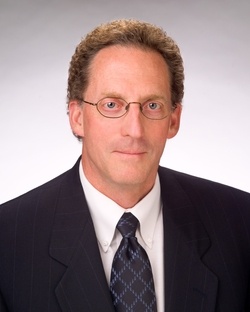 Milton L. Lee received his B.A. in Chemistry from the University of Utah in 1971.
He attended graduate school at Indiana University, earning his Ph.D. with Professor
Milos Novotny in 1975. In 1976, he joined the faculty at BYU, where he is now the
H. Tracy Hall Professor of Chemistry. He specializes in micro separation techniques,
column technology for micro separations, and instrumentation for capillary and high-performance
separations-mass spectrometry.
Milton L. Lee received his B.A. in Chemistry from the University of Utah in 1971.
He attended graduate school at Indiana University, earning his Ph.D. with Professor
Milos Novotny in 1975. In 1976, he joined the faculty at BYU, where he is now the
H. Tracy Hall Professor of Chemistry. He specializes in micro separation techniques,
column technology for micro separations, and instrumentation for capillary and high-performance
separations-mass spectrometry.
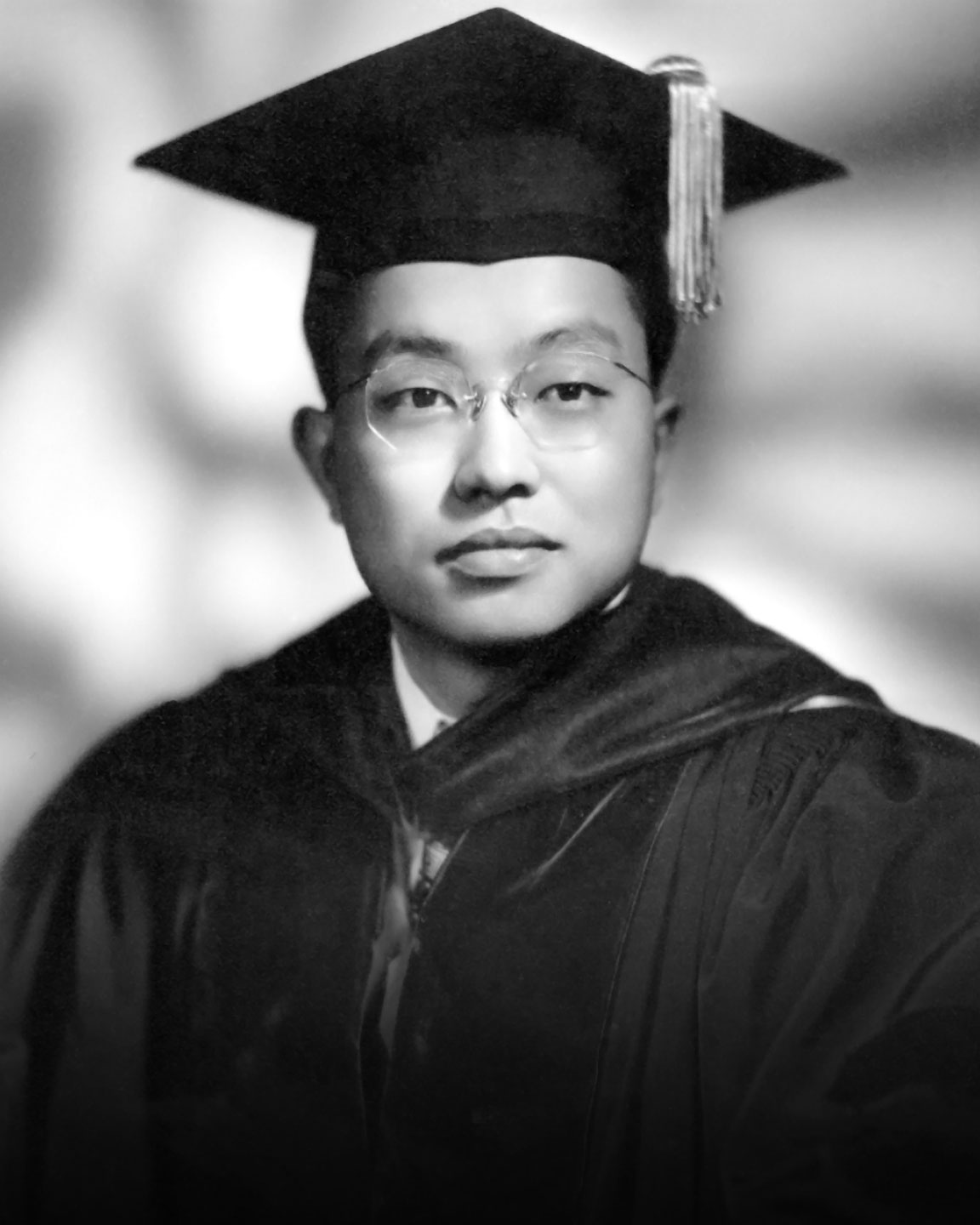 James M. Sugihara received the first Ph.D. ever awarded by the University of Utah
in 1947, working with Professor Henry Eyring. He was a faculty member until 1964 when
he accepted a professorship at North Dakota State University, where he served as Dean
of the College of Science and Mathematics. He was named Dean of the Graduate School
and Director of Research in 1974. In 1998, he was awarded an honorary doctorate at
NDSU and retired as Professor Emeritus.
James M. Sugihara received the first Ph.D. ever awarded by the University of Utah
in 1947, working with Professor Henry Eyring. He was a faculty member until 1964 when
he accepted a professorship at North Dakota State University, where he served as Dean
of the College of Science and Mathematics. He was named Dean of the Graduate School
and Director of Research in 1974. In 1998, he was awarded an honorary doctorate at
NDSU and retired as Professor Emeritus.
Former faculty members Josef Michl and Sara Allensworth Michl pledged a legacy gift to name a future Presidential Endowed Chair in Chemistry.
Michl began his independent career at the University of Utah in 1970 after obtaining his Ph.D. at the Czech Academy of Science in Prague and postdoctoral studies at the University of Houston, University of Texas-Austin, and the University of Utah (with Prof. Frank Harris in Physics). In 1986, he moved to UT-Austin and returned to the Rockies a few years later as a Professor of Chemistry and Biochemistry at the University of Colorado, Boulder.
Michl’s research is characterized as far-reaching and groundbreaking. Trained as a theoretical physical chemist, his most significant impact has been in experimental and theoretical physical organic and materials chemistry, helping to elucidate how chemical reactions occur and to predict new properties of reactive molecules and materials. His work has impacted the design of molecular electronics and solar energy conversion processes. The recipient of many awards, Josef is a member of the U.S. National Academy of Sciences and holder of the Heyrovsky Gold Medal from the Czech Academy of Sciences.
Kevin Teaford received the prestigious 2017 Helmut E. Dreschel Award from the American Scientific Glassblowing Society (ASGS). This is one of the society’s highest awards and is presented in recognition of a member's tireless efforts to promote the ASGS and the field of Scientific Glassblowing. With his position as Chair of the Allan Brown Workshop for the ASGS, it's easy to see why he was chosen for this honor. Aside from being an excellent glassblower, he's paramount in setting up torches, lathes, and other necessary equipment for the annual Allan Brown Workshop by the ASGS. This entails a lot of travel and hard work on Teaford's part, but when asked whether he would have ever expected to receive an award like this, he said, "I was just doing my job."
Teaford was also the 2015 recipient of the Arthur Dolenga Award, given by the Great Lakes Section of the ASGS, which recognizes outstanding administrative, technical, or fraternal contributions to scientific glassblowing. He is greatly valued by the ASGS but doesn't let his awards go to his head. According to Teaford, "I just look out for the success of the seminar and make sure everything stays safe."
On January 18, 2017, Distinguished Professor and Chair of the Department of Chemistry Cynthia Burrows was awarded a 2016 Governor’s Medal for Science and Technology.
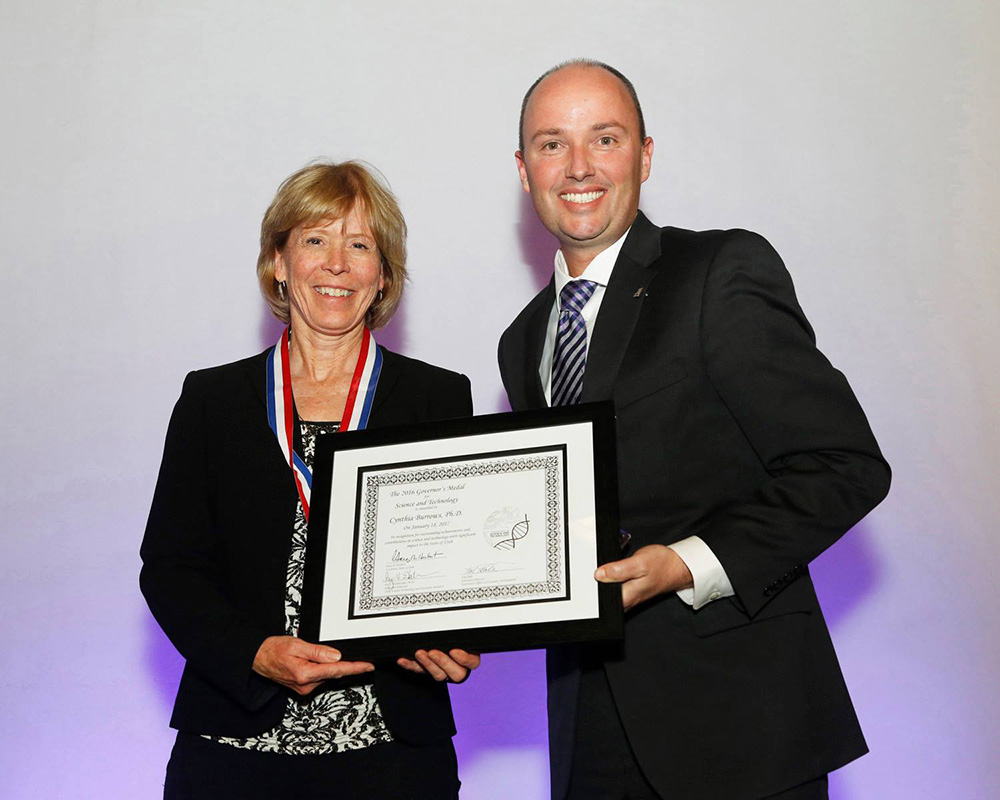
Matthew Sigman, Distinguished Professor & Peter J. Christine S. Stang Presidential Endowed Chair of Chemistry, was awarded the ACS Award for Creative Work in Synthetic Organic Chemistry "For his creative, seminal work in synthetic organic chemistry, especially his innovative contributions to the Wacker oxidation and Heck reaction."
Professor Ryan Steele was awarded the 2017-18 College of Science Award for Fostering Undergraduate Research Excellence, an award given in recognition of his outstanding contributions to undergraduate research. Steele recalled that when he arrived in Utah six years ago, there was a shortage of graduate students available to perform analysis in his group, so he decided to take a chance on a select handful of undergraduate students from his Quantum Chemistry course. "Suffice it to say that I was pleasantly surprised. The undergraduates at the University of Utah are phenomenally talented, and they constantly surprise me with their ability to be top-notch researchers. The award includes funding that will be put to use supporting undergraduate researchers, and Steele is excited to continue their contributions to the University's research program. "The proverbial punch line for this award is that the students deserve all of the credit. I have been lucky to have some students over the years (including my current ones!)."
Professor Charles Atwood was awarded the 2017-18 College of Science Award for Teaching Excellence. Atwood's dedication to the success of his students is remarkable and something he takes very seriously. "One of the things I'm proudest of here at Utah is that in the five to six years I've been here, we've managed to increase student success rates, especially for those students at the bottom. We have data that shows they are doing 22% better while at the same time making the course harder." Another luxury he's had over the years is seeing the successes of his previous students. "Occasionally, I'll hear from students or Google them and see all their cool jobs. Sometimes I don't think I have an effect, so seeing students doing well is nice."
Amanda Bischoff received the 2017 Outstanding Undergraduate Researcher Award from the College of Science and was honored at the Undergraduate Research Awards Luncheon on April 3, 2017. "I feel that this award reflects not only my abilities but on the dedication and guidance from my faculty mentor, Matt Sigman, as well as my lab members, whose advice and support have been essential in helping me achieve my research goals."
Graduate Teaching Assistant Jen Crawford has been awarded the NSF Graduate Research Fellowship. The Graduate Research Fellowship "recognizes and supports outstanding graduate students in NSF-supported science, technology, engineering, and mathematics disciplines who are pursuing research-based master's and doctoral degrees at accredited United States institutions."
Andrew Roberts joined the faculty in the fall of 2017. Roberts received his Ph.D. from the University of California in 2013 and was a postdoc at Memorial Sloan Kettering from 2013-2017.
Academic Advisor Natascha Knowlton was the recipient of the University of Utah 2017 UAAC New Outstanding Advisor Award and will represent the University of Utah in the National Academic Advising Association (NACADA) advising awards next year. Tascha, assisted by Whitney Hills, is responsible for advising our nearly 400 chemistry majors.
A team of researchers led by University of Utah chemical engineering and chemistry professor Marc Porter and U surgeon and professor Courtney Scaife developed a rapid, portable screening test for liver cancer (hepatocellular carcinoma) that doesn’t involve sending a specimen to a blood lab and cuts the wait time for results from two weeks to two minutes. This new and inexpensive test — the team is working to lower the cost to about $3 per test — can be administered wherever the patient is, which will be particularly valuable in developing nations with little access to hospitals.
The U’s team, which includes Nano Institute of Utah research associate Jennifer Granger, chemical engineering doctoral student Alex Skuratovsky, and U surgery assistant professor Jill E. Shea, published their research in the latest issue of Analytical Methods, describing how the test works for alpha-fetoprotein, a widely-used marker of liver cancer.“If we can develop a rapid test that performs at a high level of clinical accuracy,” Porter says, “then we’ve got something that can impact human lives.” Researchers also believe the test can be easily modified to detect infectious diseases such as tuberculosis, malaria, and dengue fever, a mosquito-borne tropical disease that can be life-threatening.
The test uses a small domino-sized plastic cartridge containing a paper membrane that selectively traps biomarkers (proteins specific to a particular disease) from biological fluids. A tiny droplet of blood, saliva, urine, or even a teardrop, from the patient, can be dropped onto the membrane. This is followed by a droplet of gold nanoparticles, which tags the biomarkers trapped in the membrane. If the biomarkers are present, a red spot appears, signaling that the patient has the disease and should seek more testing and possible treatment.
A handheld spectrometer manufactured by project collaborator B&W Tek, a Delaware-based manufacturer of mobile spectrometers, can analyze the membranes and measure how much of the biomarkers is present, which in the future could determine the severity of the disease or how a patient is responding to treatment.
The idea for the test is a spinoff of a similar test Porter developed eight years ago that astronauts on the International Space Station used to test the cleanliness of their drinking water. “This is a smarter offshoot of that,” says Porter.
Now that the team has proven the concept with liver cancer and built a prototype test kit, they plan to evaluate the technology in Mongolia in the spring of 2019. The East Asian country has the world’s highest rate of liver cancer.
The project was funded by grants from the National Institutes of Health, the National Cancer Institute through the Affordable Cancer Technologies Program, and the Huntsman Cancer Institute. The team also received funding from Utah-based nutritional supplement company USANA, which is interested in using a form of the test for customers with certain vitamin deficiencies.
Professor and Chair of the Department of Chemistry Cynthia Burrows was awarded the James Flack Norris Award in Physical Organic Chemistry for 2018.
Professor Rick Ernst, along with Benjamin Harvey, a research chemist at the Naval Air Warfare Center, China Lake, were invited to supply the cover for Volume 2017, Issue 9 of the European Journal for Inorganic Chemistry (EurJIC), which featured a major result of their research: the first-ever recognition of C–C agostic interactions with a transition metal center.
Professor Luisa Whittaker-Brooks was named a Scialog Fellow by the Research Corporation for Science Advancement for 2018. She was also awarded the Ovshinsky Sustainable Energy Fellowship, an award given by the American Physical Society in order to recognize and support promising exploratory research in the area of energy sustainability. Whittaker-Brooks also received one of the L'Oreal USA For Women in Science grants, which will support Young & WISE (Women in Science and Engineering), an outreach program started by the Whittaker-Brooks research group that mentors young female students at Kearns High School.
Professor Ryan Steele was awarded the 2017 PCCP Emerging Investigator Lectureship from Physical Chemistry Chemical Physics (PCCP). The lectureship was created in order to recognize and support an emerging scientist working in physical chemistry, chemical physics, or biophysical chemistry who is making an outstanding contribution to their field and is at an early stage of their career, and also acts as a platform to showcase their research to the wider scientific community.
Alumni News:
Steven and Sarah Snow both graduated with their Ph.D.s in 1985 under Bob Parry. Steven recently retired from Dow Corning Corporation after a 30-year career in Research and Development. He is now the Director of Research and Development at AB Specialty Silicones, a small chemical company in the Chicago area. Sarah has worked in Research and Development for Dow Corning, Caltech, and Clorox.
Joe Stewart graduated from the University of Utah Department of Chemistry with his MS in 1991. He is currently employed as a Research Engineer and Assistant Lab Manager at the Utah Water Research Laboratory at USU in Logan, Utah. His work involves method development for chromatography and also for mass spectrometric approaches to the analysis of anthropogenic compounds in the environment. He also assists students with the setup and maintenance of bench-scale experimental reactors. Some of his past roles have included Senior Project Engineer in the water management group at a copper mine, Process Development Chemist for the study of treatment methods of acid mine drainage, and owner of OnSite Analytical Services, a small environmental testing laboratory and consulting business.
Alan Eastman is a Ph.D. recipient since 1975 and has since co-founded his own company, GreenFire Energy, which is focused on geothermal energy. However, while most geothermal-to-electricity companies use water pumped down a well into a hot rock formation and then back up where it is flashed to steam and used to turn a turbine, GreenFire does things a little differently by using supercritical carbon dioxide (sCO2) instead, which has a couple of benefits. First, it eliminates the problem that arises with most of the accessible hot rock being in the West and most of the water being located in the East. Second, Hot sCO2 is much less dense than cold sCO2, so it is possible to set up a siphon in which the cool sCO2 descending to the hot rock formation drives the circulation of sCO2 through the entire fluid system, eliminating or greatly reducing the need for pumping. In early March, GreenFire received a $1.48 million grant from the California Energy Commission to fund their technology testing for which they will be using an existing well at the Coso geothermal site located on the US Navy's China Lake Naval Test Station. Not only do they expect to produce a small amount of power in that first test but to also obtain the financial and technical data necessary to build and sell full-scale commercial units. According to Alan, "Geothermal energy is a far cry from boron hydride chemistry, the subject of my thesis, or refinery catalysis, the area I worked in for many years, but perhaps it just illustrates the ability to be flexible that I learned in grad school working with Bob Parry at the U!"
Jessica Kramer graduated with her Bachelor of Science in 2004 and is very happy to be back home at the University of Utah, now as an assistant professor of bioengineering. She obtained her Ph.D. from UCLA and did post-doc work at UC Berkeley and Stanford. She started her lab in February, and her team is investigating the role of cell-surface glycoproteins in cancer, infection, absorption of pharmaceuticals and nutrients, and glycoproteins that protect cells from damage during freezing.
Jaqueline Kiplinger, Los Alamos National Laboratory Fellow, was presented with the International Union of Pure and Applied Chemistry (IUPAC) 2017 Distinguished Women in Chemistry or Chemical Engineering award on March 9, 2017, and out of all twelve recipients, was the only one from the U.S. She was recognized for her contributions to the organometallic chemistry of pentavalent uranium, the realization of a terminal nitride complex of uranium, and non-aqueous uranium and thorium precursors for use in subsequent inorganic and organometallic synthetic efforts. In an article published on the Los Alamos National Laboratory website, Alan Bishop, Principal Associate Director for Science, Technology and Engineering at Los Alamos stated, “The IUPAC Award recognizes Kiplinger’s outstanding scientific achievements. She is a pioneer in uranium and thorium chemistry, and her research has significantly expanded the broad understanding of actinide and lanthanide chemical bonding and reactivity... Her work provides scientific underpinning that supports the Laboratory’s national security mission as well as advancing the fundamental understanding of actinide chemistry.”
Dallen Cox graduated in 1977 with his BS in chemistry and has experienced a rewarding career. He enjoyed working as Concentrator Chief Chemist for the Kennecott Copper Corporation Assay Office until 1985, after which he became employed by the Tooele Army Depot, where he started their first Oil Analysis Program to test the operability of engines and transmission based on oil sample testing. By 1993 he had built the analytical facility into a fully operational environmental laboratory as the laboratory leader, in addition to maintaining oil analysis capabilities. After the Army Depot closed, Dallen began work with the Chemical Ammunition Destruction System (CAMDS), where he was the leader of a team of government scientists who completed the (5X) test, which was vital in sending metal for nerve gas storage containers to a landfill. While working for CAMDS, Dallen was also the Laboratory Director and was an integral part of creating a method for the neutralization of the deadly nerve gas VX.
Craig Metcalf graduated with a Bachelor of Science in Chemistry and proceeded to spend a couple of years doing biomedical research at the University of Utah. He took a change of direction after that, however, and decided to go to law school. He has spent most of his career as a patent attorney, a profession that requires both a law degree and a science or engineering degree. He is using his talents as a patent lawyer to continue working in the chemistry and biomedical industry and has drafted and prosecuted more than 1,000 U.S. patents, along with many foreign counterparts around the world. He has done patent work for Fortune 500 companies, smaller companies during all stages of development, and universities such as the U.
Sucharita Kundu graduated with her Ph.D. in 2009 and is currently working as Publications Manager for Editage, a division of Cactus Communications. Based out of India, Suchi helps authors all around the world with their publication requirements.
Alyssia Lambert earned her BS and MS from the University of Utah Chemistry Department in 2011 and 2014. In the fall of 2016, she accepted a position as a tenure-track faculty member at Pierce College in Puyallup, Washington.
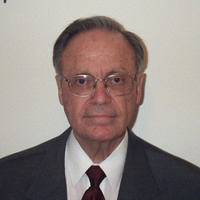 Carlos M. Bowman received his Ph.D. in Organic Chemistry from the University of Utah
in 1957. While working in rocket fuel research early on in his career at the Dow Chemical
Company, Bowman implemented the innovative use of computers in using thermodynamics
to predict substance thrust capabilities for use in rocket propellants. In 1967 he
became the Dow Chemical Company’s Research Director, where he continued to advance
the field of cheminformatics until 1980.
Carlos M. Bowman received his Ph.D. in Organic Chemistry from the University of Utah
in 1957. While working in rocket fuel research early on in his career at the Dow Chemical
Company, Bowman implemented the innovative use of computers in using thermodynamics
to predict substance thrust capabilities for use in rocket propellants. In 1967 he
became the Dow Chemical Company’s Research Director, where he continued to advance
the field of cheminformatics until 1980.
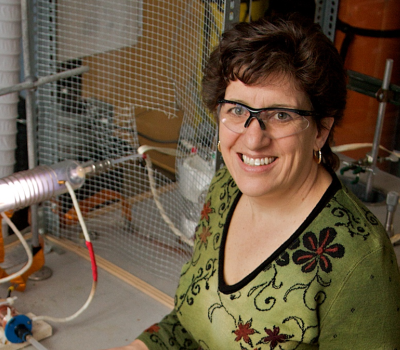 Ellen R. Fisher earned her Ph.D. in Physical Chemistry from the University of Utah
in 1991, after which she joined Colorado State University as a Professor of Chemistry.
From 2009 to 2014 she served as Department Chair for CSU’s Department of Chemistry,
and in 2014 she became Senior Faculty Advisor to the Vice President for Research.
Her research focuses on using analytical and materials chemistry methods to better
understand the underlying mechanisms of the processes of chemical vapor deposition
and plasma-enhanced chemical vapor deposition.
Ellen R. Fisher earned her Ph.D. in Physical Chemistry from the University of Utah
in 1991, after which she joined Colorado State University as a Professor of Chemistry.
From 2009 to 2014 she served as Department Chair for CSU’s Department of Chemistry,
and in 2014 she became Senior Faculty Advisor to the Vice President for Research.
Her research focuses on using analytical and materials chemistry methods to better
understand the underlying mechanisms of the processes of chemical vapor deposition
and plasma-enhanced chemical vapor deposition.
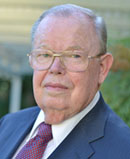 Bryant W. Rossiter earned his Ph.D. from the University of Utah in 1957 and currently
works as a consultant, author, and as senior editor of Physical Methods of Chemistry.
From 1957-1985 he was the Director of the Chemistry Division at Eastman Kodak Co.,
and from 1985-1989 he served as President of Viratek Pharmaceuticals, Inc. His ventures
resulted in several successful attempts at developing broad-spectrum antiviral drugs,
some of these treatments experiencing worldwide implementation.
Bryant W. Rossiter earned his Ph.D. from the University of Utah in 1957 and currently
works as a consultant, author, and as senior editor of Physical Methods of Chemistry.
From 1957-1985 he was the Director of the Chemistry Division at Eastman Kodak Co.,
and from 1985-1989 he served as President of Viratek Pharmaceuticals, Inc. His ventures
resulted in several successful attempts at developing broad-spectrum antiviral drugs,
some of these treatments experiencing worldwide implementation.
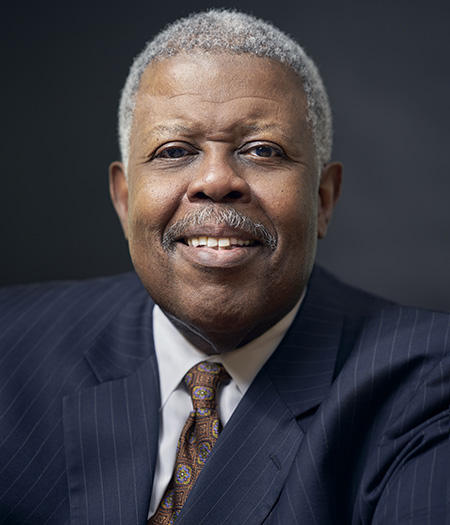 Clifton G. Sanders earned his Ph.D. from the University of Utah in 1990 and went on
to hold many positions in both research and education, including Research Scientist
for CardioPulmonics, Dean for the School of Science, Mathematics and Engineering for
Salt Lake Community College, and Adjunct Instructor for the Salt Lake Theological
Seminary. He is currently the Chief Technology Consultant and Co-Owner of Better Options
Consulting International and is the Provost for Academic Affairs at Salt Lake Community
College.
Clifton G. Sanders earned his Ph.D. from the University of Utah in 1990 and went on
to hold many positions in both research and education, including Research Scientist
for CardioPulmonics, Dean for the School of Science, Mathematics and Engineering for
Salt Lake Community College, and Adjunct Instructor for the Salt Lake Theological
Seminary. He is currently the Chief Technology Consultant and Co-Owner of Better Options
Consulting International and is the Provost for Academic Affairs at Salt Lake Community
College.
Honorary Distinguished Alumnus Edward M. Eyring received his Ph.D. in Physical Chemistry in 1960 and proceeded to become an NSF Postdoctoral Fellow with the University of Goettingen. He would then spend the next 50 years of his life as a dedicated faculty member of the University of Utah Department of Chemistry, where he contributed most recently to the nanoparticle and Chemical Looping Combustion research. He is the recipient of several awards, including the NATO Senior Fellowship in 1977, the Willard Gardner Prize of the Utah Academy of Sciences, Arts, and Letters in 1993, and the Utah Governor’s Medal for Science and Technology in 2011. He retired in 2016, after which the Edward M. Eyring Undergraduate Scholarship was established in his honor and in gratitude for his many years of service and contributions to chemistry.
Cindy Burrows was selected as the recipient of the 2018 Willard Gibbs Medal of the Chicago Section of the American Chemical Society. This is one of the most prestigious honors in chemistry. Its purpose is “To publicly recognize eminent chemists who, through years of application and devotion, have brought to the world developments that enable everyone to live more comfortably and to understand this world better." This award has been given since 1911, and only one previous Utah chemist (Henry Eyring, 1968) has received it.
A photo taken by Ryan Steele was chosen as the cover art for the Journal of Chemical Education in January 2018. The photo showcases liquid oxygen gathered during a simple and inexpensive process developed by Jeff Statler, which uses a magnetic field to extract pure liquid oxygen through condensation; his demonstration was published in the same issue.
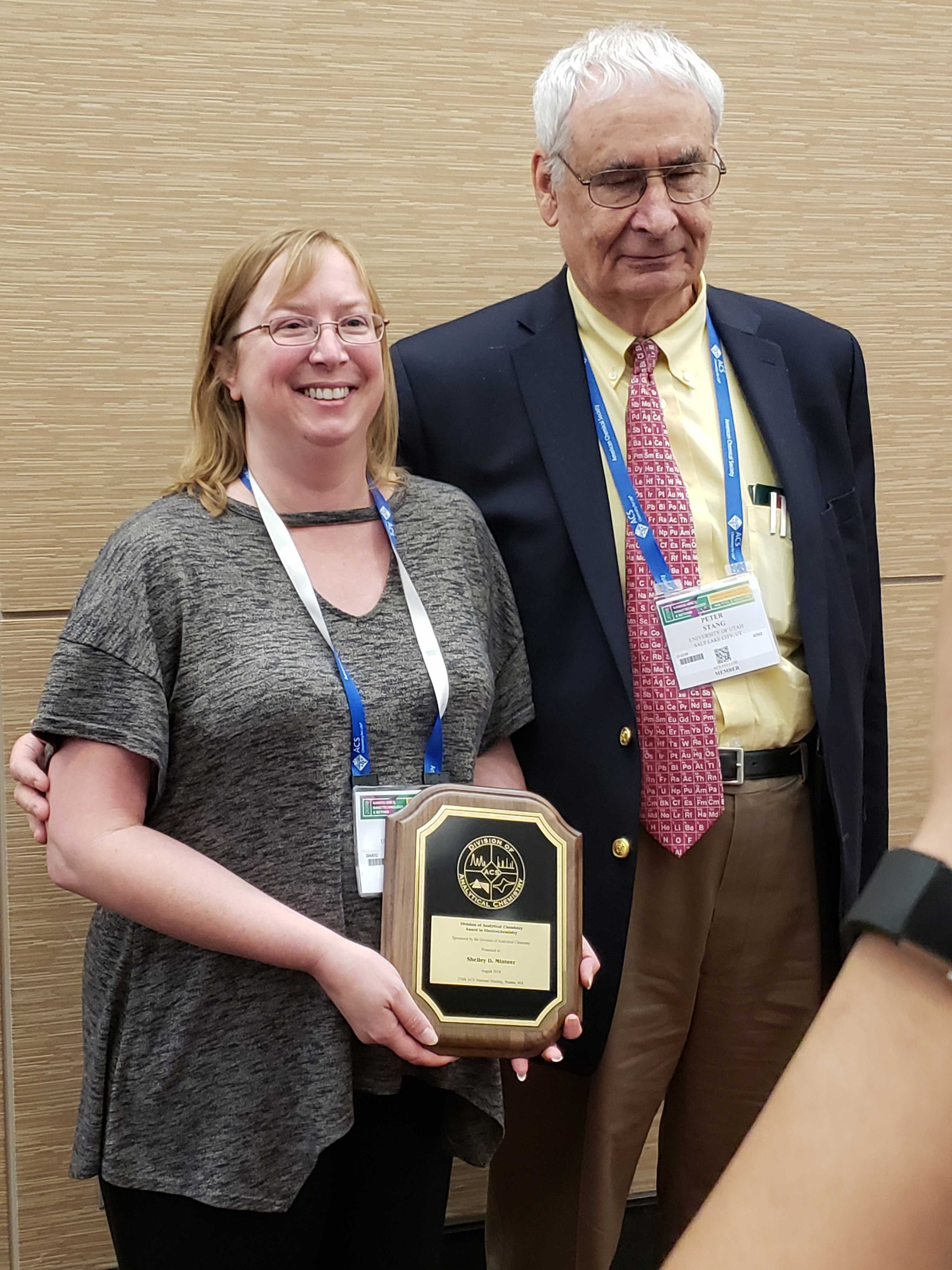 Luisa Whittaker-Brooks was named one of 2018's Cottrell Scholars, an award given by
the Research Corporation for Scientific Advancement to 24 early-career academic scientists
in the areas of chemistry, physics, and astronomy. The program is designed to foster
synergy among faculty at major American research universities and undergraduate institutions.
Luisa Whittaker-Brooks was named one of 2018's Cottrell Scholars, an award given by
the Research Corporation for Scientific Advancement to 24 early-career academic scientists
in the areas of chemistry, physics, and astronomy. The program is designed to foster
synergy among faculty at major American research universities and undergraduate institutions.
Shelley Minteer was awarded the 2018 ACS Division of Analytical Chemistry Award in Electrochemistry. She is the third professor from the University of Utah Department of Chemistry to receive this award, with Henry White receiving it in 2004 and Debra Rolison in 2014.
Peter Armentrout was awarded the 2018 Ron Hites Award, given by the American Society of Mass Spectrometry, for his contribution, “How Hot Are Your Ions Really? A Threshold Collision-Induced Dissociation Study of Substituted Benzylpyridinium “Thermometer” Ions.”
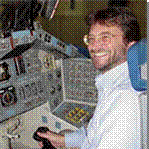 Marc Porter was awarded the University of Utah Distinguished Scholarly and Creative
Research Award for 2018 in recognition of his important contributions to research
and scholarship in the field of analytical chemistry and biosensors.
Marc Porter was awarded the University of Utah Distinguished Scholarly and Creative
Research Award for 2018 in recognition of his important contributions to research
and scholarship in the field of analytical chemistry and biosensors.
The Career and Professional Development Center at the University of Utah recognized Peter Flynn as an outstanding faculty member as part of their Faculty Recognition Program. The program celebrates student-nominated faculty who have done an exceptional job of mentoring students and facilitating their professional growth.
Ming Hammond joined the faculty in July 2018. She earned her Ph.D. from the University of California, Berkeley in 2005 and was a Burroughs Wellcome Fund Postdoctoral Fellow at Yale University from 2005-2009. She started her independent career at Berkeley as an assistant professor in the Chemistry and Molecular & Cell Biology departments. While at Berkeley, she built a strong research program that was recognized by the NIH Director’s New Innovator Award, the Women in Science Award from the Chau Hoi Shuen Foundation, and one of her discovery papers published in the Proceedings of the National Academy of Science was selected as a ‘2015 Signaling Breakthrough of the Year by Science Signaling.
Charles (Butch) Atwood retired in 2018. During 7 years at the University of Utah, Butch taught thousands of students from freshmen to seniors in general chemistry and in radiochemistry, mentored graduate students in chemical education, and impacted hundreds of high school students and teachers per year through summer outreach and academic-year AP laboratory courses. Atwood retired from his position as Professor of Chemistry at the U and as the inaugural holder of the Ronald and Eileen Ragsdale Chair in Chemical Education. When he joined the U, moving from the University of Georgia in 2011, he transformed the general chemistry laboratory and lecture courses into more efficient and more effective learning experiences, increasing the success rate of students from highly diverse high school backgrounds. He also hosted weekend sessions for a cadre of high school teachers who have benefitted as a cohort working to improve chemical literacy and STEM teaching techniques in the Salt Lake Valley. His research in item-response theory helped us understand how students learn. All of these contributions aligned perfectly with the University’s overall mission and present goals of increasing student success and improving the undergraduate experience.
On March 1, 2018, the Department of Chemistry hosted the inaugural Edward M. Eyring Lecture by Martin Gruebele, University of Illinois at Urbana Champaign. Gruebele is the James R. Eiszner Professor of Chemistry, Professor of Physics, Professor of Biophysics and Computational Biology, and Professor in the Center for Advanced Study. He is a Fellow of the American Academy of Arts and Sciences, the ACS, APS, and Biophysical Society, and a member of the German and the U.S. National Academies of Sciences. His research includes protein and RNA folding, fast dynamics in live cells, vibrational energy flow in molecules, quantum computing and quantum control, optically assisted STM, glass dynamics, and vertebrate swimming behavior. His talk was titled "Simple dynamics of complex chemical systems: from nanoparticles to proteins in the cell"
The prestigious Barry Goldwater Scholarship for the 2018-2019 academic year was awarded to two students in the state of Utah, both of whom are chemistry majors at the U!
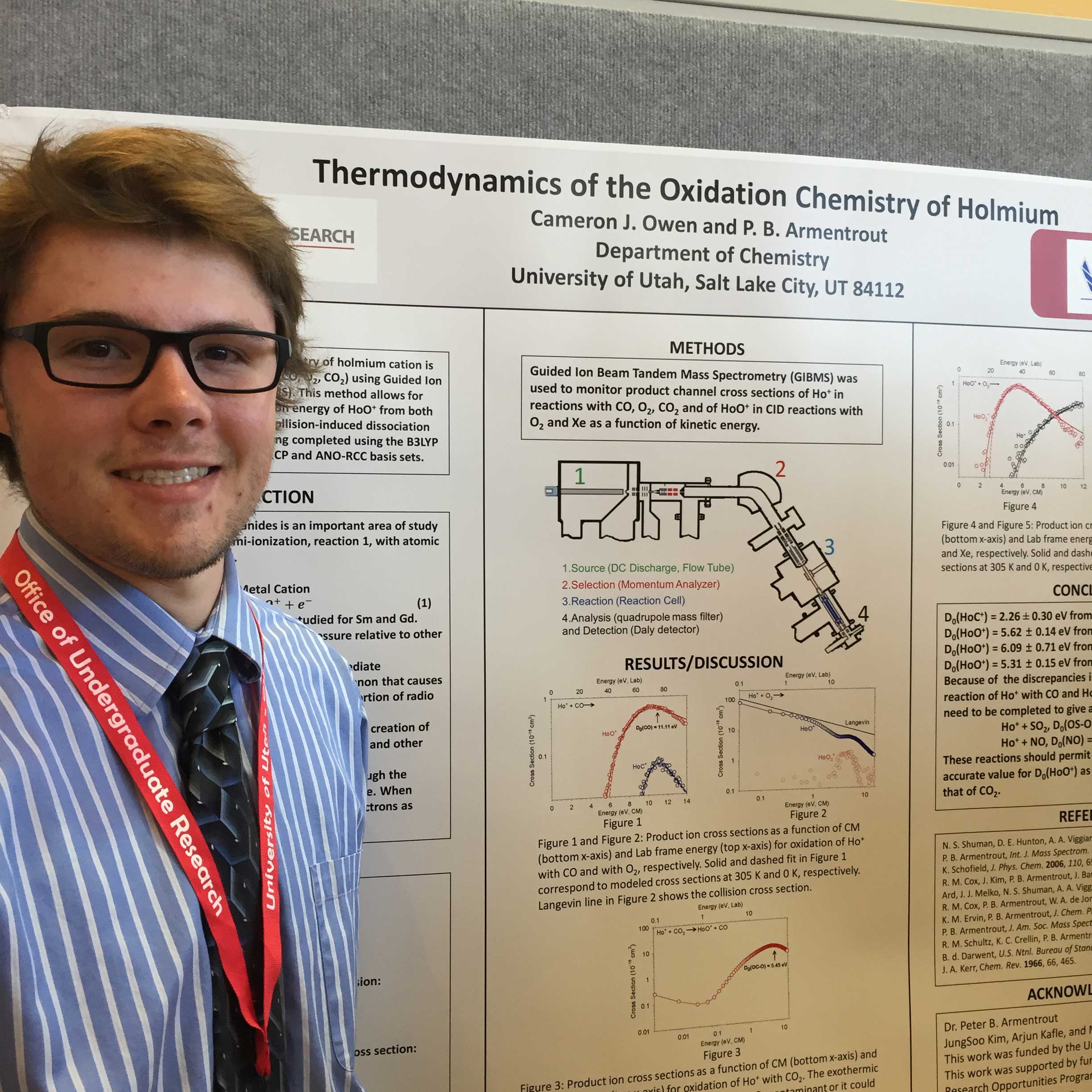 |
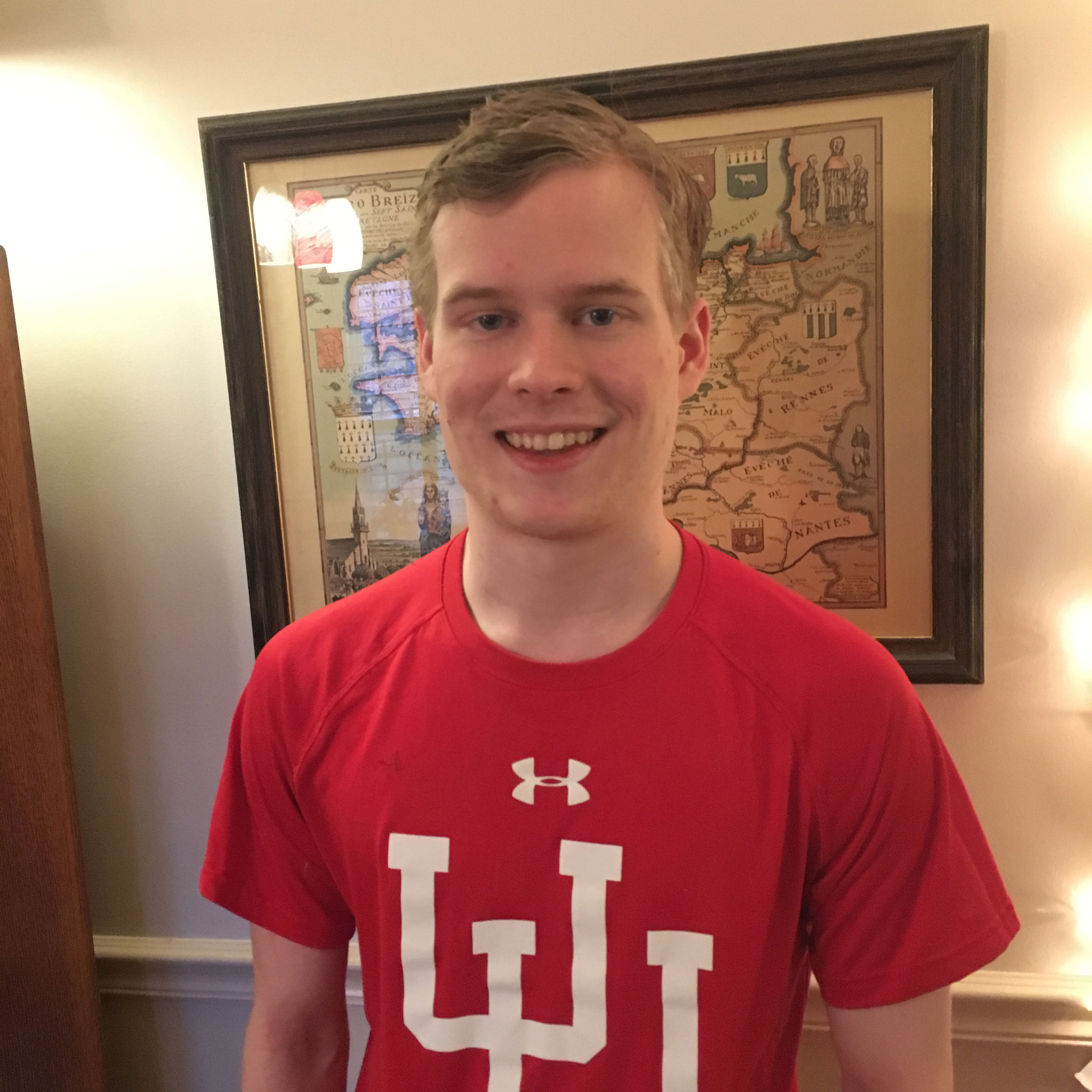 |
||
| Cameron Owen | Philippe David |
Philippe David is currently doing undergraduate research in the Grunwald group and plans to pursue a Ph.D. in theoretical chemistry and develop new models and simulation methods to study nanomaterials. He plans to become a professor at a research university.
Cameron Owen's undergraduate research with Peter Armentrout has already resulted in several publications, and he hopes to study the chemical properties of materials in the search of new catalytic devices. He plans to earn a Ph.D. in analytical and physical chemistry.
Matthew Sigman, Peter J. & Christine S. Stang Presidential Endowed Chair of Chemistry, received a Humboldt Research Award from the Humboldt Foundation based in Berlin, granted in recognition of academics whose fundamental discoveries, new theories, or insights have had a significant impact on their own discipline and who are expected to continue producing cutting-edge achievements in the future. In addition to the award, winners were invited to carry out research projects of their own choice in cooperation with specialist colleagues in Germany.
Janis Louie, Professor of the Department of Chemistry, received the 2018-19 College of Science Award for Teaching Excellence. The CoS Award for Teaching Excellence recognizes extraordinary skill in university teaching with an emphasis on outstanding accomplishments and commitments to science and/or math education.
The U.S. Department of Energy announced Luisa Whittaker-Brooks as one of 84 recipients of the U. S. Department of Energy Early Career Research Program award. The award will assist Whittaker-Brooks in investigating the properties of two-dimensional hybrid organic-inorganic materials for their use as detectors of low-energy infrared photons. Luisa was also named one of C&EN's Talented 12 young scholars during the Fall 2018 ACS national meeting in Boston, giving a TED talk that morning and participating in an award celebration later in the afternoon. Whittaker-Brooks, aptly named a "sustainability powerhouse" by C&EN, earned her spot among 11 other bright chemists for her research in finding alternative ways to provide power.
President Watkins authorized the appointment of Valeria Molinero as the first Jack and Peg Simons Endowed Professor of Theoretical Chemistry. The appointment began on July 1, 2018 and was established with a generous gift from Jack and Peg Simons in recognition of Jack’s outstanding contributions to theoretical chemistry. Annual donations will accelerate this endowment to the level of an endowed chair within the next several years.
On August 21, 2018, Shelley Minteer was awarded the 2018 ACS Division of Analytical Chemistry Award in Electrochemistry, which was given at the ACS meeting in Boston. She is one of six awardees for the division and is the third professor from the University of Utah Department of Chemistry to receive this award, following Henry White and Debra Rolison. Shelley was also named the next David Grahame Awardee in Physical Electrochemistry, a significant award given by the Electrochemistry Society in memory of an iconic figure in the field. The award will be presented in May 2019 in Dallas with a symposium and reception.
Professors Peter Armentrout and Scott Anderson were appointed by President Watkins as holders of Henry Eyring Presidential Endowed Chairs in Chemistry.
The inaugural symposium for the Dale & Susan Poulter Endowed Lectureship in Biological Chemistry took place on October 4, 2018, bringing together notable chemists for a day of lectures on cutting-edge research. The speakers consisted of: John Kozarich, ActivX Biosciences, Inc., “Reflections of an Enzyme Mechanic”; Jackie Winter, University of Utah, “Developing Heterologous Expression Platforms for Elucidating Fungal Natural Product Biosynthesis.”; Jeffrey Rudolph, University of Florida, “Biosynthesis of the Antibiotics Platensimycin and Platencin”; John Gerlt, University of Illinois, “Discovery of Novel Enzymes in Novel Pathways”.
Alumni News:
David Hamilton, Sr. graduated from the department in 2011 and then went on to medical school at the University of Utah. He has been working as a resident physician at Loma Linda University in California. In July 2018, he will start work and further training as a cardiology fellow physician at the University of Arizona in Tucson.
Jonathan (J.D.) Herr defended in December 2016, officially graduating in May 2017, working under Dr. Ryan Steele while pursuing a Ph.D. in theoretical and computational chemistry. He landed a full-time position at Enterra Solutions in Newtown, Pennsylvania as a data scientist on February 1st, 2018. Before obtaining this position, he worked as a contract data scientist consultant and a boxing instructor while job searching.
Ray Hoff was awarded a Ph.D. in 1964 in Organic Chemistry from the University of Utah with James Sugihara as his advisor. He is the editor of Handbook of Transition Metal Polymerization Catalysts, 2nd Edition, and was co-editor for the 1st edition. Ray has had a meaningful 27-year career in research of transition metal polymerization catalysis.
Chad Knutson earned his Ph.D. in 2003 and after working as a senior scientist and scientific advisor now manages an auto body shop. Chad worked with Gary Keck and remembers with fondness how he was always enthusiastic about helping his students use their chemistry skills to get into multiple and diverse fields and careers, a quality Chad greatly admires and respects.
Dr. Ray Price Graduated from the University of Utah Magna Cum Laude in 1983. After graduating from Harvard Medical School and completing a surgical residency at the Brigham and Women’s Hospital in Boston, he returned to Salt Lake City at the Salt Lake Clinic and Intermountain Healthcare. From 1993 until the present, Dr. Price co-directed or directed the graduate surgical education program at LDS Hospital and Intermountain Medical Center for hundreds of surgical residents and medical and physician assistant students.
Dr. Price is a Clinical Professor in the Department of Surgery and an Adjunct Associate Professor in the Department of Family and Preventive Medicine, Division of Public Health. He co-organized the country’s first course on Global Surgery and Public Health, which led to his co-authoring the seminal book, “Global Surgery and Public Health: a New Paradigm”, that is now being used in many universities worldwide. Dr. Price helped co-found the University of Utah’s Center for Global Surgery, the first academic Center for Global Surgery in the United States, guiding research and education programs worldwide. He is the author of numerous peer-reviewed articles, book chapters, and books.
He served and currently serves in many leadership positions on many national and international committees, including the World Health Organization Global Initiative for Emergency and Essential Surgical Care, the Society of American and Gastrointestinal and Endoscopic Surgeons (SAGES), the American College of Surgeons, the International Surgical Society (ISS), and as an advisor to the Lancet Commission on Global Surgery. He is the recipient of many honors and awards.
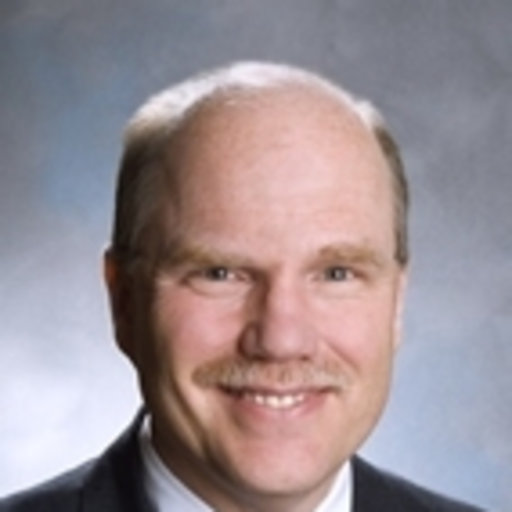 Joseph Madsen received his undergraduate degree from the University of Utah in 1976.
He then went on to earn an MD from Harvard Medical School in 1981. Between 1981 and
1983, he completed an internship followed by a research fellowship with Beth Israel
Deaconess Medical Center in Boston, then completed his residency in 1989 with Massachusetts
General Hospital. He has certifications with the American Board of Neurological Surgery
and the American Board of Psychiatry and Neurology in Child Neurology. He has developed
new techniques for monitoring shunt flow in patients with hydrocephalus, as well as
predicting seizures using intracranial data gathered from implanted electrodes. Aside
from practicing pediatric neurosurgery at Boston Children’s Hospital, Madsen is an
adjunct professor in functional neurosurgery at Xanwu Hospital, associated with Capital
Medical University, Beijing Institute of Functional Neurosurgery. He hopes to improve
pediatric neurosurgery and epilepsy surgery abroad, especially in China, and has been
working on a mechanism to review surgical cases in real-time with colleagues at Beijing’s
Children’s Hospital.
Joseph Madsen received his undergraduate degree from the University of Utah in 1976.
He then went on to earn an MD from Harvard Medical School in 1981. Between 1981 and
1983, he completed an internship followed by a research fellowship with Beth Israel
Deaconess Medical Center in Boston, then completed his residency in 1989 with Massachusetts
General Hospital. He has certifications with the American Board of Neurological Surgery
and the American Board of Psychiatry and Neurology in Child Neurology. He has developed
new techniques for monitoring shunt flow in patients with hydrocephalus, as well as
predicting seizures using intracranial data gathered from implanted electrodes. Aside
from practicing pediatric neurosurgery at Boston Children’s Hospital, Madsen is an
adjunct professor in functional neurosurgery at Xanwu Hospital, associated with Capital
Medical University, Beijing Institute of Functional Neurosurgery. He hopes to improve
pediatric neurosurgery and epilepsy surgery abroad, especially in China, and has been
working on a mechanism to review surgical cases in real-time with colleagues at Beijing’s
Children’s Hospital.
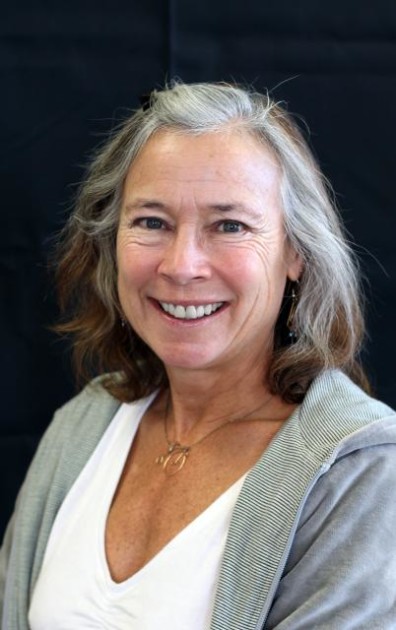 Jeanne McHale earned a BS in Chemistry from Wright State University in 1975. She then
attended the University of Utah for her Ph.D., which she received in 1979 with Jack
Simons, followed by postdoctoral research with Jim Wang. Jeanne was a member of the
chemistry faculty at the University of Idaho from 1980 until 2004, which is when she
joined the chemistry faculty at Washington State University, where she is currently
a Professor Emerita. She is a fellow in the American Association for the Advancement
of Science and the author of Molecular Spectroscopy (Prentice-Hall, 1999). She also
edited the Handbook of Luminescent Semiconductor Materials (Taylor & Francis, 2011)
with co-editor Leah Bergman. The McHale lab specializes in the use of resonance Raman
and photoluminescence spectroscopy for the study of molecules and nanomaterials with
interesting optical and electronic properties. Fundamental quantum mechanical aspects
of electron transfer in solution and in interfacial systems are a major focus of their
experiments. McHale’s group pioneered the use of resonance Raman spectroscopy to study
solvent dynamics in electron-transfer reactions.
Jeanne McHale earned a BS in Chemistry from Wright State University in 1975. She then
attended the University of Utah for her Ph.D., which she received in 1979 with Jack
Simons, followed by postdoctoral research with Jim Wang. Jeanne was a member of the
chemistry faculty at the University of Idaho from 1980 until 2004, which is when she
joined the chemistry faculty at Washington State University, where she is currently
a Professor Emerita. She is a fellow in the American Association for the Advancement
of Science and the author of Molecular Spectroscopy (Prentice-Hall, 1999). She also
edited the Handbook of Luminescent Semiconductor Materials (Taylor & Francis, 2011)
with co-editor Leah Bergman. The McHale lab specializes in the use of resonance Raman
and photoluminescence spectroscopy for the study of molecules and nanomaterials with
interesting optical and electronic properties. Fundamental quantum mechanical aspects
of electron transfer in solution and in interfacial systems are a major focus of their
experiments. McHale’s group pioneered the use of resonance Raman spectroscopy to study
solvent dynamics in electron-transfer reactions.
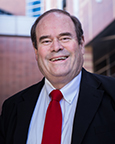 Craig Thatcher earned a BA in Chemistry from the University of Utah in 1974, a natural
course for him since his grandfather was a chemistry teacher and founder of Wasatch
Chemical Company, and his father was a chemical engineer and founder of Thatcher Chemical
Company. After receiving his undergraduate degree, Thatcher attended graduate school
at Northwestern University, where he earned an MBA in Marketing in 1976. He and his
wife Connie spent their first year of marriage in Centerville, Utah, where he began
his full-time career at Thatcher Chemical Company, a company to which he still dedicates
his time and energy as president. The Thatcher Chemical Company has grown from humble
beginnings with two employees and no facilities to a company of over 500 employees
in 11 U.S. locations with customers throughout the world. The company is currently
debt-free and has experienced rapid growth in recent years. Craig Thatcher is always
looking to improve himself and assist in helping others and is actively involved in
community service and charity work, as well as endeavors to build the Thatcher Chemical
Company in an effort to achieve these goals.
Craig Thatcher earned a BA in Chemistry from the University of Utah in 1974, a natural
course for him since his grandfather was a chemistry teacher and founder of Wasatch
Chemical Company, and his father was a chemical engineer and founder of Thatcher Chemical
Company. After receiving his undergraduate degree, Thatcher attended graduate school
at Northwestern University, where he earned an MBA in Marketing in 1976. He and his
wife Connie spent their first year of marriage in Centerville, Utah, where he began
his full-time career at Thatcher Chemical Company, a company to which he still dedicates
his time and energy as president. The Thatcher Chemical Company has grown from humble
beginnings with two employees and no facilities to a company of over 500 employees
in 11 U.S. locations with customers throughout the world. The company is currently
debt-free and has experienced rapid growth in recent years. Craig Thatcher is always
looking to improve himself and assist in helping others and is actively involved in
community service and charity work, as well as endeavors to build the Thatcher Chemical
Company in an effort to achieve these goals.
Aaron Puri joined the faculty in January 2019. He completed his B.S. at the University of Chicago, his Ph.D. at Stanford University School of Medicine, and his post-doctoral research at the University of Washington in Seattle, where he was co-mentored by Mary Lidstrom and Pete Greenberg and worked on genetic tools and chemical signaling in methane-oxidizing bacteria as part of an NIH K99 Pathway to Independence Award.
2019 Faculty Awards:
Ryan Steele: Robert W. Parry Teaching Award.
Marc Porter: Entrepreneur Honoree for Technologies for Diagnosing Infectious Disease & Cancer
Joel Harris: University of Utah Hatch Prize for Teaching
Shelley Minteer: ECS David C. Grahame Award & Fellow of the American Association for the Advancement of Science
Holly Sebahar: College of Science Award for Teaching Excellence
Luisa Whittaker-Brooks: DOE Early Career Award, ACS Talented 12, 2018 Emerging Investigator Award, Journal of Materials Chemistry, 2019 Scialog Collaborative Innovation Award, Research Corporation for Science Advancement
Valeria Molinero: the University of Utah Distinguished Scholarly & Creative Research Award
Michael Grünwald: NSF Early Career Award
Rodrigo Noriega: Daniels Fund Award for Leadership in Ethics Education by the David Eccles School of Business
Michael Morse: OSA William F. Meggers Award
Valentine’s Day 2019 turned out to be a memorable day for Professor Joel Harris. Not only did he hear the news that he had received the Hatch Teaching Prize (the University’s most prestigious teaching award), but he was also surprised by a visit from a former student, Michael Hunnicutt, and his wife Sally. At the conclusion of Joel’s Distinguished Faculty Colloquium lecture, Dr. Hunnicutt announced that he and Sally would be establishing an endowment to support graduate students in the analytical chemistry program in honor of Joel’s extensive influence on many people’s lives and careers.
This generous gesture is evidence of the strong connections built and fostered through the Department of Chemistry as well as Joel’s legacy as the founder of the Analytical Chemistry Program at the University of Utah over forty years ago.
Throughout four decades, his dedication to teaching and mentorship has contributed to the success of more than 2,500 students who have learned from him in the classroom and over 100 undergraduate and graduate students, postdoctoral associates, and collaborators who have done research in his lab.
President Watkins appointed Henry S. White as the holder of the John A. Widtsoe Presidential Endowed Chair in Chemistry, effective July 1, 2019. This chair was recently held by our now emeritus colleague Dale Poulter. Henry has had an extraordinary career here for the past 25+ years. He essentially invented the area of nano-electrochemistry with groundbreaking work in ultramicro-electrodes, electroactive films, glass nanopores, and nanobubbles. A hallmark of his work is a “deep conceptual understanding coupled with exquisite experimental design,” according to outside experts in his field. Henry will soon complete 11 years of service to the Department and College as chair and dean, a time during which enormous growth in facilities has taken place as well as very strong growth in the quality of research and education.
Matt Sigman succeeded Cindy Burrows as Chair of the Department on July 1, 2019. During her tenure as Chair, Cindy hired X new faculty and established X endowed positions. Three of those endowed positions were established in the last year of her term: Valeria Molinero as the inaugural Jack and Peg Simons Endowed Professorship in Theoretical Chemistry; Ryan Looper as the inaugural Jon M. Huntsman Presidential Chair in Chemistry; Shelley Minteer as the inaugural Dale and Susan Poulter Endowed Chair in Biological Chemistry.
Endowed Chairs:
Scott Anderson currently holds the Henry Eyring Presidential Endowed Chair and is the recipient of many other significant awards during his time here at the Department of Chemistry since 1983, including the ACS Physical Division Award in Experimental Physical Chemistry, the Robert W. Parry Teaching Award, and the Distinguished Scholarly and Creative Research Award. Dr. Anderson’s research includes four main areas of activity in nanoparticle surface chemistry with distinct research foci ranging from single nanoparticles isolated in the gas phase to size-selected catalysts and electrocatalysts to methods for the production and characterization of surface-functionalized high-energy density nanoparticles for propellant applications.
Peter Armentrout is the Henry Eyring Presidential Endowed Chair of Chemistry. He began his career as a professor at the University of California at Berkeley, where he earned many awards before coming to the chemistry department at the University of Utah. He received the Governor's Medal for Science and Technology Award from the State of Utah in 2010 and the Rosenblatt Prize for Excellence from the University of Utah in 2011. In 2011, his teaching was recognized by the Robert W. Parry Teaching Award. Dr. Armentrout is also a member of the editorial advisory board of the International Journal of Mass Spectrometry. His research group provides a detailed understanding of thermochemistry, kinetics, and dynamics of simple and complex chemical reactions. The Armentrout Group seeks to understand reactions involved in biological chemistry, hydration, catalysis, organometallic chemistry, plasma chemistry, and heavy element chemistry. Techniques involved include mass spectrometry, ion beams, molecular
Cindy Burrows has held the Thatcher Presidential Endowed Chair of Biological Chemistry since 2013 and is a member of the U’s Huntsman Cancer Institute. Her research investigates how DNA and RNA molecules are chemically altered by oxidation processes and how those alterations can lead to physiological consequences such as cancer. Her work has implications suggesting that DNA alteration via oxidation may be related to epigenetics, or alterations of gene expression, that may have shaped the course of life on Earth. Dr. Burrows is not only a prolific researcher and publisher, but she has also won teaching awards. Her passion for and dedication to excellent chemistry as a force to change the world for the better have significantly advanced the Department of Chemistry as a leading research institute.
Ryan Looper was awarded the Jon M. Huntsman Presidential Chair just this past summer as one of the newest faculty members to be awarded for excellent research, clinical care, and career progression. His research program focuses on the behavior of small molecules within biological systems, with the aim to develop compounds that can affect cell signals. These signals, in turn, play roles in diseases including arthritis, multiple sclerosis, and cancer. Looper and his lab are looking to understand the effects of these small molecules in order to expand and improve researchers’ biochemical toolbox. In addition, Dr. Looper is also working to develop new classes of antibiotics, desperately needed in our fight against multi-drug resistant infections, and learning more about how molecules bind to bacterial RNA in the process.
Shelley Minteer was recently awarded the Dale and Susan Poulter Chair of Biological Chemistry. Minteer’s career has focused on using nature as an inspiration and solution to chemistry problems. Her work has resulted in 17 issued patents and over 300 peer-reviewed publications in using biology as inspiration for biosensing, energy storage, energy conversion, and electrosynthesis. Dr. Minteer’s research will directly impact how we are able to store wind and solar energy. The Minteer Group researches bioelectrocatalysis, the biological catalysis of electrochemical processes, and is trying to mimic highly efficient processes in nature. They continue to further understand how living organisms consume food and do energy conversion to carry out daily activities. Recently, her research group developed a biofuel cell that employs mitochondria as the anode catalyst which is responsible for oxidizing fuel.
Valeria Molinero is the Jack and Peg Simons Endowed Professor of Theoretical Chemistry. Molinero’s research has pulled back the curtain on the freezing process, particularly in clouds. The Molinero Group has shown that when water droplets freeze in clouds, the structure of the ice crystal isn’t necessarily the classic hexagonal snowake structure. Rather, a more disordered ice structure forms more easily than hexagonal ice under certain cloud conditions, allowing the water droplets within clouds to turn to ice more rapidly than previously predicted. This study was published in Nature and reconciles theoretical models of clouds with observations of freezing rates. Throughout her career, Dr. Molinero has received awards for her research and teaching, such as the Extraordinary Faculty Achievement Award, the Camille Dreyfus Teacher-Scholar Award, and the College of Science Myriad Faculty Award for Research Excellence.
Matt Sigman has held the Peter J. Christine S. Stang Presidential Endowed Chair of Chemistry since 2012. His research group focuses on the discovery of new, practical catalytic reactions with broad substrate scope, excellent chemoselectivity, and high stereoselectivity to access novel, medicinally relevant architectures. They are currently engaged in several collaborative projects to evaluate their compound collections for various cancer types at the Huntsman Cancer Institute. Recently, in a new Nature publication, Dr. Sigman and a postdoc from his group, Jolene Reid, show how analyzing previously published chemical reaction data can predict how hypothetical reactions may proceed, narrowing the range of conditions chemists need to explore. Their algorithmic prediction process, which includes aspects of machine learning, can save valuable time and resources in chemical research.
Henry White learned that he received the Widtsoe Presidential Endowed Chair in Chemistry on the same day that he stepped down after eleven years of service, first as the Department Chair, then as the Dean of the College of Science, Back to teaching and research, Dr. White continues to pioneer groundbreaking work in nano-electrochemistry, ultramicro-electrodes, electroactive films, glass nanopores, and nanobubbles. Among many honors, he was the inaugural recipient of the Allen J. Bard Award in Electrochemistry and a winner of the Governor’s Medal for Science and Technology. He is a member of the American Academy of Arts and Sciences, a fellow of the AAAS and of the ACS, and he served as an Associate Editor for JACS for more than a decade.
Alumni News:
Tanner Coleman, Ph.D., OMS IV was accepted to Rocky Vista University School of Osteopathic Medicine in July 2015. Upon acceptance, he was granted the HPSP scholarship with the US Army. He will graduate from medical school this May and will do his residency training at Tripler Army Medical Center in Honolulu, HI in the field of radiology in June.
Lawrence Nathan, Ph.D. is enjoying 16 years of retirement in El Dorado Hills, CA. He taught chemistry at Santa Clara University from 1970-2003. He has enjoyed a bit of travel, lots of golf, and some free tutoring from high school chemistry teachers.
Joe Perry: JJ Perry (nom de plume), BA, MD graduated with a BA in Chemistry in 1972, the year he entered medical school at the U of U. He worked in biochemistry before and after graduation until medical school was too demanding. He practiced cardiology in Salt Lake City until 2003, at which time he began a second career in writing novels while practicing much less in neighboring states. In REAP 23, he used his chemistry and physics background heavily in this science fiction epic. In his novel to be published in 2020, Malady of Man, there is also a great deal of science, mostly biology, and anthropology. Dr. Perry says his education at the U provided a solid foundation for both practicing medicine and writing, as most of his novels revolve around either medicine or science.
Adam Curfew, BS was named Co-Chief Operating Officer for the Wasatch and Squatters Brewery in 2018. He has worked at the brewery for the past 19 years, as brewing was the sole reason he decided to pursue a chemistry degree. Once he received his degree, he was quickly promoted to Director of Production. He held that position for three years until he was made Co-C.O.O. in May 2018.
Robert J. Hargrove, Ph.D. was Peter Stang’s first student. When he arrived to work with Professor Stang, his first task was to unpack boxes and help set up the lab. After graduating from the University of Utah, Bob was persistent in his drive to find a position at a small college as a professor. He sent out about 1,100 application letters before he received his Ph.D. at the U. He started out with a visiting position at Dickinson College in 1974, teaching organic chemistry to undergraduates. The following year, he started a tenure track at Mercer, where he is to this day. Bob continues to encourage students to pursue career goals, even if they seem impossible. There is always a way. He wishes all the graduates “fair winds and following seas.”
Alyssia Lambert Snow, Ph.D. was recently granted tenure teaching chemistry at Pierce College in Washington state.
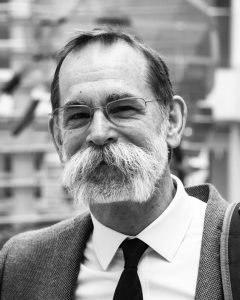 Kurt Zilm completed his Ph.D. in Chemistry at the University of Utah in 1981. Now
Chair of the Department of Chemistry at Yale, Zilm's research involves development
of new NMR methods and their application to important problems in chemistry and materials
science. Recent interests include the use of site specific solid state NMR relaxation
measurements to characterize protein backbone motions and to measure difficult to
access long range distance constraints. Zilm is also studying the dynamics of water
in proteins and other materials where nanoscopic confinement effects depress the freezing
point by over 60 K.
Kurt Zilm completed his Ph.D. in Chemistry at the University of Utah in 1981. Now
Chair of the Department of Chemistry at Yale, Zilm's research involves development
of new NMR methods and their application to important problems in chemistry and materials
science. Recent interests include the use of site specific solid state NMR relaxation
measurements to characterize protein backbone motions and to measure difficult to
access long range distance constraints. Zilm is also studying the dynamics of water
in proteins and other materials where nanoscopic confinement effects depress the freezing
point by over 60 K.
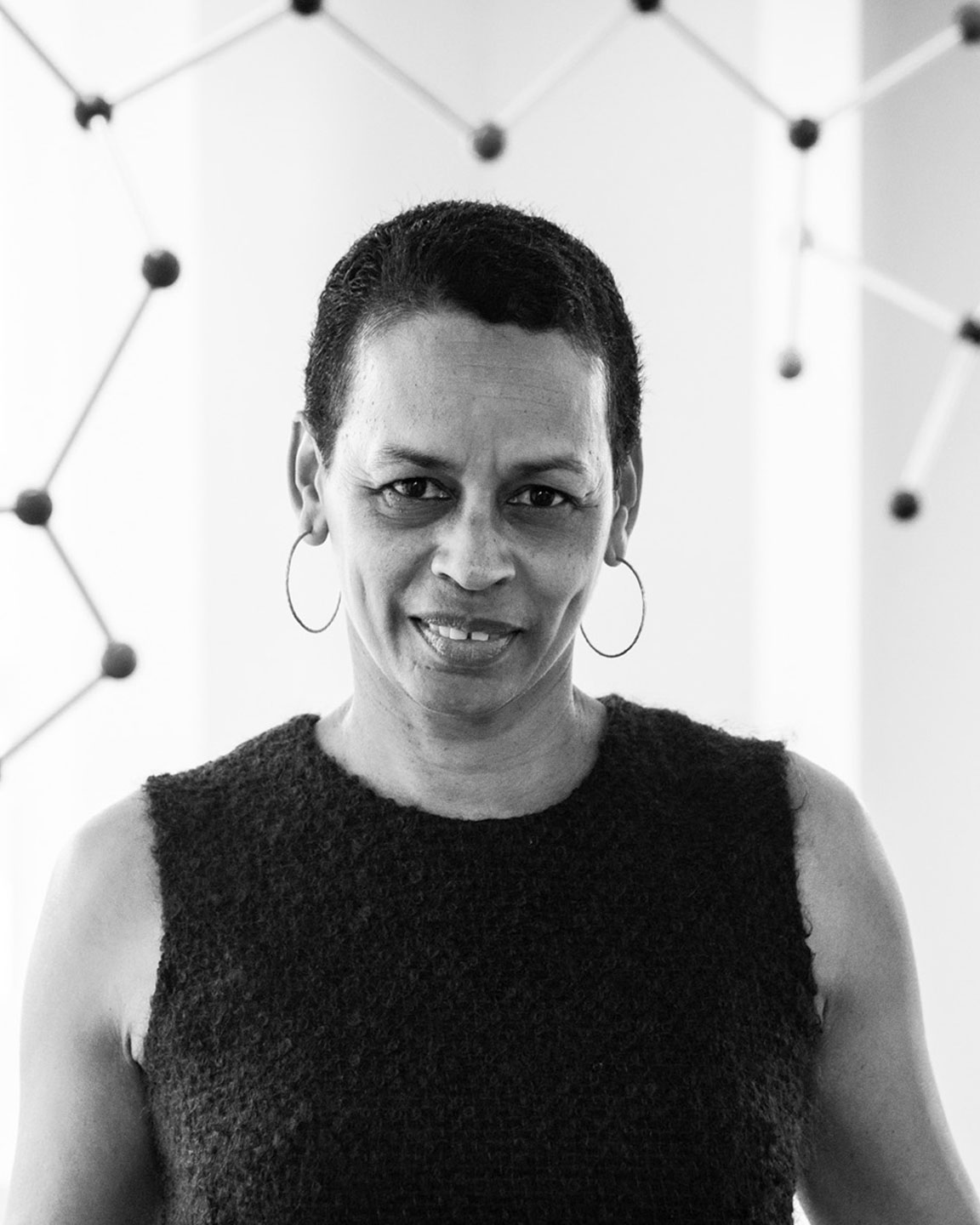 Michelle Williams received her Ph.D. from the University of Utah and began her career
with Rohm and Haas Company as a Research Scientist in 1987. During her career with
Rohm and Haas Company and Dow Chemical, Michelle also held manufacturing, sales, marketing,
strategy, and general management positions. She was General Manager with CMP Technologies
and later General Manager with Adhesives and Sealants. Michelle joined Arkema in 2011
and was named Global Group President of Arkema's Hydrogen Peroxide business unit.
Just this past February, Michelle joined the Brady Corporation's Board of Directors,
a global leader in safety and identification solutions.
Michelle Williams received her Ph.D. from the University of Utah and began her career
with Rohm and Haas Company as a Research Scientist in 1987. During her career with
Rohm and Haas Company and Dow Chemical, Michelle also held manufacturing, sales, marketing,
strategy, and general management positions. She was General Manager with CMP Technologies
and later General Manager with Adhesives and Sealants. Michelle joined Arkema in 2011
and was named Global Group President of Arkema's Hydrogen Peroxide business unit.
Just this past February, Michelle joined the Brady Corporation's Board of Directors,
a global leader in safety and identification solutions.
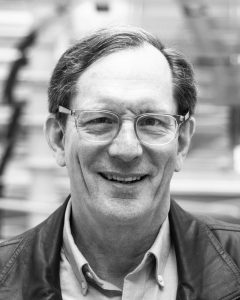 Bill Jack received his Ph.D. at Duke University after completing his BA in Chemistry
at the University of Utah in 1977. He is now a Senior Scientist at New England Biolabs,
which is a recognized world leader in scientific innovation and environmental sustainability
and has been awarded as one of the most admired workplaces in the region. Bill's lab
focuses on DNA polymerases, more particularly on the ability to incorporate modified
nucleotides, including chain terminators. This focus is expanding to include polymerase
activity on modified DNA templates, for example, those of modified phage genomes.
Bill Jack received his Ph.D. at Duke University after completing his BA in Chemistry
at the University of Utah in 1977. He is now a Senior Scientist at New England Biolabs,
which is a recognized world leader in scientific innovation and environmental sustainability
and has been awarded as one of the most admired workplaces in the region. Bill's lab
focuses on DNA polymerases, more particularly on the ability to incorporate modified
nucleotides, including chain terminators. This focus is expanding to include polymerase
activity on modified DNA templates, for example, those of modified phage genomes.
32% of the Chemistry Department’s faculty are women, making the University of Utah’s Chemistry Department is one of the leading handful of universities in the nation when it comes to gender equality. Currently, only 25% of the U.S. Senate is female; 23.2% of the House of Representatives; 6.6% of Fortune 500 CEOs; and barely a quarter of all senior executives at large U.S. public companies. So how exactly does the department achieve this higher percentage of women in leadership roles in a state that is continuously ranked as dead last in the country for the equality of women? There’s no better person to ask than Professor Cynthia J. Burrows, who has been in the Department for 25 years, and just last year finished up six years of service as chair of the department.
In 1983, a decade after the Equal Rights Amendment failed to pass in Congress in 1972, Cynthia J. Burrows received a letter in the mail. It was an offer for a faculty position at Stony Brook University. As a woman in chemistry, this would have been significant news, as only half of the country’s chemistry departments had just one woman on their faculty. During Burrows’ twelve years at Stony Brook, she would marry (Scott L. Anderson, who was also a faculty member), have triplets, and find herself with her family back in the west, closer to extended family and the mountain west she had grown up in. Both she and Anderson were hired to join the chemistry faculty at the University of Utah, where they have enjoyed the work-life balance that the mountains and cultural opportunities of Salt Lake City have to offer.
Burrows was the second woman to join the faculty and soon became the only woman when Janet Grissom left to pursue a medical career. Within two years, Sheila David was hired, along with her husband, Peter Beal, which doubled the number of women on the faculty to two. Burrows emphasizes that the department has always seen hiring couples as a two-body opportunity rather than a two-body problem. Family has long been a central value for the department of chemistry.
In the early 2000s, then-Chair Peter Armentrout instituted parental leave for all graduate students. There were not many departments offering this at the time, and this was yet another step in setting the tone to create a family-friendly atmosphere within the department. There have long been efforts to create a healthy work-life balance for everyone within the department and to encourage outdoor recreation and cultural opportunities that are so accessible in Salt Lake City. Not only is there a family-friendly tone within the department, but there is also a work-hard, play-hard mentality that is supportive and encouraging.
About a decade ago, a few of the women faculty and women from the Salt Lake community created the Curie Club to support women in chemistry with Burrows as the faculty liaison to co-Chairs Cynthia Conner and Kathy Thatcher. To further emphasize the value of women in chemistry, the Curie Club Common Room was created in the Thatcher Building as a visual and physical space that continues to be a daily reminder for all in the department that women are supported and appreciated here. Students gather here to study and collaborate.
From lectures and teas to workshops, the Curie Club continues to grow and expand with a new generation of graduate student leaders. The club is open to all who want to participate in and create safe and supportive spaces for individuals of any background. They are working within the department and beginning to reach out to alumni who would like to get involved to continue a lifelong legacy of inclusion and peer mentorship.
The tone of the department has long been one of inclusivity, education and research excellence, mentorship, and goodwill. There is always work to be done and improvements to be made, and this department approaches them eagerly and willingly. With the tone set, the department works hard to create an environment that welcomes the many and diverse perspectives that are the heartbeat of innovative research and learning.
Gina Frey and Jessica Swanson both joined the faculty in 2020.
Professor Gina Frey, Ronald and Eileen Ragsdale Professor of Chemical Education
Student success has a lot to do with effective teaching and departmental policies that empower students of diverse backgrounds to discover and reach their full potential. iGen (people born after 1995) is the most diverse generation to enter higher education in our nation’s history, and so it is vital for educators to understand how students learn STEM subjects and develop a sense of belonging during an era of a loneliness epidemic, diminishing mental and emotional health, financial uncertainty, a global pandemic, and systemic injustice.
As the student population of higher education mirrors the nation’s existing and expanding diversity, the methods and policies at colleges and universities should also reflect diverse and collaborative attention, support, and action. Chemistry education research continues to reveal how students learn and the impact that emotional health has on the learning process. Disciplined-based education research (DBER) has emerged as a field that aims to transform and improve undergraduate education through implementing effective teaching practices, better assessments of learning, and investigates student thinking, learning, and difficulties on their path to becoming scientists and chemists.
Professor Gina Frey’s research investigates how to improve student learning and sense of belonging through developing, modifying, implementing, and evaluating active-learning and collaborative strategies, as well as cognitive, metacognitive, and social-psychological research findings. Collaboration is central to her interdisciplinary approach, as her colleagues are researchers in education, psychology, and sociology, as well as other STEM discipline-based education researchers.
Exemplar Learners & Abstraction Learners
In the early 2000s, Professor Frey began to collaborate with a cognitive psychology colleague who had identified two types of learners in his research: exemplars and abstractors. Exemplars learn based on the retention or memorization of homework examples, while abstractors learn to transfer skills that allow them to work through a problem based on the underlying chemistry principles. Professor Frey was keen to find a way to identify which of her students were exemplars and which were abstractors and find if there were interventions that educators could make in their methodologies to help students gain more transfer skills based on chemistry principles.
Professor Frey and her colleague implemented in classrooms an online program (developed by her colleague) that could help them differentiate between the two types of learners based on exam scores. Initially, they found that the abstractors were doing 4% better in general chemistry.
However, when they separated the exam questions into retention and transfer questions, they saw a much different picture.
Both sets of students were able to solve the retention questions, which simply require memorizing homework examples. However, there was a significant difference in the transfer questions where students had to stretch their thinking beyond the examples in the homework.
Those students who were able to rely on their knowledge of the underlying chemistry principles were able to find the solution, whereas the retention learners were unable to solve the transfer problems.
In a more recent pilot study, they also noticed a drastic difference between the two learners in General Chemistry courses versus Organic Chemistry courses. As the nature of Gen Chem classes is mathematically based, if a student has good math skills or at least is able to memorize the steps to solve a problem, they can get through Gen Chem with relative ease. However, the differences are more drastic in O Chem courses, where it becomes more like learning a language and solving problems is like writing an entire paragraph fluently in a new language. The student must have a fundamental understanding of how everything fits together.
Belonging: How Emotional and Social Realities Affect Learning
As Professor Frey went through her schooling, she always did well and excelled. However, it wasn’t until she co-taught a Women in Science class where she was “forced” to read feminine and gender theory literature that she realized all of the subconscious cognitive energy it took to be one of the very few women in a classroom, research lab, or as a member of the faculty. She didn’t realize until one of the books she read pointed out that when an individual enters a room and they start counting in their head, looking for others that look like them, she had been doing this throughout most of her education and career. This led her to an understanding that no matter what she did cognitively to learn chemistry and conduct meaningful research, there was still this social issue of feeling a sense of belonging.
She and her collaborators have recently published a paper that reveals that students who have a low sense of social belonging in the course are less likely to persist from Gen Chem I to Gen Chem II, despite their cognitive abilities. In an earlier study, they implemented a growth-mindset strategy in Gen Chem I. While they did not see a difference in women’s performance in the course, they did see a difference in underrepresented BIPOC students. Between the control and experiment groups, there was a 5% difference in their finals, and the underrepresented students were at a -5% difference before they even started the final. Some of the interventions that can occur are to vocalize to underrepresented students that they are not the only ones questioning their social belonging. The student’s sense of belonging is especially crucial at transition points. For this reason, Professor Frey loves teaching Gen Chem, because she gets to interact with students at the threshold of a big transition in their lives. She does her best to vocalize that the students in her classes do indeed belong in chemistry, and she constantly reminds everyone that struggling is a natural part of learning and that all questions are valid. Making women and BIPOC scientists more visible throughout their educational experience can go a long way to encourage students to persist, to feel that they belong, and to contribute their diverse perspectives to the chemistry community to impact the progress and impact of research for their generation and generations to come.
As Professor Frey made her way through her own chemistry education, she realized that although her male mentors were very supportive of her pursuing a career as a chemist, they didn’t understand how her parenting duties were much different from theirs. They didn’t have to worry about their kids as much, buy groceries, and either stay home with the kids or take them to the doctor when they were sick. Though more and more males are taking on domestic care of home and family, this is still a barrier for many women socially and culturally.
She acknowledges there are still many barriers for women and BIPOC students that are deeply woven into policy, environmental, social, and cultural issues across the board. Professor Frey works to educate underrepresented students and their majority gender and race peers about the barriers that they face and how we can begin to dismantle them. Students need to know what their peers have to face so they can work together to create an educational and research environment that encourages all students to persist and find their own creative ways to fulfill their dreams of becoming a chemist.
Professor Frey would like all students, especially women, and BIPOC, to understand that there are many different ways for each individual to decide what makes them happy and fulfilled, and it will probably be different than what their peers want and need. She hopes we can begin to allow each other to decide within ourselves what is best for our families and ourselves. As women and BIPOC students continue to question their ability to continue in chemistry, Professor Frey is emphatic that if they want it, they can find a way, there is a path for them, and she’s there to help them.
Mapping the Kinetic Landscape of Biomolecular Processes
Understanding biomolecular processes at the molecular level, which is often the goal of biophysical studies, requires bridging many time- and length scales. While computer simulations can now routinely capture the motion of most biomolecules for microseconds, biological processes typically occur on a millisecond or longer time scales. Moreover, capturing a millisecond process for a single molecule represents just one example of billions of molecules that make up the ensemble of molecules in a test tube or cell. For each molecule or each repeated process, there will be slight variations. Only by averaging all of these, formally with statistical mechanics, can chemists recover the consistent properties they measure in experiments and thereby connect a molecular-level understanding with a bimolecular process.
Professor Swanson and her research group are developing multiscale kinetic modeling and simulation methods to take on this challenge by probing not only the structure and dynamics of specific microscopic transitions but also the variation in how proteins move through those transitions (kinetic pathways). Collectively these competing pathways, each contributing different amounts to the final outcome (e.g., ion transport) make up a kinetic network, although it is perhaps better thought of as a kinetic landscape with biomolecules flowing through it according to the relative ease (free energy) of each transition. Single-molecule experiments also shed new light on these kinetic variations as they trace out how biomolecules transition through such kinetic landscapes, one molecule at a time.
The Swanson Group also specializes in bridging quantum and classical regimes (size scales) to describe reactive processes while using various approaches to free energy sampling in addition to kinetic modeling to bridge time scales. The ultimate goal: connecting atomistic descriptions with macroscopic properties and biological relevance.
Effective Diagnostics for Buruli Ulcers
One topical focus in the group is biophysics. Recently, their findings shed new light on the ways in which amphipathic pathogen molecules navigate host systems. The group is part of an ongoing project exploring the mechanism that allows the mycolactone toxin to cause the ruthless skin disease, Buruli ulcer, which is in the same family as leprosy. The ulcers are chronic, debilitating, and caused by a single molecule that looks completely innocuous, like cholesterol or lipid. This toxin leads to tissue necrosis, evades the immune system, and blocks pain, making it incredibly difficult to detect before it’s already caused a significant amount of damage.
Developing effective diagnostics that target the toxin has been unsuccessful to date. Simulations from the Swanson Group have revealed the likely cause is a constant association with and trafficking via host membranes. It is now known that the toxin travels from outside of a host cell through the plasma membrane to the endoplasmic reticulum (ER), where it associates with the sec61 translocon, blocking the uptake of half of the cell’s membrane proteins. This causes a wide array of downstream consequences.
One key question is how does the toxin’s localization enable its pathogenicity? Swanson’s group calculated free energy profiles for the strength of association with different membranes to see if the toxin is trafficked simply via preferential interactions with different lipids. They were also able to observe through their all-atom simulations that although coarse-grained simulations gave the correct free energy of membrane association, they failed to capture both the mechanism of permeation and the role that water played during the permeation. Their quantum to classical and kinetic modeling simulations continue to map the mechanism of this toxic molecule into a clear narrative that will lead to more effective diagnostics.
Lipid Droplets & Metabolic Disease
Professor Swanson is also leading her group’s research to understand how proteins preferentially interact with lipid droplets to enable and control their lifecycle and essential process in metabolism. Dysregulation of these protein interactions results in metabolic dysfunction and disease. Lipid droplets are energy storage organelles where the body stores fatty acids and triglycerides, which are our densest form of fuel.
Enzymes synthesize fatty acids in the ER membrane where proteins facilitate their transfer into lipid droplets. A unique property of these organelles is that they are surrounded by a phospholipid monolayer rather than a bilayer. The Swanson Group is using simulations to identify the mechanisms by which proteins preferentially seek out lipid droplets.
What they have found so far is surprising: first, there is more water in the hydrophobic core than previously believed (glycerol groups are polar); and second, the triglycerides actually intercalate with the phospholipids in the monolayer surface creating more chemically unique packing defects that are not present in typical bilayers. They are currently probing how proteins interact with these new surface properties, anticipating they will have significant consequences for lipid droplet regulation.
Department Collaboration
Swanson’s group has just teamed up with Professor Andrew Robert’s group in a collaborative research project concerning the synthesis of biologically active lasso peptides as potential therapeutics with improved metabolic stability. The Swanson Group will provide molecular dynamics simulation data to assist the Roberts laboratory with the design and understanding of chemical systems for spontaneous lasso peptide folding.
Diversity, Equity, and Inclusion in STEM: A Call for Life Balance for All
Professor Swanson optimistically acknowledges that “we’re on our way” when it comes to creating work environments that make it easier to retain women faculty. Although she has felt respected here at the U’s Department of Chemistry “from day one,” she acknowledges that there are still men in her field, and even women, who make inappropriate comments and fail to recognize the built-in bias of many departments and divisions across the country. Although there’s still a lot of room to grow, she optimistically affirms that Utah is closer to creating life balance than other institutions, including her former University of Chicago.
More than anything, Professor Swanson feels an urgent need to bring more life balance to the world of academics for both women and men. She sees both male and female colleagues “drowning” and “exhausted” from carrying childcare or other life responsibilities, in addition to the massive workload expected to stay competitive in their research and teaching. Too often she feels in academics that she has to choose between being successful (tenure and beyond) and having a healthy life in addition to work. “Most women turn away from pursuing academics for this reason alone,” she says. “It’s sad to me. We should not have to choose between being good parents, or whatever other aspect of life someone holds precious, and getting tenure or being respected by our colleagues.”
She, like many of her colleagues and students, would like to see a third option: the space to thrive in both work and life. What would that look like? It seems highly reasonable that with all the brilliant minds in STEM, we could imagine solutions that would give academics more bandwidth to contribute professionally and thrive personally.
Hopefully her recent arrival and influence at the University of Utah Department of Chemistry, which she states “is a breath of fresh air” after her time at Chicago, will contribute to the ever-expanding diverse and inclusive culture here at the department.
Lydia Fries was awarded a Goldwater Scholarship for 2020-21. As a junior in chemistry, Lydia intends to obtain a Ph.D. in either organic chemistry or electrochemistry. She has done research in both Matt Sigman and Shelley Minteer’s groups, and Lydia is an author of two papers with both professors. She has worked on a variety of projects involving electrochemistry, palladium catalysis, and computationally focused projects. As an undergraduate, she enrolls in many graduate-level courses and is a Teaching Assistant for Organic Spectroscopy I. Lydia has been accepted to an REU program this summer and hopes that the current pandemic will have subsided by the time her program begins in mid-May.
With encouragement from high school teachers, Lydia followed her passion and her strong aptitude for STEM subjects and ignored the warnings from her broader community that she shouldn’t pursue such an expensive and “useless” degree. She followed her heart and her brain to the University of Utah, where she landed in the ACCESS program and was immediately surrounded by many intelligent and motivated women.
The American Chemical Society, the world’s largest scientific society, has awarded the 13th Irving S. Sigal Postdoctoral Fellowship (2020-2022) to Dr. Olja Simoska.
Olja completed her doctoral studies in December 2019 under the supervision of Prof. Keith J. Stevenson at the University of Texas at Austin. Her doctoral dissertation is titled “Real-time Monitoring of the Dynamic Metabolism and Responses of Pathogenic Bacteria using Electroanalytical Methods.” The electrochemical results from her doctoral research provide a strong quantitative basis for understanding microbial infections and virulence mechanisms in very complex biological systems. She has very impressive academic accomplishments, awards/honors, and publications/presentations lists.
For her Irving S. Sigal Postdoctoral Fellowship, Olja’s research will focus on methodically exploring genetic engineering approaches to improve extracellular electron transfer and performance of microbial fuel cells. Her postdoctoral research will be under the supervision of Prof. Shelley D. Minteer.
The Irving S. Sigal Postdoctoral Fellowship (Sigal Fellowship) of the American Chemical Society (ACS) is a two-year postdoctoral fellowship awarded every two years to a Ph.D. candidate who will pursue research at the chemistry and biology interface. Candidates are nominated by chairs of Ph.D.-granting Chemistry Departments in the United States. Individuals are not able to submit an application without being nominated.
Ronald Ragsdale passed away unexpectedly on Thursday, January 16, 2020, at his home in Draper, Utah. He came to Utah as an assistant professor in 1963 and was promoted to full professor in 1972. He will be warmly remembered for his extensive and passionate teaching as well as for establishing the annual Faraday Lectures back in 1981.
Ron taught over 50,000 undergraduate students, 4,000 high school students, 2,000 summer enrichment students, and more than 100 high school teachers. He and his wife Eileen have always championed students and education. They established the Ronald & Eileen Ragsdale Endowed Chair in Chemical Education to allow the Department of Chemistry to hire and maintain a faculty member whose research is dedicated to investigating and implementing teaching practices that ensure the best possible experience for students. The couple also established scholarships that will continue to support students who are in need of tuition support and are excelling in their studies. The Ragsdale’s have also supported the Curie Club and women in STEM within the department.
During his 49-year career in the Department of Chemistry, he is recognized for initiating three groundbreaking educational outreach programs that have distinguished the university's chemistry department from its peers: The Summer High School Chemistry Enrichment Program, a university/high school cooperative Advanced Placement Lab program, and the annual Faraday Lectures.
The Summer High School Chemistry Enrichment program began in 1973, and Ragsdale would invite guest speakers to deliver symposiums twice a week to cover diverse topics from Shakespeare to current political elections as well as a broad range of scientific disciplines.
With his devotion to chemical education, Ron instituted a chemistry demonstration program in the spirit of Michael Faraday in 1981, ably assisted by Dr. Jerry Driscoll, one of Ron's former students. Together, they entertained and educated crowds of several thousand community members--particularly high school chemistry students. The Lectures continue to entertain over a thousand local kids, students, and parents each year every December. Professors Janis Louie and Tom Richmond continue this tradition that Ron established so many years ago.
Ron's impact on the Department of Chemistry is far-reaching and ongoing.
The Campbell Staff Award was initiated by a distinguished chemistry department alumnus, Jerry Murry, and other “Kecklings,” to honor the memory of Diana Campbell, who was one of Professor Emeritus Gary Keck’s administrative assistants who had a long-lasting impact on the graduate students who benefited from her dedication to our research and education missions. The staff award acknowledges the important role that our departmental support staff play in the graduate education and careers of our researchers. The award will be given to a staff member who meaningfully and consistently contributes to and supports graduate students in ways that go above and beyond their administrative duties. This is the first award that recognizes and rewards the significant impact our staff members have on the excellent quality of education and research in the department.
Our students left for spring break early in March, just as all of us began to sense that our world was about to change as we’d never experienced before. There was and is no road map for this unprecedented situation. For the faculty and staff, the week of spring break was suddenly filled with meetings and strategizing. The Department of Chemistry spent the entire week quickly putting measures in place to secure the safety and well-being of its students, staff, and faculty. Here’s how the Department of Chemistry got things in order, working with the University and the College of Science within ten days thanks to the cooperation and collaboration of faculty and staff, and what’s happened since it all began:
Monday, March 9, 2020
- Chemistry seminar visitors are given the option to cancel their trip if they feel it is safer
- University restricts all university-related business travel
Wednesday, March 11, 2020
- Classes canceled for Monday and Tuesday to give professors and instructors time to transition to online courses
Friday, March 13, 2020
- Summer abroad programs canceled
- Possibility that summer courses will also be online
Wednesday, March 18, 2020
- 5.7 Earthquake
- First day of online classes canceled
Wednesday, April 1, 2020
- PPE donations to U Hospital & ARUP: 79,400 nitrile gloves, 605 safety glasses, 31 N95 respirators
Tuesday, March 10, 2020
- Message from Dean Trapa: prepare for possible transition to online classes and students returning from spring break should self-isolate
Thursday, March 12, 2020
- Lab Action Plans:
- Allowed and Disallowed Work
- Critical 14-Day Instrument Maintenance
- Non-critical 14-day Instrument Maintenance
- All group meetings go virtual
Sunday, March 15, 2020
- Non-essential Chemistry staff will telecommute and work from home if possible
Thursday, March 19, 2020
- NMR Center & Mass Spec Core Closures
- Essential Research:
- Caring for living organisms
- Maintaining continuous cell lines
- Maintaining equipment and reagents
Friday, April 3, 2020
- University-wide hiring freeze implemented
For our students who have worked for so many years for this moment, many of them overcoming significant hurdles and obstacles to get here, graduation is a rite of passage signifying to themselves and their community that they have gained the skills and knowledge to contribute to making this world a better and brighter place. We could not let spring pass without acknowledging their success and celebrating with them.
The College of Science is sending out “Graduation in a Box” this spring, which will include:
- Two Convocation Programs
- A College of Science Mug
- Honors or Internship Cords Awarded by the College of Science
The College of Science will host an in-person convocation in December for graduates.
Cheves T. Walling Award
Cheves Walling played a key role in the growth and development of chemistry at the University of Utah, retiring as a Distinguished Professor Emeritus of Chemistry in 1991. Each year, one or two graduate students receive this award for the best dissertation, as decided by a committee of faculty members.
We reached out to as many Walling award recipients as we could find and received responses from 16 alumni who have continued on their path of excellence in chemistry.
1991 recipient: Merritt B. Andrus, Professor of Chemistry, Brigham Young University
The last person to think Andrus would end up in academia was Andrus. As a graduate student, he had intentions to head for an industry position, but his postdoc advisor suggested that he also apply for academic positions. Inspired by his graduate advisor, Gary Keck, Andrus accepted an academic position at Brigham Young University and has been eager to help students with their overall preparation and development. Efforts in Dr. Andrus's lab focus on methods for the synthesis of biologically active natural products that possess unique structures and potential for combinatorial library construction and screening.
Andrus admires Gary’s concern for his students then and throughout the years, especially his approach to teaching and his sense of humor. Not only did Andrus learn a lot from Gary’s creativity and innovations in synthetic chemistry, but it’s his personal approach to teaching that has stayed with Andrus as he works with students. His time in Gary’s lab gave him experience as a teacher when he trained new students in the group.
1994 recipient: Rik Tykwinski, Professor of Chemistry, University of Alberta
Rik never considered the possibility that he’d get so far in his career in chemistry as a professor of chemistry at the University of Alberta. “I was very fortunate at all points in my undergraduate, graduate, and postdoctoral education to have had mentors who allowed me to be independent and develop my creativity,” says Rik. Looking back on his graduate experience, he realizes that he was concerned with “how many molecules do I need to graduate?” but now sees how important it was for him to learn from others. His interactions with his Ph.D. advisor, Peter Stang, other researchers in the lab, and international postdocs about their research in China, Germany, Russia, and other countries gave Rik a unique graduate school experience that impacted the rest of his career.
After graduate school, Rik was a postdoc at ETH Zurich with Francois Diederich. He accepted a position at the University of Alberta, hoping it was as close to the mountains as Salt Lake City, but he quickly learned they were 3 hours away. In 2009, he succeeded John Gladysz, another U alumnus, as the Chair of Organic Chemistry in Erlangen, Germany, where he stayed until 2016, before returning to Alberta. Fun fact: Rik met his wife Annie Schroeder on a biking trip hosted by Utah professor emeritus Rick Steiner.
1996 recipient: Stanton F. McHardy, Adjunct Associate Professor of Chemistry, UTSA
“I think if I told my graduate-student self that we would be designing and synthesizing small molecule drug candidates that would actually go into humans in clinical trials to address diseases, I probably would not have believed it,” says Stanton. He attributes his success to his foundation at the University of Utah, where he was able to work with “Boss Keck”, who created an incredible learning and problem-solving platform that put Stan on his way to becoming an accomplished scientist, researcher, and leader in both the pharmaceutical and academic arenas.
After a short postdoctoral experience, Stan began his career in the pharmaceutical industry at Pfizer Neuroscience. During his ten years at Pfizer, he went from being a research scientist to Assistant Director, becoming involved with multiple therapeutic programs and internal research initiatives. He returned to Texas, where he works at the University of Texas at San Antonio as both an Associate Professor of Chemistry and Director of the Center for Innovative Drug Discovery. Stan credits graduate school at the U with providing a foundation that helped him navigate a successful, interesting, and impactful career.
1999 recipient: Jamie Manson, Professor of Chemistry, Eastern Washington University
After graduate school, Jamie accepted a postdoctoral position at Argonne in the Materials Science Division. When he completed a three-year term there, he realized that academia was the only place where he could conduct the kind of research he was interested in. Without any teaching experience, he was hired at his undergraduate alma mater, Eastern Washington University, as an Assistant Professor. Mid-way through his 18th year, he is now a tenured full professor and was awarded the Trustees’ Medal in 2013—the University’s highest faculty recognition.
While in Professor Joel Miller’s group, Jamie was able to network and collaborate with groups across the chemistry community. He didn’t have research experience as an undergraduate at a small PUI, and so his graduate research experience was invaluable in helping him move forward in his career. Now he enjoys teaching in both the classroom as well as the research lab. Much of his funding comes from external sources such as the Research Corporation and the National Science Foundation. His primary research interest is focused on magnetism mediated by non-covalent interactions such as strong hydrogen bonds and halides. He has been able to publish much of his research in high-profile journals and continues to enjoy teaching research at a PUI.
2002 recipient: Rico del Sesto, Assistant Professor, Dixie State University
It was not a straight shot to Rico’s primary goal of teaching at an undergraduate institution. His unusual and unexpected path after earning a Ph.D. with Professor Joel Miller began with a postdoctoral fellowship doing research with the Air Force Research Laboratory, followed by a scientist position with the Department of Energy lab in R&D at Los Alamos National Lab. His experience in these labs equipped him with the skills he needed to build his own research programs and prepared him for a career at an undergraduate institution in unexpected ways. He was also surprised by what an “awesome” community there was among the graduate students and faculty in the chemistry programs. “I don’t think I would have survived grad school if it weren’t for that community, and today I still believe that collaboration and a supportive community is critical to success across the sciences,” he says.
After grad school, he again thought himself an “expert” but now with the ability to problem-solve his way out of anything. He was humbled to realize how much (or little) knowledge he actually had, but he was also humbled to realize the potential directions he could go and how much science and chemistry intersect with the functionality of the modern world. “There is a universe of knowledge out there waiting to be discovered, and there is a universe of opportunity to utilize the knowledge we have to keep society moving in a positive direction.”
2003 recipient: Vanessa Oklejas, Senior Computational Chemist, Zymergen
From the realm of experimental chemistry to computational chemistry, Vanessa has surprised herself throughout her academic and professional career. As someone who wasn’t even sure she would graduate, Vanessa has excelled again and again around every corner. During her graduate school experience, she learned how to think about and treat chemical information in a very different way while working in Joel Harris’s lab. She was always aware of how helpful Joel’s data analysis class would be for her, but she is quite surprised at how very helpful it has been, as science and technology have now fully embraced machine learning for better or for worse. “Without Joel’s course, I’m not sure I would have been as prepared to operate as a scientist in this seeming ML-centric world.”
After Vanessa graduated, she was interested in translating some of the tools that she picked up as a graduate student into the field of biophysics. As an NIH fellow in Steve Boxer’s lab (Stanford), she worked toward characterizing enzyme active sites using spectroscopic methods. After realizing she was tired of performing “mind-numbingly boring protein expression” in the lab, she joined Peter Wolynes’ group, where she focused on computational methods for predicting protein folding. Her current work focuses on modeling materials performance, first at the Aerospace Corporation and now at Zymergen, a biofacturing company in the San Francisco Bay area. Vanessa married another Cheves T. Walling award recipient, Bob Moison, and they have a 12-year-old son who has a strong interest in chemistry and physics but seems to prefer math!
2005 recipient: Carina Sanchez, Senior Principal Scientist, Novartis Institutes for Biomedical Research (NIBR)
Once Carina graduated, she moved to Cambridge, Massachusetts, and started working as a medicinal chemist at Novartis. She worked on projects in diabetes and metabolism disease area. She had the opportunity to do a rotation in the Synthesis and Technology group and decided to stay in the group. She now works with projects to advance their synthetic capabilities to access novel SAR, new routes, and large quantities of intermediates and final targets. Carina contributes to the synthetic strategy as well as the overall project strategy as she manages both scale-up and route-finding conversion rate optimization resources.
Her medicinal chemistry background enables her to easily understand the challenges the team faces. She serves on the core team for projects and collaborates with colleagues in development in Switzerland and China to enable a faster transition of chemistries. Carina is surprised at how much she has been able to define her role in helping projects reach their goals. “Boss Keck taught his students to solve problems and be pragmatic,” Carina says. A few months after she moved to Cambridge, she met her husband through a friend of a friend of a fellow Keck group member. They were married in 2009 and have two children, James (9) and Sofia (6).
2008 recipient: Malathy Krishnamurthy, Technology Transfer Associate, The Henry M. Jackson Foundation for the Advancement of Military Medicine
Malathy had thought that her academic training with Professor Peter Beal would translate into a career only in research and teaching. She currently works in the technology transfer office at The Henry M. Jackson Foundation for the Advancement of Military Medicine, Inc. (HJF), located in the Washington, D.C. area. Malathy’s graduate school experience in Beal’s lab laid a strong foundation for her professional development. It provided her with the necessary exposure for broadening her scientific interests and in making her more adaptable to explore interdisciplinary research areas.
Malathy studied for the patent bar exam to become a registered US Patent and Trademark Office patent agent and completed an advanced course on technology transfer at the NIH. With these credentials, she took up a part-time internship opportunity before working a full-time position in the technology transfer office at USAMRIID. Now she is currently at HJF working with a team that helps advance medical technologies from the bench to the bedside. Malathy’s graduate school experience laid a strong foundation for her professional development. It provided her with the necessary exposure for broadening her scientific interests and in making her more adaptable to explore interdisciplinary research areas.
2011 recipient: Theresa Cooper Watson, Deputy Chief Scientist, AFTAC
Theresa has always wanted to make a real impact with her science, using basic research and fundamental data to drive applied consequences. She loved working with and for her advisor, Peter Armentrout, because he gave her the freedom to design projects that would make a positive impact on the environment, which is very important to her. Now her focus is on producing science, data, and products with immediate operational impact to help close national security gaps. The science and technology she and her team develop have direct impacts on missions across the Department of Defense, from tactical levels to strategic levels.
After her postdoctoral experience at Berkeley, she began at the Air Force as a mid-level scientist setting up a new DoD radiochemistry laboratory. As time went on, the lab processes became too routine for her professional interests, so she made a lateral move into a small mission area within the same organization that felt more exploratory, exciting, and professionally fulfilling. Theresa ended up becoming the program manager and leader of a 40-member mission team for several years. Now she is the Deputy Chief Scientist for AFTAC, a 1,000-plus member organization whose focus is to detect special events in the atmosphere, underwater, underground, and in space to determine if they are nuclear. Theresa’s professional goals changed after she had her three wonderful children (ages 9 and 4 years and 5 weeks), and she wants to say that women “can have it all.”
2013 recipient: Na An, Life Science Attorney, San Francisco Office of Covington & Burling, LLP
“It never ceases to amaze me, as a lawyer, how much time I spend learning about our clients’ technologies and their competitors’ when structuring and negotiating a deal,” says Na. Graduate school education with Professor Cindy Burrows changed Na’s life, not only as a scientist but as a person as well. The most surprising and helpful lesson she learned in her lab years was how to face challenges and pick herself up in the face of failure. Experiences outside the laboratory setting have made her think more deeply about her research in the context of its social impacts. She had the opportunity to work on a few pro bono projects, representing non-profit organizations with missions to find treatments for orphan diseases.
It takes a tremendous amount of effort to take a life-saving therapeutic from the preclinical stage through clinical trials, regulatory approval process, and commercialization, to patients’ care. She was lucky enough to bear first-hand witness to the unwavering efforts put forth by families, advocates, researchers, industry, and regulators to make it a reality, and it gave her a much deeper appreciation for the difference and hope science brings about.
2018 recipient: Maria Demireva, Postdoctoral Researcher, Sandia National Laboratories
Maria stayed on at the University of Utah for one more year after graduate school in order to finish up several projects with Professor Peter Armentrout before she moved on to a postdoctoral position at Sandia National Laboratories in Livermore, California. She was initially surprised by how many more rules, regulations, and restrictions were in place at her new lab as compared to those at the university. Other than that, Maria’s day-to-day routine is very similar to her graduate school experience as she performs research on interesting physical chemistry problems with a goal to publish in high-impact journals.
The problems that Maria faced as a graduate student, whether it was trying to get an instrument to work properly or finding the optimal conditions for an experiment, became valuable tools that pressed her to be even more persistent in her research and to look for answers by deepening her knowledge and skills. These hurdles prepared her for dealing with similar setbacks in her current and future work. During the Covid-19 lockdowns, it was difficult for Maria to perform new experiments at the Advanced Light Source as she did when she first arrived there. She has made this past year an opportunity to improve her programming and modeling skills, which have opened up new avenues of research. Maria’s classes and research experience with Professor Peter Armentrout prepared her to think critically and creatively, enabling her to independently solve scientific problems.
2020 recipient: Peter Stevenson, Research Chemist, Air Force Research Laboratory
While in graduate school, Peter never imagined that he would become a principal investigator himself within a government laboratory. While in Professor Jennifer Shumaker-Parry’s lab, he had thoughts of continuing a research career in industry or academia, because careers in government laboratories seemed too competitive and were an unrealistic goal. But here he is, one year after graduating, doing exactly what once seemed impossible.
Following graduate school, Peter was a postdoctoral researcher at the Air Force Research Laboratory (AFRL) in the Materials and Manufacturing Directorate at Wright-Patterson Air Force Base. His research focused on the exotic optical physics of liquid-phase processedtwo-dimensional materials. He then had the privilege of becoming the principal investigator of the optical materials and coatings program at the AFRL. Peter’s research interests now encompass agile and high-performance optical coatings, tailored and responsive optical properties, thin film coating processing and mechanics, emergent optical materials discovery and implementation, plasmonics, nanophotonics, stratified optical media, low-dimensional materials, and metamaterials/metasurfaces.
Bill Jack has long been interested in finding new ways to look at the world. It all began when he was an undergraduate of chemistry at the University of Utah in Dr. Swaggart’s summer physics course, where the instructor announced on day one, “I’m going to teach you about a new way to look at the world.” After graduate school at Duke University, Bill greatly enjoyed his career at New England Biolabs, where he became a Senior Research Scientist and served as the Executive Director of Research for a number of years. In these roles, he was able to take risks in his research which gave him both a lot of freedom as well as a daily sense of excitement.
Recently, Bill expressed an interest in giving back to the Department of Chemistry to help graduate students as they begin careers in uncertain times. And so, in an effort to give students something that would last throughout their careers, the department decided to use funds donated by Bill to create a graduate award for the best dissertation in biological chemistry. For the next 30 years, a student will be awarded the William E. Jack Life Science Graduate Research Award, which comes with a cash prize as well as lifelong recognition for such an achievement.
The first recipient of the William E. Jack Life Science Graduate Research Award is Dr. Megan Browning, who was part of Cindy Burrows’s group. Megan studied DNA G-quadruplexes and RNA modifications using a protein nanopore in collaboration with Henry White’s lab.
This entails using a protein nanopore as a tiny hole between two chambers, and a voltage between the two chambers drives ions through the pore. Some of these ions are small buffer ions that flow through easily. However, larger ions like DNA and RNA get stuck and block the smaller buffer ions from going through, causing a decrease in electrical current through the pore that is detected. This provides information about the DNA and RNA such as their shape or chemical modifications.
Megan is absolutely fascinated with the study of DNA and RNA, especially in roles beyond the simple A,T,G, and C information storage. She was encouraged by a peer, Yun Ding, to join the Burrows lab, as she saw it as a perfect fit for Megan, who was starting graduate school with a two-year-old. Megan began a postdoctoral fellowship in medicinal chemistry at the University of Utah, working with Amy Barrios in the College of Pharmacy, studying phosphatases. “I love the U so much I wasn't ready to leave. I'd love to end up someday at the NIAID studying viruses,” says Megan. She feels that receiving this award will help her help others to make a significant impact in people’s everyday lives.
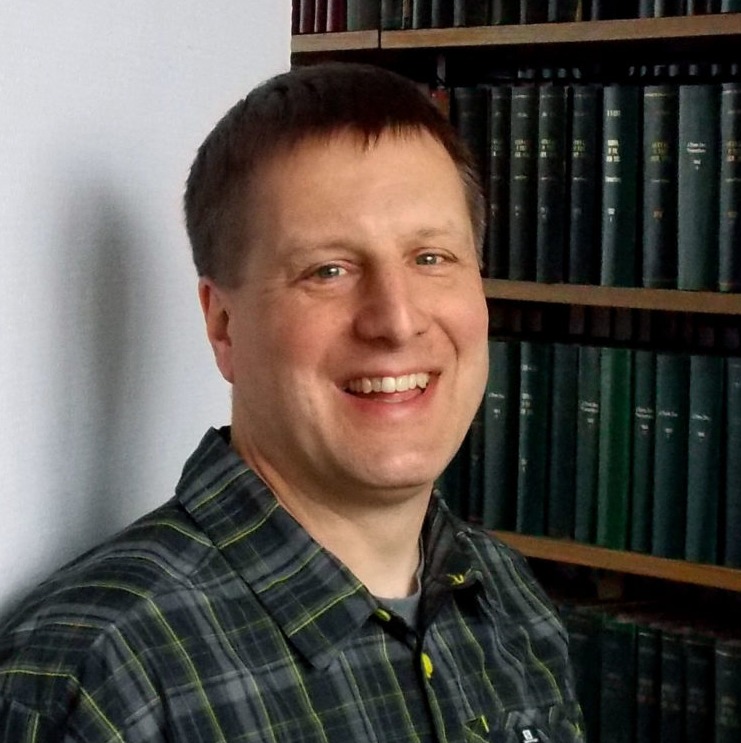 Rik R. Tykwinskiearned his PhD from the University of Utah with Peter Stang in 1994.
He worked with Professor François Diederich as a PDF at ETH-Zürich and then joined
the faculty at the University of Alberta in 1997. In 2009 he accepted a position as
Chair of Organic Chemistry at the University of Erlangen-Nürnberg in Germany. In
2016 he became Chair of the Department of Chemistry at the University of Alberta. His studies focus on structure-property relationships in conjugated molecules.
Rik R. Tykwinskiearned his PhD from the University of Utah with Peter Stang in 1994.
He worked with Professor François Diederich as a PDF at ETH-Zürich and then joined
the faculty at the University of Alberta in 1997. In 2009 he accepted a position as
Chair of Organic Chemistry at the University of Erlangen-Nürnberg in Germany. In
2016 he became Chair of the Department of Chemistry at the University of Alberta. His studies focus on structure-property relationships in conjugated molecules.
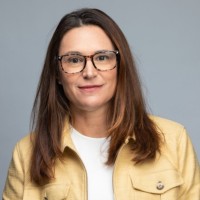 Carrie Wager is Vice President Strategic and Scientific Operations at Ascidian Therapeutics.
She received her Bachelor's in Chemistry in 1994 from Miami University, her PhD in
Chemistry from the University of Utah in 2000 and an MBA from the MIT Sloan School
of Management in 2017. Carrie spent 17 years at Pfizer as Senior Principal Scientist,
Director of Business Planning, Chief of Staff for Pfizer Medical, and Medical Strategy
Lead in Oncology. She then joined the Broad Institute of MIT and Harvard as Senior
Advisor, before assuming her present position at Ascidian Therapeutics.
Carrie Wager is Vice President Strategic and Scientific Operations at Ascidian Therapeutics.
She received her Bachelor's in Chemistry in 1994 from Miami University, her PhD in
Chemistry from the University of Utah in 2000 and an MBA from the MIT Sloan School
of Management in 2017. Carrie spent 17 years at Pfizer as Senior Principal Scientist,
Director of Business Planning, Chief of Staff for Pfizer Medical, and Medical Strategy
Lead in Oncology. She then joined the Broad Institute of MIT and Harvard as Senior
Advisor, before assuming her present position at Ascidian Therapeutics.
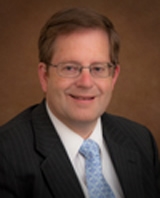 Raymond Pricereceived his B.S. in Chemistry from the University of Utah, followed
by an M.D. from Harvard. He has spent his career expanding the role of surgery in
public health, and has participated in or led surgical expeditions to Asia, Latin
America, and Africa. He co-founded The Center for Global Surgery at the University
of Utah. He also currently directs graduate surgical education at Intermountain Medical
Center. He has served with the World Health Organization, and has written numerous
peer-reviewed articles and books or chapters in books.
Raymond Pricereceived his B.S. in Chemistry from the University of Utah, followed
by an M.D. from Harvard. He has spent his career expanding the role of surgery in
public health, and has participated in or led surgical expeditions to Asia, Latin
America, and Africa. He co-founded The Center for Global Surgery at the University
of Utah. He also currently directs graduate surgical education at Intermountain Medical
Center. He has served with the World Health Organization, and has written numerous
peer-reviewed articles and books or chapters in books.
It’s been seven years since the Kecklings gathered together, and as a close-knit group, a reunion was long overdue. “Boss Keck” and his “Kecklings” spent many formative years together and learned invaluable fundamentals about research and living a good life in general as they worked together to elevate and move chemistry forward in their own unique and innovative ways.
Working with Carrie Wager and Jerry Murry, we were able to round up about two dozen Kecklings for a Zoom reunion in April. Everyone was able to catch up, reminisce, and reconnect as if no time had gone by at all.
The group has pulled together over the past few years to establish a fellowship in Gary’s honor in order to better support graduate student research. As we near the finish line of raising the remaining $30,000, Gary’s group is also planning a symposium for June 11, 2022, for an in-person deep dive into current research with some of Gary’s former students.
Gary’s personal contributions to synthetic chemistry are among the top in his field. He shares with Nobel Laureate E.J. Corey at Harvard the distinction of having three named reactions: Keck asymmetric allylation, Keck macrolactonization, and Keck free radical allylation.
The Gary E. Keck Graduate Research Fellowship, once established, will fully support the graduate students as they contribute to a legacy of excellence established by Gary and all of his students over the years.
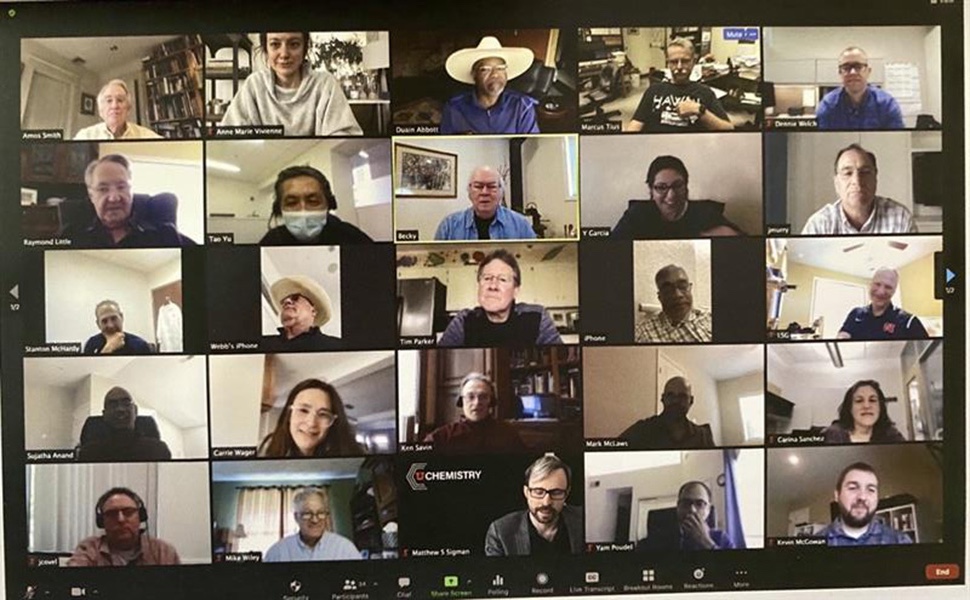
There were definitely silver linings to working and researching from home for the majority of the past year and a half. One of the benefits was the motivation everyone had to find and create new opportunities for sharing and presenting research in a year when travel was almost non-existent. The Curie Club committee and The Synthesis Club came together to organize the 1st Annual Graduate Student Research Conference over Zoom.
For one full week, graduate students and faculty presented their current research. Graduate students were given the choice to participate with either a 5-minute pre-recorded video or a 20-minute live presentation. 19 students presented 5-minute pre-recorded videos, and 21 students gave 20-minute live presentations throughout the week. Professors Gina Frey and Ming Hammond were the keynote presenters.
In addition to the presentations, the conference hosted three evenings of Q&A sessions with alumni. The graduate students were able to ask questions about professional development, personal growth, and how to navigate life after graduate school. Thanks to all of our alumni who participated:
Gabe Nagy joined the faculty in 2021. His core research topics include 1) the Implementation and application of a new recycling liquid chromatography-ion mobility spectrometry-mass spectrometry (recycling LC-IMS-MS) platform for high-resolution human milk oligosaccharide analyses; 2) the Design of a chemical probes toolbox to enable more confident identification of unknown glycans; 3) Development of accelerated reactions in microdroplets for rapid syntheses of carbohydrate building blocks and biomedically-relevant glycans.
Within the first minute of talking with Assistant Professor Gabe Nagy, it becomes apparent that breast milk is a wondrous and mysterious superfood that science is only just beginning to understand. This is no mommy-war breastfeeding vs. formula debate, especially since most women, given the luxury, would prefer (pain and all) to give their child the best shot at as healthy a life as possible. The scientific community and infant formula industry are keen to replicate one of nature’s best defenses against disease and illness, but there’s an overwhelming number of unknowns in uncovering its secrets. And so Gabe devotes his research to understanding HMOs, human milk oligosaccharides, to help mothers who don’t have the socio-economic luxury of breastfeeding their babies for the recommended minimum of six months.
Recently, human milk oligosaccharides (HMOs) have been implicated in their roles in promoting the healthy development of the brain-gut microbiota axis of a neonate. However, their numerous potential structural permutations make their accurate analyses and characterization increasingly difficult. To better understand how, why, and what specific HMOs influence the relationship between the brain, gut, and immune system of an infant, better analytical tools are desperately needed. To solve this puzzle, Gabe will focus on the development of a bioanalytical workbench consisting of a new multidimensional separations platform to be used in conjunction with solutions and gas-phase chemical probes to enable better separation and characterization of this highly diverse class of unconjugated glycans. Additionally, the use of accelerated reactions in microdroplets will permit rapid synthesis of biomedically-relevant glycan standards. This proposed bioanalytical toolbox will pave the way for de novo human milk oligosaccharide characterization, enabling advances in disease, clinical, and microbiome research.
Furthermore, according to an LA Times op-ed entitled “Breast milk is best and free, so why is it a luxury for American moms?” written by Jennifer Grayson, here’s what we do know about the important role mother’s breast milk plays in the health of their child:
“We now know that breast milk is not merely a foodstuff, but a mysterious and powerful human tissue — a constellation of complex nutrients, bioactive molecules, hormones, microorganisms, and as yet barely understood compounds that have evolved over eons to ensure the survival of the human species. We also know that feeding babies infant formula instead of breast milk is associated with increased incidence of gastrointestinal and respiratory infection, as well as greater risk of obesity, type 1 and type 2 diabetes, leukemia and sudden infant death syndrome.”
So while many women are unable to breastfeed their babies due to socio-economic conditions and with limited or no access to breastfeeding education and support, Gabe and a handful of researchers are working hard to characterize as many HMOs as possible which have not yet been incorporated in infant formula because they’re incredibly difficult to identify and characterize. Researchers estimate there are perhaps over 200 types of HMOs that mothers produce specifically for each infant depending on many environmental factors. Though these sugars have no significant nutritional value, they play an essential role in promoting good gut health and fighting off other diseases.
Characterizing these human milk sugars is no small feat because not every infant needs the same sugars to fortify their gut microbiome or ensure healthy brain development and growth. Sugar profiles can change in each mother’s milk for each child depending on the needs of the infant. Gabe’s research goal with his group is to be able to characterize as many HMOs as possible while developing new analytical methods to help them discover trends in smaller sugars in order to work their way back to understanding larger sugars.
Gabe’s research is rooted in ion-mobility mass spectrometry as they move away from linear toward a cyclic method of separation. This cyclic method allows his group to scale up the rate of separation to get a real understanding of whether some of these HMOs are even capable of being separated. Finding out if, when, and how the sugars are even separable is the first step in creating a robust database for researchers to begin to understand how they could synthesize the sugars for infant formula applications.
Gabe is looking forward to being back on campus this summer and the coming fall semester. He’s very keen to meet other researchers within the bioscience areas to further understand and collaborate on how HMOs function, and in a few years’ time, to be able to successfully sequence as many of the sugars as possible.
To say everyone was disappointed not to have a traditional graduation in the spring of 2020 due to the surge of Covid-19 cases would be an understatement. And it was no easy decision to hold graduation in person this spring, but with the help of many staff and faculty, graduation became a celebratory reality once again. Everyone crossed their fingers for good weather as they planned to hold graduation at Rice Eccles Stadium outdoors and socially distanced. For many students, staff, and faculty, it was the first time they had seen each other in over a year, though masks were still covering half of their faces.
The College of Science ceremonies went off without any glitches thanks to all the thoughtful planning and execution of the day’s events. Professor Vahe Bandarian spoke to all graduating chemists:
“Resilience is a word many of us probably did not have a working familiarity with before 2020. The word means the ability of people or things to recover from unpleasant events. This past year, things did not go according to plan. Many of you had to let go of long-dreamed travel plans and forgo research opportunities, and some of you had to say goodbye to a family member or friend who was taken by a virus we still know so little about. Some of you perhaps contracted the virus and had to work through the courses while recovering, and may still be recovering from the long-term effects. While it is easy to think about the past year as a lost opportunity, you should not lose sight of all that you have gained. Many of you discovered previously unknown stores of resilience and empathy, perhaps more than you would have in a lifetime. You are much more aware of yourself, your role in society, and your resilience.
You adapted to the changing instructional modes. You learned new ways to communicate, and in some cases, even found ways to do experiments virtually. You learned to tap into your inner strength and found creative solutions to deal with the loss of the in-person interactions that are so precious in the college years and to the learning process. By its nature, Chemistry is an experiential science and I know you worked hard to get the most out of the limited hands-on activities in the advanced labs and in your undergraduate research labs.
The last year was an experiment that Nature performed on you. The hypothesis was that resilience will get you through difficult times. The last 15 months were difficult, challenging, at times surreal. Now, we all know that you can never prove a hypothesis, only evidence for or against the hypothesis. I see so many data points standing here. Each of you was part of an experiment that Nature played on us, and we are standing here with your families, having persevered through the hardships. I won’t say you proved the premise of the experiment because the experiment is still ongoing. But your presence here is pretty strong support that we are more resilient than we had ever imagined.
I know that each of you was asked to do what you once thought impossible. But you showed you are resilient. As you start your careers, you have probably persevered through the worst crisis in your lifetime, and today you are standing tall, knowing that if you can overcome the hardships and adversities of the last 15 months to earn the degree, you can do anything. You are resilient, creative, and ready to face the future.”
After a lifetime of devotion to family, church, and science, Edward (Ted) Marcus Eyring died on February 20, 2021. He was born on January 7, 1931, in Oakland, California to Henry Eyring and Mildred Bennion Eyring. He grew up in Princeton, New Jersey, where he was the only LDS student at Princeton High School and where all of the church meetings he attended were in the dining room at his home. He served two and a half years in the Paris, France mission.
Ted married Marilyn Murphy on December 28, 1954. He graduated from the University of Utah, where he was a member of Phi Beta Kappa and Phi Kappa Phi. He did a 2 and a half year tour of duty with the Air Force. In 1960, he earned his doctorate, spent a year in Germany as a Guggenheim fellow, and then joined the chemistry faculty at the University of Utah. Over the next 50 years, Ted co-authored many scientific papers with his gifted students and faculty collaborators. The most important product of his teaching and research was the training of about 100 pre- and post-doctoral students who have made important contributions to science. One of his favorite professional activities was writing informative letters of recommendation for his former students. One of Ted’s innovations was the introduction of service-learning field projects into his classes. He received a number of awards for scientific research, but his favorite recognitions were those his students awarded him for exceptional teaching. Ted served in many capacities in the LDS church in both teaching and leadership, including serving as a bishop twice.
He loved his family and spent countless hours at athletic games, musical programs, and other family activities. He loved the annual trip to Laguna Beach, cruises, and other trips with his family. He and Marilyn loved to travel and often visited foreign countries all over the world. For years he was an avid racquetball player.
Tribute in C&EN
Edward M. “Ted” Eyring, 90, died Feb. 20 in Salt Lake City.
“Eyring was a world-renowned physical chemist and a fellow of the American Association for the Advancement of Science. Over his 52-year career at the University of Utah, he pioneered experimental methods to study rates of chemical reactions in liquids and investigate new catalytic materials. Eyring mentored 30 Ph.D. students and published 325 scientific papers. He was an award-winning classroom instructor who touched the lives of more than 15,000 undergraduate students and introduced service-learning field projects into his classes. Eyring twice chaired the Department of Chemistry, and as a 61-year American Chemical Society member, he served in elected leadership of the ACS Division of Physical Chemistry.”
— Matthew S. Sigman, friend, and colleague.
The year 2021 started off on a tragic note. Edward (Ted) M. Eyring, who devoted his life to family, church, and science, passed away on February 20, 2021. He is survived by his wife of 66 years, children Steven and Jill Eyring, Valerie LaHaye, David and Juli Eyring, his brothers Henry B Eyring and Harden Eyring, 11 grandchildren and 18 great grandchildren. He was preceded in death by his parents, his daughter Sharon and great granddaughter Addyson.
Throughout the year, several members of our faculty and students achieved notable accomplishments. Luisa Whittaker-Brooks was awarded the prestigious 2021 Sloan Research Fellowship, given to researchers “whose creativity, innovation, and research accomplishments make them stand out as the next generation of scientific leaders.” Whittaker-Brooks was also among 16 early career chemists named as a 2021 Camille Dreyfus Teacher-Scholar. Selected by the Camille and Henry Dreyfus Foundation, Camille Dreyfus Teacher-Scholars receive an unrestricted $100,000 research grant.
Following Whittaker-Brooks’s success, Vahe Badarian received the Distinguished Research Award. Each year since 1965, the University of Utah has selected faculty members from across campus to receive the Distinguished Research Award (DRA) – an award designed to recognize outstanding achievement and excellence in scholarly and creative research by University of Utah faculty. Professor Valeria Molinero was among the 252 newly elected members of AAAS–American Academy of Arts and Sciences. Among those joining Molinero in the class of 2021 are neuroscientist and CNN medical correspondent Sanjay K. Gupta, Pulitzer Prize-winning investigative journalist Nikole Hannah-Jones of the New York Times and media entrepreneur Oprah Winfrey.
As the Spring semester ends and summer begins, Professors Michael Morse and Peter B. Armentrout both were recipients of awards. Morse received the 2021 College of Science Award for Fostering Undergraduate Research Excellence for his outstanding contributions to undergraduate research with the College of Science Award for Fostering Undergraduate Research Excellence. He will receive $20,000 to fund his research, including support for one or more enrolled undergraduate research assistants pursuing a degree in science or math. Armentrout was the recipient of the 2021 ASMS John B. Fenn Award for a Distinguished Contribution in Mass Spectrometry, for the development of robust experimental and statistical techniques for the determination of accurate thermochemistry. He developed the guided ion beam threshold dissociation approach to provide insights into the thermochemistry, kinetics, and dynamics of simple and complex chemical reactions.
While our faculty had an outstanding year, our students did as well. Lydia Fries, an undergraduate researcher in the Sigman Group, received this year's Outstanding Undergraduate Researcher Award from the University of Utah. Another undergraduate, Celine Slam, received a highly competitive Fulbright U.S. Student Program grant from the U.S. Department of State and the J. William Fulbright Foreign Scholarship Board for the 2021-2022 academic year. Finally, Grant Myres, a graduate student in the Joel Harris research group, received the FACSS Hirschfeld Award this year.
Finally, with COVID-19 on the downfall our Department was slowly returning back to normal. 2022 was another year filled with success. An undergraduate, Alison Wang, was awarded a prestigious Goldwater Scholarship for 2022-23. She enrolled at the U and declared chemistry as her major, with her eyes set on going to medical school. However, her honors general chemistry professor, Luisa Whittaker-Brooks, encouraged her to seek a research opportunity in Caroline Saouma’s lab as a freshman. She then was awarded the 2022 Undergraduate Student Utah Award. Aria Ballance was a third-year graduate student when she was selected for the 2022 National Defense Science and Engineering Graduate Fellowship. Sponsored by the Air Force Office of Scientific Research, the Army Reserve Office, and the Office of Naval Research, it is a highly competitive fellowship with over 3,000 applicants and only 50 awardees.
While these students were honored with prestigious awards, our faculty members also received recognition. Valeria Molinero Elected to the National Academy of Sciences 2022, Luisa Whittaker was the recipient of the Brooks 2022 U Presidential Scholar, and at the 2022 PHYS Awards banquet in Chicago, the Executive Committee voted to rename the longstanding senior theory award to honor Jack Simons. It is now called the Jack Simons Award in Theoretical Physical Chemistry. Along with these faculty members, Vahe Bandarian was selected for a fellowship through the American Society for Biochemistry and Molecular Biology (ASBMB) and Peter Stang was One of Clarivate's Most Cited Scientists! Scott Anderson received the Outstanding Chemist Award in recognition of his contributions to the field, James Muller was awarded the Professional Chemist award, and finally, Distinguished Professor Dr. Cynthia Burrows was the 2022 Pauling Medal awardee.
The Department experienced another successful year in 2022, yet it was not without its share of tragedy. Emeritus Faculty colleague, Wesley G. Bentrude, passed away on October 4. Prior to joining the faculty of the Department of Chemistry at Utah in 1964, Wes earned a Ph.D. at the University of Illinois Urbana-Champaign, spent two years working as a Research Chemist at Celanese, followed by a year of postdoctoral research at the University of Pittsburgh. Professor Hannah Laya Kesner also passed away this year. She started as a graduate student at Utah in 1967 and completed a Ph.D. working on the then-new method of field-flow fractionation under the direction of Professor J. Calvin Giddings in 1974.
Zlatko Bačić, is a professor of chemistry at the Department of Chemistry, NYU. Zlatko Bačić received his B.S. from the University of Zagreb and his Ph.D. from the University of Utah Department of Chemistry with Professor Jack Simons. Professor Bačić work includes research of theoretical and computational chemistry, quantum treatment of the dynamics and spectroscopy of molecules in nanoporous materials and on solid surfaces, vibrational spectra of fluxional molecular systems of biological interest, and weakly bound molecular clusters. He is also the founding director of the new Simons Center for Computational Physical Chemistry at NYU established in 2021.
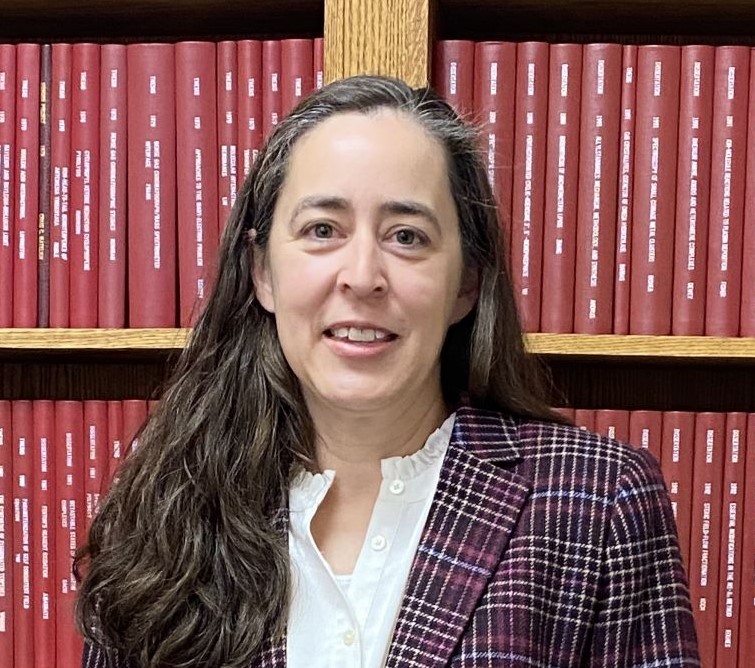 Amy Barrios, is a medicinal chemist working as a professor of Medicinal Chemistry
and the Associate Dean for Postdoctoral Affairs at the University of Utah. On August
16, 2019, the Graduate School appointed Professor Amy Barrios, Department of Medicinal
Chemistry (College of Pharmacy), the new Associate Dean of Postdoctoral Affairs in
the Graduate School. Amy M. Barrios graduated from the University of Utah with a bachelor’s
in chemistry in 1995, followed by a Ph.D. in 2000 from MIT and a postdoc from the
Department of Pharmaceutical Chemistry, University of California, San Francisco.
Amy Barrios, is a medicinal chemist working as a professor of Medicinal Chemistry
and the Associate Dean for Postdoctoral Affairs at the University of Utah. On August
16, 2019, the Graduate School appointed Professor Amy Barrios, Department of Medicinal
Chemistry (College of Pharmacy), the new Associate Dean of Postdoctoral Affairs in
the Graduate School. Amy M. Barrios graduated from the University of Utah with a bachelor’s
in chemistry in 1995, followed by a Ph.D. in 2000 from MIT and a postdoc from the
Department of Pharmaceutical Chemistry, University of California, San Francisco.
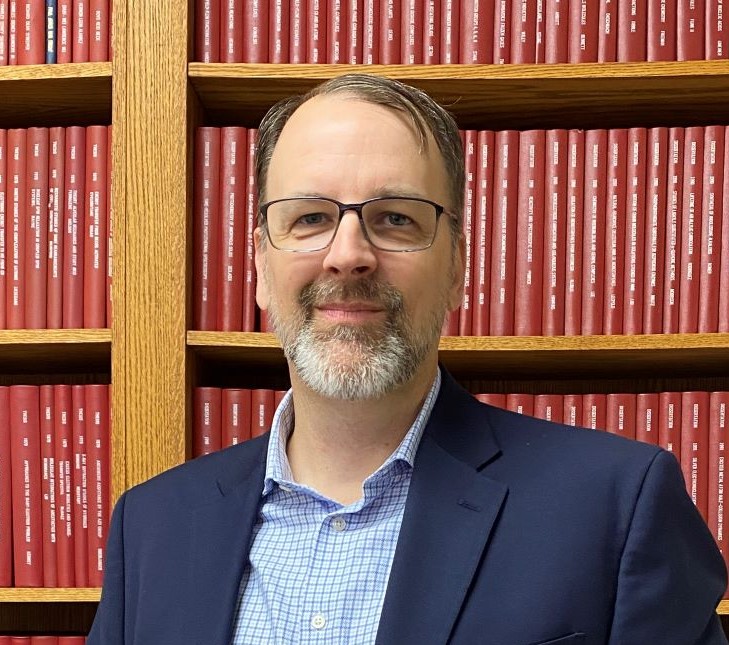 Mitchell Johnson, is the Executive Vice President at General Plastics Manufacturing Company responsible
for developing the company’s strategic growth platforms, focusing on developing new
products and new applications of its current products. Johnson earned his doctorate
from the University of Utah Department of Chemistry with Professor Joel Miller. He
pursued post-doctoral studies at Los Alamos National Laboratory, studying organometallic
and lanthanide chemistry.
Mitchell Johnson, is the Executive Vice President at General Plastics Manufacturing Company responsible
for developing the company’s strategic growth platforms, focusing on developing new
products and new applications of its current products. Johnson earned his doctorate
from the University of Utah Department of Chemistry with Professor Joel Miller. He
pursued post-doctoral studies at Los Alamos National Laboratory, studying organometallic
and lanthanide chemistry.
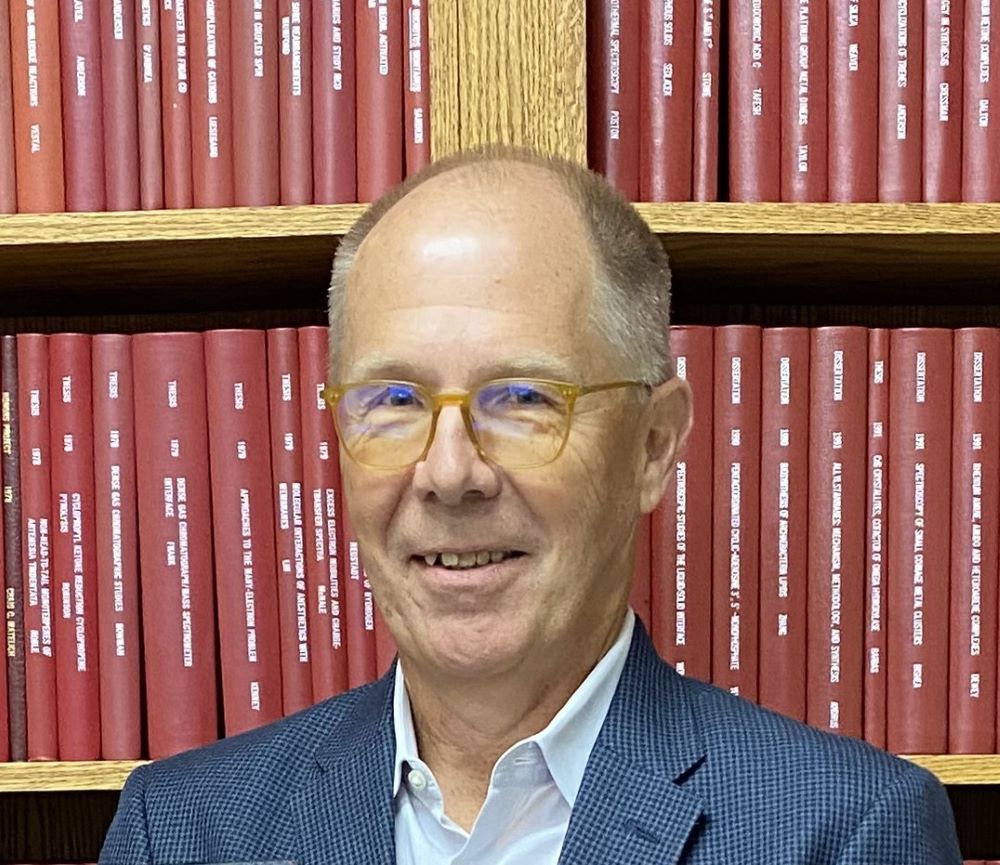 Roger Leach, retired from DuPont two years ago after a very successful 36-year career
starting at the Experimental Station in Wilmington, DE. Roger was the Technical Senior
Manager and Leader of the Science & Innovation Core Analytical Sciences organization.
After relocating to the San Diego area, Roger joined Viridos, as their Director of
Analytical Sciences, which is developing genomically engineered, industry-leading
algal strains as lipid feedstock for second-generation renewable diesel and aviation
biofuels. Leach received his Ph.D. 1984 from the University of Utah Department of
Chemistry with Professor Joel Harris.
Roger Leach, retired from DuPont two years ago after a very successful 36-year career
starting at the Experimental Station in Wilmington, DE. Roger was the Technical Senior
Manager and Leader of the Science & Innovation Core Analytical Sciences organization.
After relocating to the San Diego area, Roger joined Viridos, as their Director of
Analytical Sciences, which is developing genomically engineered, industry-leading
algal strains as lipid feedstock for second-generation renewable diesel and aviation
biofuels. Leach received his Ph.D. 1984 from the University of Utah Department of
Chemistry with Professor Joel Harris.
2023 was a big year for our department, starting off with a $1 million grant to U chemists. Michael Grünwald, Ryan Looper and Rodrigo Noriega, of the University of Utah Department of Chemistry, received a $1 million grant from the W.M. Keck Foundation funding studies of currently unpredictable aspects of the process of crystallization. Following this, University of Utah professors Vahe Bandarian, Eric W. Schmidt and Jennifer S. Shumaker-Parry are among the 506 newly-elected Fellows of the American Association for the Advancement of Science (AAAS). Election as a Fellow is an honor bestowed upon AAAS members by their peers.
On March 6, 2023, Valeria Molinero received the American Physical Society Irving Langmuir Award in Chemical Physics. Read here about Professor Molinero’s award. Mr. Kevin Teaford from U Chemistry had been chosen to receive the society's highest award, The J. Allen Alexander Award. Luisa Whittaker-Brooks, associate professor of inorganic/materials chemistry, is the recipient of the 2023 MRS Outstanding Early Career Investigator Award for cutting-edge work on the control of structural phase transitions, spins, and thermal-dependent electronic interactions in organic-inorganic quantum well heterostructures. Matthew Sigman was the recipient of the 2023’s Patai-Rappoport Lecture Award for his major contributions in physical organic chemistry, data science and enantioselective catalysis. The 2023 SAS Undergraduate Award in Applied Spectroscopy was given to Clista Galecki, a senior undergraduate student working in the Harris Lab. We also had two of our own students win the 2023 FACSS Student Poster: Joshua Taylor and Maran Sardoni. Aric Potter, an undergraduate student in the Harris lab, wins an EAS Undergraduate Student Research Award at the Eastern Analytical Symposium in Plainsboro, NJ! Finally, multiple of our professors were ranked 2023 best chemists on research.com.
We had a successful 2023 Graduation. The Department of Chemistry graduated 15 Ph.D. Candidates, 4 Masters in Science, and 85 Bachelors in Chemistry and Biochemistry. And we had a successful Distinguished Alumni Awards, the first one sense COVID-19. Our four awardees were Zlatko Bačić , Dr. Amy M. Barrios, Mitchell Johnson, and Roger Leach. To wrap it all up our 2023 Catalyst was a huge success!
